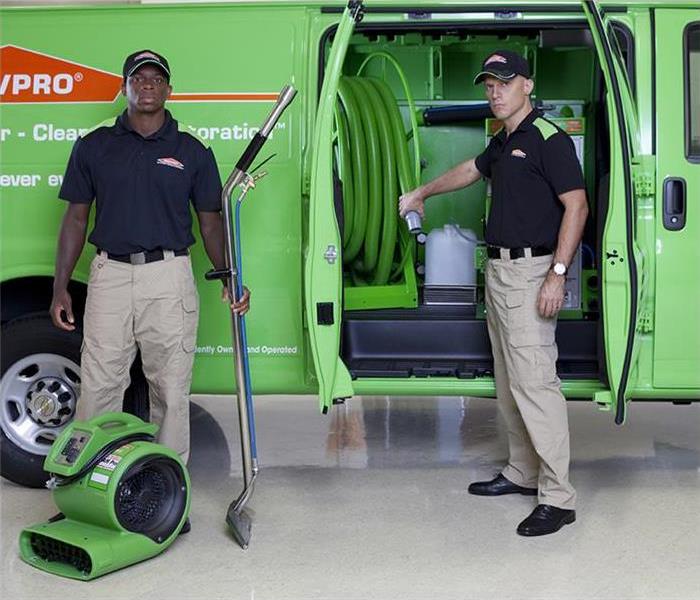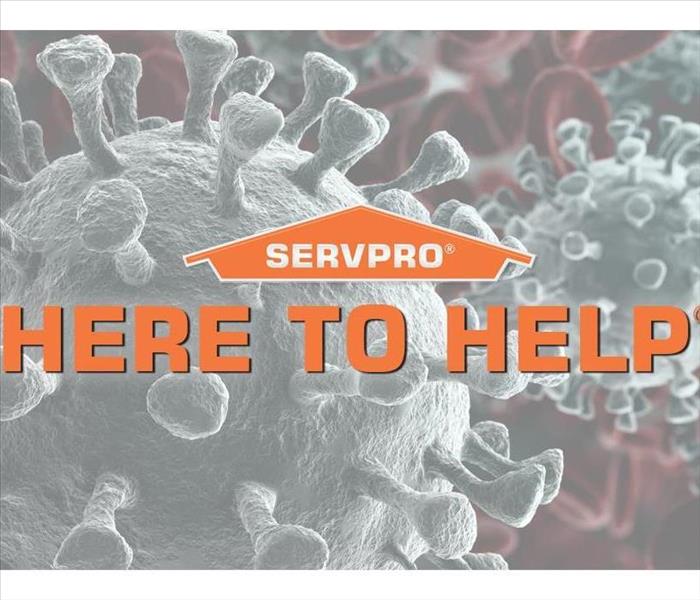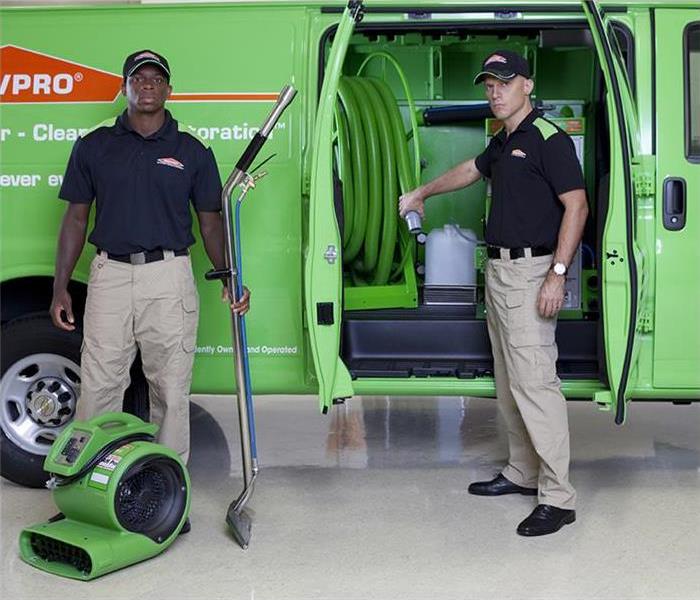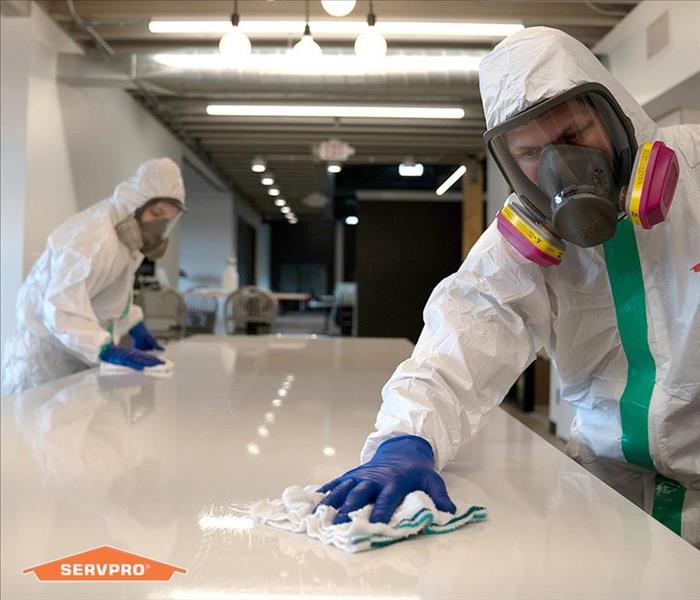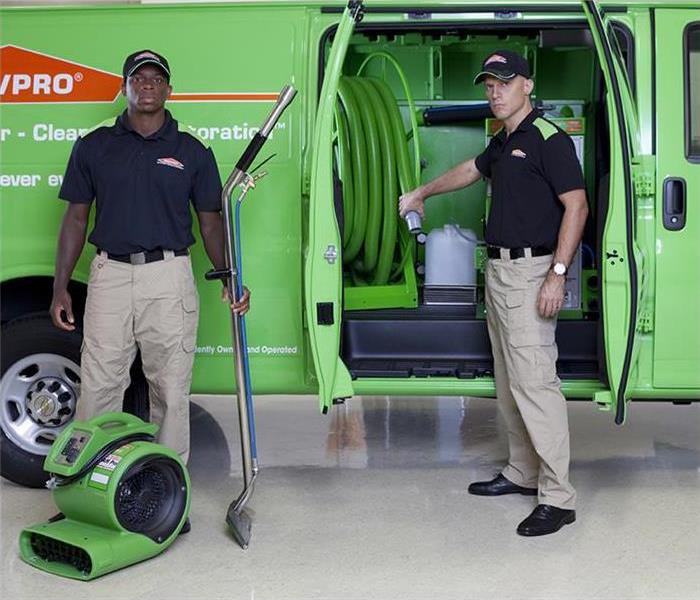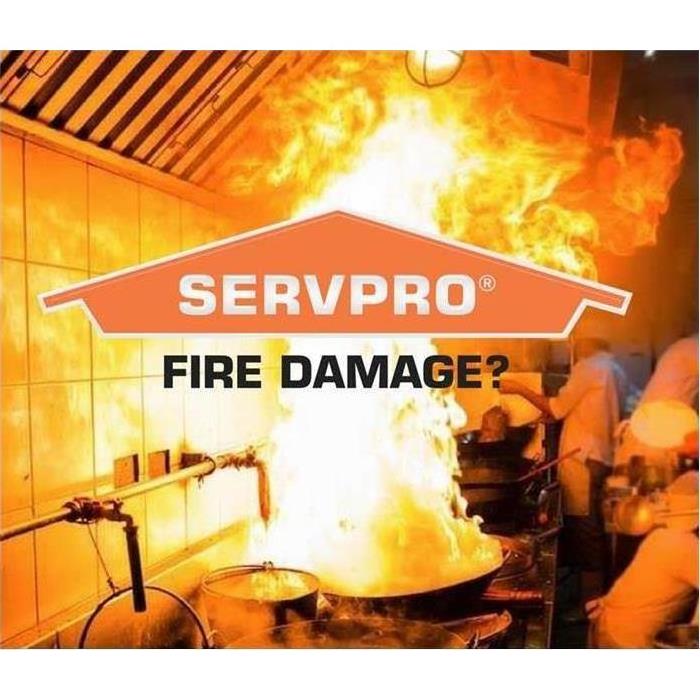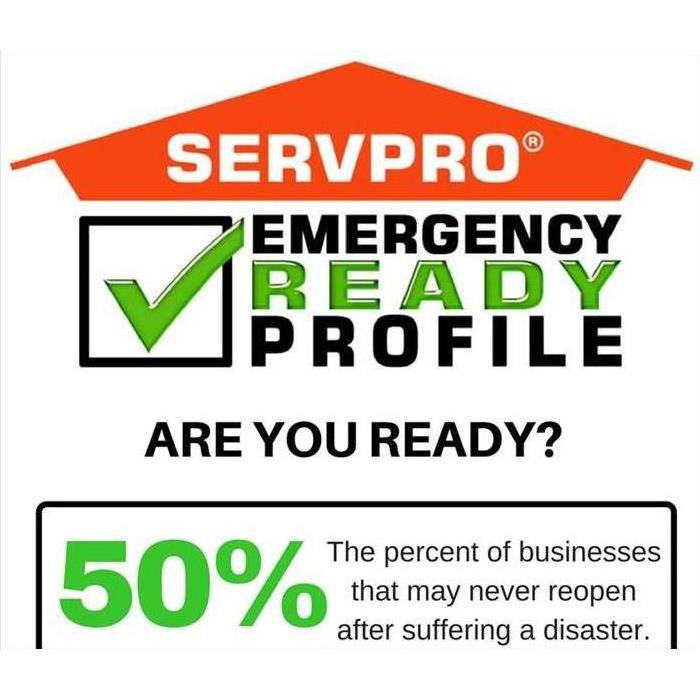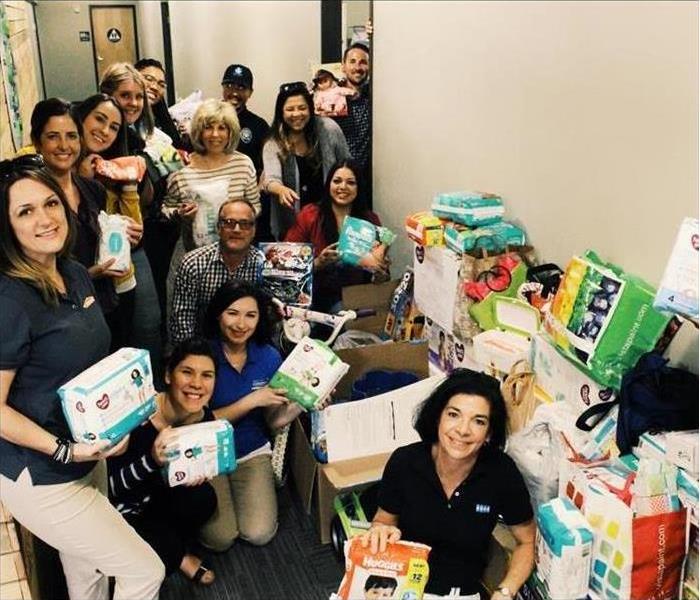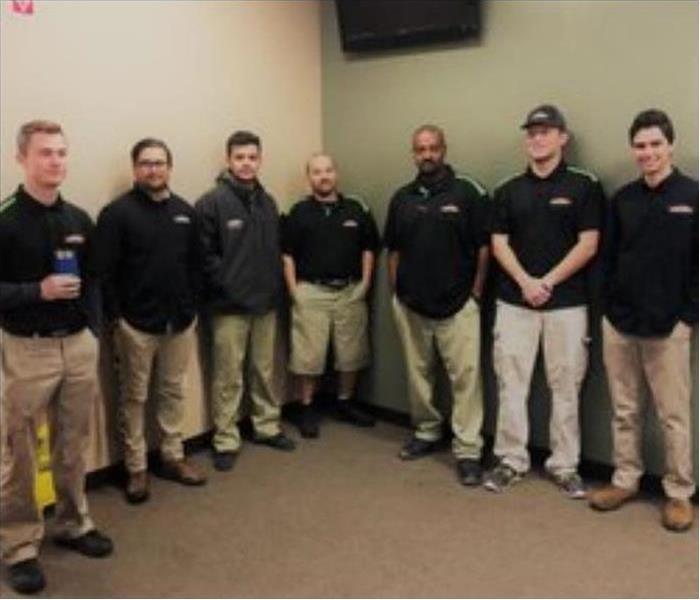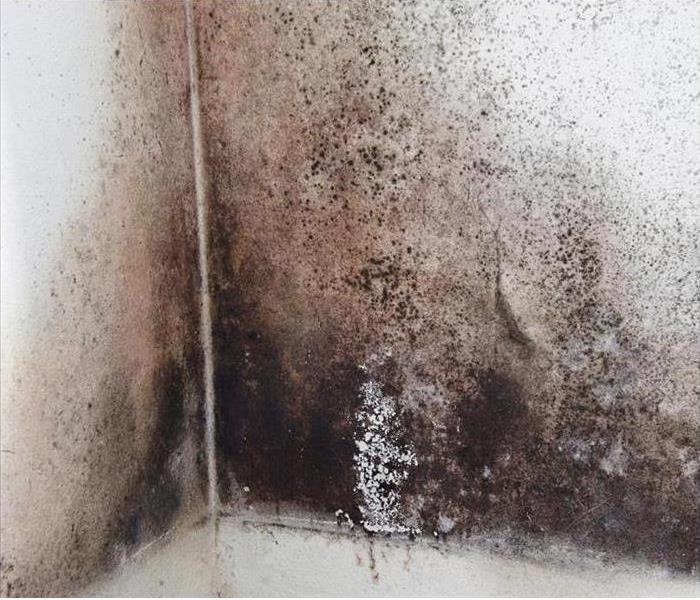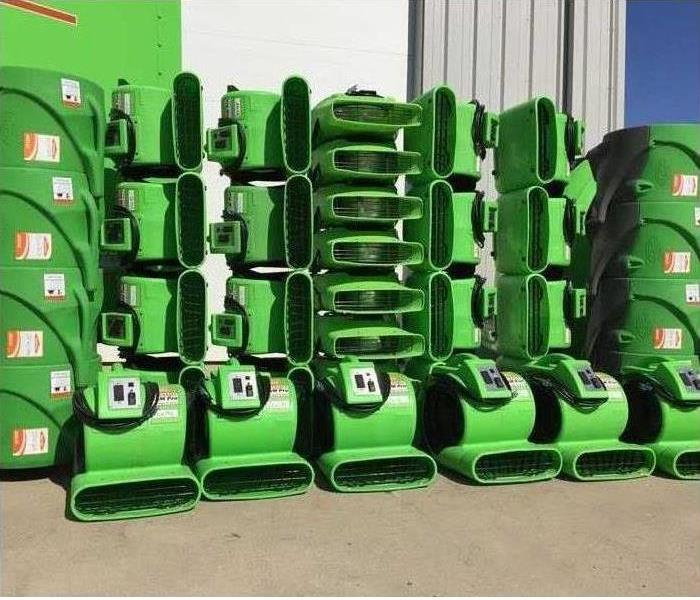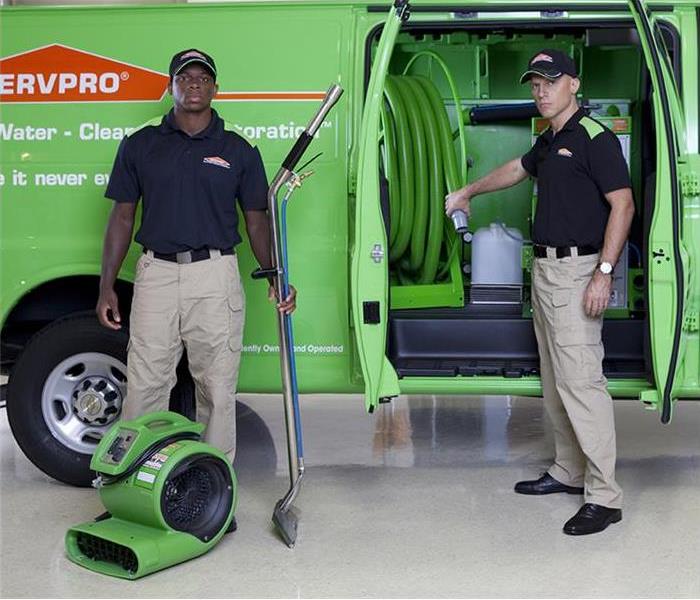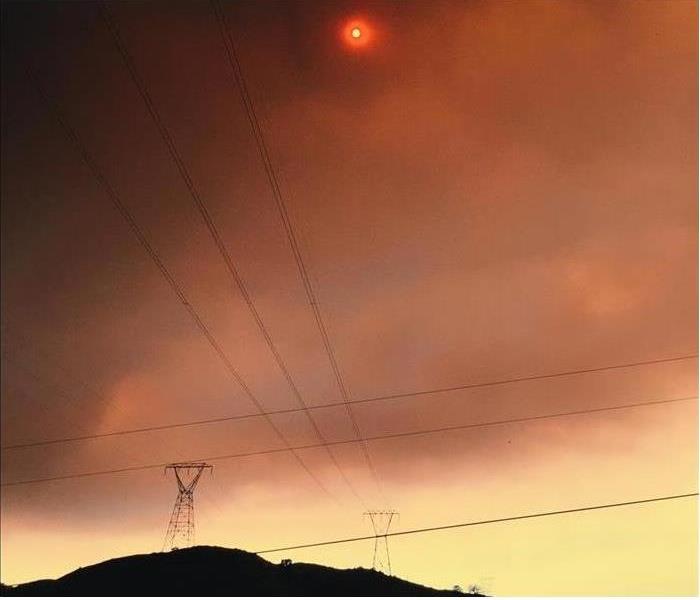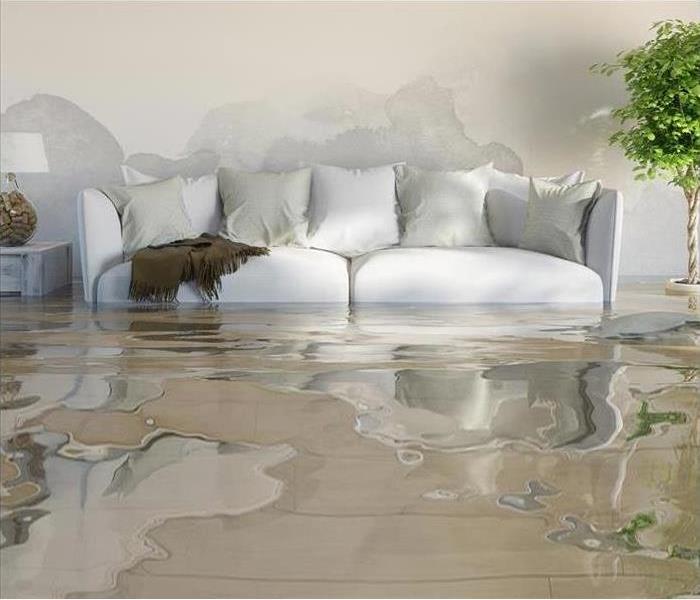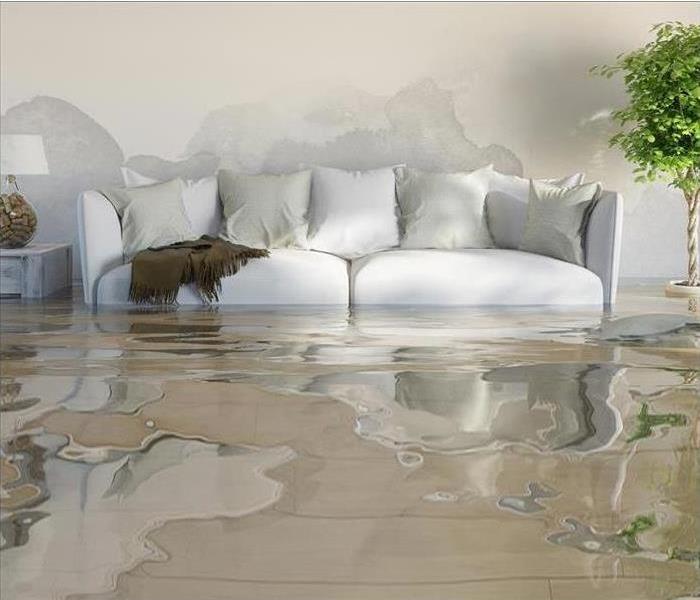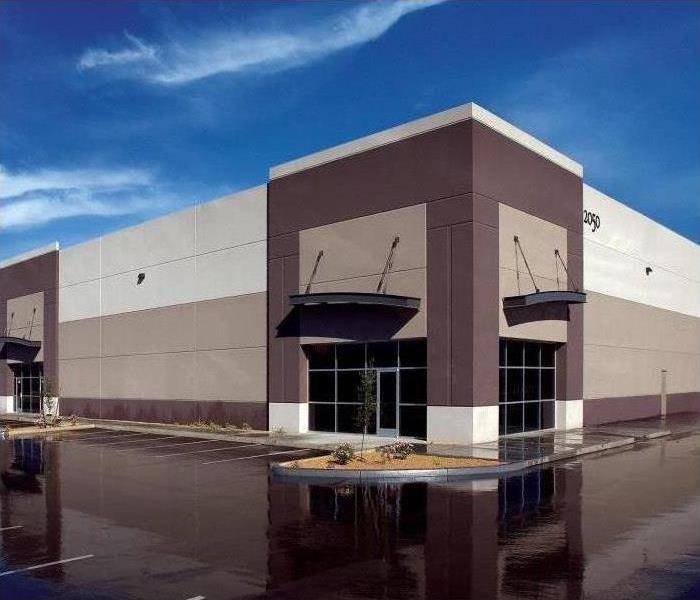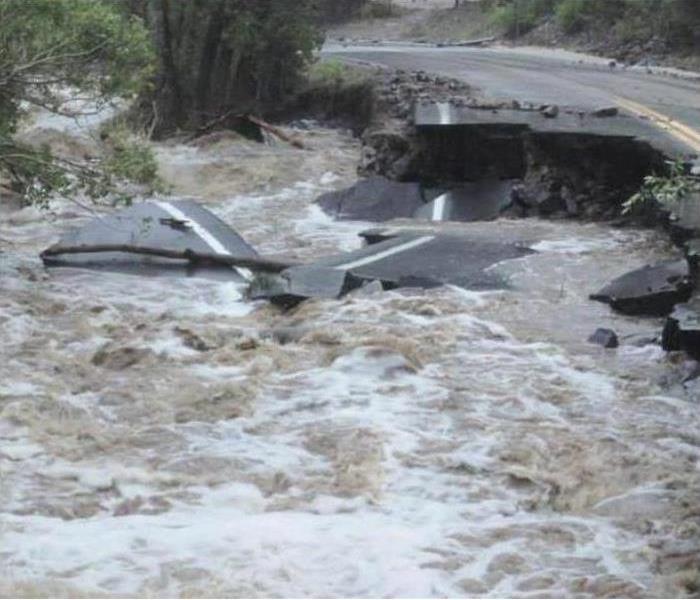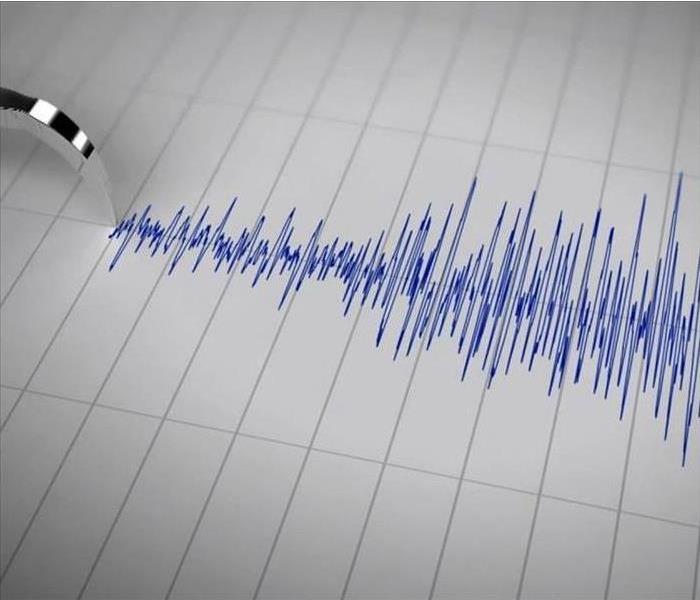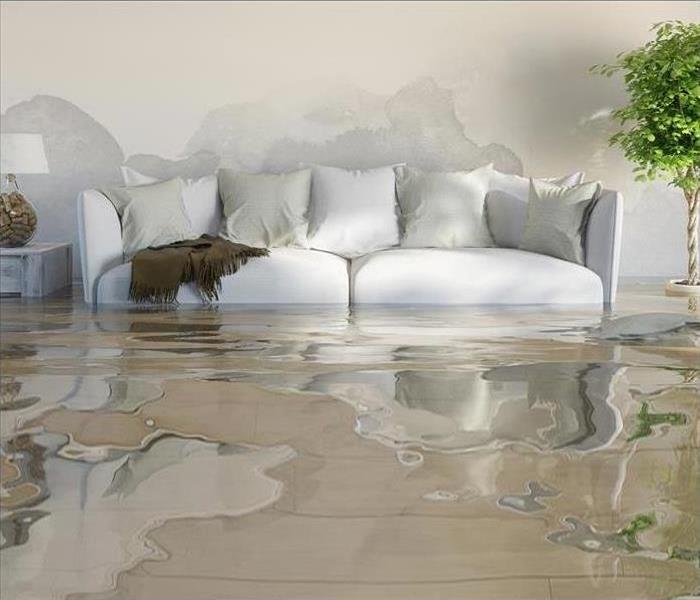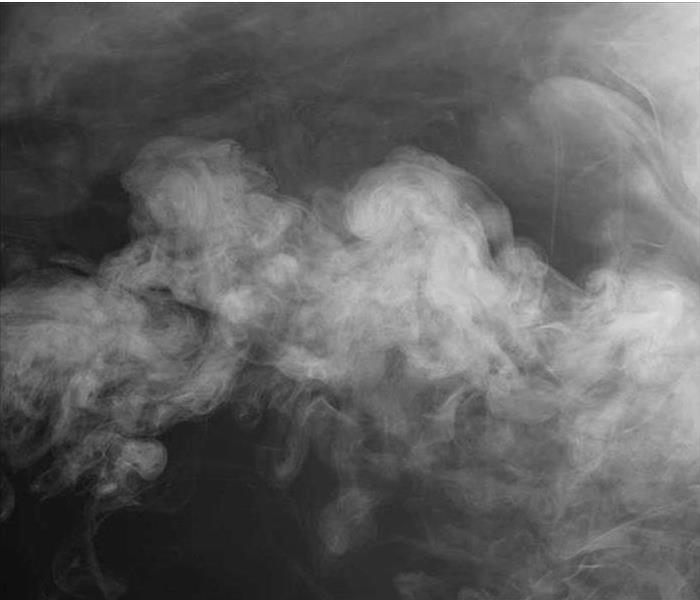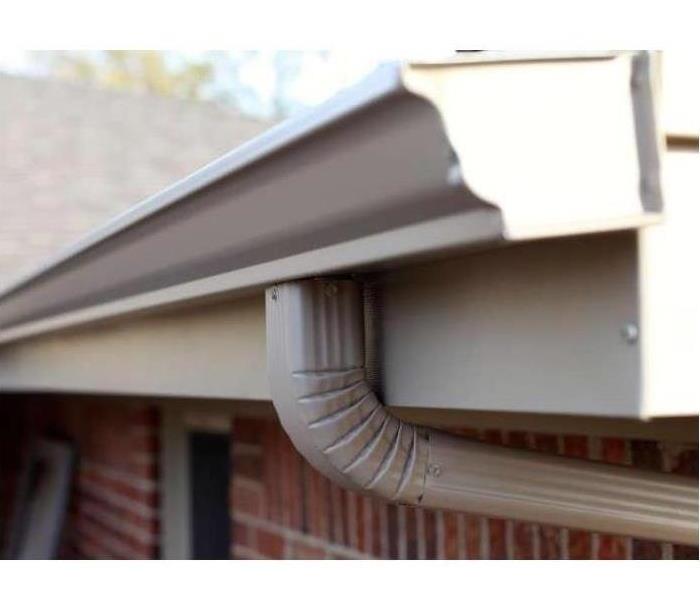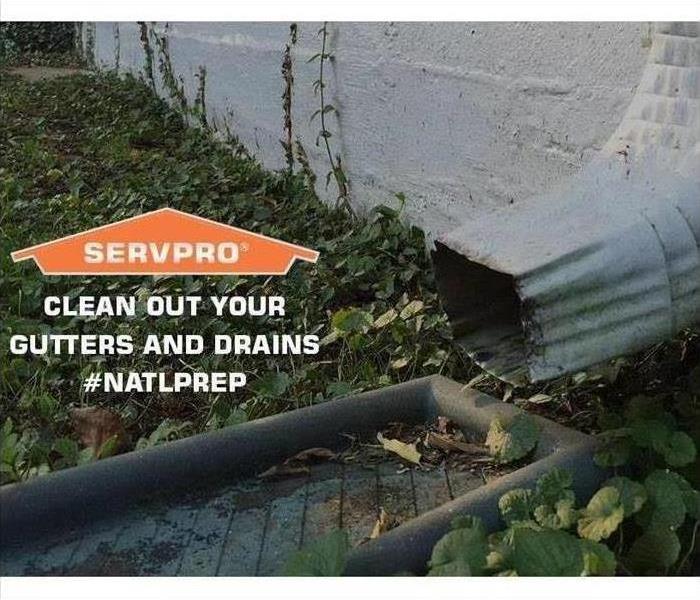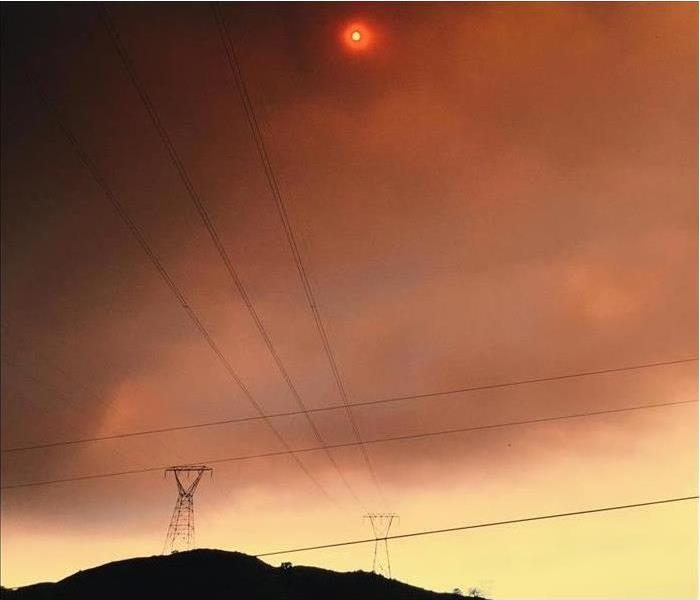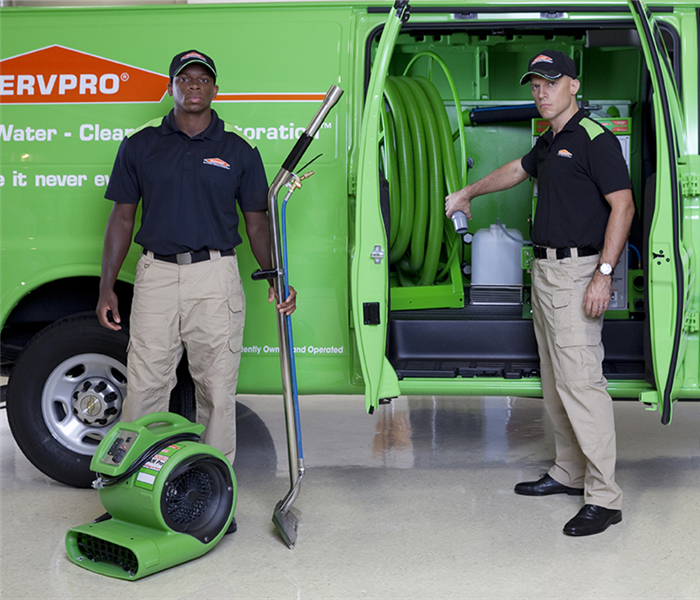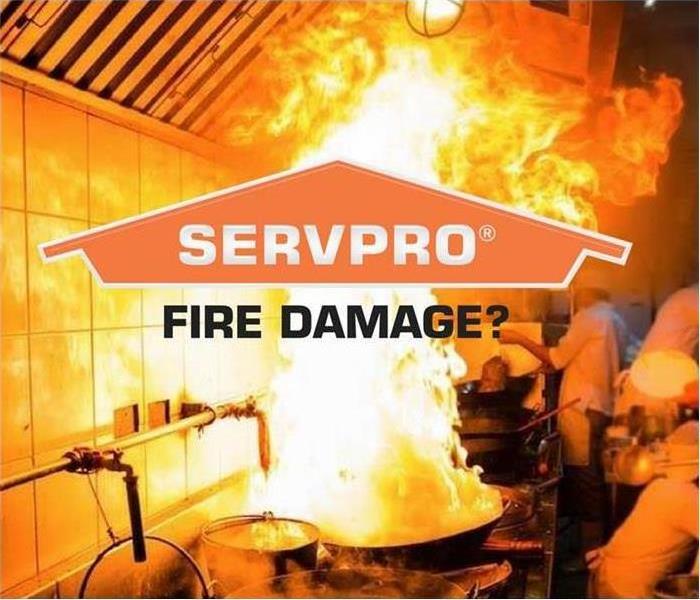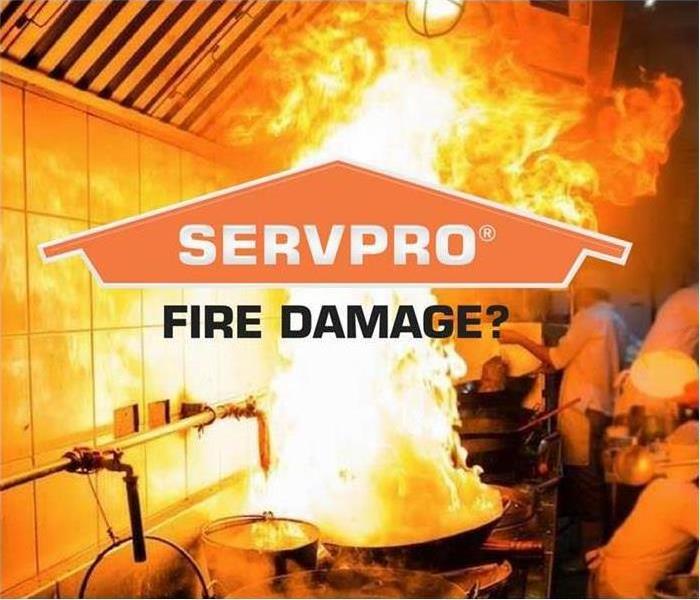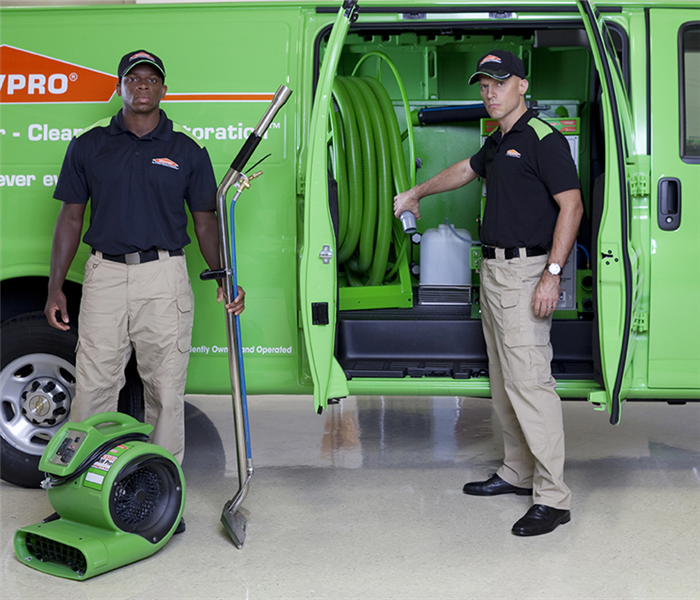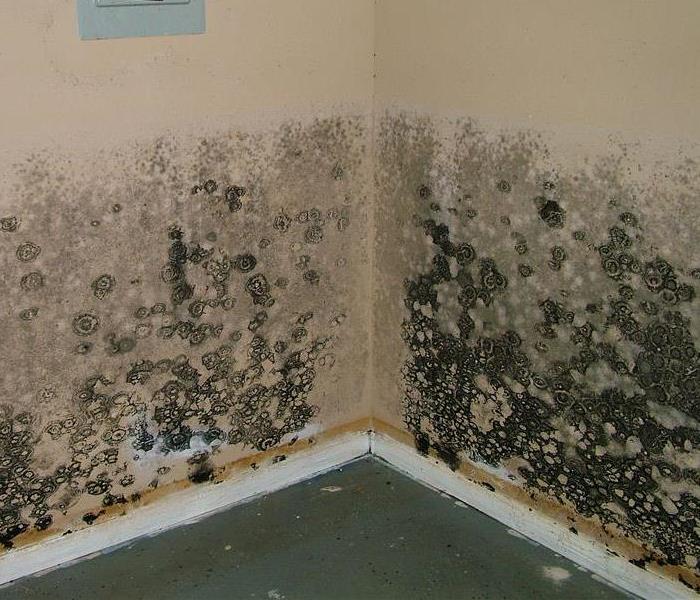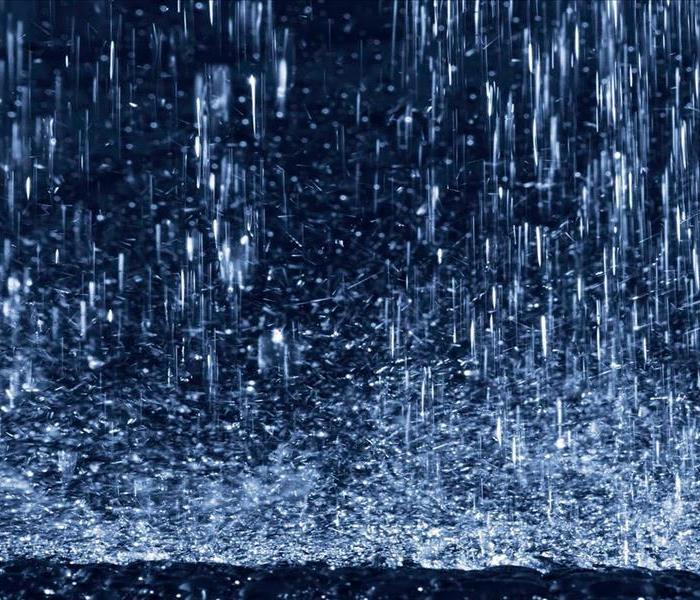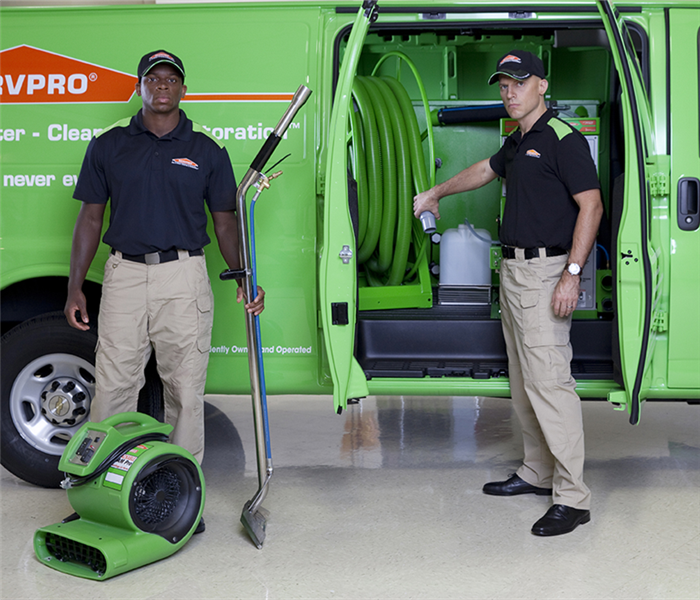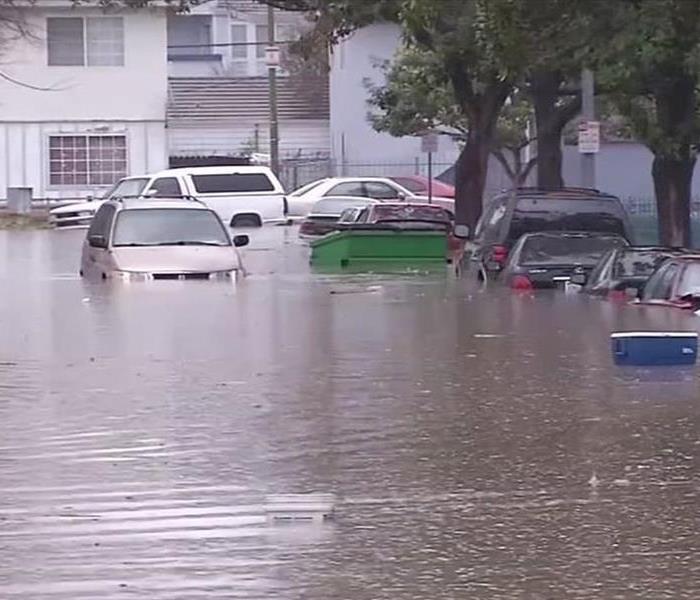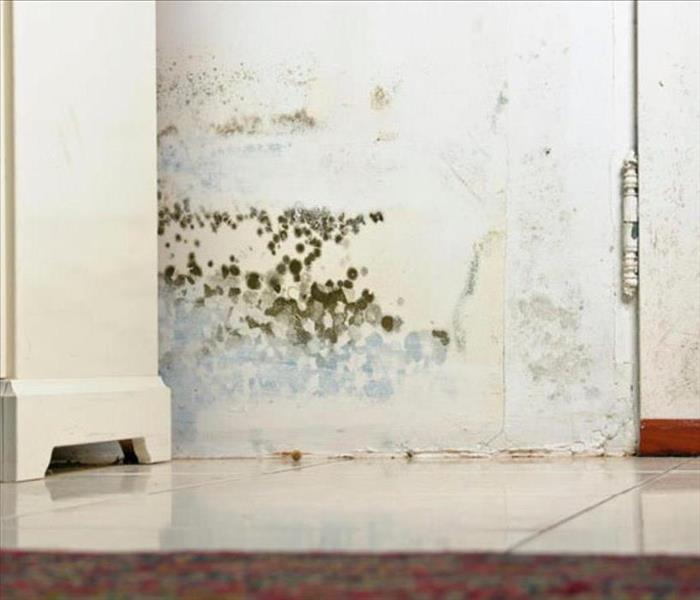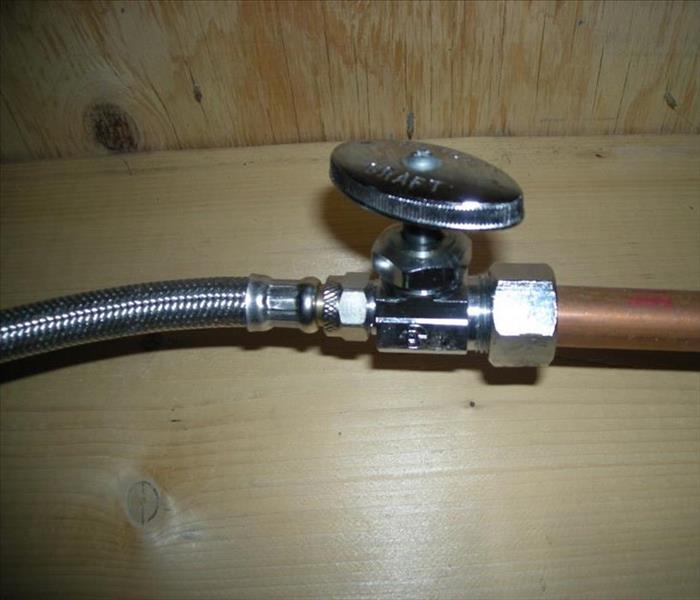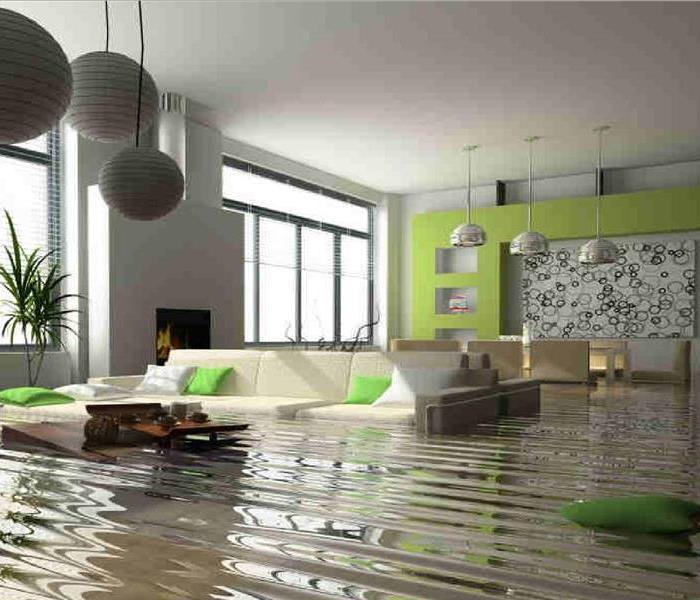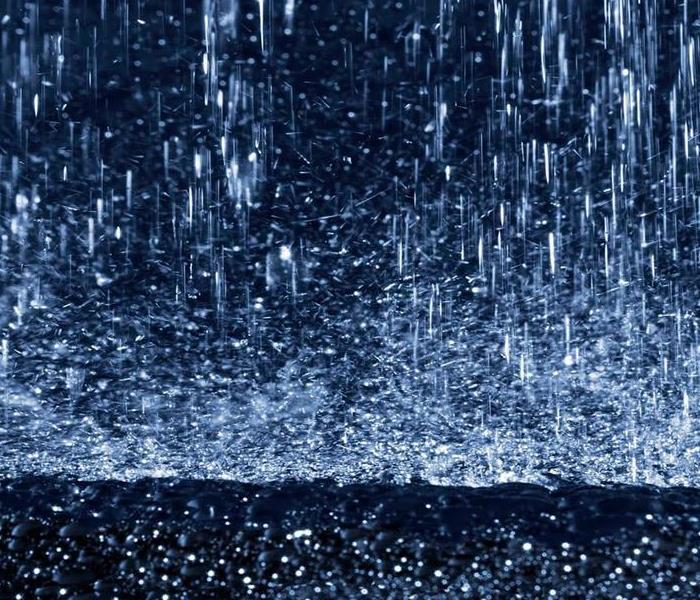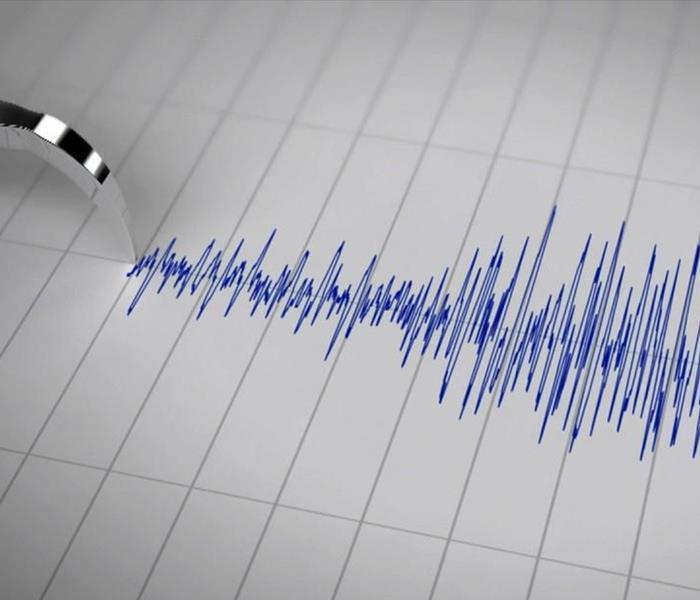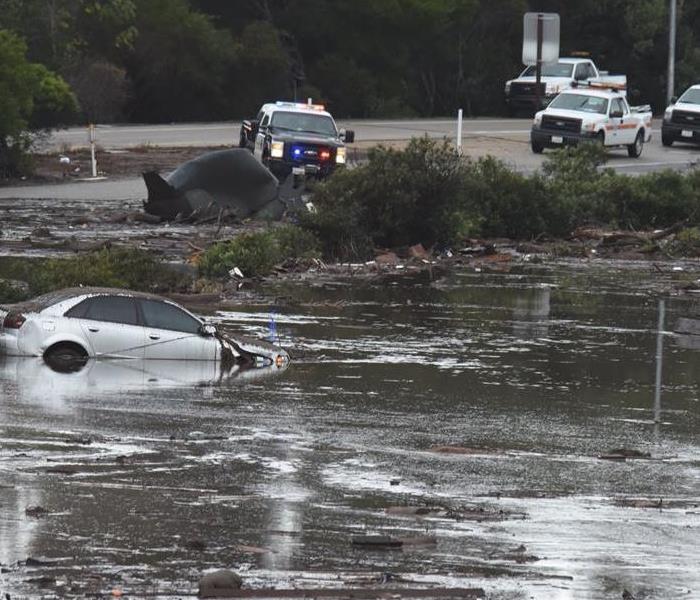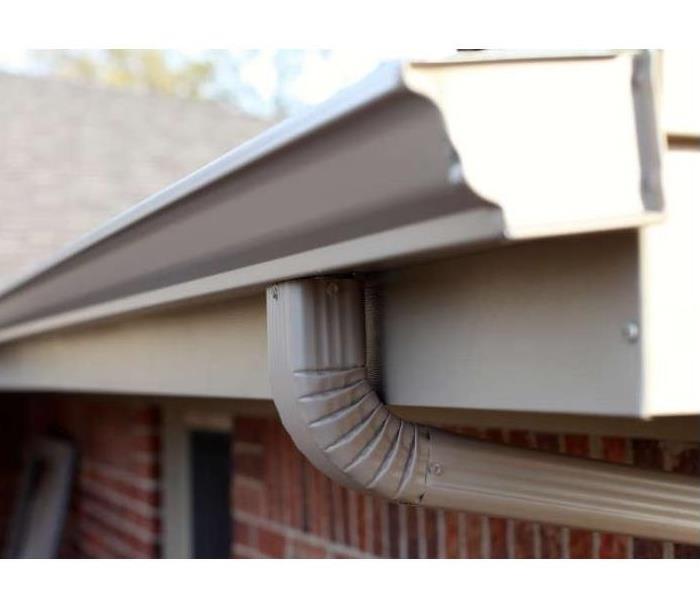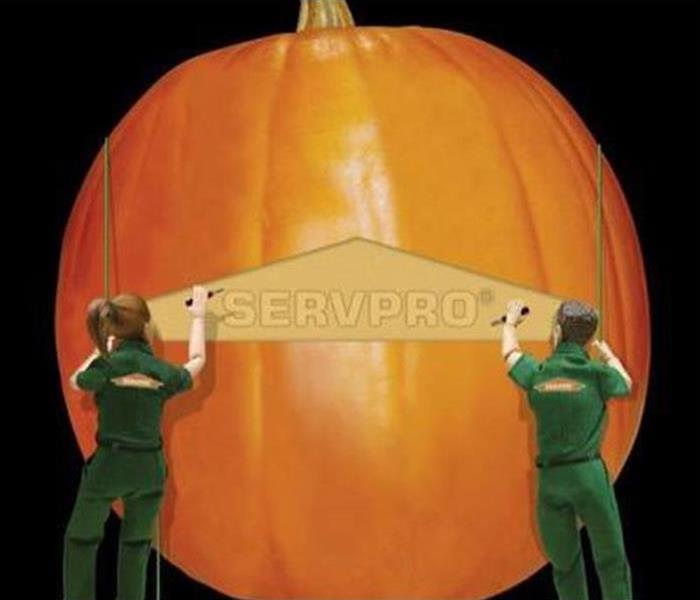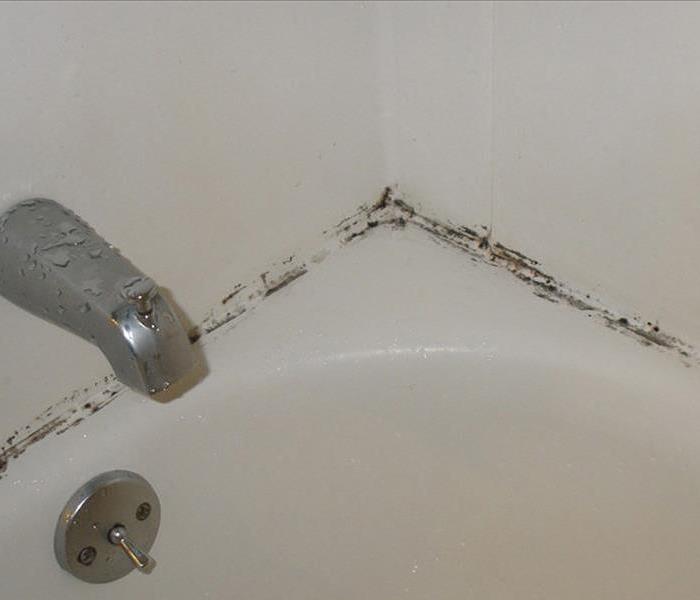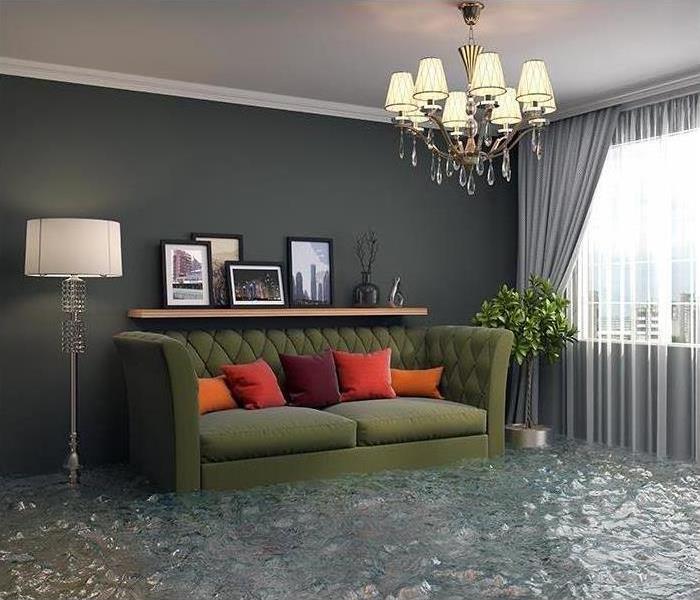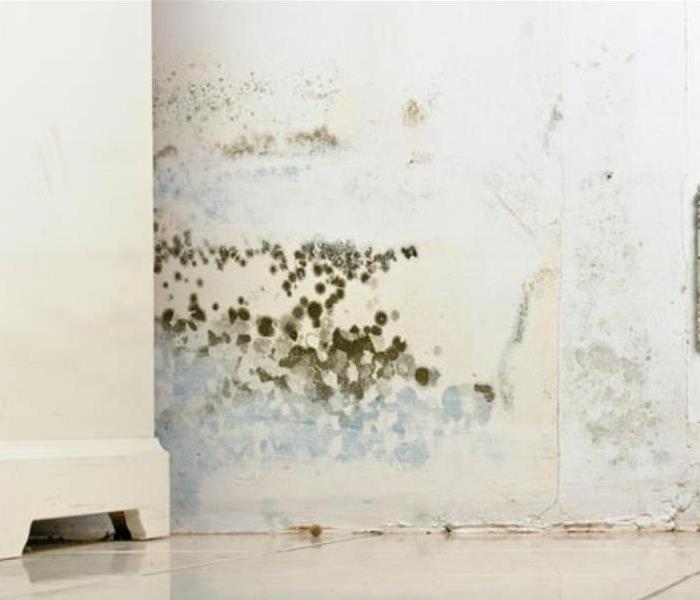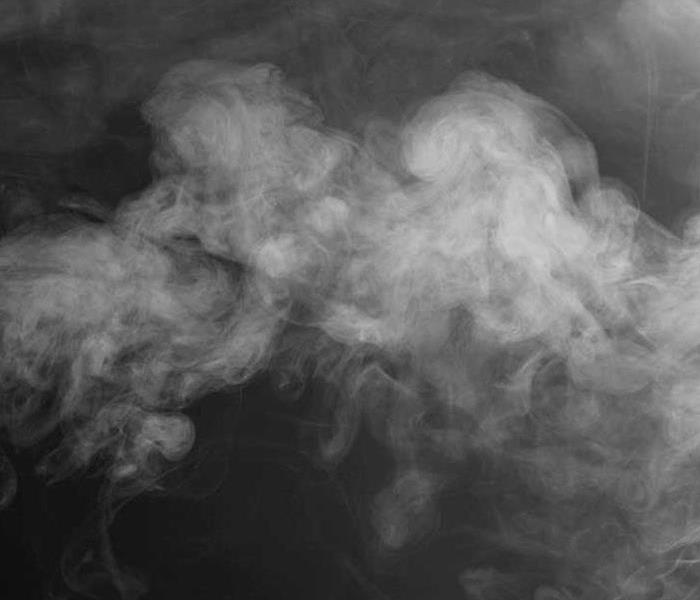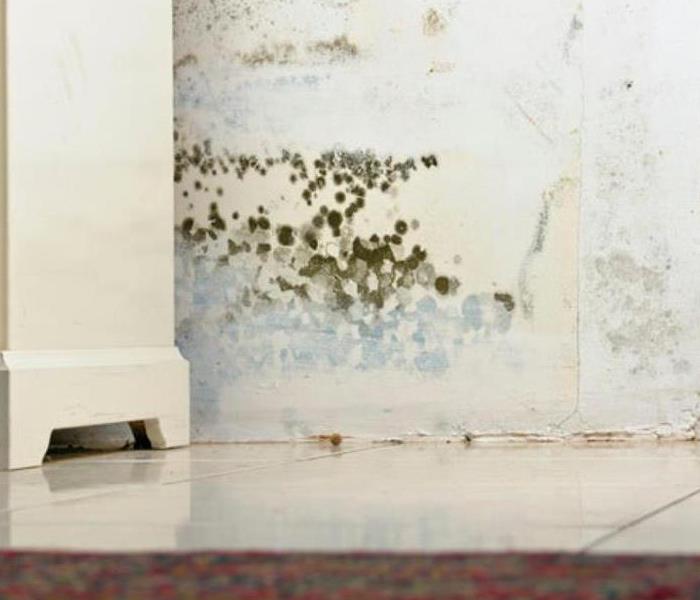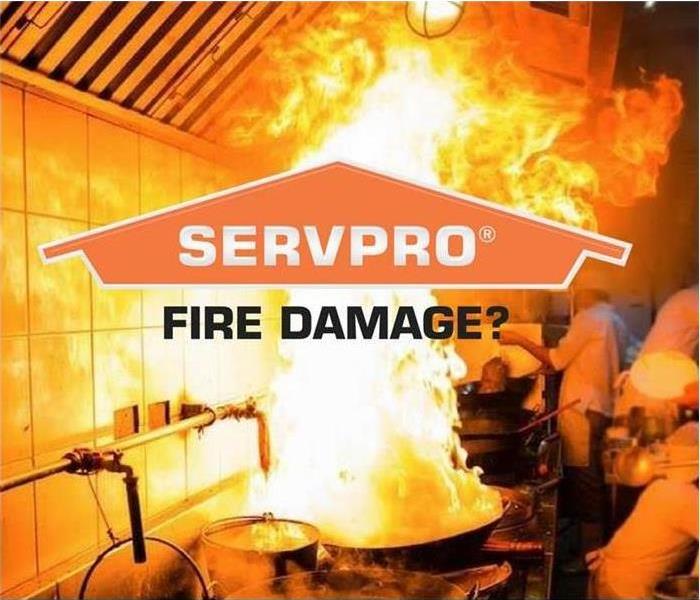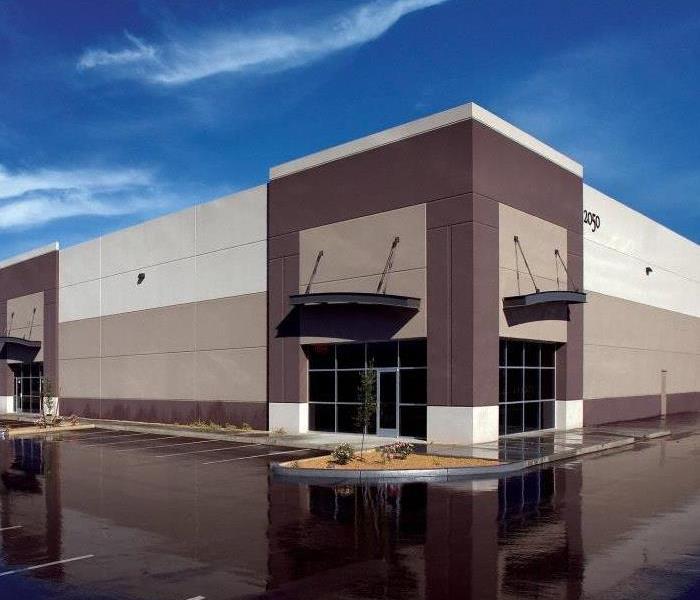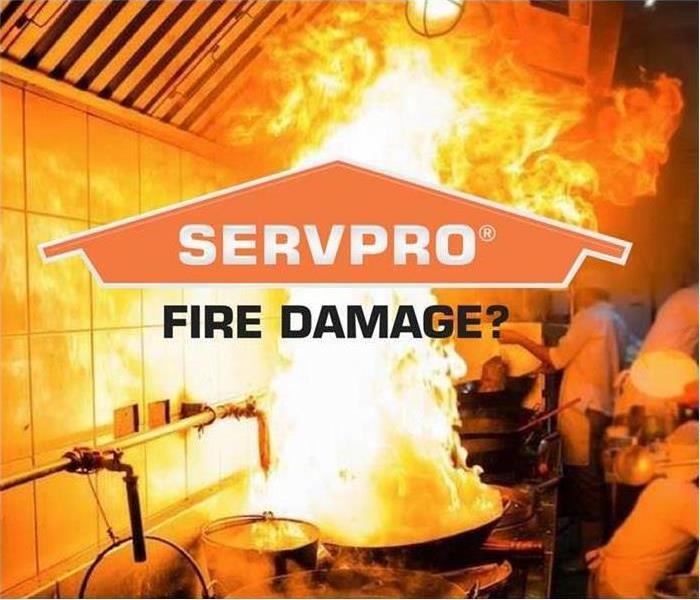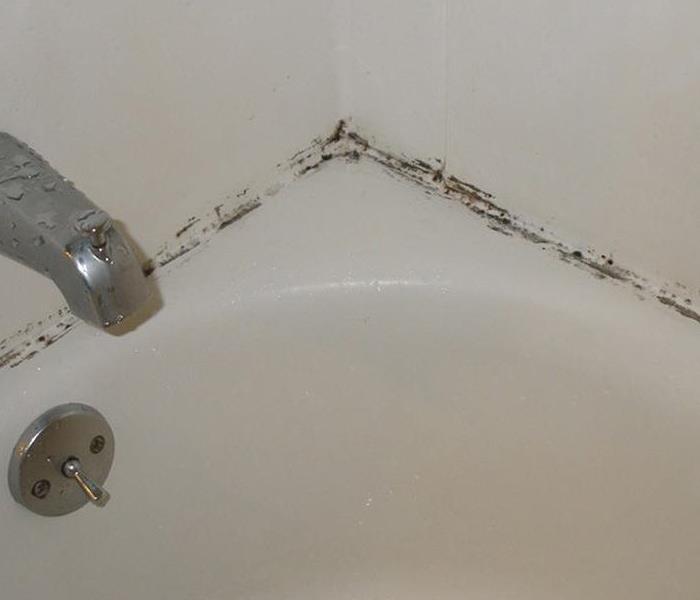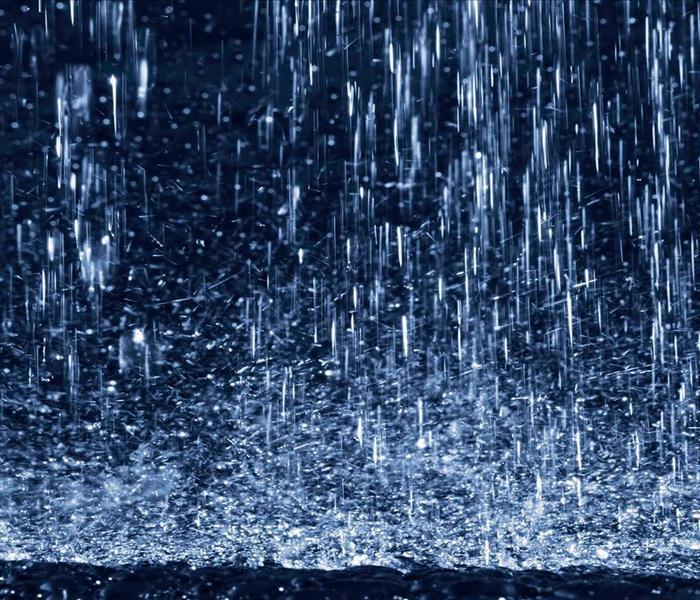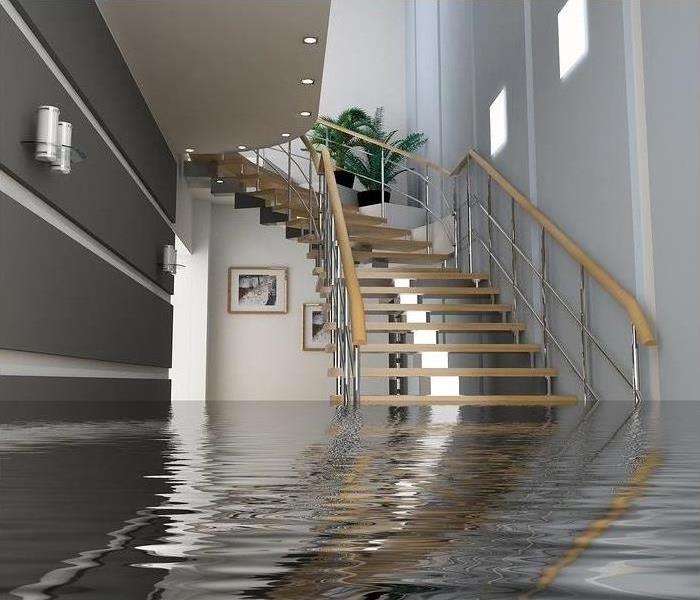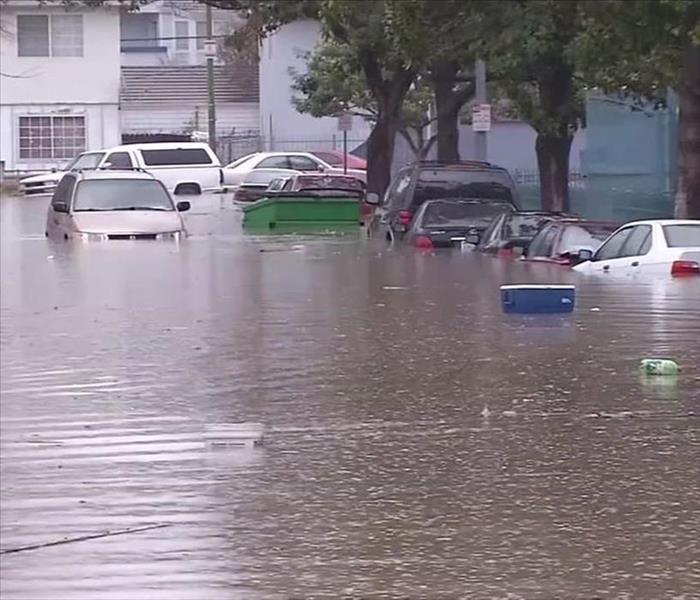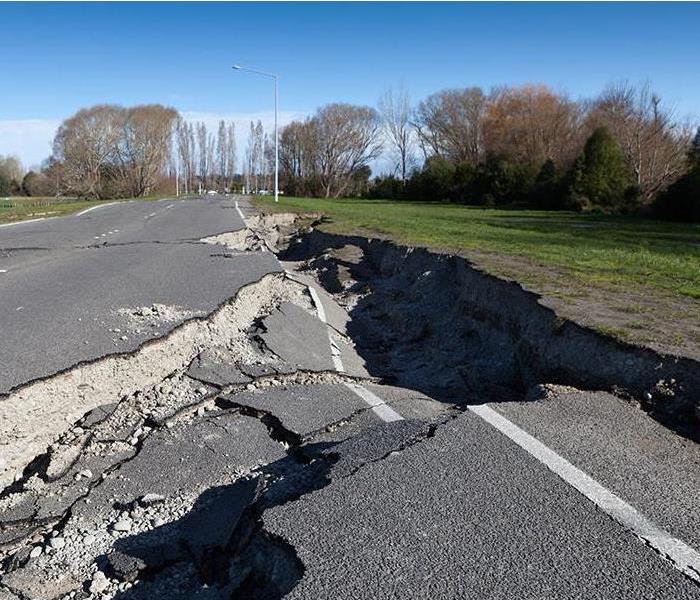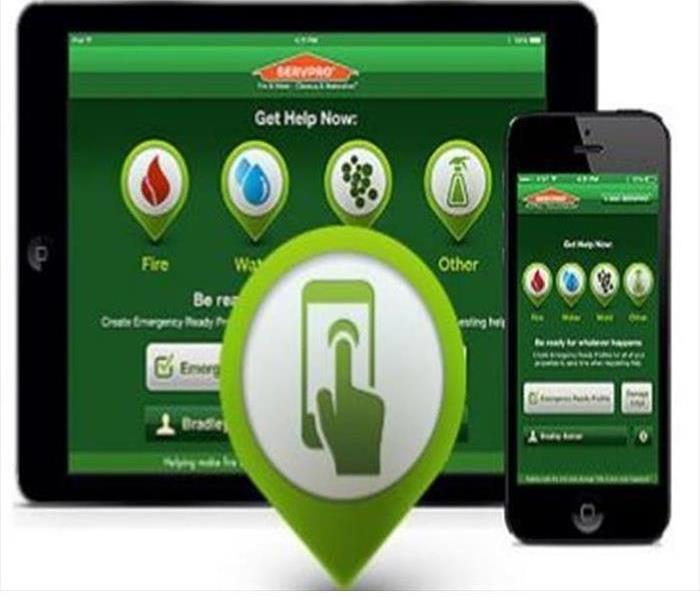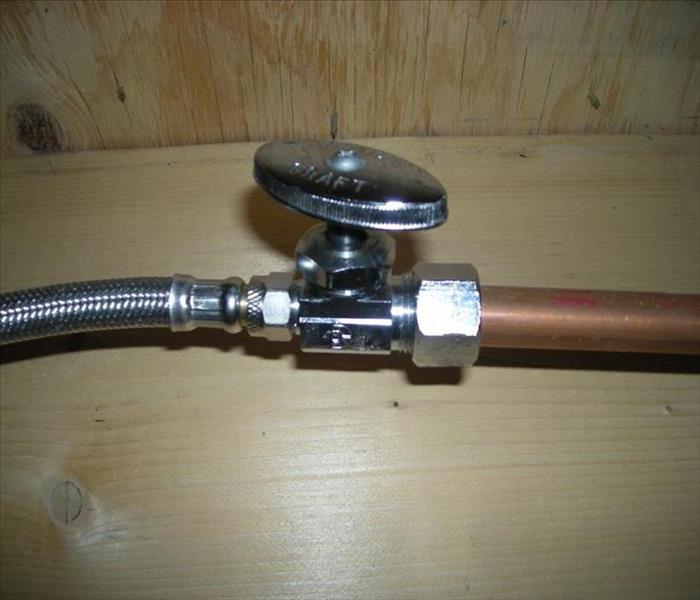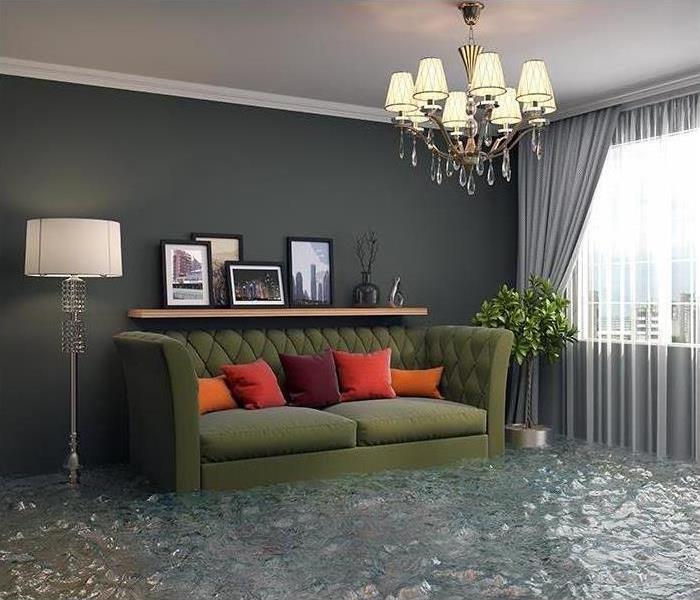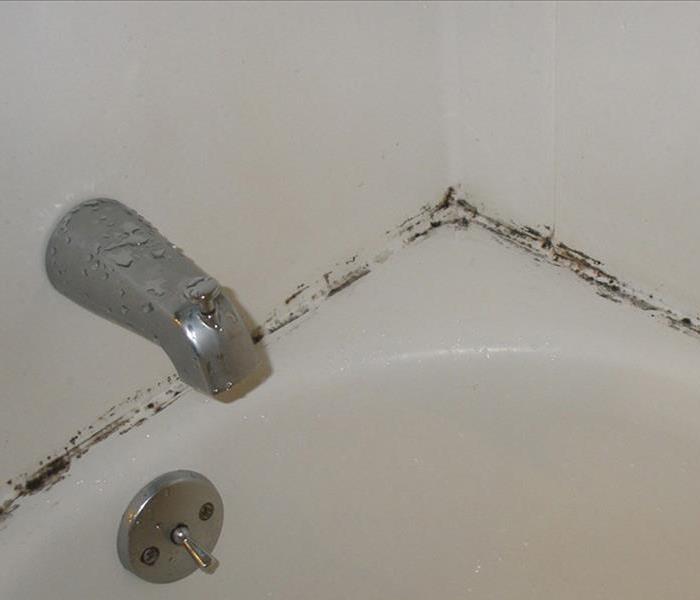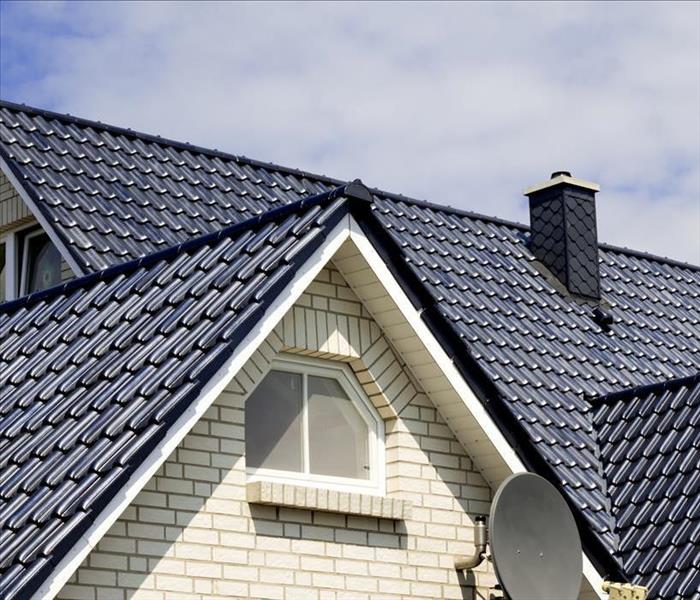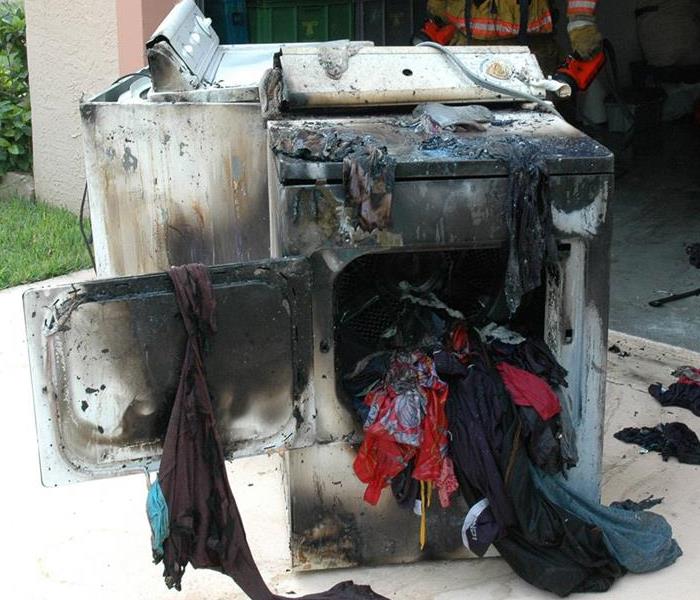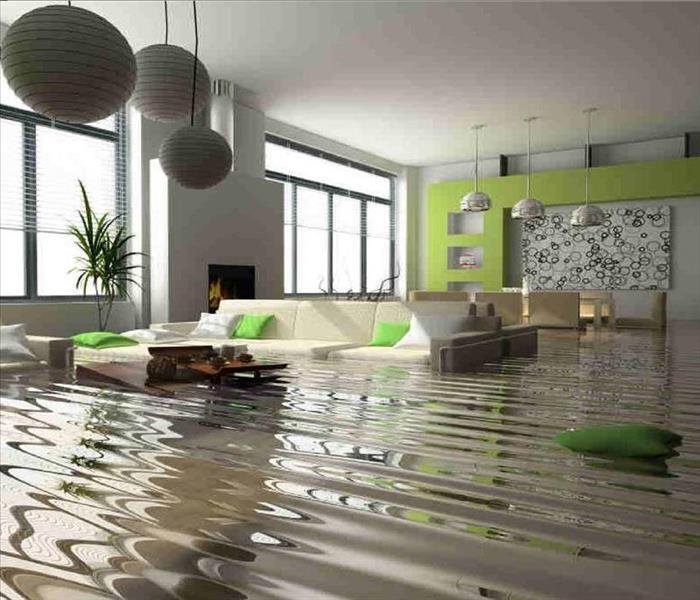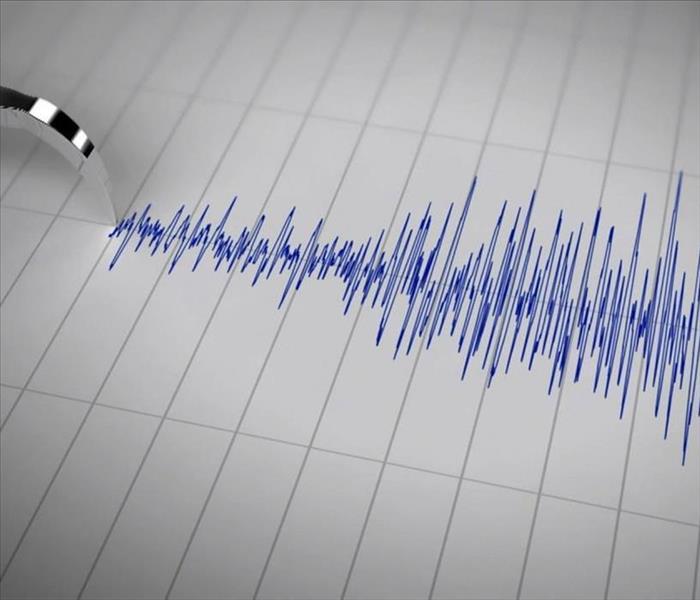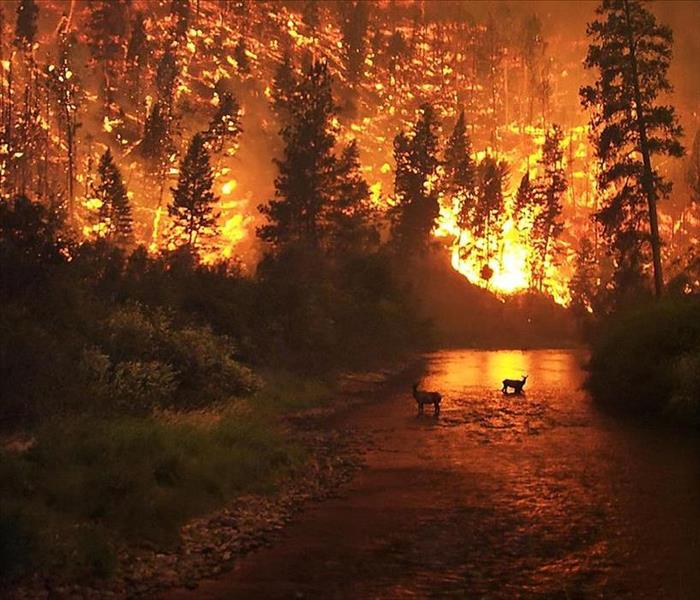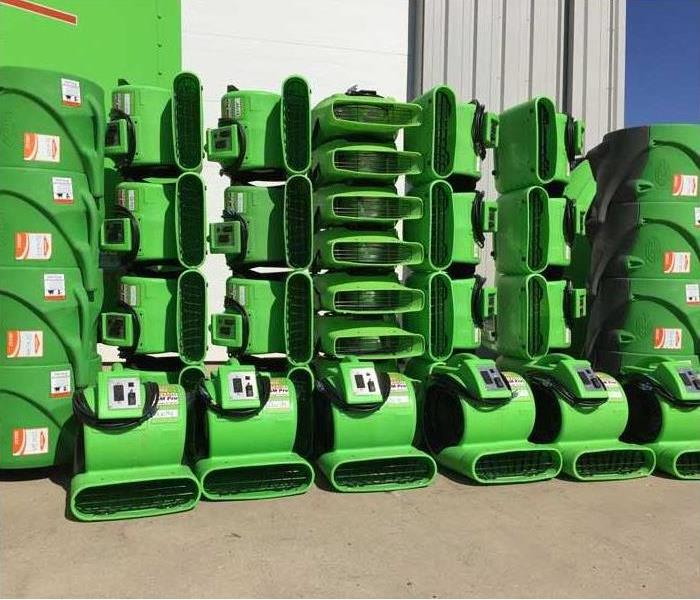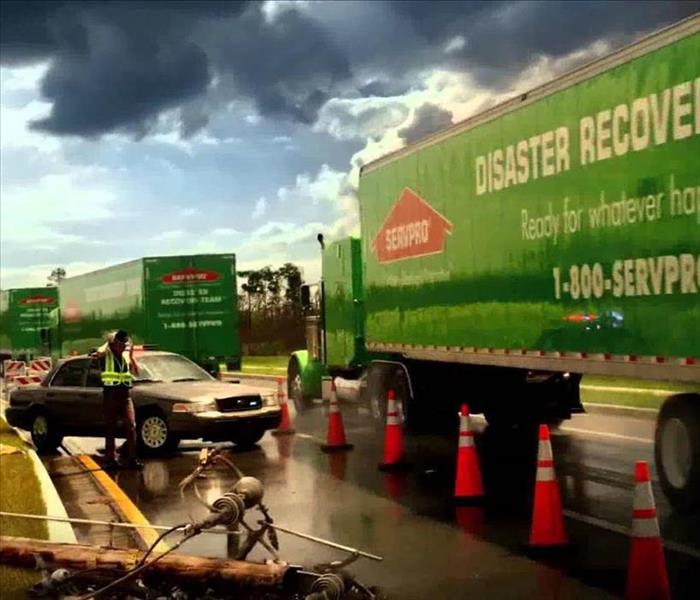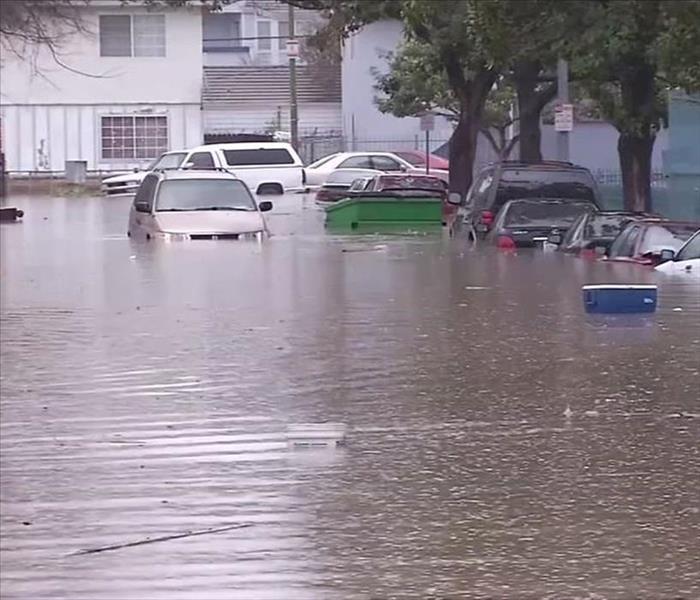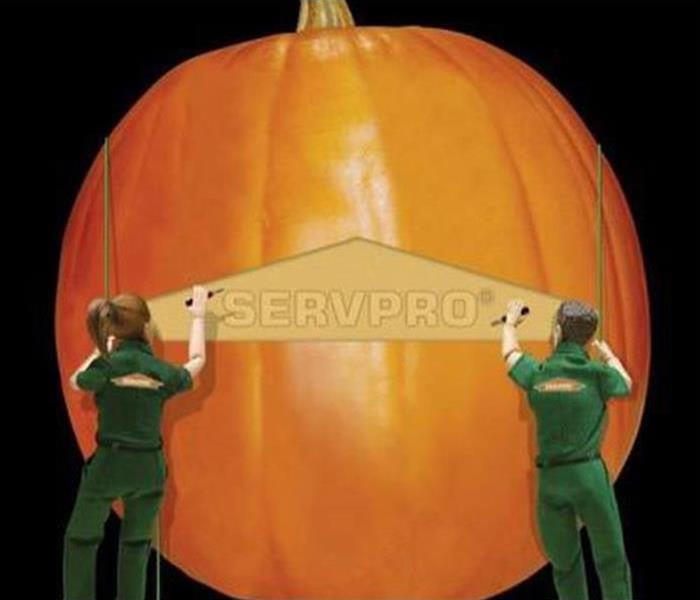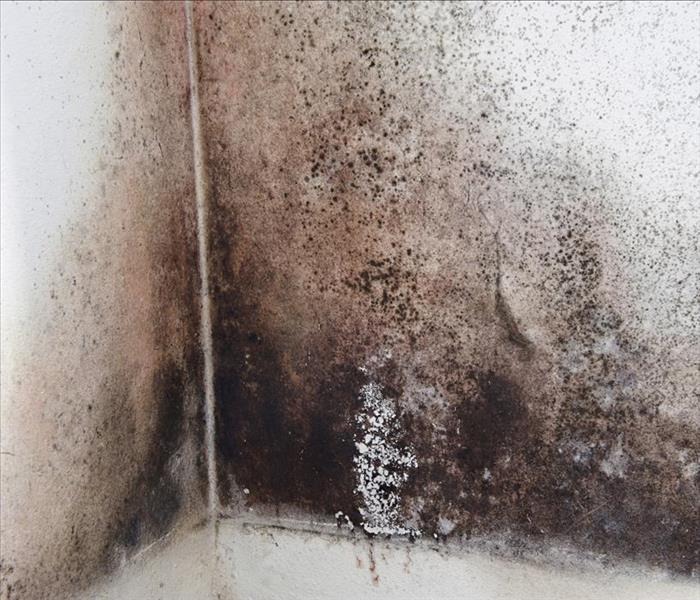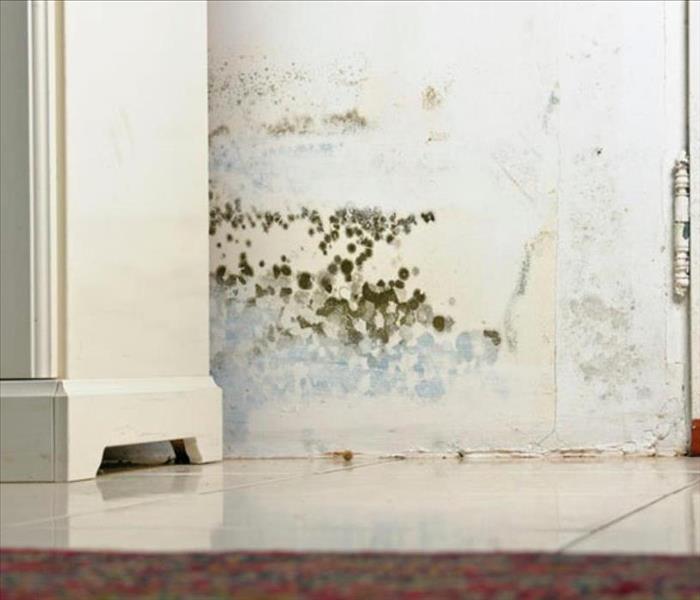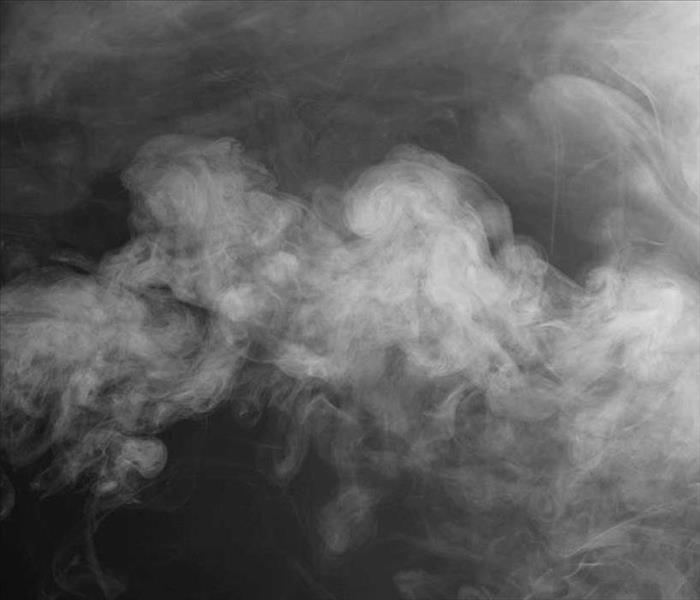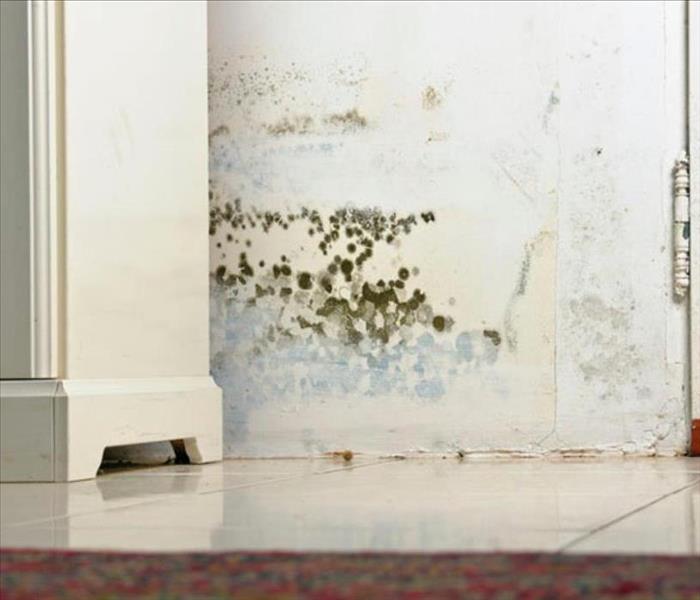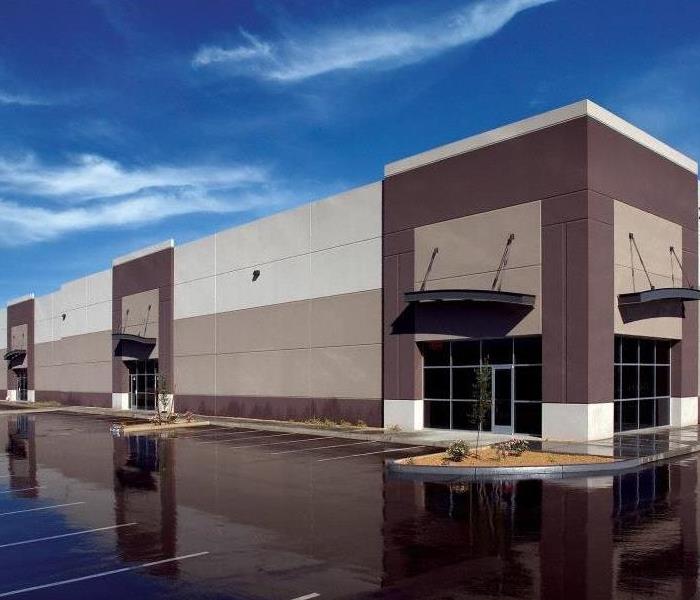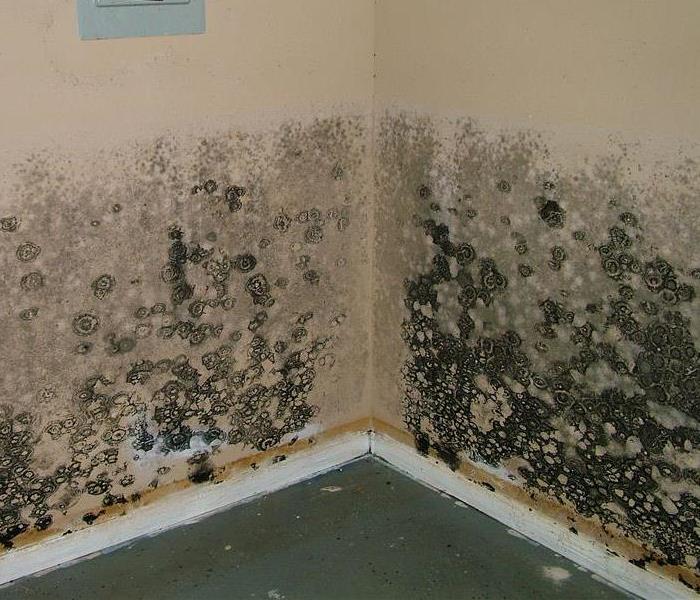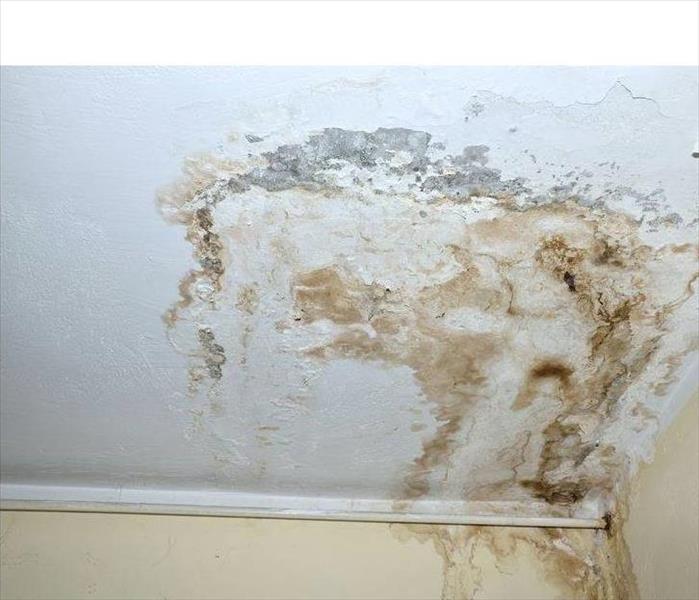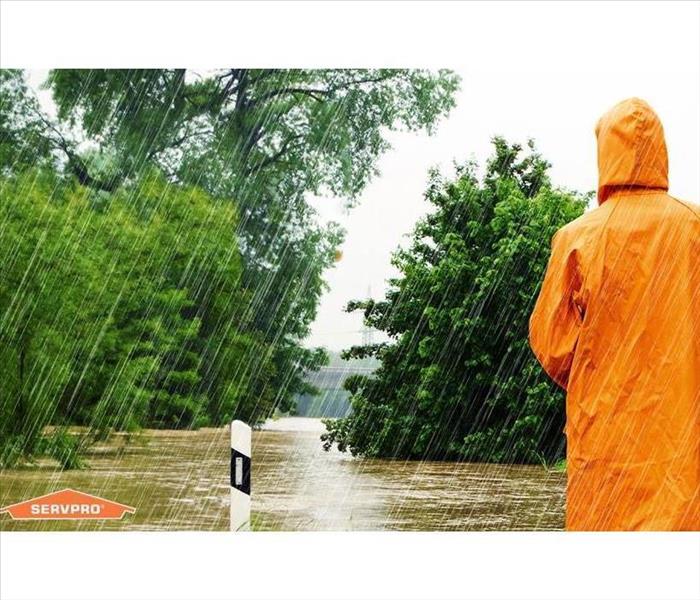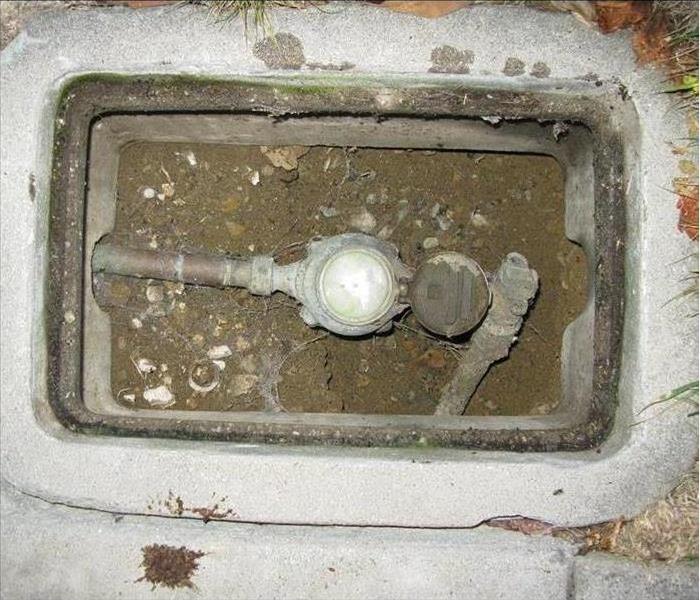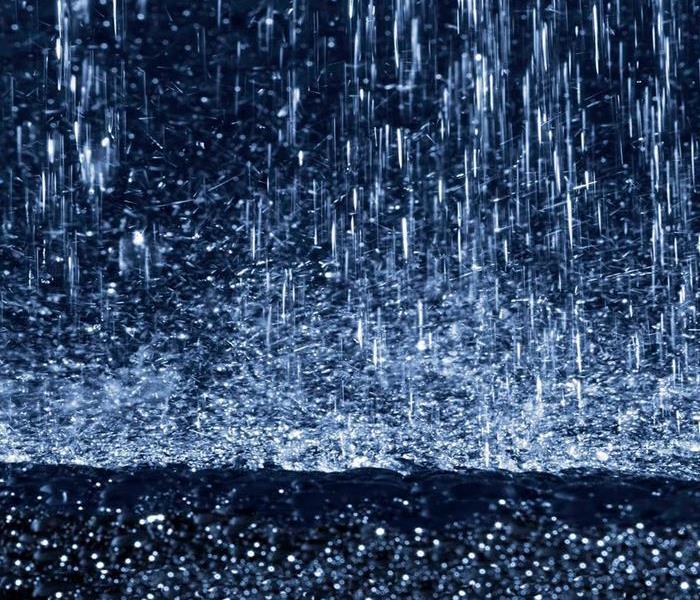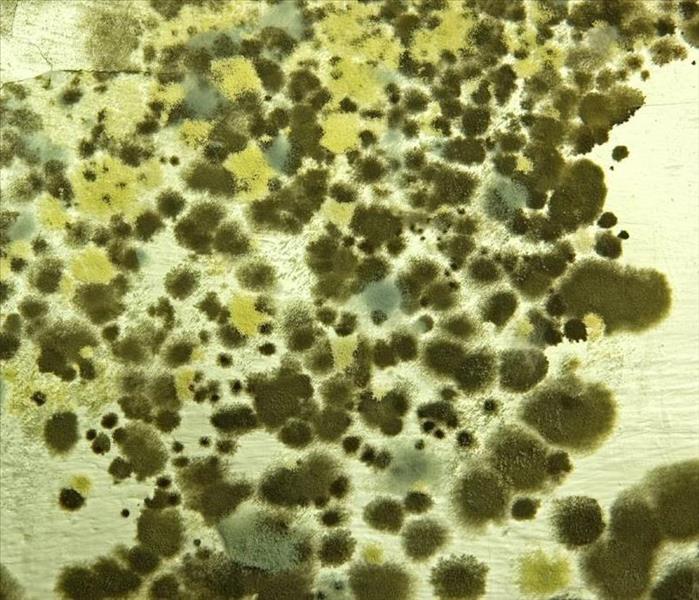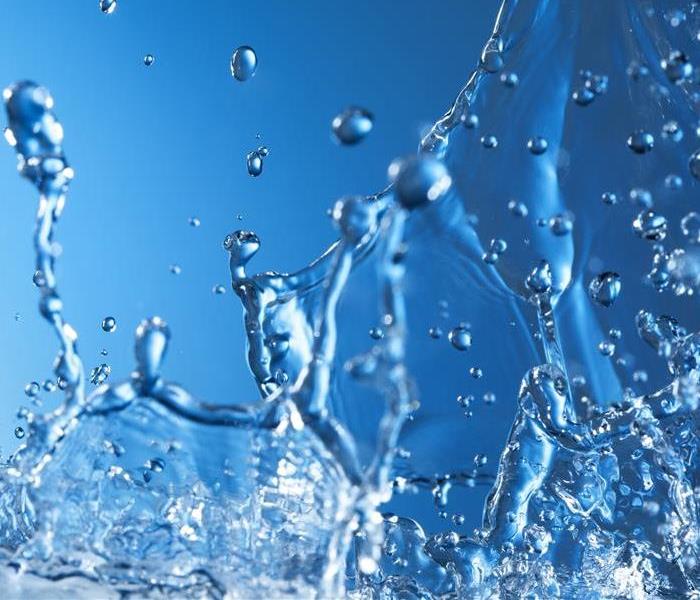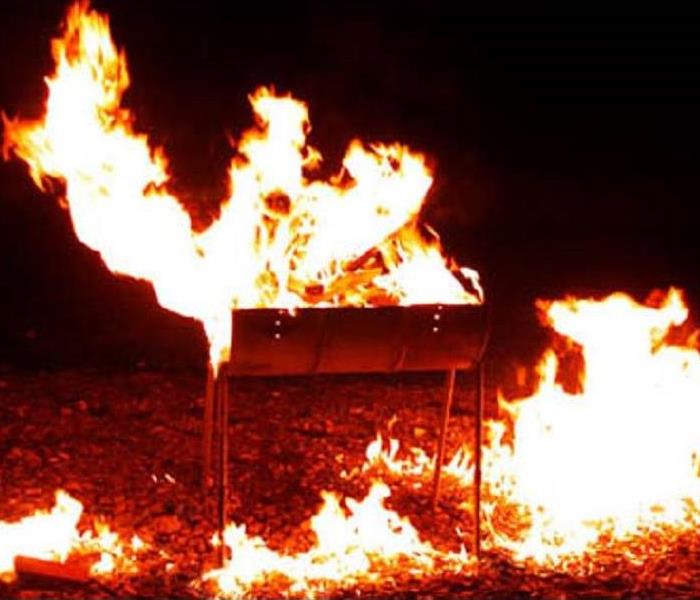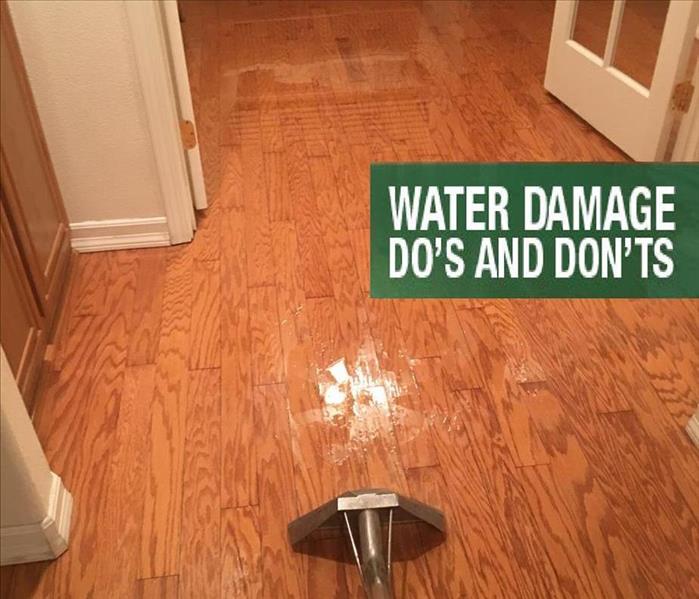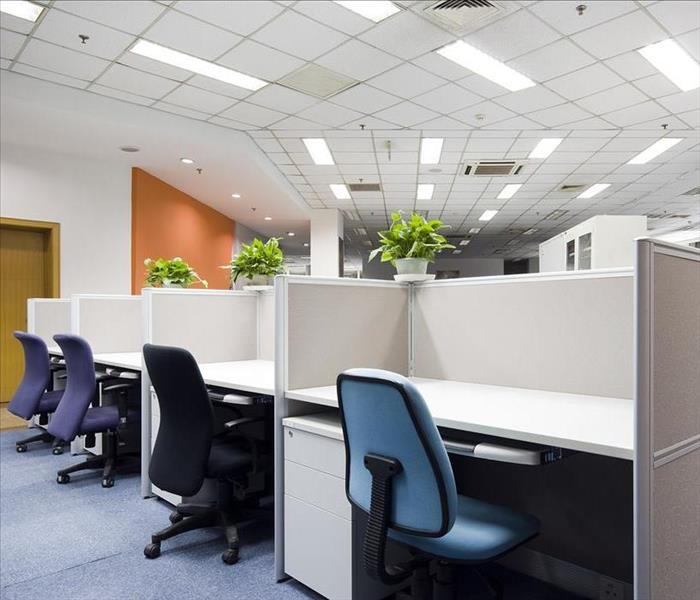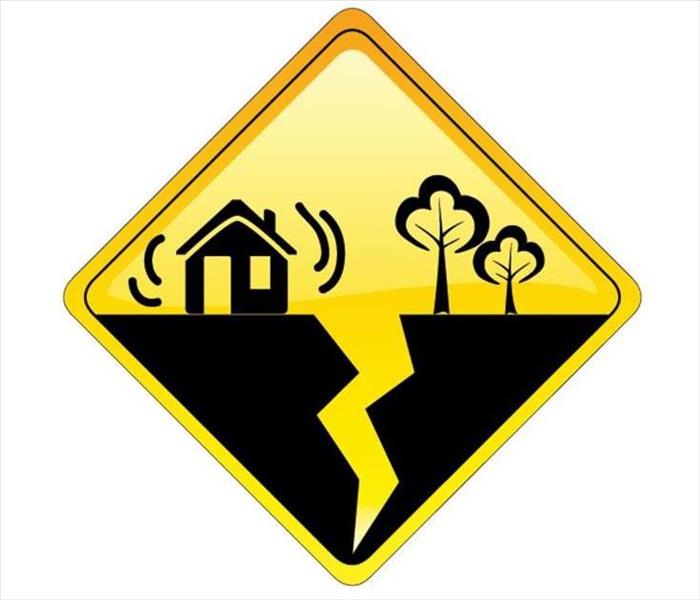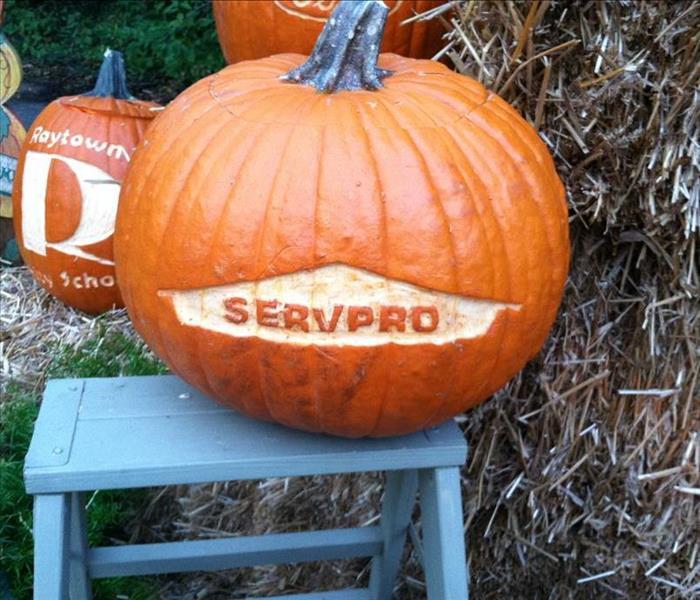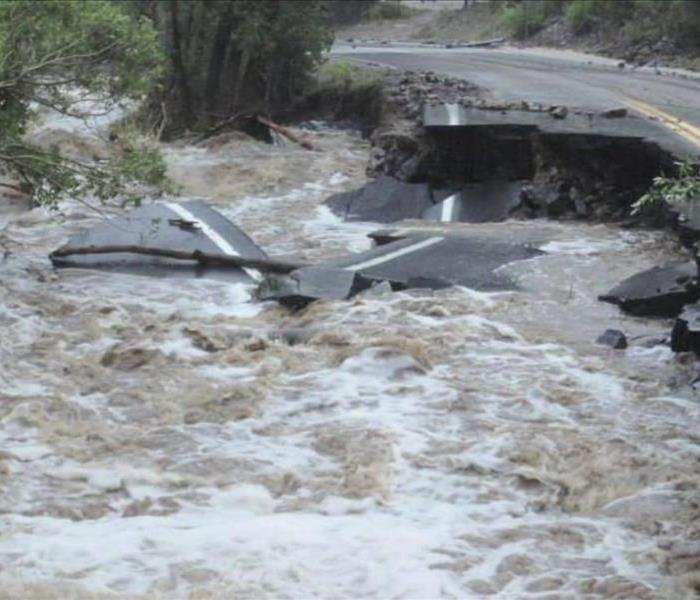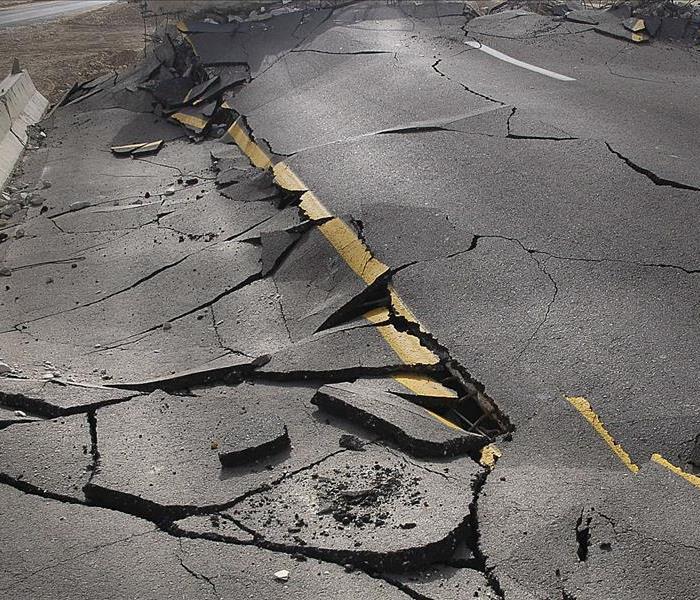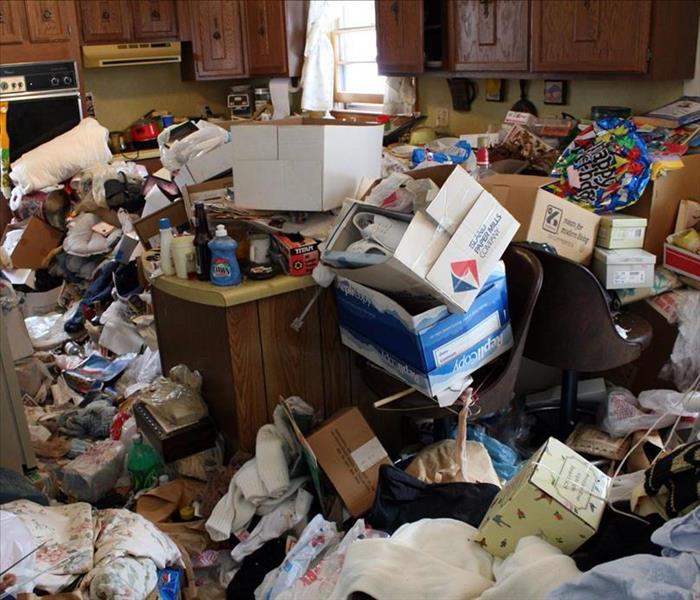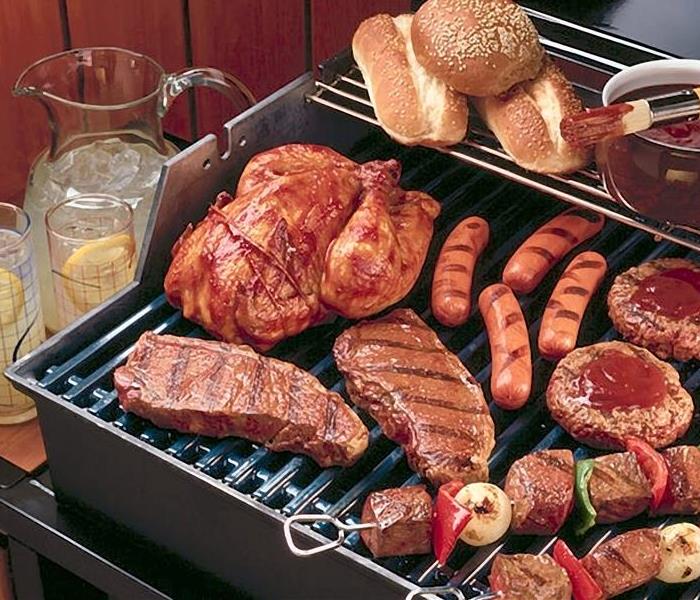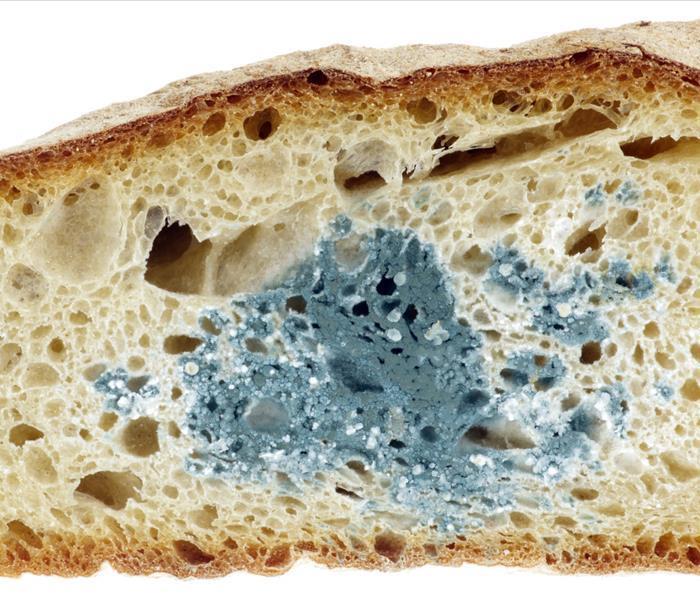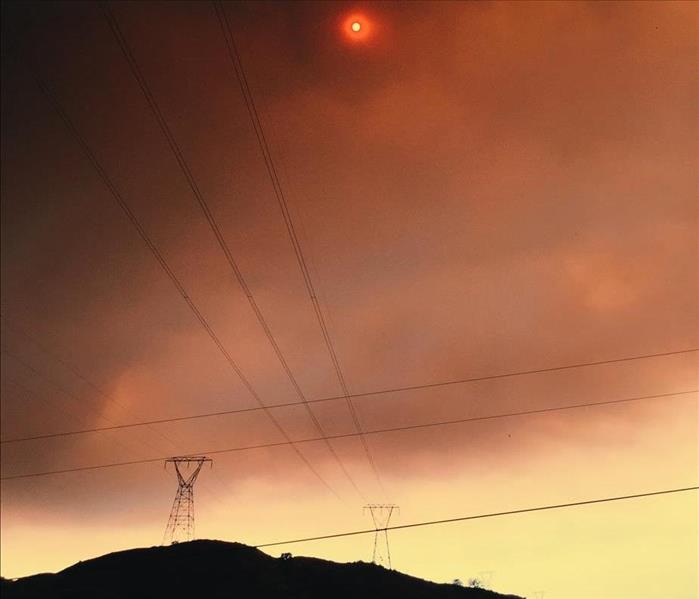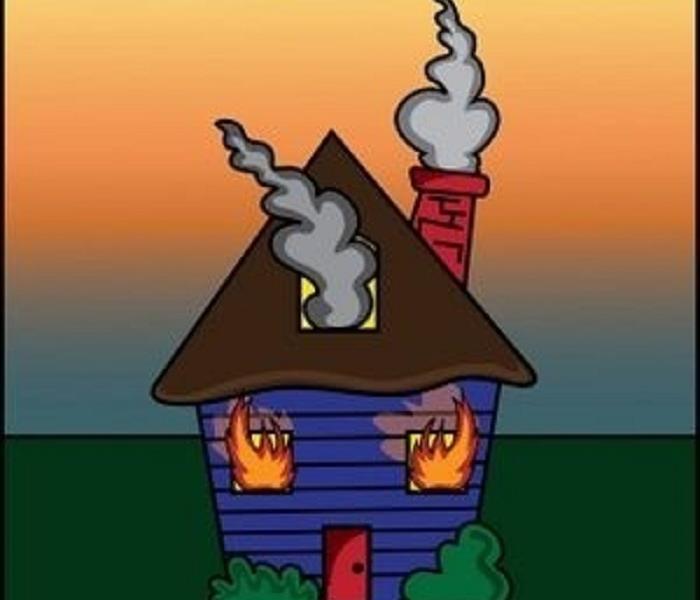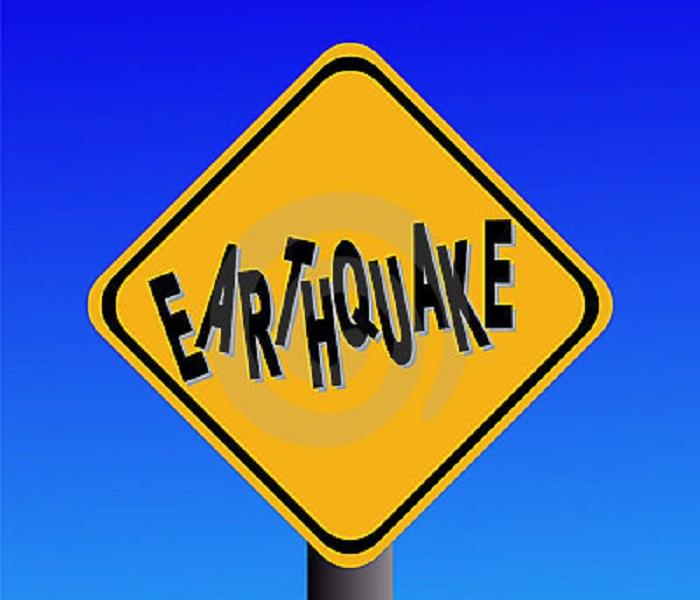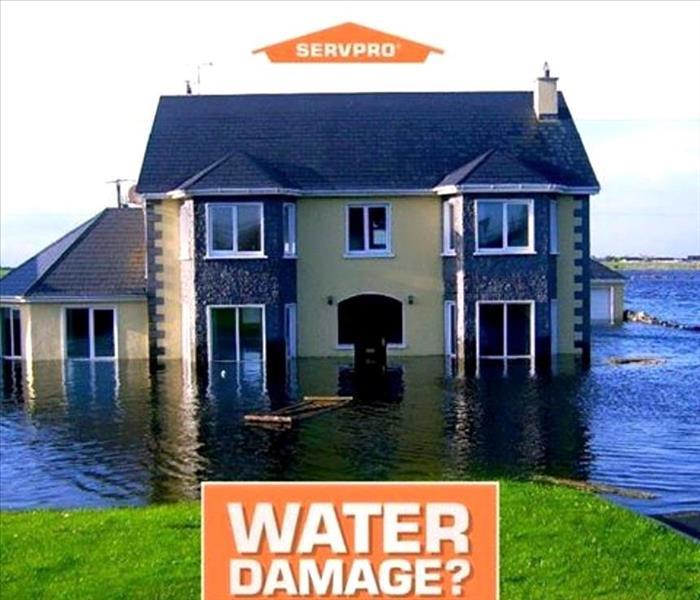Archived Blog Posts
SERVPRO and The American Red Cross
9/26/2022 (Permalink)
 SERVPRO Van
SERVPRO Van
The American Red Cross recently recognized SERVPRO®, a cleanup and restoration company, for participating in its Disaster Responder Program. As a member of this program, SERVPRO pledges a donation to the Red Cross as an action of preparation against the calculated 66,000 disasters that occur annually. SERVPRO is entering their third year of partnership with the Red Cross, and to date their donations to the organization exceed one million dollars.
The majority of the disasters that occur every year are house fires. Statistics cited by the Red Cross state that in the U.S. seven people die in a home fire each day. The Red Cross has aimed to reduce deaths and injuries caused by home fires 25 percent by the year 2019. Because of this goal, they launched a Home Fire Campaign in October of 2014. The support of SERVPRO and other Disaster Responder Program members allows the Red Cross to pursue their home fire prevention goals while continuing to provide critical services to disaster victims.
"Statistics compiled by the National Fire Protection Association (NFPA) show the majority of home fires are related to cooking accidents." Dave Tronson, owner of SERVPRO of Chatsworth / Stevenson Ranch, states, "the risk for home fires exists all year long," further extending their pledge to help Red Cross to respond and prevent such a disaster as a home fire.
Not only does SERVPRO help other business and home owners with recovery for fires, floods, and other disasters, the company and its franchises actively support disaster preparedness education, including fire prevention efforts. When disaster strikes, the relationships with major insurance companies combined with the industry-leading job-management technology that SERVPRO has can smooth the path to rebuilding and restoration for home and business owners affected by disastrous events.
"SERVPRO’s commitment to the Red Cross Disaster Responder Program means that when disaster strikes, homeowners can count on the Red Cross to address their immediate needs and supply essential services," said Tronson. "Once the immediate emergency is under control, homeowners can count on the expertise of restoration specialists at SERVPRO of Chatsworth / Stevenson Ranch to help restore their property and move forward with their lives."
For fire prevention tips and information about fire and water damage restoration services, please visit www.SERVPRO.com. For more information on SERVPRO® of Chatsworth / Stevenson Ranch, please contact Dave Tronson at (818) 709-6090 or SERVPRO2720@SERVPROburbank.com
About SERVPRO®
Founded in 1967, the SERVPRO® Franchise System is a leader and provider of fire and water cleanup and restoration services, and mold mitigation and remediation. SERVPRO's professional services network of more than 1,700 individually owned and operated Franchises responds to property damage emergencies ranging from small individual disasters to multi-million dollar large-loss events. Providing coverage in the United States and Canada, the SERVPRO® System has established relationships with major insurance companies and commercial clients, as well as individual homeowners.
Tips To Avoid A Flood
9/26/2022 (Permalink)
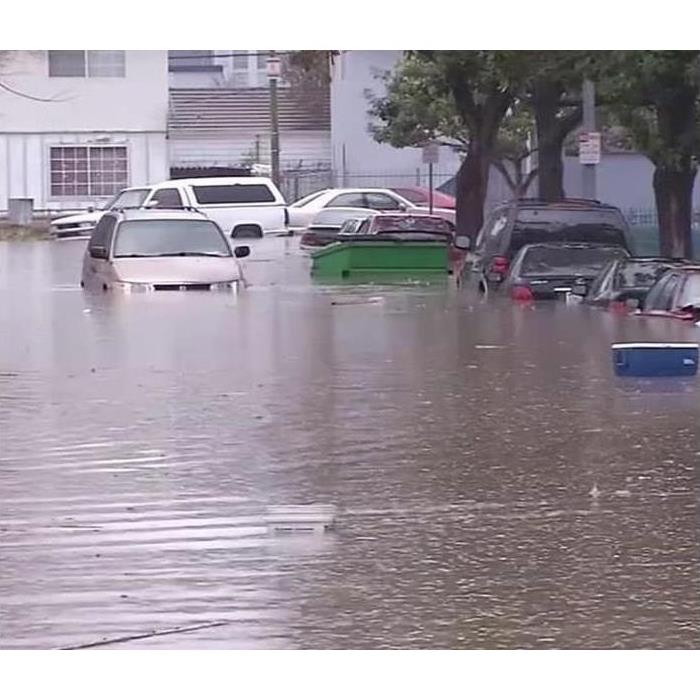 Flood
Flood
Floods are the most common natural disasters in the United States. There are many effects a heavy rain storm can cause. Some significant things such as flooding, potential flash floods, mud-flows, or over-topping levees and dams. Here in California heavy rains can happen, putting properties like your home or business at risk.
Tips to help your home or business avoid floods:
- Purchase flood insurance. (Call your insurance agent make sure your covered for FLOODS)
- Install rain gutters and other drainage systems. (Clean out rain gutters frequently)
- Fix any leaks IMMEDIATELY.
- Extra roof protection (spend a few hundred dollars more to install a rubber roof underlayment, a waterproof barrier that goes under the shingles and protects the roof from water intrusion.)
Tips for drivers during the rain season:
- Avoid cruise control (This feature works great in dry conditions, but when used in wet conditions, the chance of losing control of the vehicle can increase)
- Slow down and leave room in front of you (Slowing down during wet weather driving can be critical to reducing a car’s chance of hydroplaning, when the tires rise up on a film of water.)
Remember if you do experience a flood in your home or business SERVPRO of Chatsworth / Stevenson Ranch is one call away and we make your water damage "Like it never even happened."
Call SERVPRO of Chatsworth/Stevenson Ranch at (818) 842-1400
Tips For Rainy Weather
9/26/2022 (Permalink)
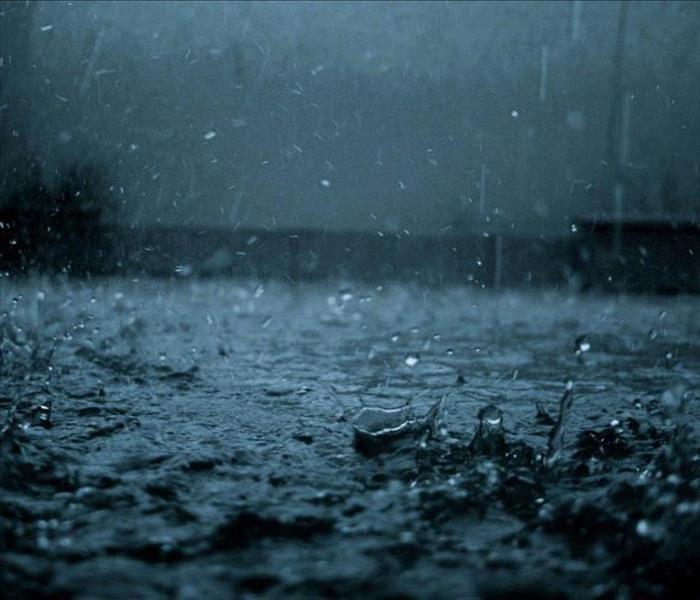 Rain
Rain
Here are some tips for your home and rainy weather!
Tip #1: Check those gutters! This can be a simple but very effective way to prevent unwanted water from entering your home or business. Gutters that are clogged with debris from overhanging trees, trash, or roofing materials can easily clog the drain and shuffle unwanted water your way.
Tip #2: Tarp up any unfinished roofing projects. Going along with our first tip, small openings in the roof of your home and business can quickly become large openings with heavy rain, causing water damage inside your building. Make sure to give your local roofing company a call and get those potential problem areas patched up ASAP.
Tip #3: Examine your window glaze and compound. Often times, glazing compound can shrink during the warmer months, making windows more susceptible to unwanted rain water penetration. Your local contractor can help patch this up for you, ensuring that you are set and ready for even the heaviest of rains! Another helpful tip… make sure you close your windows before going to bed or leaving the home!
And finally, Tip #4 (the most important!): Should you find yourself in a situation where you do have a water damage emergency, call SERVPRO of Chatsworth / Stevenson Ranch. Our staff is prepped and ready to respond and help make your rain disaster, "Like it never even happened."
Mold Experts
9/26/2022 (Permalink)
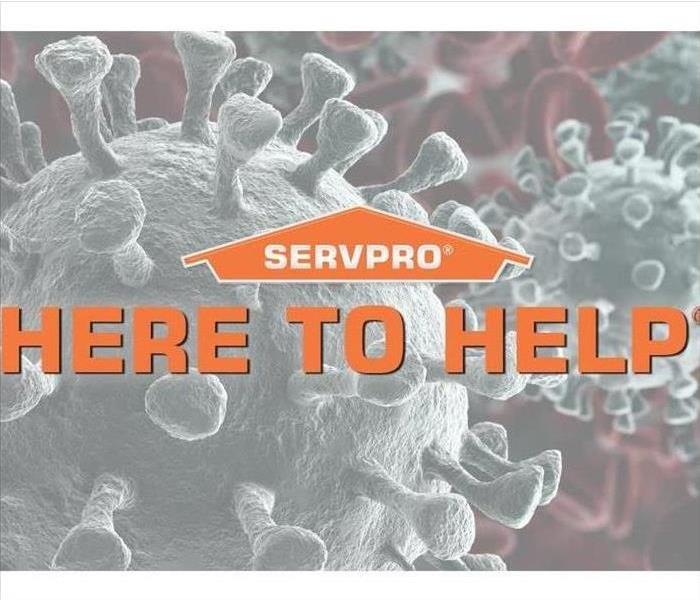 Here to help
Here to help
9/24/2021
If you see visible mold, do not disturb it. You can inadvertently spread the mold infestation throughout your home. When mold is disturbed, the mold can release microscopic mold spores which become airborne and can circulate inside your home.
What to Do:
· Stay out of affected areas.
· Turn off the HVAC system and fans.
· Contact SERVPRO of Chatsworth / Stevenson Ranch for mold remediation services.
What Not to Do:
· Don’t touch or disturb the mold.
· Don’t blow air across any surfaces with visible or suspected mold growth.
· Don’t attempt to dry the area yourself.
· Don’t spray bleach or other disinfectants on the mold.
About Our Mold Remediation Services
SERVPRO of Chatsworth / Stevenson Ranch specializes in mold cleanup and restoration; in fact, it’s a cornerstone of our business. Our crews are highly trained restoration professionals that use specialized equipment and techniques to properly remediate your mold problem quickly and safely.
If You See Signs of Mold, Call Us Today – (818) 842-1400
What is Soot?
8/26/2022 (Permalink)
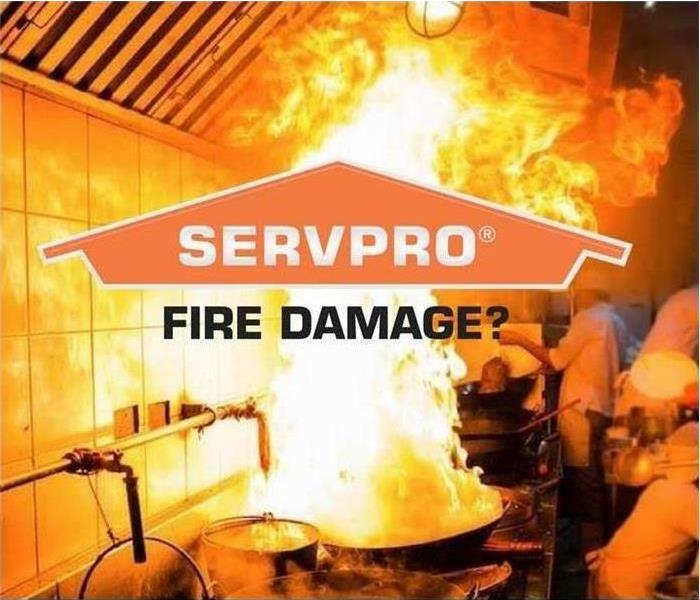 Fire Damage
Fire Damage
What exactly is soot?
SERVPRO of Chatsworth / Stevenson Ranch is happy to give some insight on what the common black powder substance is.
Soot is described as the fine black particles composed of carbon. It is created by incomplete combustion of coal, oil, wood and other fuels. It can consist of acids, chemicals, metals, soils and dust. The main trait of soot is it's size, the particles are extremely tiny, 2.5 micrometers or smaller.
Is soot dangerous?
With soot often containing chemicals in addition with its tiny size, it can cause health effects.
Compounds from soot are sulfur dioxides and nitrogen dioxides, they combine with moisture and form acid rain which then worsens water quality and damages crops. In addition, it can also change nutrient balances in many ecosystems.
Fire Preparedness
8/26/2022 (Permalink)
 SERVPRO Van
SERVPRO Van
Developing Fire Safe Habits For Your Home is very important here in SoCal. SERVPRO of Chatsworth / Stevenson Ranch and the Red Cross have some tips on how to do so:
- Keep items that can catch on fire at least three feet away from anything that gets hot, such as space heaters.
- Smoking materials are the leading cause of residential fire deaths in the United States. If you smoke, take precautions: Smoke outside; choose fire-safe cigarettes; never smoke in bed, when drowsy or medicated, or if anyone in the home is using oxygen.
- Use deep, sturdy ashtrays and douse cigarette and cigar butts with water before disposal.
- Talk to children regularly about the dangers of fire, matches and lighters and keep them out of reach.
- Turn portable heaters off when you leave the room or go to sleep.
- Never leave a burning candle unattended, even for a minute.
Information provided by redcross.org
Water Loss Categories
8/26/2022 (Permalink)
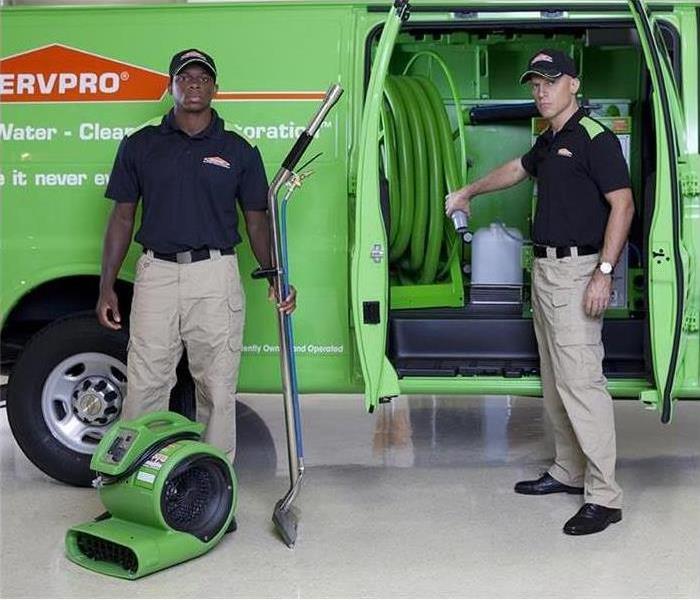 SERVPRO Technicians
SERVPRO Technicians
If you've been in and around a water loss you may have often heard the reference of which category the loss is under. So what exactly does that mean? SERVPRO of Chatsworth / Stevenson Ranch will shed some light on the three categories of a water loss and what they mean.
Category 1: Refers to the source of water as being "clean water" otherwise meaning a source of water that does not pose a substantial threat to humans. Examples:
- Broken water supply line
- Sink or tub overflow
- Appliance malfunction
Category 2: Refers to the source of water as containing a significant degree of chemicals, biological or physical contaminants that cause discomfort or sickness when consumed or exposed to. It is often referred to as "grey water" Examples:
- Toilet bows w/urine (no feces)
- Sump pump failures
- Seepage from washers
Category 3: Referred to as "black water" and is grossly contaminated. This water contains unsanitary agents, harmful bacteria and fungi, causing severe discomfort or sickness. Examples:
- Toilet back flows
For all your water damage needs give us a call at 818-842-1400
4th of July Safety
6/17/2022 (Permalink)
 Fireworks
Fireworks
Fourth of July weekend is once again upon us! Each year at SERVPRO of Chatsworth, we remember those who have both come before and those who are currently serving to protect our freedom. Like most people on this holiday weekend, we will be sharing it with family and friends and joining in on the many traditions that has made our Independence Day a day to pull out all the stops!
Though there are many activities to partake in, one of the most popular things to do on the 4th is to light off fireworks. And as long as handled properly, they can be a whole lot of fun.
According to the U.S. Consumer Fire Safety Administration, “230 people on average go to the emergency room every day with fireworks-related injuries in the month around the July 4th holiday.” Though this number may be startling to see, we at SERVPRO of Chatsworth want to see if we can help reduce this number for 2016. In an effort to promote injury and fire prevention, here are some recommended safety tips provided by the USCFSA –
- Never allow young children to play with or ignite fireworks.
- Avoid buying fireworks that are packaged in brown paper because this is often a sign that the fireworks were made for professional displays and that they could pose a danger to consumers.
- Always have an adult supervise fireworks activities. Parents don't realize that young children suffer injuries from sparklers. Sparklers burn at temperatures of about 2,000 degrees - hot enough to melt some metals.
- Never place any part of your body directly over a fireworks device when lighting the fuse. Back up to a safe distance immediately after lighting fireworks.
- Never try to re-light or pick up fireworks that have not ignited fully.
- Never point or throw fireworks at another person.
- Keep a bucket of water or a garden hose handy in case of fire or other mishap.
- Light fireworks one at a time, then move back quickly.
- Never carry fireworks in a pocket or shoot them off in metal or glass containers.
- After fireworks complete their burning, douse the spent device with plenty of water from a bucket or hose before discarding it to prevent a trash fire.
- Make sure fireworks are legal in your area before buying or using them.
And if you are also curious about how to prevent additional mishaps during this 4th of July weekend of celebration, check out the Prevention Tips video our SERVPRO of Chatsworth office put together for your enjoyment!
How to Prevent House Fires
6/17/2022 (Permalink)
 SERVPRO Trucks
SERVPRO Trucks
How to prevent fires at home
Most people know the basics of fire safety at home, such as not leaving burning candles unattended and keeping a fire extinguisher on hand. Here are a few more things you can do to prevent fires at home.
- Have your heating system serviced regularly by a professional, including chimneys from wood-burning fireplaces. Clean around heat sources and keep dust and other flammable items away from ignition sources.
- Remove the lint from your dryer filter after every use. A clogged filter and lint trap makes your dryer less efficient, reduces the airflow needed to keep heat from building up in the vents, and forces lint onto the heating coils. Also, never let your dryer run when you are out of the house or when you’re asleep.
- Keep firewood, piles of leaves and trash away from the home. If a grass fire starts nearby, these items next to your home could easily become kindling. Never dump hot ashes inside or near your home; keep them in a metal container well away from your house and garage.
- Avoid using outlet extenders or plug-in power bars: they can quickly overload an electrical circuit. Replace old, damaged or frayed appliance cords, and never force a three-pronged plug into a two-slot outlet or extension cord.
- Store containers of cooking oil well away from the stove. When cooking with oil, never leave the stove unattended. To stop a grease fire, turn off the burner and place a lid on the pan to suffocate the flames, or pour on lots of baking soda. Never pour water on a grease fire or try to carry the pan outside; water splatters the grease and makes the fire bigger, and the pan will be much too hot to carry.
- Consider using borrowed heat to keep outdoor pets warm. During winter months, avoid using heat lamps, solar lamps, trouble lights, heated watering bowls or other such heated devices, which could lead to a potential fire. Borrowed heat involves providing warmth from a heating system located in a separate building. If this isn’t possible, consider bringing your pets inside.
- Be sure to properly extinguish smoking materials. Smoking materials that are not properly extinguished can smoulder undetected for days before igniting a fire. Never discard smoking materials on the ground or in plant pots.
info provided by https://www.cooperators.ca/en/Answer-Centre/how-can-i-be-safe-and-prepared/home/five-best-ways-to-prevent-fires-in-home.aspx
SERVPRO ERP
6/17/2022 (Permalink)
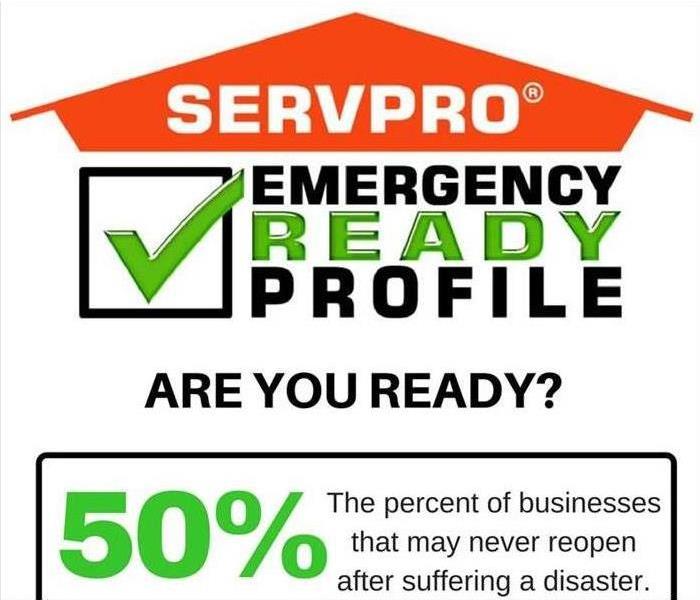 SERVPRO ERP
SERVPRO ERP
It is estimated that up to 50% of businesses that close due to a disaster, such as fire and flood never reopen! Of the businesses that survive, the overwhelming majority of them had a preparedness plan in place.
Are you “Ready for whatever happens?”
Preparation is a key component for making it through any size disaster, whether it’s a small water leak, a large fire, or an area flood. The best time to plan for such events is not when the event happens, but well before it happens.
The SERVPRO® Emergency READY Plan serves as a quick reference of important building and contact information or can be an ideal supplement to any well-designed emergency preparedness or existing contingency program. Rather than simply reacting to disaster situations, most prefer proactive measures to establish a relationship with a restoration services company.
By working with SERVPRO to develop your personalized Emergency READY Plan your business will receive the benefit of over 30 years of experience in reducing the impact of any natural or man-made disaster. SERVPRO is a leader in water and fire damage response for the greater LA area and can help you quickly get your property back in working order.
Call our office at (818) 842-1400 to learn more on how to set up this profile for your facility and get prepared before disaster strikes!
Commercial Earthquake Safety
4/26/2022 (Permalink)
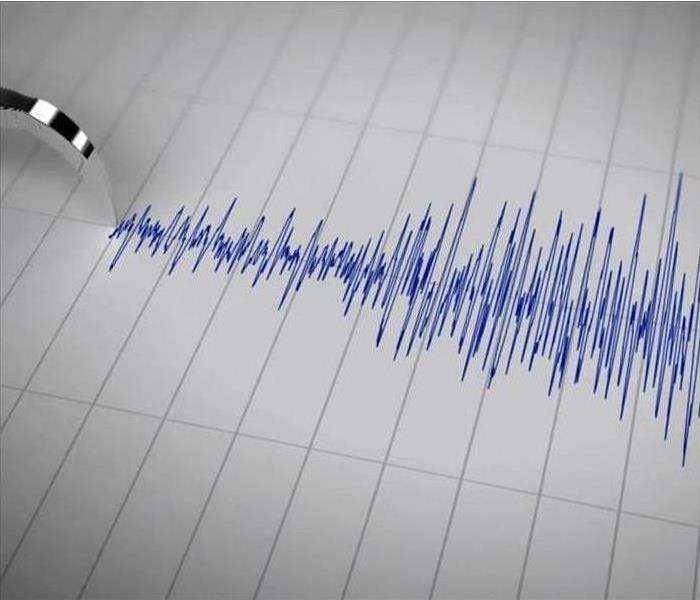 Earthquake
Earthquake
Hey SERVPRO of Chatsworth/Stevenson Ranch readers!
Living in SoCal an earthquake can happen at any time, so read on for a few quick tips on how to make sure your business is prepared. And remember, when disaster strikes, you can always call your local SERVPRO for timely assistance:
"An earthquake can happen anytime and anywhere. Unlike many other natural disasters, earthquakes can strike during any season. It can also occur with little to no warning at all.
Earthquakes can knock out heat, power, and communications services, sometimes for days at a time, leaving people stuck without utilities or other services. Your goal for protection is to learn to Drop, Cover, and Hold On during an earthquake.
Most casualties and injuries during an earthquake occur when: people fall while trying to walk or run during the shaking; when they are hit by falling, flying, or sliding items or non-structural debris; and/or when they are struck or trapped by collapsing walls or other parts of the building.
The America’s PrepareAthon! How to Prepare for an Earthquake explains what the public should do before, during and after an earthquake:
- To prevent potential injuries, take the time to secure your space. Secure items that might fall, fly, or slide in an earthquake. Imagine if the room was picked up and shaken up and down and side to side and then determine what items would be thrown around.
- Make sure your business is safer during earthquakes and more resistant to earthquake damage. Get professional help to assess the building’s structure and then take steps to install nonstructural solutions, including foundation bolting and cripple wall bracing.
The America’s PrepareAthon! Prepare Your Organization for an Earthquake Playbook explains how business owners can take the necessary steps now to prepare themselves and their staff for an earthquake.
The playbook helps to enhance organizational coordination and communication on preparedness and operational continuity by recommending the following:
- Hold a preparedness discussion to explain company plans and policies to motivate employees to be better prepared at home and work;
- Explain and practice Drop, Cover, and Hold On;
- Conduct a tabletop exercise with your staff to ensure that the organization is familiar with and knows how to implement readiness plans;
- Develop an employee communications plan with all staff contact information, including emergency points of contact;
- Sign up for local alerts and warnings in your community; and
- Organize and keep handy important documents such as insurance information and rental or mortgage agreements.
It is important that business owners discuss their plans with their employees to ensure they are aware of what to do and where to go during an earthquake threat."
Storm Supply Kits
4/26/2022 (Permalink)
 Open 24/7
Open 24/7
When a storm hits, sometimes it takes you by surprise. You may not have the immediate chance to grab what you need or even have it on hand at all. That is why it is so important to have a Storm Supply Kit ready to go.
A Storm Supply Kit could be described as a pre-chosen group of supplies that could assist with health and safety during or after a storm or disaster.
It would be ideal to keep a Storm Supply Kit at home, work , and in your vehicle.
Here are some supplies to keep in your kit:
1. Medications needed
2. first aid kit with instructions
3. flashlight
4. cash and important documents
5. food for several days
6. water for several days
7. clothing and shoes
8. pocket knife with tools attached
9. Sanitation wipes and hygiene products.
SERVPRO of Chatsworth / Stevenson Ranch is faster to any size disaster!
818-842-1400
Commercial Property Restoration
4/7/2022 (Permalink)
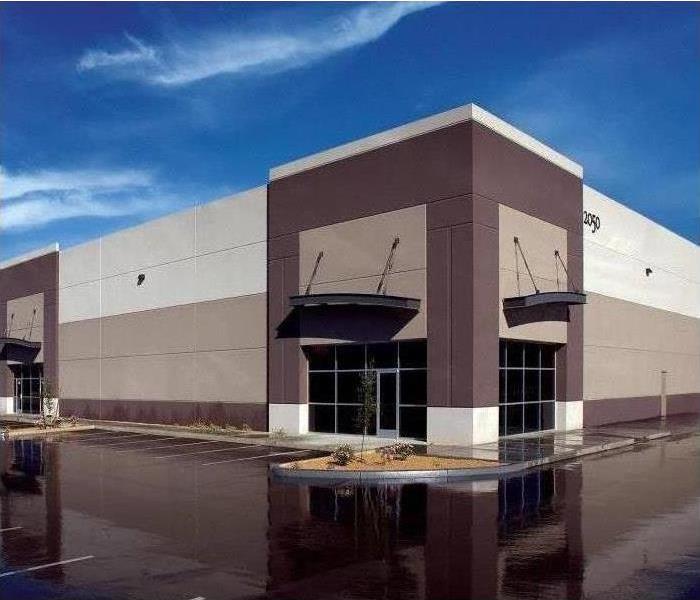 Commercial Building
Commercial Building
Flooding and water damage events at Chatsworth commercial properties are often complex with numerous issues that require a knowledgeable and flexible response. Whether we’re dealing with a relatively small water cleanup scenario or a large scale event, we work quickly to assess each unique situation and isolate the damaged area. In many instances, normal operations can continue in a temporary space while we restore your facility.
Restoring Commercial Properties Presents Unique Challenges
Our professionals are trained to be mindful of legal and environmental concerns and strive to fully restore the damaged area while working within your budgetary constraints. We understand that every hour spent cleaning up is an hour of lost revenue and productivity. So when an emergency situation arises in your business, give us a call and we’ll be there fast with the help you need.
About SERVPRO of Chatsworth
SERVPRO of Chatsworth specializes in the cleanup and restoration of commercial and residential property after a water damage event. Our staff is highly trained in property damage restoration. From initial and ongoing training at SERVPRO’s corporate training facility to regular IICRC-industry certification, rest assured our staff is equipped with the knowledge to restore your property.
Meet our Team: http://www.SERVPROchatsworth.com/crew-photos
Smoke and Soot
4/7/2022 (Permalink)
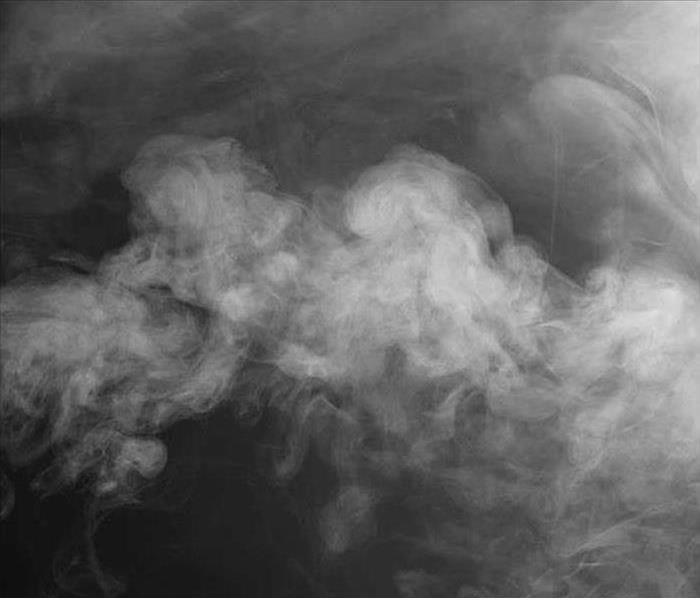 Smoke
Smoke
Many don’t know the effect smoke and soot actually have and to what extent. Smoke and soot is very invasive and can penetrate various cavities within your home, causing hidden damage and odor. SERVPRO of Chatsworth/Stevenson Ranch has smoke damage expertise and experience which allows us to properly help you!
Smoke and soot facts:
- Hot smoke migrates to cooler areas and upper levels of a structure.
- Smoke flows around plumbing systems, seeping through the holes used by pipes to go from floor to floor.
- The type of smoke may greatly affect the restoration process.
Different Types of Smoke
There are two different types of smoke–wet and dry. As a result, there are different types of soot residue after a fire. Before restoration begins, SERVPRO of Burbank will test the soot to determine which type of smoke damage occurred. The cleaning procedures will then be based on the information identified during pretesting. Here is some additional information:
Wet Smoke – Plastic and Rubber
- Low heat, smoldering, pungent odor, sticky, smeary. Smoke webs are more difficult to clean.
Dry Smoke – Paper and Wood
- Fast burning, high temperatures, heat rises therefore smoke rises.
Protein Fire Residue – Produced by evaporation of material rather than from a fire
- Virtually invisible, discolors paints and varnishes, extreme pungent odor.
Our Fire Damage Restoration Services
Since each smoke and fire damage situation is a little different, each one requires a unique solution tailored for the specific conditions. We have the equipment, expertise, and experience to restore your fire and smoke damage. We will also treat your family with empathy and respect and your property with care.
Have Questions about Fire, Smoke, or Soot Damage?
Call Us Today – (818) 842-1400
All About Air Movers
4/7/2022 (Permalink)
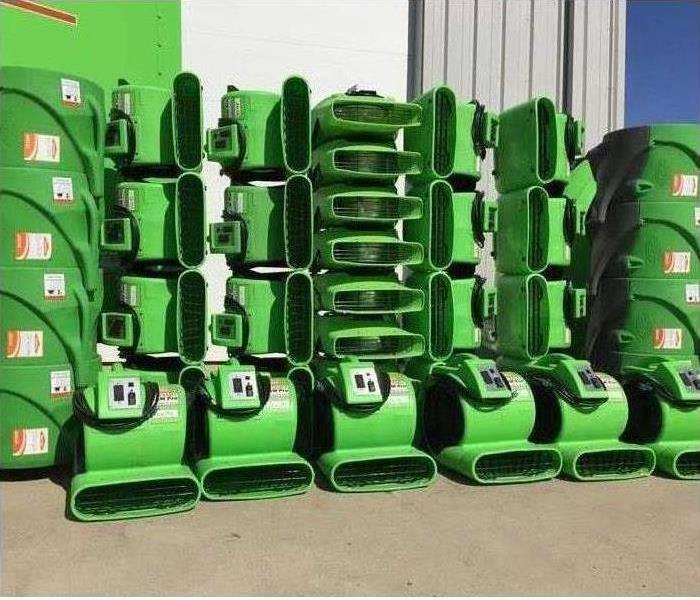 Air Movers
Air Movers
What is an Air Mover?
Air movers are used in construction and water restoration projects, having a wide variety of industrial applications. They are primarily used to increase air circulation, which speeds up water evaporation and reduces drying time. Compressed air is also used to maximize airflow in a blower fan or air mover. Some other names for air movers are “industrial air blowers”, “commercial blower fans” or “floor drying fans”.
Air movers are an essential tool when mitigation services are needed due to water damage or restoring flood or disaster damage. Some advantages of drying a building with the use of air movers are as follows:
- High velocity, making them ideal for cooling and ventilation purposes
- Reduces water damage dry out time to carpets and floors, as well as wall cavities behind drywall
- Removing fumes or gases from a work space
TYPES OF AIR MOVER UNITS
The type of air blower affects the speed and direction of airflow and the amount of space that can be covered by the air mover. There are three major types of air blower units used in most commercial dry out scenarios:
- Axial: Axial blowers are designed to move large amounts of air across a wide space. These tend to be larger air movers that produce high airflow. Unlike centrifugal air movers, which can direct air in several directions, axial air movers only move air horizontally. They’re ideal for drying walls or top-down drying treatments on carpets. They’re sometimes used for ventilation and equipment cooling.
- Centrifugal: This type offers a more compact air mover designed for spot treatments. Centrifugal air movers draw air from several sources and direct it to a particular spot. They are often used in restoration work to dry hard to reach areas like under cabinets and in crawl spaces and closets. Most centrifugal air movers can be adjusted to provide airflow at a few different angles. Centrifugal blowers are heavy-duty air movers that produce lower CFM than axial air movers.
Keeping Your Home Healthy
4/7/2022 (Permalink)
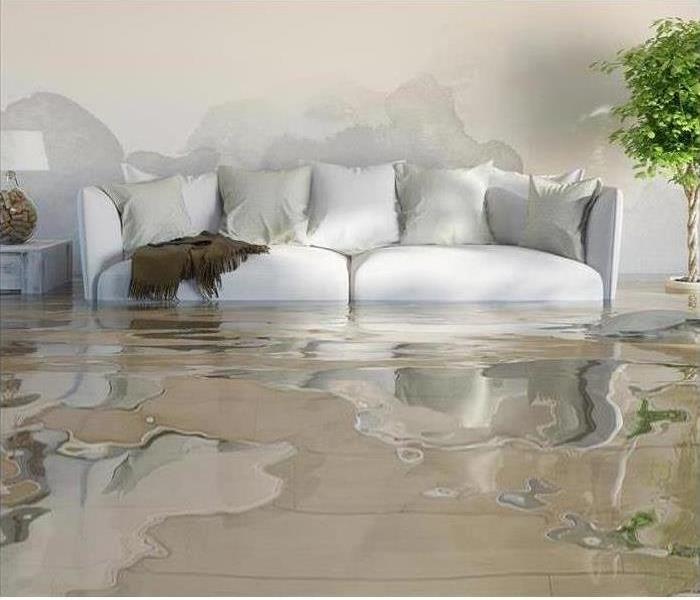 House Flood
House Flood
Hey SERVPRO of Chatsworth/Stevenson Ranch readers! We get a lot of water damage calls here. We here at SERVPRO know that there can be a lot of questions that come along with discovering water damage in your home, especially when it comes to your health and potential health effects. Our friends over at SERVPRO Saginaw put together some great thoughts on the topic. Read on to gain insight on what hazards can occur as a result of water damage and why it’s best to let the professionals handle the clean up.
The obvious result of water damage is structural---whether severe or cosmetic. And unfortunately, structural damage can wind up costing you thousands of dollars in repairs. The result of water damage can also cause the growth of toxic mold and mildew. If left untreated, this mold proliferation can cause health effects. So let’s get to it.
Hazard #1: Mold Growth -
- According to the Environmental Protection Agency (EPA), you should have your property dried and cleaned within 24-48 hours after the initial water onslaught. This practice will help decrease the likelihood of mold growth. Although you may be capable of starting the drying and cleaning processes, it is important to know that mold can grow in areas of the home that you can't see. Thus, simply cleaning and drying your carpet will not always be effective in preventing mold growth, especially if there is a large quantity of unwanted water. The mold can still grow in different areas of your home, including the carpet padding, underneath wallpaper, behind the drywall, along ceilings and baseboards, in voids and furniture.
- As noted by the EPA, there are several health effects that can result from exposure to mold. It is also important to note that the mold clean up process, performed by you, can lead to exposure to fungi. For this reason, professional water damage restoration technicians from SERVPRO will wear special protective gear and utilize state-of-the-art equipment for mold cleanup and the prevention of mold dispersion throughout your Saginaw home.
Hazard #2: Exposure to Sewage -
- Exposure to raw sewage is dangerous because it contains parasites, viruses, and bacteria such as E. coli. The sewage can also contain pharmaceuticals, chemicals, and pesticides. The EPA has stated that contaminated water can lead to the contraction of illnesses such as tuberculosis, dysentery, hepatitis, tetanus, and cholera. Safely stay away from the hazard of sewage water--blackwater--and let the experts execute the cleanup and dry out.
So… Let The Professionals at SERVPRO of Chatsworth/Stevenson Ranch Assist You!
- We are passionate about helping our customers make their water damage loss “Like it never even happened.” So no matter if it’s a leaky pipe underneath your bathroom sink or a busted water main that’s flooded your entire property, our team will get you taken care of so you can get back to a safe and HEALTHY state.
Call us 24 hours a day, 7 days a week. We are always here to help!
Preventing Water Damages
4/6/2022 (Permalink)
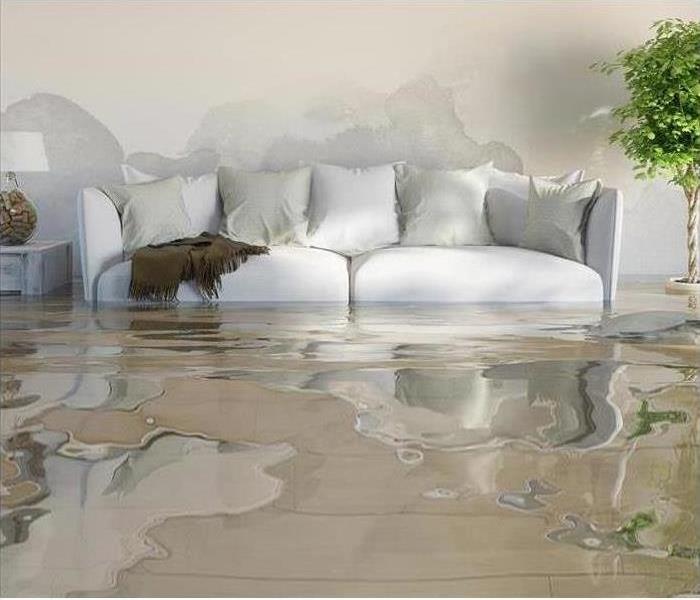 Water Damage
Water Damage
Water Damage is something no homeowner wants to deal with. It often comes unexpectedly and without warning. Water damage can cause structural damage and if not treated quickly can eventually result in mold. But good news! There are some easy tips to avoid water damage in your home.
- Make sure your home has good drainage, clean the rain gutters often and make sure they are clear. If you live on a hill, slope your yard away from the home so that it will direct water away from the home.
- If you already have leaks, make sure they are fixed immediately. Check for dark spots under pipes or on the ceiling.
- Maintain your roof, if there are missing shingles replace them immediately.
SERVPRO of Chatsworth / Stevenson Ranch is faster to any size disaster!
Call 24 hours a day, 7 days a week at 818-842-1400
Our Expertise
4/6/2022 (Permalink)
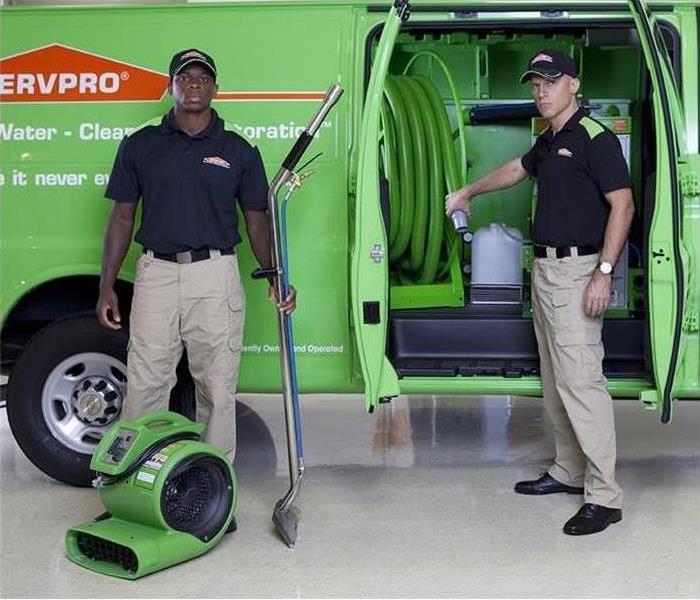 Why SERVPRO
Why SERVPRO
Have you ever had a bad or unpleasant experience with a company? We can assure you that will not be the case with SERVPRO of Chatsworth/Stevenson Ranch. In times of disaster and crisis, it is crucially important to choose a company who will not only get the job done, but look after the client as well.
The SERVPRO team is always ready to make any disaster "Like it never even happened." With specialized training, our technicians are well prepared to handle water damage, fire damage, mold remediation, bio-hazard cleanup and much more. Along with the expertise, here at SERVPRO of Chatsworth/Stevenson Ranch you can expect professionalism along with kindness and courtesy.
At SERVPRO of Chatsworth / Stevenson Ranch our crew chiefs are certified and ready to go 24 hours a day and 7 days a week. Call us here at (818) 842-1400.
SERVPRO of Chatsworth/Stevenson Ranch Serves
4/6/2022 (Permalink)
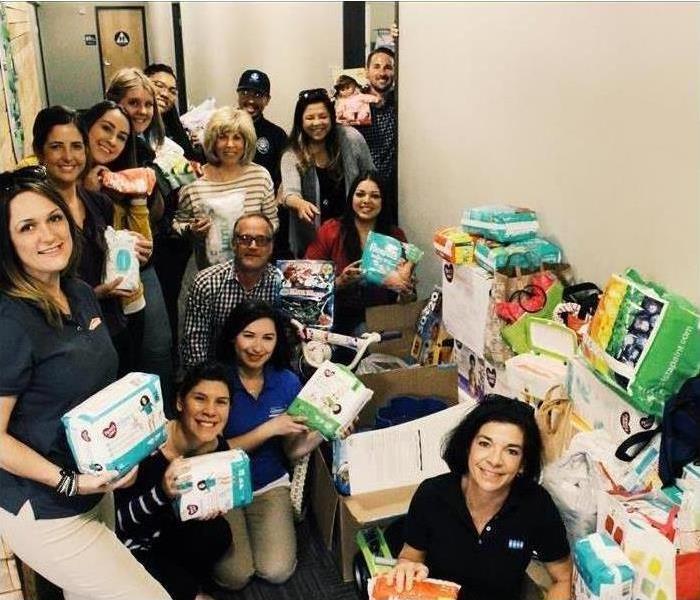 SERVPRO Serves
SERVPRO Serves
Here at SERVPRO of Chatsworth/Stevenson Ranch we not only specialize in restoration and cleanup services, but we also love to participate and give back to our community.
Every fall, we partner up with the San Fernando Rescue Mission's Thanksgiving Dinner. Most recently, we collected over twenty-six hundred rolls for dinner. It's always a blessing knowing that these families will be well fed on a day of thanks and love.
Additionally, Roby of our marketing team volunteers at the CAI-GLAC's outreach committee. Some of the projects he has contributed to include the Spark of Love Toy Drive, Tree People - environment cleanup, SCV Single Mothers Outreach and much more. Knowing that our team members have a heart and passion for the community only further solidify the integrity of SERVPRO of Chatsworth/Stevenson Ranch.
We Are Certified!
4/6/2022 (Permalink)
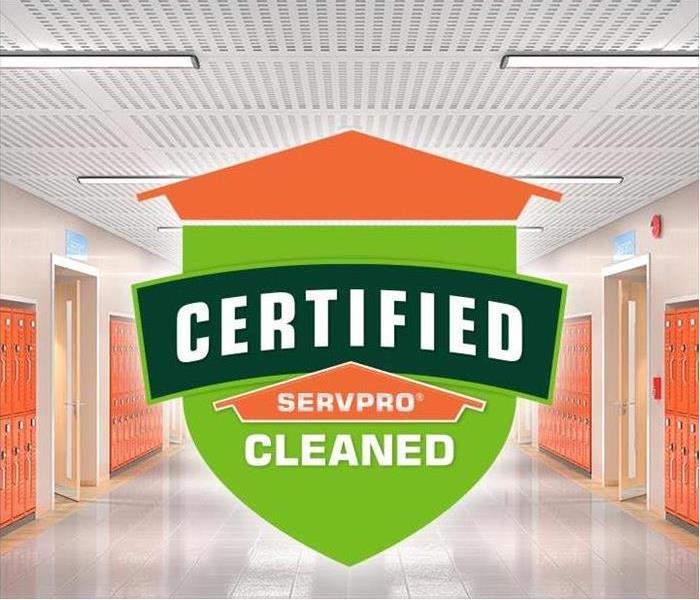 SERVPRO Certified
SERVPRO Certified
Have you ever had a bad or unpleasant experience with a company? We can assure you that will not be the case with SERVPRO of Chatsworth / Stevenson Ranch. In times of disaster and crisis, it is crucially important to choose a company who will not only get the job done, but look after the client as well.
The SERVPRO team is always ready to make any disaster "Like it never even happened." With specialized training, our technicians are well prepared to handle water damage, fire damage, mold remediation, bio-hazard cleanup and much more. Along with the expertise, here at SERVPRO of Chatsworth/Stevenson Ranch you can expect professionalism along with kindness and courtesy.
SERVPRO of Chatsworth / Stevenson Ranch is not only an IICRC-WRT certified firm but each of our crew chiefs are certified and ready to go 24 hours a day and 7 days a week. Call us here at (818) 842-1400.
Here to Help
4/6/2022 (Permalink)
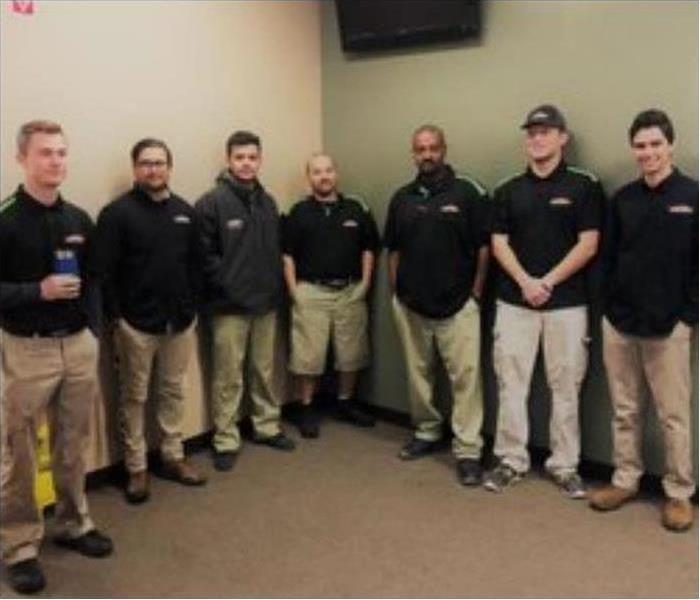 SERVPRO Team
SERVPRO Team
SERVPRO of Chatsworth/Stevenson Ranch prides themselves on customer service. Here at SERVPRO we make ourselves available to help 24 hours a day, 7 days a week. Our office staff work hard day in and day out to help every customer who may call. They are well trained and up to date with everything there is to know about SERVPRO so that they might help to the best of their ability.
When it comes to our techs and men who work out in the field they carry respect for every customer they come in contact with. They are aware that everyone they help is in a stressful situation and try their best to alleviate any stress they can. Our men are kind and well trained here at SERVPRO of Chatsworth/Stevenson Ranch!
SERVPRO Storm Team
3/10/2022 (Permalink)
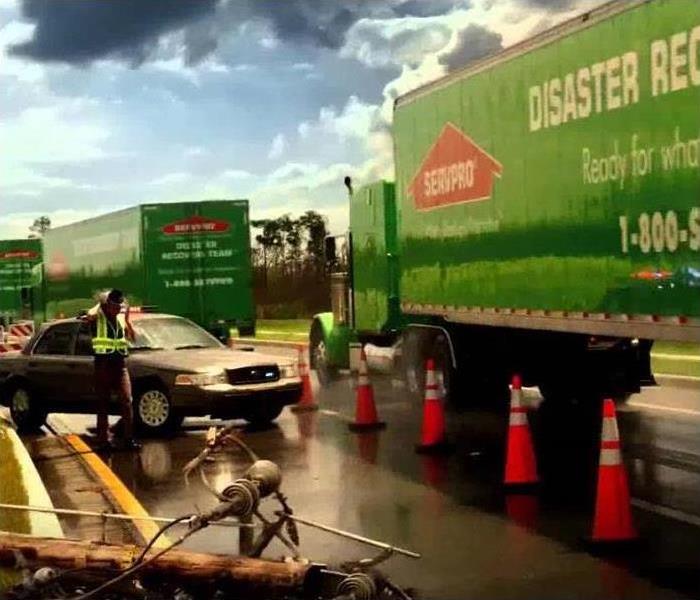 SERVPRO Trucks
SERVPRO Trucks
When Major storms roll out, watch SERVPRO's Storm Teams roll in.
SERVPRO of Chatsworth/Stevenson Ranch is part of a network of over 1,800 restoration specialists, stretching throughout the United States as well as Canada – strategically stationed to be available for whatever happens at a moment’s notice. When things that matter most are on the line, make sure SERVPRO® is too. SERVPRO of Chatsworth/Stevenson Ranch is faster to any size disaster.
Should a storm or natural disaster situation strike the greater Los Angeles area, our office will notify local and surrounding SERVPRO locations. And as we begin to provide relief to homes and businesses alike, hundreds if not thousands of highly-trained SERVPRO professionals will start to pour into the disaster zone and provide backup and support to our already existing restoration efforts. Whether it’s damage caused by a leaky water pipe or an earthquake of catastrophic magnitudes, there’s no such thing as a job too big that SERVPRO can’t handle!
The days immediately following a major storm event, such as area-wide flooding, are critical to prevent secondary damages, like mold. SERVPRO of Chatsworth/Stevenson Ranch suggest the following steps to help minimize additional damage to your property.
- If the water has entered the structure through the flooding of a creek, stream or river, or if it has filtered through insulation during its intrusion, it is considered to be black water and could be hazardous to your health. Avoid contact with contaminated items as much as possible.
- Take the greatest caution while entering your home, and wear sturdy shoes and protective clothing when dealing with flooded areas.
- Do not attempt to operate any electrical equipment while standing in wet or damp locations.
- Throw away all foods - even canned goods - that have come into contact with flood waters.
- Remove and prop wet upholstery and pillow cushions for drying. Wipe excess water from wood furniture after removal of lamps and tabletop items.
- Place fans at 45-degree angles to walls and move large furniture away from walls to create the best air circulation.
- If your home has a crawlspace, be aware excess moisture in this area can often foster mold growth.
"The first 24 hours after a water damage or flood are so crucial to keeping final costs of the damage down," said Don Turner, Director of SERVPRO’s Disaster Recovery Team. "A lot of flood situations require professional equipment and knowledge of the science of drying to mitigate. By taking these steps, property owners can help minimize damage until the professionals arrive."
How to Prepare Your Place of Worship
3/2/2022 (Permalink)
 Place of Worship
Place of Worship
It happens more often than not in any case of disaster and emergency a place of worship tends to be a place of shelter. It is because of this and the importance of a places of worship that all churches be prepared for the worst!
Here are some tips at preparing your place of worship for a disaster:
- Identify hazards or threats early
- Take necessary precautions for those hazards or threats.
- Plan evacuations
- Train your church staff for emergency readiness and response.
- Prepare surrounding members of the community.
- Be prepared to provide help or aid to your church members after a disaster strikes.
SERVPRO of Chatsworth/Stevenson Ranch is faster to any size disaster. If you or your church finds yourself in need, give us a call at 818-842-1400
Tips During A Flash Flood
2/17/2022 (Permalink)
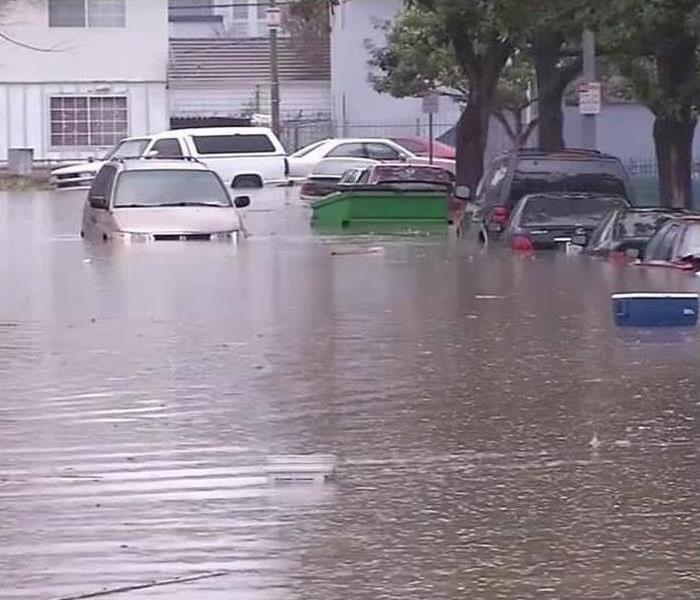 Flash Flood
Flash Flood
Flash floods can happen at any moment. They are often a significant source of rainfall in Southern California, but with that can come water damage to homes and commercial properties. Here are some tips to follow after a flood.
1. Only return to your home or property when it is deemed safe to do so. If there was a mandatory evacuation, wait until that is lifted to return.
2. Inspect your home or property. Look for leaks, water damage, hillsides, or slope movement.
3. Drive carefully, many roads will be covered with mud, debris, and often holes.
4. Be vigilant for mudslides as they can happen days after the flood after the soil dries.
5. Be prepared for the next flood by preparing slopes and high risk areas during the winter time.
SERVPRO of Chatsworth/Stevenson Ranch is faster to any size disaster!
818-842-1400
Keep Your Gutters Clean
2/4/2022 (Permalink)
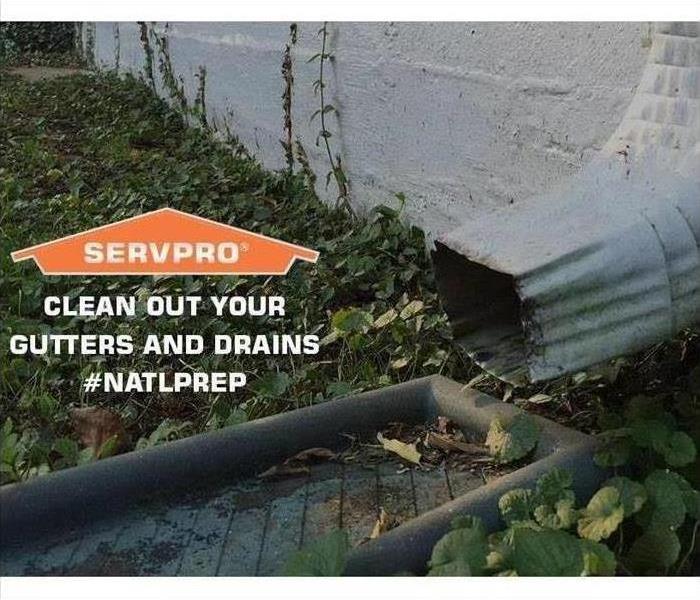 Clean Your Gutters
Clean Your Gutters
Gutters are a very important part of roofs for commercial and residential buildings as they are responsible for transporting water and debris off of roofs. It is vital especially in stormy seasons, that you keep your gutters functioning to their highest ability. Here are a few ways to help ensure that your gutters are doing their job and are in good condition.
- Gutters should be inspected twice a year and cleared of debris that could prevent the flow of water and materials from roof. Also, check for standing water in gutters as it could indicate inadequate flow of water. Water should be moving down off the roof toward storm drainage areas. Keeping trees trimmed near the roof will alleviate stress on gutters because the branches will not slow water flow or contribute more debris to gutters.
- Ensure water is being funneled away from the building once off the roof, as flooding can sometimes occur due to runoff not having proper.
- Water stains on the internal ceiling can indicate a roof leak.
In the case of water damage, roof leaks, and storm damage, SERVPRO of Chatsworth/Stevenson Ranch provides “24 Hour Emergency Services” 7 days a week.
Winter Home Fires
2/4/2022 (Permalink)
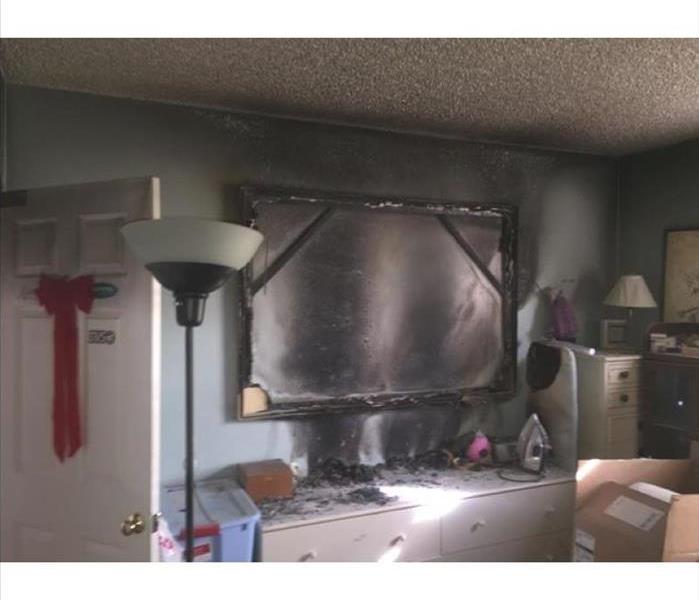 Home Fire in Winter
Home Fire in Winter
Did you know that according to the California State Firefighter's Association, December, January, February and March are the peak months for house fires?
The cause of these fires are primarily due to heating equipment such as space heaters. The different ways space heaters can cause a fire are:
- Lack of cleaning around space heaters and/or inside chimneys
- Placing heaters too close to combustibles
- Basic flaws in the design of the heater
- Leaks involving liquid or gas heaters
Here are some ways that you can help prevent winter fires and protect yourself and your family:
Turn off space heaters when leaving a room- Give space heaters at least 3 feet clearance all the way around from household items
- Clean around space heaters regularly, especially inside of the chimney
- Install smoke detectors
- Keep a fire extinguisher in your home and educate yourself on how to use it
Unfortunately, even with precautions fires can still happen in your home. If you do suffer fire or smoke damage in your home, have no fear we are here to help! We have certified trained technicians that specialize in fire and smoke damage. Please call us, SERVPRO of Burbank (818) 842-1400.
Winter Home Fires
2/4/2022 (Permalink)
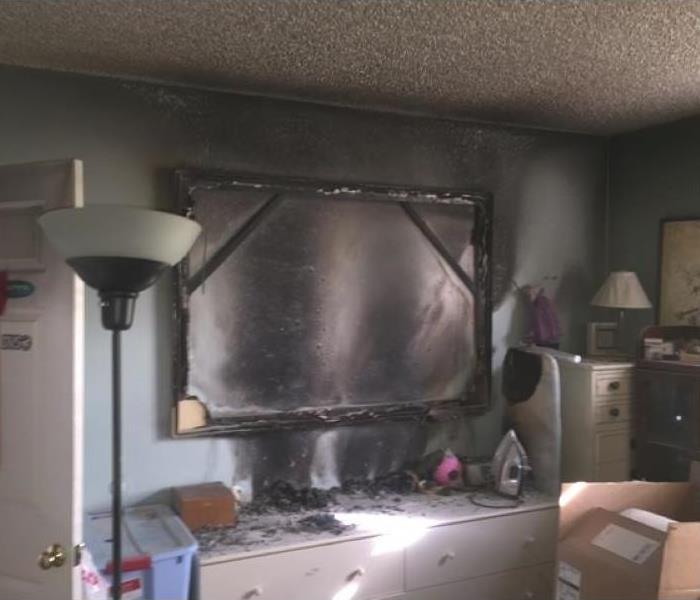 Home Fire in Winter
Home Fire in Winter
Did you know that according to the California State Firefighter's Association, December, January, February and March are the peak months for house fires?
The cause of these fires are primarily due to heating equipment such as space heaters. The different ways space heaters can cause a fire are:
- Lack of cleaning around space heaters and/or inside chimneys
- Placing heaters too close to combustibles
- Basic flaws in the design of the heater
- Leaks involving liquid or gas heaters
Here are some ways that you can help prevent winter fires and protect yourself and your family:
Turn off space heaters when leaving a room- Give space heaters at least 3 feet clearance all the way around from household items
- Clean around space heaters regularly, especially inside of the chimney
- Install smoke detectors
- Keep a fire extinguisher in your home and educate yourself on how to use it
Unfortunately, even with precautions fires can still happen in your home. If you do suffer fire or smoke damage in your home, have no fear we are here to help! We have certified trained technicians that specialize in fire and smoke damage. Please call us, SERVPRO of Burbank (818) 842-1400.
Commercial Property Mold
12/28/2021 (Permalink)
 Mold in a commercial property
Mold in a commercial property
Here are some tips if you suspect that you have found mold in your commercial property.
What you should do:
- Turn of the HVAC system and fans
- Stay out of the affected area
- Contact SERVPRO of Burbank for mold remediation services
What you should not do:
- Do not touch or disturb the mold
- Do not attempt to clean the area yourself
- Do not blow any air around the suspected microbial growth
- Do not spray disinfectants on the mold
If you come across suspected mold, do not disturb it in any way. Any disturbance could easily spread the mold spores throughout your property. When disturbed, mold spores can become airborne and circulate inside your business.
SERVPRO of Chatsworth/Stevenson Ranch specializes in mold cleanup and restoration. It is a huge part of our business. Our crews are highly trained restoration professionals that use specialized equipment and techniques to properly remediate the mold problem quickly and safely. The well being of our customers is our highest priority!
If you believe you have found mold at your business do not hesitate and call us today- (818) 842-1400
Storm Roof Damage
10/26/2021 (Permalink)
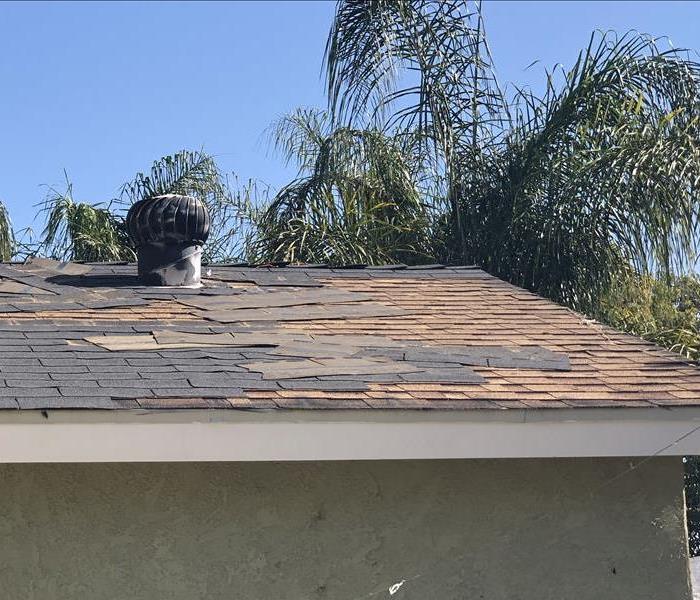 Damaged Roof
Damaged Roof
Severe or even mild thunderstorms can easily cause roof damage, especially if your roof is older than 15-20 years old. These damages can cause water intrusion in your home and if left untreated can cause more serious issues such as mold or wood rot. Some common types of roof damage from storms are:
- Split seams
- Broken or cracked tiles
- Dented or missing shingles
- Dents on gutters or vents
Holes
All of these issues can cause water to leak into your home and you may not even notice! Unless you physically see the water damage, you may not realize that you have any. If you have an attic that you don't always go into, it is possible to have water leaking before seeing it. It is always a good idea to check for roof damage after a severe thunderstorm. A professional roofing contractor can help you with this.
In addition to these common types of damage, there are some rare occurrences of damage that can happen. Rare types of roof damage are:
- Caving in on itself
- Tree blowing over onto roof
Unfortunately for these types of rare but extreme damage, there is no way to prevent them from happening. The best thing you can do, is to get your roof replaced if older than 15 years, and to make sure to trim your trees prior to a thunderstorm.
Even if water does enter your home from roof damage, know that SERVPRO of Burbank is here to help 24/7! 818-842-1400
Commercial Loss
9/24/2021 (Permalink)
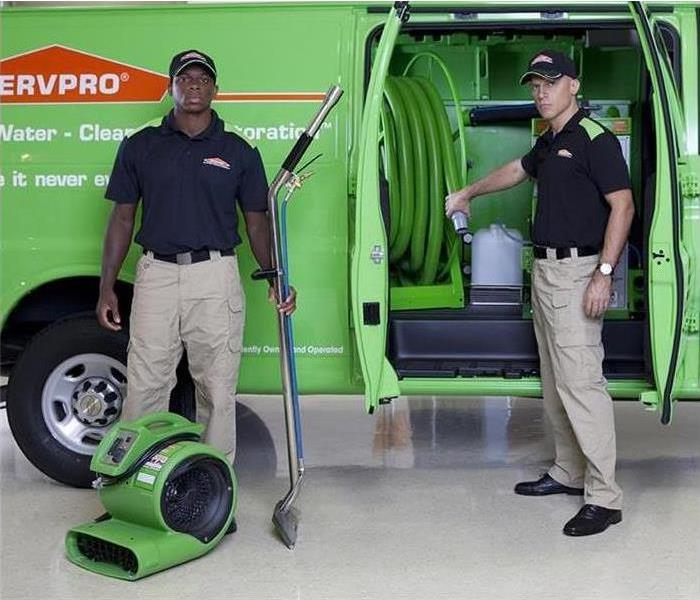 SERVPRO Crew
SERVPRO Crew
When talking to business owners regarding potential water damage events, they often visualize a massive storm wiping out power lines, flooding offices. Resulting the fear of having to shut down businesses for days at a time with it potentially not opening. It is true that commercial water damage is often the result of floods and water that stems from weather events and storms. Although living in sunny Southern California; hurricane-like storms are few and far between.
However, many entrepreneurs and business space renters forget that storms and severe weather aren't the only cause of floods and water damage. Commercial water damage is surprisingly common year-round, and it can drastically affect the operation of your business. Here are some of the typical causes of water damage to commercial buildings.
- Malfunctioning sprinkler systems: Some older office and retail buildings still have outdated sprinkler systems that work in conjunction with fire protection systems. While such sprinklers can come in handy during a fire emergency, they can also cause commercial flood damage if they are faulty or in need of replacement. This could easily damage inventory and business assets.
- Damaged appliances and equipment: This cause of commercial flood damage is more common in restaurants and catering facilities, as well as any business that has appliances and equipment that make use of water. If the appliance fails and sends water across your building, especially during late hours when no one is around, you may come back to work and face a water emergency.
- Broken pipes and plumbing: Just like in a residence, if the plumbing system in your workplace fails water damage could be the result. If you question the stoutness of your building's pipes, contact SERVPRO for a thorough inspection and assessment.
- Backed up sewer lines: This is another cause of commercial water damage that often catches business owners by surprise. Should the sewer line to your building back up or become damaged, realize the potential dangers of contaminated Black Water which can cause health effects and ruin products and office furnishings. SERVPRO has certified IICRC technicians to deal with this type of water damage.
If your business has suffered commercial water damage, SERVPRO of Chatsworth / Stevenson Ranch call us anytime 24/7 at (818) 842-1400 for fast help.
Our Customer Service
9/24/2021 (Permalink)
 Open 24/7
Open 24/7
SERVPRO of Chatsworth/Stevenson Ranch prides themselves on customer service. Here at SERVPRO we make ourselves available to help 24 hours a day, 7 days a week. Our office staff work hard day in and day out to help every customer who may call. They are well trained and up to date with everything there is to know about SERVPRO so that they might help to the best of their ability.
When it comes to our techs and men who work out in the field they carry respect for every customer they come in contact with. They are aware that everyone they help are in a stressful situation and try their best to alleviate any stress they can. Our men are kind and well trained here at SERVPRO of Chatsworth/Stevenson Ranch!
Tips To Avoid A Flood
9/24/2021 (Permalink)
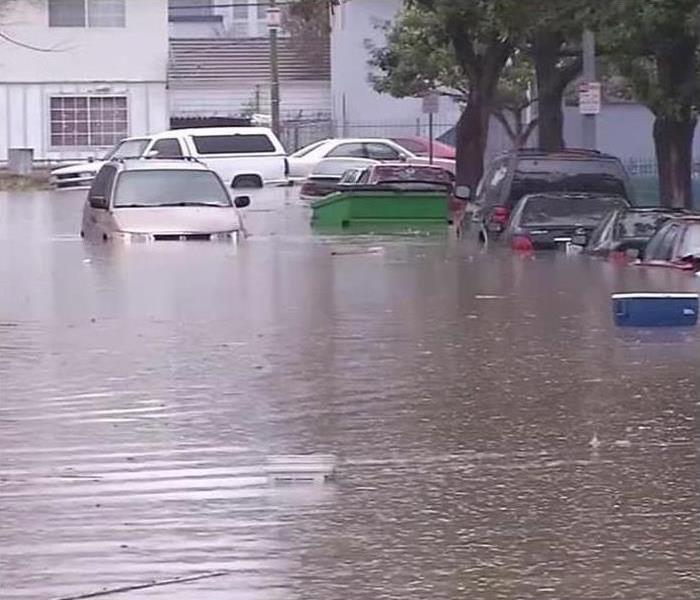 Flood
Flood
Floods are the most common natural disasters in the United States. There are many effects a heavy rain storm can cause. Some significant things such as flooding, potential flash floods, mud-flows, or over-topping levees and dams. Here in California heavy rains can happen, putting properties like your home or business at risk.
Tips to help your home or business avoid floods:
- Purchase flood insurance. (Call your insurance agent make sure your covered for FLOODS)
- Install rain gutters and other drainage systems. (Clean out rain gutters frequently)
- Fix any leaks IMMEDIATELY.
- Extra roof protection (spend a few hundred dollars more to install a rubber roof underlayment, a waterproof barrier that goes under the shingles and protects the roof from water intrusion.)
Tips for drivers during the rain season:
- Avoid cruise control (This feature works great in dry conditions, but when used in wet conditions, the chance of losing control of the vehicle can increase)
- Slow down and leave room in front of you (Slowing down during wet weather driving can be critical to reducing a car’s chance of hydroplaning, when the tires rise up on a film of water.)
Remember if you do experience a flood in your home or business SERVPRO of Chatsworth / Stevenson Ranch is one call away and we make your water damage "Like it never even happened."
Call SERVPRO of Chatsworth/Stevenson Ranch at (818) 842-1400
The American Red Cross And SERVPRO
9/24/2021 (Permalink)
 SERVPRO Van
SERVPRO Van
The American Red Cross recently recognized SERVPRO®, a cleanup and restoration company, for participating in its Disaster Responder Program. As a member of this program, SERVPRO pledges a donation to the Red Cross as an action of preparation against the calculated 66,000 disasters that occur annually. SERVPRO is entering their third year of partnership with the Red Cross, and to date their donations to the organization exceed one million dollars.
The majority of the disasters that occur every year are house fires. Statistics cited by the Red Cross state that in the U.S. seven people die in a home fire each day. The Red Cross has aimed to reduce deaths and injuries caused by home fires 25 percent by the year 2019. Because of this goal, they launched a Home Fire Campaign in October of 2014. The support of SERVPRO and other Disaster Responder Program members allows the Red Cross to pursue their home fire prevention goals while continuing to provide critical services to disaster victims.
"Statistics compiled by the National Fire Protection Association (NFPA) show the majority of home fires are related to cooking accidents." Dave Tronson, owner of SERVPRO of Chatsworth / Stevenson Ranch, states, "the risk for home fires exists all year long," further extending their pledge to help Red Cross to respond and prevent such a disaster as a home fire.
Not only does SERVPRO help other business and home owners with recovery for fires, floods, and other disasters, the company and its franchises actively support disaster preparedness education, including fire prevention efforts. When disaster strikes, the relationships with major insurance companies combined with the industry-leading job-management technology that SERVPRO has can smooth the path to rebuilding and restoration for home and business owners affected by disastrous events.
"SERVPRO’s commitment to the Red Cross Disaster Responder Program means that when disaster strikes, homeowners can count on the Red Cross to address their immediate needs and supply essential services," said Tronson. "Once the immediate emergency is under control, homeowners can count on the expertise of restoration specialists at SERVPRO of Chatsworth / Stevenson Ranch to help restore their property and move forward with their lives."
For fire prevention tips and information about fire and water damage restoration services, please visit www.SERVPRO.com. For more information on SERVPRO® of Chatsworth / Stevenson Ranch, please contact Dave Tronson at (818) 709-6090 or SERVPRO2720@SERVPROburbank.com
About SERVPRO®
Founded in 1967, the SERVPRO® Franchise System is a leader and provider of fire and water cleanup and restoration services, and mold mitigation and remediation. SERVPRO's professional services network of more than 1,700 individually owned and operated Franchises responds to property damage emergencies ranging from small individual disasters to multi-million dollar large-loss events. Providing coverage in the United States and Canada, the SERVPRO® System has established relationships with major insurance companies and commercial clients, as well as individual homeowners.
Rainy Weather Tips
9/24/2021 (Permalink)
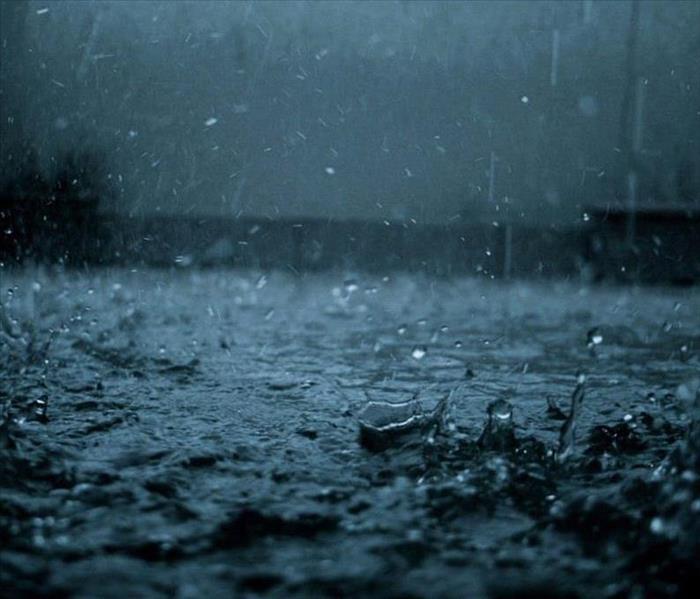 Rain
Rain
Here are some tips for your home and rainy weather!
Tip #1: Check those gutters! This can be a simple but very effective way to prevent unwanted water from entering your home or business. Gutters that are clogged with debris from overhanging trees, trash, or roofing materials can easily clog the drain and shuffle unwanted water your way.
Tip #2: Tarp up any unfinished roofing projects. Going along with our first tip, small openings in the roof of your home and business can quickly become large openings with heavy rain, causing water damage inside your building. Make sure to give your local roofing company a call and get those potential problem areas patched up ASAP.
Tip #3: Examine your window glaze and compound. Often times, glazing compound can shrink during the warmer months, making windows more susceptible to unwanted rain water penetration. Your local contractor can help patch this up for you, ensuring that you are set and ready for even the heaviest of rains! Another helpful tip… make sure you close your windows before going to bed or leaving the home!
And finally, Tip #4 (the most important!): Should you find yourself in a situation where you do have a water damage emergency, call SERVPRO of Chatsworth / Stevenson Ranch. Our staff is prepped and ready to respond and help make your rain disaster, "Like it never even happened."
Mold Expertise
9/24/2021 (Permalink)
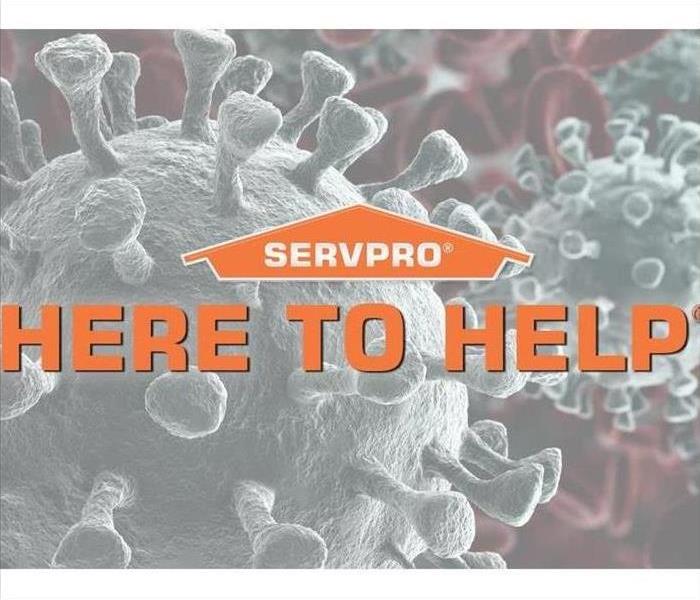 Here to Help
Here to Help
If you see visible mold, do not disturb it. You can inadvertently spread the mold infestation throughout your home. When mold is disturbed, the mold can release microscopic mold spores which become airborne and can circulate inside your home.
What to Do:
· Stay out of affected areas.
· Turn off the HVAC system and fans.
· Contact SERVPRO of Chatsworth / Stevenson Ranch for mold remediation services.
What Not to Do:
· Don’t touch or disturb the mold.
· Don’t blow air across any surfaces with visible or suspected mold growth.
· Don’t attempt to dry the area yourself.
· Don’t spray bleach or other disinfectants on the mold.
About Our Mold Remediation Services
SERVPRO of Chatsworth / Stevenson Ranch specializes in mold cleanup and restoration; in fact, it’s a cornerstone of our business. Our crews are highly trained restoration professionals that use specialized equipment and techniques to properly remediate your mold problem quickly and safely.
If You See Signs of Mold, Call Us Today – (818) 842-1400
Fire Preparedness
8/25/2021 (Permalink)
 SERVPRO Van
SERVPRO Van
Developing Fire Safe Habits For Your Home is very important here in SoCal. SERVPRO of Chatsworth / Stevenson Ranch and the Red Cross have some tips on how to do so:
- Keep items that can catch on fire at least three feet away from anything that gets hot, such as space heaters.
- Smoking materials are the leading cause of residential fire deaths in the United States. If you smoke, take precautions: Smoke outside; choose fire-safe cigarettes; never smoke in bed, when drowsy or medicated, or if anyone in the home is using oxygen.
- Use deep, sturdy ashtrays and douse cigarette and cigar butts with water before disposal.
- Talk to children regularly about the dangers of fire, matches and lighters and keep them out of reach.
- Turn portable heaters off when you leave the room or go to sleep.
- Never leave a burning candle unattended, even for a minute.
Information provided by redcross.org
Do You Know What Soot Is?
8/25/2021 (Permalink)
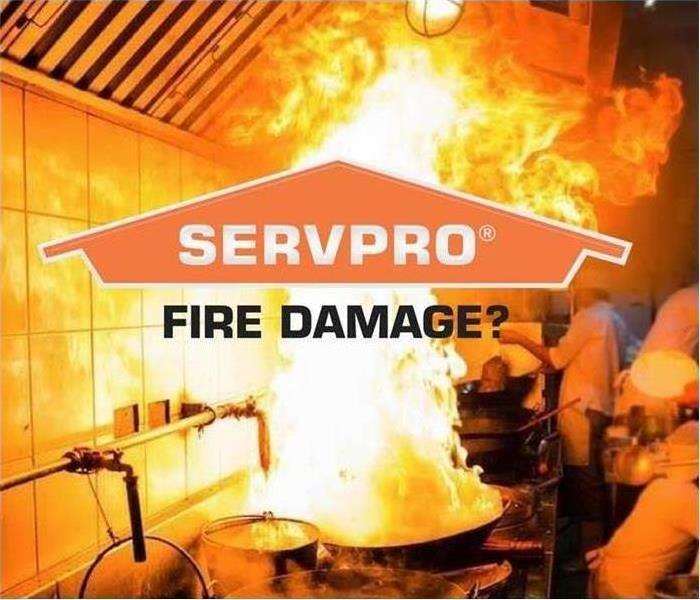 Fire Damage
Fire Damage
What exactly is soot?
SERVPRO of Chatsworth / Stevenson Ranch is happy to give some insight on what the common black powder substance is.
Soot is described as the fine black particles composed of carbon. It is created by incomplete combustion of coal, oil, wood and other fuels. It can consist of acids, chemicals, metals, soils and dust. The main trait of soot is it's size, the particles are extremely tiny, 2.5 micrometers or smaller.
Is soot dangerous?
With soot often containing chemicals in addition with its tiny size, it can cause health effects.
Compounds from soot are sulfur dioxides and nitrogen dioxides, they combine with moisture and form acid rain which then worsens water quality and damages crops. In addition, it can also change nutrient balances in many ecosystems.
Categories Of Water Loss
8/25/2021 (Permalink)
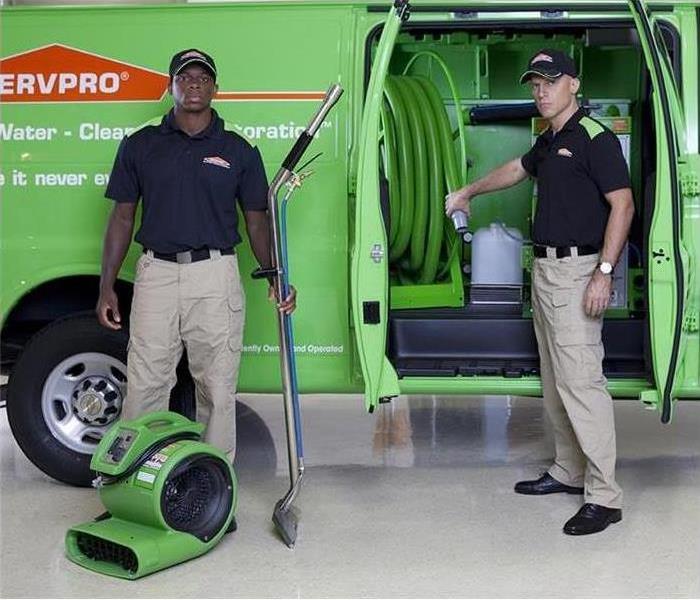 SERVPRO Technicians
SERVPRO Technicians
If you've been in and around a water loss you may have often heard the reference of which category the loss is under. So what exactly does that mean? SERVPRO of Chatsworth / Stevenson Ranch will shed some light on the three categories of a water loss and what they mean.
Category 1: Refers to the source of water as being "clean water" otherwise meaning a source of water that does not pose a substantial threat to humans. Examples:
- Broken water supply line
- Sink or tub overflow
- Appliance malfunction
Category 2: Refers to the source of water as containing a significant degree of chemicals, biological or physical contaminants that cause discomfort or sickness when consumed or exposed to. It is often referred to as "grey water" Examples:
- Toilet bows w/urine (no feces)
- Sump pump failures
- Seepage from washers
Category 3: Referred to as "black water" and is grossly contaminated. This water contains unsanitary agents, harmful bacteria and fungi, causing severe discomfort or sickness. Examples:
- Toilet back flows
For all your water damage needs give us a call at 818-842-1400
How To Prevent A Fire In Your Home
6/17/2021 (Permalink)
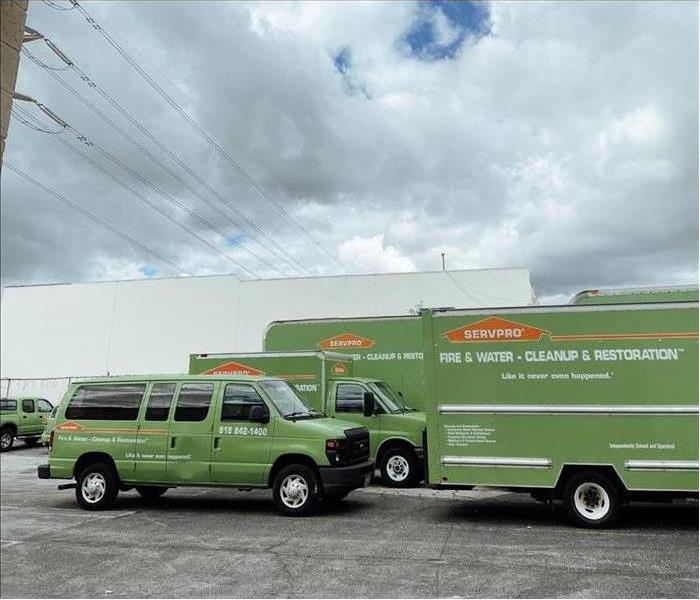 SERVPRO Trucks
SERVPRO Trucks
How to prevent fires at home
Most people know the basics of fire safety at home, such as not leaving burning candles unattended and keeping a fire extinguisher on hand. Here are a few more things you can do to prevent fires at home.
- Have your heating system serviced regularly by a professional, including chimneys from wood-burning fireplaces. Clean around heat sources and keep dust and other flammable items away from ignition sources.
- Remove the lint from your dryer filter after every use. A clogged filter and lint trap makes your dryer less efficient, reduces the airflow needed to keep heat from building up in the vents, and forces lint onto the heating coils. Also, never let your dryer run when you are out of the house or when you’re asleep.
- Keep firewood, piles of leaves and trash away from the home. If a grass fire starts nearby, these items next to your home could easily become kindling. Never dump hot ashes inside or near your home; keep them in a metal container well away from your house and garage.
- Avoid using outlet extenders or plug-in power bars: they can quickly overload an electrical circuit. Replace old, damaged or frayed appliance cords, and never force a three-pronged plug into a two-slot outlet or extension cord.
- Store containers of cooking oil well away from the stove. When cooking with oil, never leave the stove unattended. To stop a grease fire, turn off the burner and place a lid on the pan to suffocate the flames, or pour on lots of baking soda. Never pour water on a grease fire or try to carry the pan outside; water splatters the grease and makes the fire bigger, and the pan will be much too hot to carry.
- Consider using borrowed heat to keep outdoor pets warm. During winter months, avoid using heat lamps, solar lamps, trouble lights, heated watering bowls or other such heated devices, which could lead to a potential fire. Borrowed heat involves providing warmth from a heating system located in a separate building. If this isn’t possible, consider bringing your pets inside.
- Be sure to properly extinguish smoking materials. Smoking materials that are not properly extinguished can smoulder undetected for days before igniting a fire. Never discard smoking materials on the ground or in plant pots.
info provided by https://www.cooperators.ca/en/Answer-Centre/how-can-i-be-safe-and-prepared/home/five-best-ways-to-prevent-fires-in-home.aspx
How To Stay Safe This 4th Of July
6/17/2021 (Permalink)
 Fireworks
Fireworks
Fourth of July weekend is once again upon us! Each year at SERVPRO of Chatsworth, we remember those who have both come before and those who are currently serving to protect our freedom. Like most people on this holiday weekend, we will be sharing it with family and friends and joining in on the many traditions that has made our Independence Day a day to pull out all the stops!
Though there are many activities to partake in, one of the most popular things to do on the 4th is to light off fireworks. And as long as handled properly, they can be a whole lot of fun.
According to the U.S. Consumer Fire Safety Administration, “230 people on average go to the emergency room every day with fireworks-related injuries in the month around the July 4th holiday.” Though this number may be startling to see, we at SERVPRO of Chatsworth want to see if we can help reduce this number for 2016. In an effort to promote injury and fire prevention, here are some recommended safety tips provided by the USCFSA –
- Never allow young children to play with or ignite fireworks.
- Avoid buying fireworks that are packaged in brown paper because this is often a sign that the fireworks were made for professional displays and that they could pose a danger to consumers.
- Always have an adult supervise fireworks activities. Parents don't realize that young children suffer injuries from sparklers. Sparklers burn at temperatures of about 2,000 degrees - hot enough to melt some metals.
- Never place any part of your body directly over a fireworks device when lighting the fuse. Back up to a safe distance immediately after lighting fireworks.
- Never try to re-light or pick up fireworks that have not ignited fully.
- Never point or throw fireworks at another person.
- Keep a bucket of water or a garden hose handy in case of fire or other mishap.
- Light fireworks one at a time, then move back quickly.
- Never carry fireworks in a pocket or shoot them off in metal or glass containers.
- After fireworks complete their burning, douse the spent device with plenty of water from a bucket or hose before discarding it to prevent a trash fire.
- Make sure fireworks are legal in your area before buying or using them.
And if you are also curious about how to prevent additional mishaps during this 4th of July weekend of celebration, check out the Prevention Tips video our SERVPRO of Chatsworth office put together for your enjoyment!
The SERVPRO ERP
6/17/2021 (Permalink)
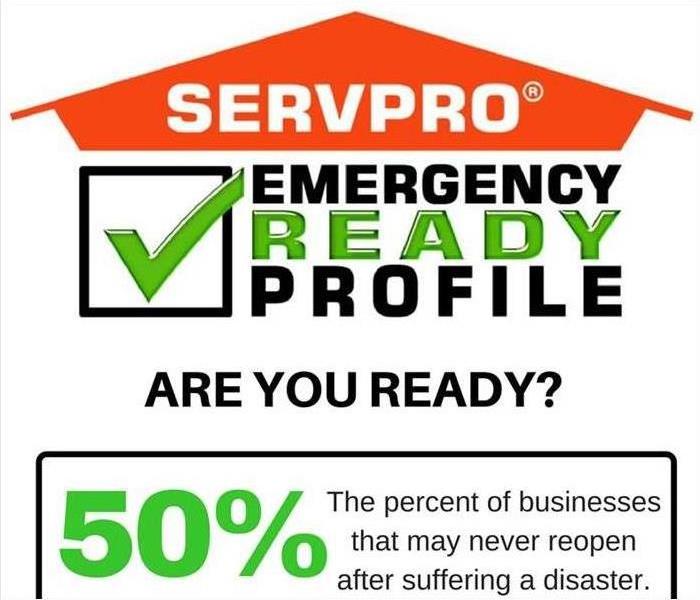 ERP
ERP
It is estimated that up to 50% of businesses that close due to a disaster, such as fire and flood never reopen! Of the businesses that survive, the overwhelming majority of them had a preparedness plan in place.
Are you “Ready for whatever happens?”
Preparation is a key component for making it through any size disaster, whether it’s a small water leak, a large fire, or an area flood. The best time to plan for such events is not when the event happens, but well before it happens.
The SERVPRO® Emergency READY Plan serves as a quick reference of important building and contact information or can be an ideal supplement to any well-designed emergency preparedness or existing contingency program. Rather than simply reacting to disaster situations, most prefer proactive measures to establish a relationship with a restoration services company.
By working with SERVPRO to develop your personalized Emergency READY Plan your business will receive the benefit of over 30 years of experience in reducing the impact of any natural or man-made disaster. SERVPRO is a leader in water and fire damage response for the greater LA area and can help you quickly get your property back in working order.
Call our office at (818) 842-1400 to learn more on how to set up this profile for your facility and get prepared before disaster strikes!
Commercial Earthquake Awareness
4/27/2021 (Permalink)
 Earthquake scale
Earthquake scale
Hey SERVPRO of Chatsworth/Stevenson Ranch readers!
Living in SoCal an earthquake can happen at any time, so read on for a few quick tips on how to make sure your business is prepared. And remember, when disaster strikes, you can always call your local SERVPRO for timely assistance:
"An earthquake can happen anytime and anywhere. Unlike many other natural disasters, earthquakes can strike during any season. It can also occur with little to no warning at all.
Earthquakes can knock out heat, power, and communications services, sometimes for days at a time, leaving people stuck without utilities or other services. Your goal for protection is to learn to Drop, Cover, and Hold On during an earthquake.
Most casualties and injuries during an earthquake occur when: people fall while trying to walk or run during the shaking; when they are hit by falling, flying, or sliding items or non-structural debris; and/or when they are struck or trapped by collapsing walls or other parts of the building.
The America’s PrepareAthon! How to Prepare for an Earthquake explains what the public should do before, during and after an earthquake:
- To prevent potential injuries, take the time to secure your space. Secure items that might fall, fly, or slide in an earthquake. Imagine if the room was picked up and shaken up and down and side to side and then determine what items would be thrown around.
- Make sure your business is safer during earthquakes and more resistant to earthquake damage. Get professional help to assess the building’s structure and then take steps to install nonstructural solutions, including foundation bolting and cripple wall bracing.
The America’s PrepareAthon! Prepare Your Organization for an Earthquake Playbook explains how business owners can take the necessary steps now to prepare themselves and their staff for an earthquake.
The playbook helps to enhance organizational coordination and communication on preparedness and operational continuity by recommending the following:
- Hold a preparedness discussion to explain company plans and policies to motivate employees to be better prepared at home and work;
- Explain and practice Drop, Cover, and Hold On;
- Conduct a tabletop exercise with your staff to ensure that the organization is familiar with and knows how to implement readiness plans;
- Develop an employee communications plan with all staff contact information, including emergency points of contact;
- Sign up for local alerts and warnings in your community; and
- Organize and keep handy important documents such as insurance information and rental or mortgage agreements.
It is important that business owners discuss their plans with their employees to ensure they are aware of what to do and where to go during an earthquake threat."
Storm Readiness
4/27/2021 (Permalink)
 We Are Open 24/7
We Are Open 24/7
When a storm hits, sometimes it takes you by surprise. You may not have the immediate chance to grab what you need or even have it on hand at all. That is why it is so important to have a Storm Supply Kit ready to go.
A Storm Supply Kit could be described as a pre-chosen group of supplies that could assist with health and safety during or after a storm or disaster.
It would be ideal to keep a Storm Supply Kit at home, work , and in your vehicle.
Here are some supplies to keep in your kit:
1. Medications needed
2. first aid kit with instructions
3. flashlight
4. cash and important documents
5. food for several days
6. water for several days
7. clothing and shoes
8. pocket knife with tools attached
9. Sanitation wipes and hygiene products.
SERVPRO of Chatsworth / Stevenson Ranch is faster to any size disaster!
818-842-1400
Keep Your Commercial Property Safe
4/5/2021 (Permalink)
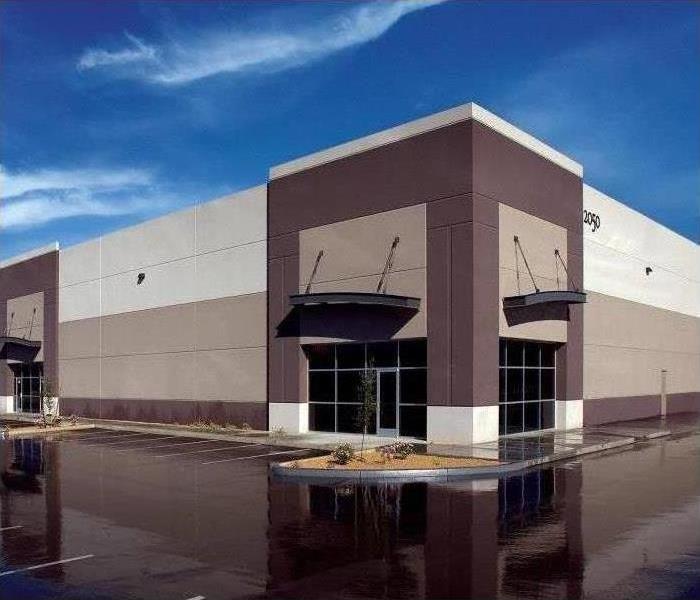 Commercial Building
Commercial Building
In order to protect your employees, customers and all of your equipment, you will need to make sure your property is safe. Here are some different ways you can do that:
"Conduct Maintenance Audits.
- The more attention you pay to your building maintenance, the less likely you are to face any issues. Keep your property current and routinely check for any slippery surfaces, damaged floors, sharp objects, frayed or damaged wires, or blocked hallways. Staying vigilant helps you avoid problems before they become an issue.
Increase Lighting In & Around the Building.
- When it comes to your building, it’s important to keep it well lit. Not only does it help to avoid trips and falls, but it can also help to avoid burglaries. Install extra lighting and make sure your building is well-lit.
Prepare for an Emergency.
- Disasters are unpredictable, which means it’s important to be prepared. Take precautions to minimize potential damage from a disaster, and make emergency exits readily available. Check that all your fire alarms are working properly and that all the emergency exits are well marked.
Install Security to Protect the Property.
- Businesses require a significant amount of expensive materials to operate, making it a prime target for burglaries. Take measures to increase security on the property. Install security cameras and alarms, and hire a security guard. Additionally, consult with local law enforcement to see what precautions they recommend."
info provided by: http://isuwissink.com/safety-tips-for-commercial-property/
Restoring Your Commercial Building
4/5/2021 (Permalink)
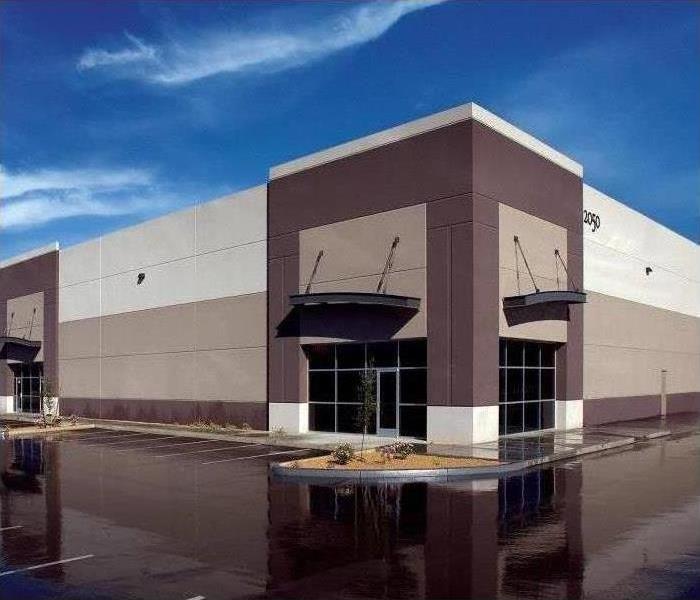 Commercial Building
Commercial Building
Flooding and water damage events at Chatsworth commercial properties are often complex with numerous issues that require a knowledgeable and flexible response. Whether we’re dealing with a relatively small water cleanup scenario or a large scale event, we work quickly to assess each unique situation and isolate the damaged area. In many instances, normal operations can continue in a temporary space while we restore your facility.
Restoring Commercial Properties Presents Unique Challenges
Our professionals are trained to be mindful of legal and environmental concerns and strive to fully restore the damaged area while working within your budgetary constraints. We understand that every hour spent cleaning up is an hour of lost revenue and productivity. So when an emergency situation arises in your business, give us a call and we’ll be there fast with the help you need.
About SERVPRO of Chatsworth
SERVPRO of Chatsworth specializes in the cleanup and restoration of commercial and residential property after a water damage event. Our staff is highly trained in property damage restoration. From initial and ongoing training at SERVPRO’s corporate training facility to regular IICRC-industry certification, rest assured our staff is equipped with the knowledge to restore your property.
Meet our Team: http://www.SERVPROchatsworth.com/crew-photos
Soot and Smoke
4/5/2021 (Permalink)
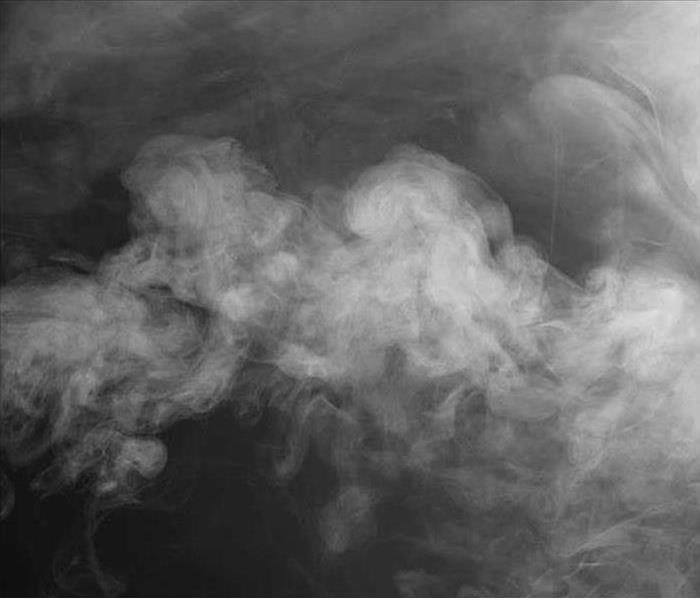 Smoke
Smoke
Many don’t know the effect smoke and soot actually have and to what extent. Smoke and soot is very invasive and can penetrate various cavities within your home, causing hidden damage and odor. SERVPRO of Chatsworth/Stevenson Ranch has smoke damage expertise and experience which allows us to properly help you!
Smoke and soot facts:
- Hot smoke migrates to cooler areas and upper levels of a structure.
- Smoke flows around plumbing systems, seeping through the holes used by pipes to go from floor to floor.
- The type of smoke may greatly affect the restoration process.
Different Types of Smoke
There are two different types of smoke–wet and dry. As a result, there are different types of soot residue after a fire. Before restoration begins, SERVPRO of Burbank will test the soot to determine which type of smoke damage occurred. The cleaning procedures will then be based on the information identified during pretesting. Here is some additional information:
Wet Smoke – Plastic and Rubber
- Low heat, smoldering, pungent odor, sticky, smeary. Smoke webs are more difficult to clean.
Dry Smoke – Paper and Wood
- Fast burning, high temperatures, heat rises therefore smoke rises.
Protein Fire Residue – Produced by evaporation of material rather than from a fire
- Virtually invisible, discolors paints and varnishes, extreme pungent odor.
Our Fire Damage Restoration Services
Since each smoke and fire damage situation is a little different, each one requires a unique solution tailored for the specific conditions. We have the equipment, expertise, and experience to restore your fire and smoke damage. We will also treat your family with empathy and respect and your property with care.
Have Questions about Fire, Smoke, or Soot Damage?
Call Us Today – (818) 842-1400
Keep Your Home Healthy
4/5/2021 (Permalink)
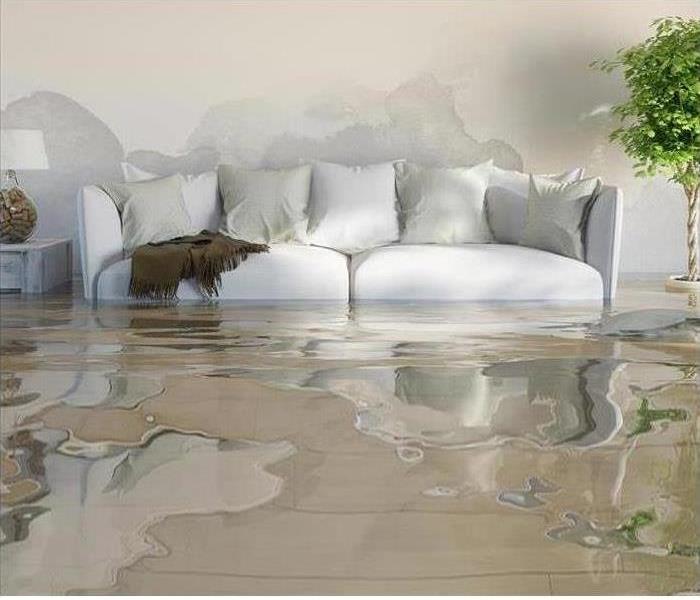 House Flood
House Flood
Hey SERVPRO of Chatsworth/Stevenson Ranch readers! We get a lot of water damage calls here. We here at SERVPRO know that there can be a lot of questions that come along with discovering water damage in your home, especially when it comes to your health and potential health effects. Our friends over at SERVPRO Saginaw put together some great thoughts on the topic. Read on to gain insight on what hazards can occur as a result of water damage and why it’s best to let the professionals handle the clean up.
The obvious result of water damage is structural---whether severe or cosmetic. And unfortunately, structural damage can wind up costing you thousands of dollars in repairs. The result of water damage can also cause the growth of toxic mold and mildew. If left untreated, this mold proliferation can cause health effects. So let’s get to it.
Hazard #1: Mold Growth -
- According to the Environmental Protection Agency (EPA), you should have your property dried and cleaned within 24-48 hours after the initial water onslaught. This practice will help decrease the likelihood of mold growth. Although you may be capable of starting the drying and cleaning processes, it is important to know that mold can grow in areas of the home that you can't see. Thus, simply cleaning and drying your carpet will not always be effective in preventing mold growth, especially if there is a large quantity of unwanted water. The mold can still grow in different areas of your home, including the carpet padding, underneath wallpaper, behind the drywall, along ceilings and baseboards, in voids and furniture.
- As noted by the EPA, there are several health effects that can result from exposure to mold. It is also important to note that the mold clean up process, performed by you, can lead to exposure to fungi. For this reason, professional water damage restoration technicians from SERVPRO will wear special protective gear and utilize state-of-the-art equipment for mold cleanup and the prevention of mold dispersion throughout your Saginaw home.
Hazard #2: Exposure to Sewage -
- Exposure to raw sewage is dangerous because it contains parasites, viruses, and bacteria such as E. coli. The sewage can also contain pharmaceuticals, chemicals, and pesticides. The EPA has stated that contaminated water can lead to the contraction of illnesses such as tuberculosis, dysentery, hepatitis, tetanus, and cholera. Safely stay away from the hazard of sewage water--blackwater--and let the experts execute the cleanup and dry out.
So… Let The Professionals at SERVPRO of Chatsworth/Stevenson Ranch Assist You!
- We are passionate about helping our customers make their water damage loss “Like it never even happened.” So no matter if it’s a leaky pipe underneath your bathroom sink or a busted water main that’s flooded your entire property, our team will get you taken care of so you can get back to a safe and HEALTHY state.
Call us 24 hours a day, 7 days a week. We are always here to help!
Air Movers
4/5/2021 (Permalink)
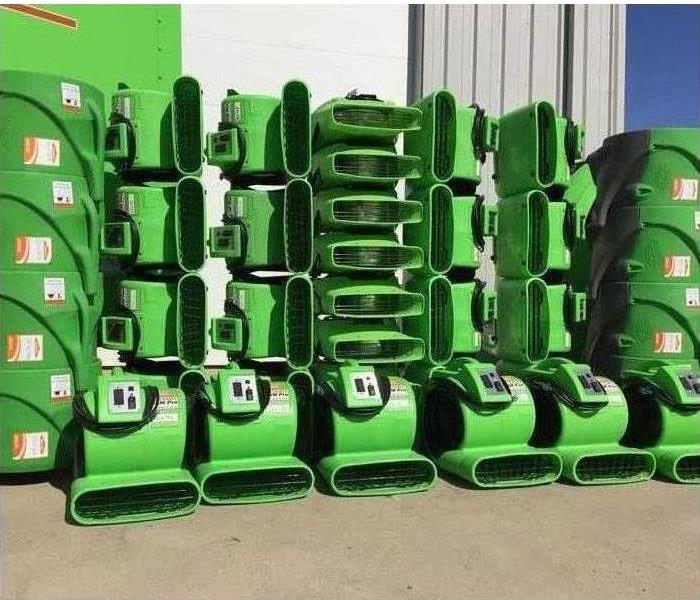 Air Movers
Air Movers
What is an Air Mover?
Air movers are used in construction and water restoration projects, having a wide variety of industrial applications. They are primarily used to increase air circulation, which speeds up water evaporation and reduces drying time. Compressed air is also used to maximize airflow in a blower fan or air mover. Some other names for air movers are “industrial air blowers”, “commercial blower fans” or “floor drying fans”.
Air movers are an essential tool when mitigation services are needed due to water damage or restoring flood or disaster damage. Some advantages of drying a building with the use of air movers are as follows:
- High velocity, making them ideal for cooling and ventilation purposes
- Reduces water damage dry out time to carpets and floors, as well as wall cavities behind drywall
- Removing fumes or gases from a work space
TYPES OF AIR MOVER UNITS
The type of air blower affects the speed and direction of airflow and the amount of space that can be covered by the air mover. There are three major types of air blower units used in most commercial dry out scenarios:
- Axial: Axial blowers are designed to move large amounts of air across a wide space. These tend to be larger air movers that produce high airflow. Unlike centrifugal air movers, which can direct air in several directions, axial air movers only move air horizontally. They’re ideal for drying walls or top-down drying treatments on carpets. They’re sometimes used for ventilation and equipment cooling.
- Centrifugal: This type offers a more compact air mover designed for spot treatments. Centrifugal air movers draw air from several sources and direct it to a particular spot. They are often used in restoration work to dry hard to reach areas like under cabinets and in crawl spaces and closets. Most centrifugal air movers can be adjusted to provide airflow at a few different angles. Centrifugal blowers are heavy-duty air movers that produce lower CFM than axial air movers.
Here to Help!
4/5/2021 (Permalink)
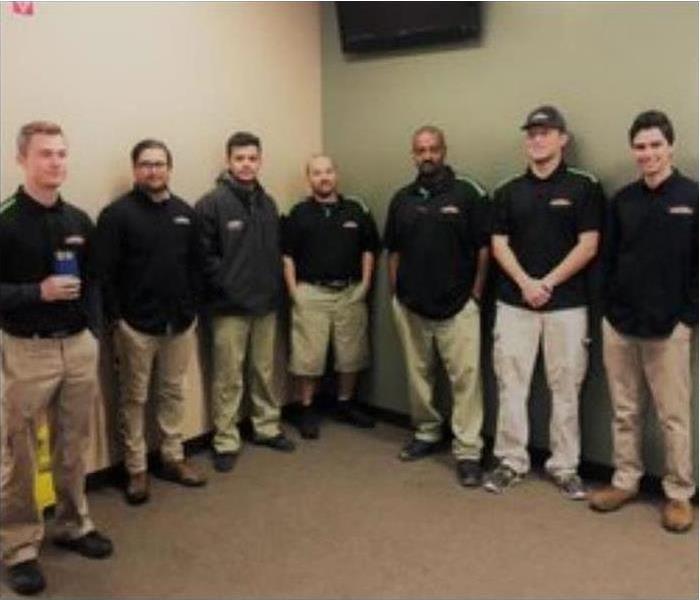 SERVPRO Team
SERVPRO Team
SERVPRO of Chatsworth/Stevenson Ranch prides themselves on customer service. Here at SERVPRO we make ourselves available to help 24 hours a day, 7 days a week. Our office staff work hard day in and day out to help every customer who may call. They are well trained and up to date with everything there is to know about SERVPRO so that they might help to the best of their ability.
When it comes to our techs and men who work out in the field they carry respect for every customer they come in contact with. They are aware that everyone they help is in a stressful situation and try their best to alleviate any stress they can. Our men are kind and well trained here at SERVPRO of Chatsworth/Stevenson Ranch!
We Are Certified!
4/2/2021 (Permalink)
 Our Franchise Owners
Our Franchise Owners
Have you ever had a bad or unpleasant experience with a company? We can assure you that will not be the case with SERVPRO of Chatsworth / Stevenson Ranch. In times of disaster and crisis, it is crucially important to choose a company who will not only get the job done, but look after the client as well.
The SERVPRO team is always ready to make any disaster "Like it never even happened." With specialized training, our technicians are well prepared to handle water damage, fire damage, mold remediation, bio-hazard cleanup and much more. Along with the expertise, here at SERVPRO of Chatsworth/Stevenson Ranch you can expect professionalism along with kindness and courtesy.
SERVPRO of Chatsworth / Stevenson Ranch is not only an IICRC-WRT certified firm but each of our crew chiefs are certified and ready to go 24 hours a day and 7 days a week. Call us here at (818) 842-1400.
SERVPRO of Chatsworth/Stevenson Ranch Serves
4/2/2021 (Permalink)
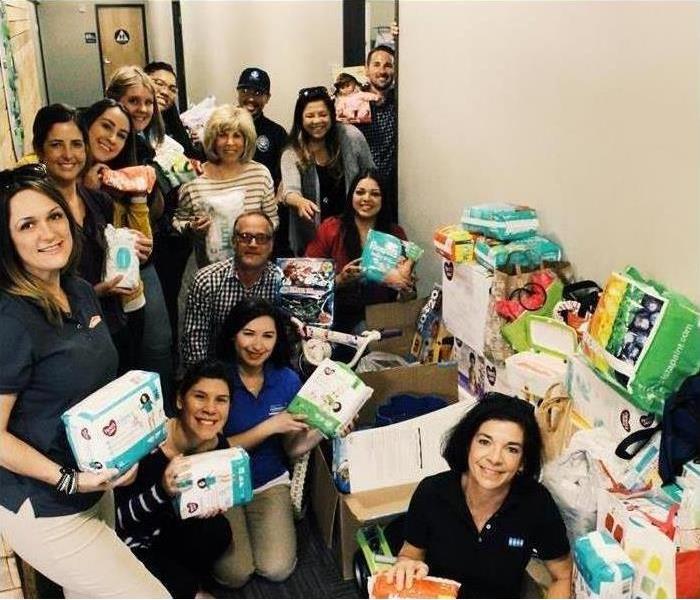 SERVPRO Serves
SERVPRO Serves
Here at SERVPRO of Chatsworth/Stevenson Ranch we not only specialize in restoration and cleanup services, but we also love to participate and give back to our community.
Every fall, we partner up with the San Fernando Rescue Mission's Thanksgiving Dinner. Most recently, we collected over twenty-six hundred rolls for dinner. It's always a blessing knowing that these families will be well fed on a day of thanks and love.
Additionally, Jenn of our marketing team volunteers at the CAI-GLAC's outreach committee. Some of the projects she has contributed to include the Spark of Love Toy Drive, Tree People - environment cleanup, SCV Single Mothers Outreach and much more. Knowing that our team members have a heart and passion for the community only further solidify the integrity of SERVPRO of Chatsworth/Stevenson Ranch.
Prevent Water Damages
4/1/2021 (Permalink)
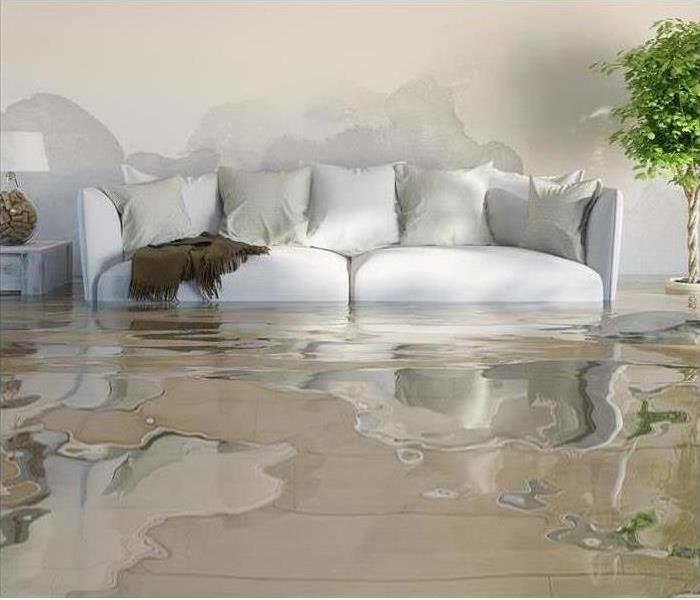 Living Room Flooded
Living Room Flooded
3/5/2020
Water Damage is something no homeowner wants to deal with. It often comes unexpectedly and without warning. Water damage can cause structural damage and if not treated quickly can eventually result in mold. But good news! There are some easy tips to avoid water damage in your home.
- Make sure your home has good drainage, clean the rain gutters often and make sure they are clear. If you live on a hill, slope your yard away from the home so that it will direct water away from the home.
- If you already have leaks, make sure they are fixed immediately. Check for dark spots under pipes or on the ceiling.
- Maintain your roof, if there are missing shingles replace them immediately.
SERVPRO of Chatsworth / Stevenson Ranch is faster to any size disaster!
Call 24 hours a day, 7 days a week at 818-842-1400
SERVPRO of Chatsworth/Stevenson Ranch Expertise
4/1/2021 (Permalink)
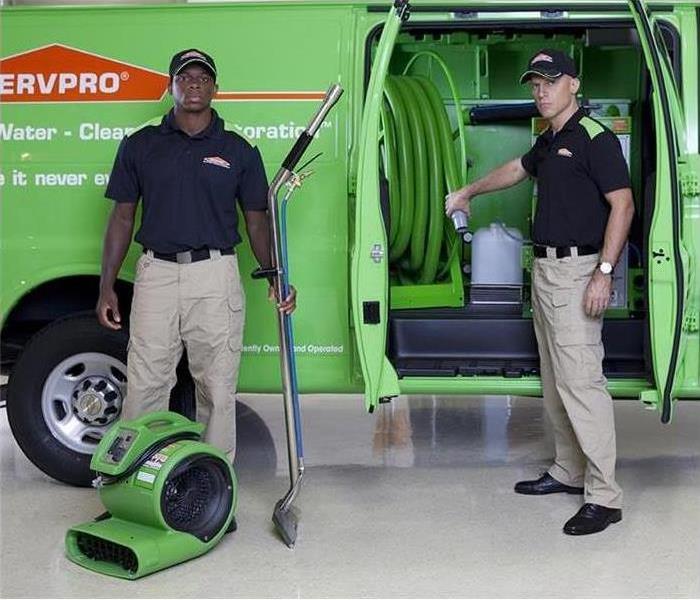 SERVPRO Crew Members
SERVPRO Crew Members
3/27/2020
Have you ever had a bad or unpleasant experience with a company? We can assure you that will not be the case with SERVPRO of Chatsworth/Stevenson Ranch. In times of disaster and crisis, it is crucially important to choose a company who will not only get the job done, but look after the client as well.
The SERVPRO team is always ready to make any disaster "Like it never even happened." With specialized training, our technicians are well prepared to handle water damage, fire damage, mold remediation, bio-hazard cleanup and much more. Along with the expertise, here at SERVPRO of Chatsworth/Stevenson Ranch you can expect professionalism along with kindness and courtesy.
At SERVPRO of Chatsworth / Stevenson Ranch our crew chiefs are certified and ready to go 24 hours a day and 7 days a week. Call us here at (818) 842-1400.
Storm Team
3/11/2021 (Permalink)
When Major storms roll out, watch SERVPRO's Storm Teams roll in.
SERVPRO of Chatsworth/Stevenson Ranch is part of a network of over 1,800 restoration specialists, stretching throughout the United States as well as Canada – strategically stationed to be available for whatever happens at a moment’s notice. When things that matter most are on the line, make sure SERVPRO® is too. SERVPRO of Chatsworth/Stevenson Ranch is faster to any size disaster.
Should a storm or natural disaster situation strike the greater Los Angeles area, our office will notify local and surrounding SERVPRO locations. And as we begin to provide relief to homes and businesses alike, hundreds if not thousands of highly-trained SERVPRO professionals will start to pour into the disaster zone and provide backup and support to our already existing restoration efforts. Whether it’s damage caused by a leaky water pipe or an earthquake of catastrophic magnitudes, there’s no such thing as a job too big that SERVPRO can’t handle!
The days immediately following a major storm event, such as area-wide flooding, are critical to prevent secondary damages, like mold. SERVPRO of Chatsworth/Stevenson Ranch suggest the following steps to help minimize additional damage to your property.
- If the water has entered the structure through the flooding of a creek, stream or river, or if it has filtered through insulation during its intrusion, it is considered to be black water and could be hazardous to your health. Avoid contact with contaminated items as much as possible.
- Take the greatest caution while entering your home, and wear sturdy shoes and protective clothing when dealing with flooded areas.
- Do not attempt to operate any electrical equipment while standing in wet or damp locations.
- Throw away all foods - even canned goods - that have come into contact with flood waters.
- Remove and prop wet upholstery and pillow cushions for drying. Wipe excess water from wood furniture after removal of lamps and tabletop items.
- Place fans at 45-degree angles to walls and move large furniture away from walls to create the best air circulation.
- If your home has a crawlspace, be aware excess moisture in this area can often foster mold growth.
"The first 24 hours after a water damage or flood are so crucial to keeping final costs of the damage down," said Don Turner, Director of SERVPRO’s Disaster Recovery Team. "A lot of flood situations require professional equipment and knowledge of the science of drying to mitigate. By taking these steps, property owners can help minimize damage until the professionals arrive."
Prepare Your Place of Worship
3/2/2021 (Permalink)
 Place of Worship
Place of Worship
It happens more often than not in any case of disaster and emergency a place of worship tends to be a place of shelter. It is because of this and the importance of a places of worship that all churches be prepared for the worst!
Here are some tips at preparing your place of worship for a disaster:
- Identify hazards or threats early
- Take necessary precautions for those hazards or threats.
- Plan evacuations
- Train your church staff for emergency readiness and response.
- Prepare surrounding members of the community.
- Be prepared to provide help or aid to your church members after a disaster strikes.
SERVPRO of Chatsworth/Stevenson Ranch is faster to any size disaster. If you or your church finds yourself in need, give us a call at 818-842-1400
Flash Flood Tips
2/18/2021 (Permalink)
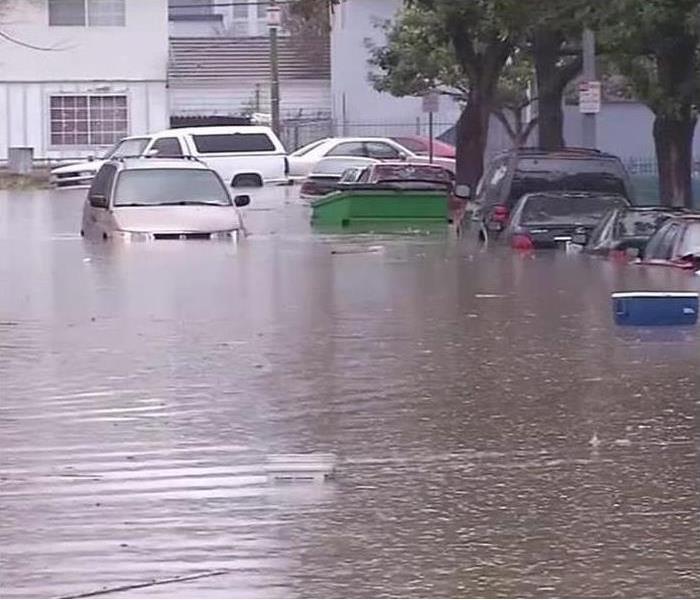 Flash Flood in City
Flash Flood in City
Flash floods can happen at any moment. They are often a significant source of rainfall in Southern California, but with that can come water damage to homes and commercial properties. Here are some tips to follow after a flood.
1. Only return to your home or property when it is deemed safe to do so. If there was a mandatory evacuation, wait until that is lifted to return.
2. Inspect your home or property. Look for leaks, water damage, hillsides, or slope movement.
3. Drive carefully, many roads will be covered with mud, debris, and often holes.
4. Be vigilant for mudslides as they can happen days after the flood after the soil dries.
5. Be prepared for the next flood by preparing slopes and high risk areas during the winter time.
SERVPRO of Chatsworth/Stevenson Ranch is faster to any size disaster!
818-842-1400
Drains and Gutters
2/3/2021 (Permalink)
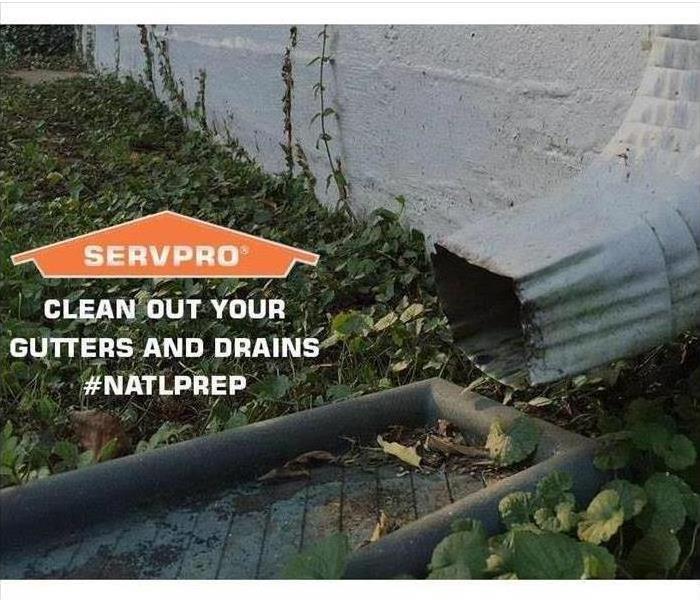 Please remember clean your drain gutters
Please remember clean your drain gutters
Gutters are a very important part of roofs for commercial and residential buildings as they are responsible for transporting water and debris off of roofs. It is vital especially in stormy seasons, that you keep your gutters functioning to their highest ability. Here are a few ways to help ensure that your gutters are doing their job and are in good condition.
- Gutters should be inspected twice a year and cleared of debris that could prevent the flow of water and materials from roof. Also, check for standing water in gutters as it could indicate inadequate flow of water. Water should be moving down off the roof toward storm drainage areas. Keeping trees trimmed near the roof will alleviate stress on gutters because the branches will not slow water flow or contribute more debris to gutters.
- Ensure water is being funneled away from the building once off the roof, as flooding can sometimes occur due to runoff not having proper.
- Water stains on the internal ceiling can indicate a roof leak.
In the case of water damage, roof leaks, and storm damage, SERVPRO of Chatsworth/Stevenson Ranch provides “24 Hour Emergency Services” 7 days a week.
House Fires in Winter
2/3/2021 (Permalink)
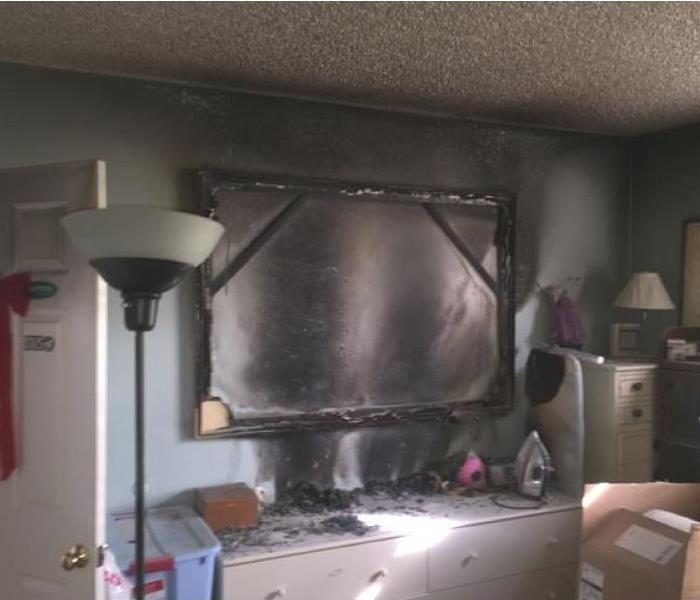 House fire that happened in December
House fire that happened in December
Did you know that according to the California State Firefighter's Association, December, January, February and March are the peak months for house fires?
The cause of these fires are primarily due to heating equipment such as space heaters. The different ways space heaters can cause a fire are:
- Lack of cleaning around space heaters and/or inside chimneys
- Placing heaters too close to combustibles
- Basic flaws in the design of the heater
- Leaks involving liquid or gas heaters
Here are some ways that you can help prevent winter fires and protect yourself and your family:
Turn off space heaters when leaving a room- Give space heaters at least 3 feet clearance all the way around from household items
- Clean around space heaters regularly, especially inside of the chimney
- Install smoke detectors
- Keep a fire extinguisher in your home and educate yourself on how to use it
Unfortunately, even with precautions fires can still happen in your home. If you do suffer fire or smoke damage in your home, have no fear we are here to help! We have certified trained technicians that specialize in fire and smoke damage. Please call us, SERVPRO of Burbank (818) 842-1400.
Mold In Your Commercial Property
12/29/2020 (Permalink)
 Visible mold found in electrical room at a commercial property.
Visible mold found in electrical room at a commercial property.
Here are some tips if you suspect that you have found mold in your commercial property.
What you should do:
- Turn of the HVAC system and fans
- Stay out of the affected area
- Contact SERVPRO of Burbank for mold remediation services
What you should not do:
- Do not touch or disturb the mold
- Do not attempt to clean the area yourself
- Do not blow any air around the suspected microbial growth
- Do not spray disinfectants on the mold
If you come across suspected mold, do not disturb it in any way. Any disturbance could easily spread the mold spores throughout your property. When disturbed, mold spores can become airborne and circulate inside your business.
SERVPRO of Chatsworth/Stevenson Ranch specializes in mold cleanup and restoration. It is a huge part of our business. Our crews are highly trained restoration professionals that use specialized equipment and techniques to properly remediate the mold problem quickly and safely. The well being of our customers is our highest priority!
If you believe you have found mold at your business do not hesitate and call us today- (818) 842-1400
Storm Roof Damage
10/27/2020 (Permalink)
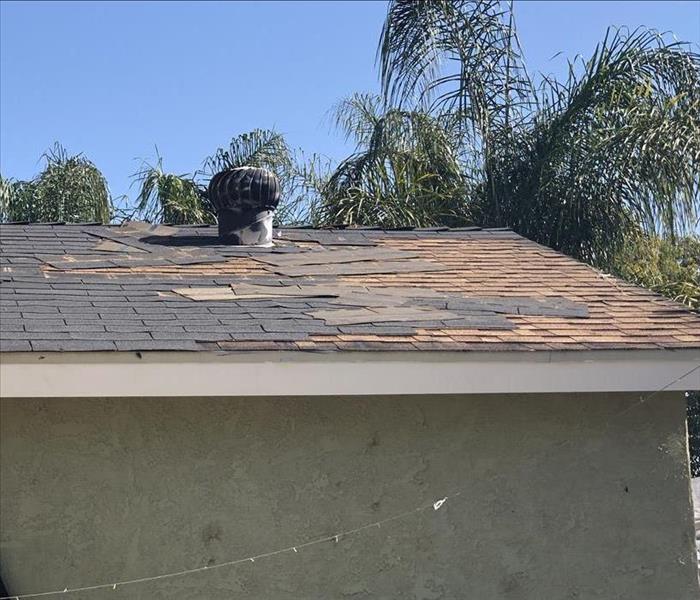 Roof damage caused from a storm.
Roof damage caused from a storm.
Severe or even mild thunderstorms can easily cause roof damage, especially if your roof is older than 15-20 years old. These damages can cause water intrusion in your home and if left untreated can cause more serious issues such as mold or wood rot. Some common types of roof damage from storms are:
- Split seams
- Broken or cracked tiles
- Dented or missing shingles
- Dents on gutters or vents
Holes
All of these issues can cause water to leak into your home and you may not even notice! Unless you physically see the water damage, you may not realize that you have any. If you have an attic that you don't always go into, it is possible to have water leaking before seeing it. It is always a good idea to check for roof damage after a severe thunderstorm. A professional roofing contractor can help you with this.
In addition to these common types of damage, there are some rare occurrences of damage that can happen. Rare types of roof damage are:
- Caving in on itself
- Tree blowing over onto roof
Unfortunately for these types of rare but extreme damage, there is no way to prevent them from happening. The best thing you can do, is to get your roof replaced if older than 15 years, and to make sure to trim your trees prior to a thunderstorm.
Even if water does enter your home from roof damage, know that SERVPRO of Burbank is here to help 24/7! 818-842-1400
SERVPRO & The American Red Cross
9/25/2020 (Permalink)
The American Red Cross recently recognized SERVPRO®, a cleanup and restoration company, for participating in its Disaster Responder Program. As a member of this program, SERVPRO pledges a donation to the Red Cross as an action of preparation against the calculated 66,000 disasters that occur annually. SERVPRO is entering their third year of partnership with the Red Cross, and to date their donations to the organization exceed one million dollars.
The majority of the disasters that occur every year are house fires. Statistics cited by the Red Cross state that in the U.S. seven people die in a home fire each day. The Red Cross has aimed to reduce deaths and injuries caused by home fires 25 percent by the year 2019. Because of this goal, they launched a Home Fire Campaign in October of 2014. The support of SERVPRO and other Disaster Responder Program members allows the Red Cross to pursue their home fire prevention goals while continuing to provide critical services to disaster victims.
"Statistics compiled by the National Fire Protection Association (NFPA) show the majority of home fires are related to cooking accidents." Dave Tronson, owner of SERVPRO of Chatsworth / Stevenson Ranch, states, "the risk for home fires exists all year long," further extending their pledge to help Red Cross to respond and prevent such a disaster as a home fire.
Not only does SERVPRO help other business and home owners with recovery for fires, floods, and other disasters, the company and its franchises actively support disaster preparedness education, including fire prevention efforts. When disaster strikes, the relationships with major insurance companies combined with the industry-leading job-management technology that SERVPRO has can smooth the path to rebuilding and restoration for home and business owners affected by disastrous events.
"SERVPRO’s commitment to the Red Cross Disaster Responder Program means that when disaster strikes, homeowners can count on the Red Cross to address their immediate needs and supply essential services," said Tronson. "Once the immediate emergency is under control, homeowners can count on the expertise of restoration specialists at SERVPRO of Chatsworth / Stevenson Ranch to help restore their property and move forward with their lives."
For fire prevention tips and information about fire and water damage restoration services, please visit www.SERVPRO.com. For more information on SERVPRO® of Chatsworth / Stevenson Ranch, please contact Dave Tronson at (818) 709-6090 or SERVPRO2720@SERVPROburbank.com
About SERVPRO®
Founded in 1967, the SERVPRO® Franchise System is a leader and provider of fire and water cleanup and restoration services, and mold mitigation and remediation. SERVPRO's professional services network of more than 1,700 individually owned and operated Franchises responds to property damage emergencies ranging from small individual disasters to multi-million dollar large-loss events. Providing coverage in the United States and Canada, the SERVPRO® System has established relationships with major insurance companies and commercial clients, as well as individual homeowners.
Rain Tips!
9/25/2020 (Permalink)
The Heavy Rains have hit Southern California! Here are some tips for your home and the rainy weather!
Tip #1: Check those gutters! This can be a simple but very effective way to prevent unwanted water from entering your home or business. Gutters that are clogged with debris from overhanging trees, trash, or roofing materials can easily clog the drain and shuffle unwanted water your way.
Tip #2: Tarp up any unfinished roofing projects. Going along with our first tip, small openings in the roof of your home and business can quickly become large openings with heavy rain, causing water damage inside your building. Make sure to give your local roofing company a call and get those potential problem areas patched up ASAP.
Tip #3: Examine your window glaze and compound. Often times, glazing compound can shrink during the warmer months, making windows more susceptible to unwanted rain water penetration. Your local contractor can help patch this up for you, ensuring that you are set and ready for even the heaviest of rains! Another helpful tip… make sure you close your windows before going to bed or leaving the home!
And finally, Tip #4 (the most important!): Should you find yourself in a situation where you do have a water damage emergency, call SERVPRO of Chatsworth / Stevenson Ranch. Our staff is prepped and ready to respond and help make your rain disaster, "Like it never even happened."
Our Mold Expertise
9/25/2020 (Permalink)
If you see visible mold, do not disturb it. You can inadvertently spread the mold infestation throughout your home. When mold is disturbed, the mold can release microscopic mold spores which become airborne and can circulate inside your home.
What to Do:
· Stay out of affected areas.
· Turn off the HVAC system and fans.
· Contact SERVPRO of Chatsworth / Stevenson Ranch for mold remediation services.
What Not to Do:
· Don’t touch or disturb the mold.
· Don’t blow air across any surfaces with visible or suspected mold growth.
· Don’t attempt to dry the area yourself.
· Don’t spray bleach or other disinfectants on the mold.
About Our Mold Remediation Services
SERVPRO of Chatsworth / Stevenson Ranch specializes in mold cleanup and restoration; in fact, it’s a cornerstone of our business. Our crews are highly trained restoration professionals that use specialized equipment and techniques to properly remediate your mold problem quickly and safely.
If You See Signs of Mold, Call Us Today – (818) 842-1400
Commercial Losses
9/24/2020 (Permalink)
When talking to business owners regarding potential water damage events, they often visualize a massive storm wiping out power lines, flooding offices. Resulting the fear of having to shut down businesses for days at a time with it potentially not opening. It is true that commercial water damage is often the result of floods and water that stems from weather events and storms. Although living in sunny Southern California; hurricane-like storms are few and far between.
However, many entrepreneurs and business space renters forget that storms and severe weather aren't the only cause of floods and water damage. Commercial water damage is surprisingly common year-round, and it can drastically affect the operation of your business. Here are some of the typical causes of water damage to commercial buildings.
- Malfunctioning sprinkler systems: Some older office and retail buildings still have outdated sprinkler systems that work in conjunction with fire protection systems. While such sprinklers can come in handy during a fire emergency, they can also cause commercial flood damage if they are faulty or in need of replacement. This could easily damage inventory and business assets.
- Damaged appliances and equipment: This cause of commercial flood damage is more common in restaurants and catering facilities, as well as any business that has appliances and equipment that make use of water. If the appliance fails and sends water across your building, especially during late hours when no one is around, you may come back to work and face a water emergency.
- Broken pipes and plumbing: Just like in a residence, if the plumbing system in your workplace fails water damage could be the result. If you question the stoutness of your building's pipes, contact SERVPRO for a thorough inspection and assessment.
- Backed up sewer lines: This is another cause of commercial water damage that often catches business owners by surprise. Should the sewer line to your building back up or become damaged, realize the potential dangers of contaminated Black Water which can cause health effects and ruin products and office furnishings. SERVPRO has certified IICRC technicians to deal with this type of water damage.
If your business has suffered commercial water damage, SERVPRO of Chatsworth / Stevenson Ranch call us anytime 24/7 at (818) 842-1400 for fast help.
Customer Service
9/24/2020 (Permalink)
SERVPRO of Chatsworth/Stevenson Ranch prides themselves on customer service. Here at SERVPRO we make ourselves available to help 24 hours a day, 7 days a week. Our office staff work hard day in and day out to help every customer who may call. They are well trained and up to date with everything there is to know about SERVPRO so that they might help to the best of their ability.
When it comes to our techs and men who work out in the field they carry respect for every customer they come in contact with. They are aware that everyone they help are in a stressful situation and try their best to alleviate any stress they can. Our men are kind and well trained here at SERVPRO of Chatsworth/Stevenson Ranch!
Avoiding a Flood
9/24/2020 (Permalink)
Floods are the most common natural disasters in the United States. There are many effects a heavy rain storm can cause. Some significant things such as flooding, potential flash floods, mud-flows, or over-topping levees and dams. Here in California heavy rains can happen, putting properties like your home or business at risk.
Tips to help your home or business avoid floods:
- Purchase flood insurance. (Call your insurance agent make sure your covered for FLOODS)
- Install rain gutters and other drainage systems. (Clean out rain gutters frequently)
- Fix any leaks IMMEDIATELY.
- Extra roof protection (spend a few hundred dollars more to install a rubber roof underlayment, a waterproof barrier that goes under the shingles and protects the roof from water intrusion.)
Tips for drivers during the rain season:
- Avoid cruise control (This feature works great in dry conditions, but when used in wet conditions, the chance of losing control of the vehicle can increase)
- Slow down and leave room in front of you (Slowing down during wet weather driving can be critical to reducing a car’s chance of hydroplaning, when the tires rise up on a film of water.)
Remember if you do experience a flood in your home or business SERVPRO of Chatsworth / Stevenson Ranch is one call away and we make your water damage "Like it never even happened."
Call SERVPRO of Chatsworth/Stevenson Ranch at (818) 842-1400
Water Loss Categories
8/14/2020 (Permalink)
If you've been in and around a water loss you may have often heard the reference of which category the loss is under. So what exactly does that mean? SERVPRO of Chatsworth / Stevenson Ranch will shed some light on the three categories of a water loss and what they mean.
Category 1: Refers to the source of water as being "clean water" otherwise meaning a source of water that does not pose a substantial threat to humans. Examples:
- Broken water supply line
- Sink or tub overflow
- Appliance malfunction
Category 2: Refers to the source of water as containing a significant degree of chemicals, biological or physical contaminants that cause discomfort or sickness when consumed or exposed to. It is often referred to as "grey water" Examples:
- Toilet bows w/urine (no feces)
- Sump pump failures
- Seepage from washers
Category 3: Referred to as "black water" and is grossly contaminated. This water contains unsanitary agents, harmful bacteria and fungi, causing severe discomfort or sickness. Examples:
- Toilet back flows
For all your water damage needs give us a call at 818-842-1400
What is Soot?
8/12/2020 (Permalink)
What exactly is soot?
SERVPRO of Chatsworth / Stevenson Ranch is happy to give some insight on what the common black powder substance is.
Soot is described as the fine black particles composed of carbon. It is created by incomplete combustion of coal, oil, wood and other fuels. It can consist of acids, chemicals, metals, soils and dust. The main trait of soot is it's size, the particles are extremely tiny, 2.5 micrometers or smaller.
Is soot dangerous?
With soot often containing chemicals in addition with its tiny size, it can prove dangerous when breathed in. It can travel deep in the lungs which can lead to coronary heart disease, asthma, bronchitis, and other respiratory illnesses.
Compounds from soot are sulfur dioxides and nitrogen dioxides, they combine with moisture and form acid rain which then worsens water quality and damages crops. In addition, it can also change nutrient balances in many ecosystems.
Be Prepared for a Fire
8/11/2020 (Permalink)
Developing Fire Safe Habits For Your Home is very important here in SoCal. SERVPRO of Chatsworth / Stevenson Ranch and the Red Cross have some tips on how to do so:
- Keep items that can catch on fire at least three feet away from anything that gets hot, such as space heaters.
- Smoking materials are the leading cause of residential fire deaths in the United States. If you smoke, take precautions: Smoke outside; choose fire-safe cigarettes; never smoke in bed, when drowsy or medicated, or if anyone in the home is using oxygen.
- Use deep, sturdy ashtrays and douse cigarette and cigar butts with water before disposal.
- Talk to children regularly about the dangers of fire, matches and lighters and keep them out of reach.
- Turn portable heaters off when you leave the room or go to sleep.
- Never leave a burning candle unattended, even for a minute.
Information provided by redcross.org
The SERVPRO ERP
6/29/2020 (Permalink)
It is estimated that up to 50% of businesses that close due to a disaster, such as fire and flood never reopen! Of the businesses that survive, the overwhelming majority of them had a preparedness plan in place.
Are you “Ready for whatever happens?”
Preparation is a key component for making it through any size disaster, whether it’s a small water leak, a large fire, or an area flood. The best time to plan for such events is not when the event happens, but well before it happens.
The SERVPRO® Emergency READY Plan serves as a quick reference of important building and contact information or can be an ideal supplement to any well-designed emergency preparedness or existing contingency program. Rather than simply reacting to disaster situations, most prefer proactive measures to establish a relationship with a restoration services company.
By working with SERVPRO to develop your personalized Emergency READY Plan your business will receive the benefit of over 30 years of experience in reducing the impact of any natural or man-made disaster. SERVPRO is a leader in water and fire damage response for the greater LA area and can help you quickly get your property back in working order.
Call our office at (818) 842-1400 to learn more on how to set up this profile for your facility and get prepared before disaster strikes!
Stay Safe this 4th of July
6/11/2020 (Permalink)
Fourth of July weekend is once again upon us! Each year at SERVPRO of Chatsworth, we remember those who have both come before and those who are currently serving to protect our freedom. Like most people on this holiday weekend, we will be sharing it with family and friends and joining in on the many traditions that has made our Independence Day a day to pull out all the stops!
Though there are many activities to partake in, one of the most popular things to do on the 4th is to light off fireworks. And as long as handled properly, they can be a whole lot of fun.
According to the U.S. Consumer Fire Safety Administration, “230 people on average go to the emergency room every day with fireworks-related injuries in the month around the July 4th holiday.” Though this number may be startling to see, we at SERVPRO of Chatsworth want to see if we can help reduce this number for 2016. In an effort to promote injury and fire prevention, here are some recommended safety tips provided by the USCFSA –
- Never allow young children to play with or ignite fireworks.
- Avoid buying fireworks that are packaged in brown paper because this is often a sign that the fireworks were made for professional displays and that they could pose a danger to consumers.
- Always have an adult supervise fireworks activities. Parents don't realize that young children suffer injuries from sparklers. Sparklers burn at temperatures of about 2,000 degrees - hot enough to melt some metals.
- Never place any part of your body directly over a fireworks device when lighting the fuse. Back up to a safe distance immediately after lighting fireworks.
- Never try to re-light or pick up fireworks that have not ignited fully.
- Never point or throw fireworks at another person.
- Keep a bucket of water or a garden hose handy in case of fire or other mishap.
- Light fireworks one at a time, then move back quickly.
- Never carry fireworks in a pocket or shoot them off in metal or glass containers.
- After fireworks complete their burning, douse the spent device with plenty of water from a bucket or hose before discarding it to prevent a trash fire.
- Make sure fireworks are legal in your area before buying or using them.
And if you are also curious about how to prevent additional mishaps during this 4th of July weekend of celebration, check out the Prevention Tips video our SERVPRO of Chatsworth office put together for your enjoyment!
How to Prevent a Home Fire
6/10/2020 (Permalink)
How to prevent fires at home
Most people know the basics of fire safety at home, such as not leaving burning candles unattended and keeping a fire extinguisher on hand. Here are a few more things you can do to prevent fires at home.
- Have your heating system serviced regularly by a professional, including chimneys from wood-burning fireplaces. Clean around heat sources and keep dust and other flammable items away from ignition sources.
- Remove the lint from your dryer filter after every use. A clogged filter and lint trap makes your dryer less efficient, reduces the airflow needed to keep heat from building up in the vents, and forces lint onto the heating coils. Also, never let your dryer run when you are out of the house or when you’re asleep.
- Keep firewood, piles of leaves and trash away from the home. If a grass fire starts nearby, these items next to your home could easily become kindling. Never dump hot ashes inside or near your home; keep them in a metal container well away from your house and garage.
- Avoid using outlet extenders or plug-in power bars: they can quickly overload an electrical circuit. Replace old, damaged or frayed appliance cords, and never force a three-pronged plug into a two-slot outlet or extension cord.
- Store containers of cooking oil well away from the stove. When cooking with oil, never leave the stove unattended. To stop a grease fire, turn off the burner and place a lid on the pan to suffocate the flames, or pour on lots of baking soda. Never pour water on a grease fire or try to carry the pan outside; water splatters the grease and makes the fire bigger, and the pan will be much too hot to carry.
- Consider using borrowed heat to keep outdoor pets warm. During winter months, avoid using heat lamps, solar lamps, trouble lights, heated watering bowls or other such heated devices, which could lead to a potential fire. Borrowed heat involves providing warmth from a heating system located in a separate building. If this isn’t possible, consider bringing your pets inside.
- Be sure to properly extinguish smoking materials. Smoking materials that are not properly extinguished can smoulder undetected for days before igniting a fire. Never discard smoking materials on the ground or in plant pots.
info provided by https://www.cooperators.ca/en/Answer-Centre/how-can-i-be-safe-and-prepared/home/five-best-ways-to-prevent-fires-in-home.aspx
Be Ready During the Storm
4/14/2020 (Permalink)
When a storm hits, sometimes it takes you by surprise. You may not have the immediate chance to grab what you need or even have it on hand at all. That is why it is so important to have a Storm Supply Kit ready to go.
A Storm Supply Kit could be described as a pre-chosen group of supplies that could assist with health and safety during or after a storm or disaster.
It would be ideal to keep a Storm Supply Kit at home, work , and in your vehicle.
Here are some supplies to keep in your kit:
1. Medications needed
2. first aid kit with instructions
3. flashlight
4. cash and important documents
5. food for several days
6. water for several days
7. clothing and shoes
8. pocket knife with tools attached
9. Sanitation wipes and hygiene products.
SERVPRO of Chatsworth / Stevenson Ranch is faster to any size disaster!
818-842-1400
SERVPRO of Chatsworth/Stevenson Serving the Community
4/2/2020 (Permalink)
Here at SERVPRO of Chatsworth/Stevenson Ranch we not only specialize in restoration and cleanup services, but we also love to participate and give back to our community.
Every fall, we partner up with the San Fernando Rescue Mission's Thanksgiving Dinner. Most recently, we collected over twenty-six hundred rolls for dinner. It's always a blessing knowing that these families will be well fed on a day of thanks and love.
Additionally, Jenn of our marketing team volunteers at the CAI-GLAC's outreach committee. Some of the projects she has contributed to include the Spark of Love Toy Drive, Tree People - environment cleanup, SCV Single Mothers Outreach and much more. Knowing that our team members have a heart and passion for the community only further solidify the integrity of SERVPRO of Chatsworth/Stevenson Ranch.
SERVPRO of Chatsworth/Stevenson Here to Help
4/1/2020 (Permalink)
SERVPRO of Chatsworth/Stevenson Ranch prides themselves on customer service. Here at SERVPRO we make ourselves available to help 24 hours a day, 7 days a week. Our office staff work hard day in and day out to help every customer who may call. They are well trained and up to date with everything there is to know about SERVPRO so that they might help to the best of their ability.
When it comes to our techs and men who work out in the field they carry respect for every customer they come in contact with. They are aware that everyone they help is in a stressful situation and try their best to alleviate any stress they can. Our men are kind and well trained here at SERVPRO of Chatsworth/Stevenson Ranch!
SERVPRO of Chatsworth/Stevenson Mold Tips
4/1/2020 (Permalink)
If you see visible mold, do not disturb it. You can inadvertently spread the mold infestation throughout your home. When mold is disturbed, the mold can release microscopic mold spores which become airborne and can circulate inside your home.
What to Do:
· Stay out of affected areas.
· Turn off the HVAC system and fans.
· Contact SERVPRO of Chatsworth / Stevenson Ranch for mold remediation services.
What Not to Do:
· Don’t touch or disturb the mold.
· Don’t blow air across any surfaces with visible or suspected mold growth.
· Don’t attempt to dry the area yourself.
· Don’t spray bleach or other disinfectants on the mold.
About Our Mold Remediation Services
SERVPRO of Chatsworth / Stevenson Ranch specializes in mold cleanup and restoration; in fact, it’s a cornerstone of our business. Our crews are highly trained restoration professionals that use specialized equipment and techniques to properly remediate your mold problem quickly and safely.
If You See Signs of Mold, Call Us Today – (818) 842-1400
What are Air Movers?
3/27/2020 (Permalink)
What is an Air Mover?
Air movers are used in construction and water restoration projects, having a wide variety of industrial applications. They are primarily used to increase air circulation, which speeds up water evaporation and reduces drying time. Compressed air is also used to maximize airflow in a blower fan or air mover. Some other names for air movers are “industrial air blowers”, “commercial blower fans” or “floor drying fans”.
Air movers are an essential tool when mitigation services are needed due to water damage or restoring flood or disaster damage. Some advantages of drying a building with the use of air movers are as follows:
- High velocity, making them ideal for cooling and ventilation purposes
- Reduces water damage dry out time to carpets and floors, as well as wall cavities behind drywall
- Removing fumes or gases from a work space
TYPES OF AIR MOVER UNITS
The type of air blower affects the speed and direction of airflow and the amount of space that can be covered by the air mover. There are three major types of air blower units used in most commercial dry out scenarios:
- Axial: Axial blowers are designed to move large amounts of air across a wide space. These tend to be larger air movers that produce high airflow. Unlike centrifugal air movers, which can direct air in several directions, axial air movers only move air horizontally. They’re ideal for drying walls or top-down drying treatments on carpets. They’re sometimes used for ventilation and equipment cooling.
- Centrifugal: This type offers a more compact air mover designed for spot treatments. Centrifugal air movers draw air from several sources and direct it to a particular spot. They are often used in restoration work to dry hard to reach areas like under cabinets and in crawl spaces and closets. Most centrifugal air movers can be adjusted to provide airflow at a few different angles. Centrifugal blowers are heavy-duty air movers that produce lower CFM than axial air movers.
SERVPRO of Chatsworth/Stevenson Ranch is Certified!
3/27/2020 (Permalink)
Have you ever had a bad or unpleasant experience with a company? We can assure you that will not be the case with SERVPRO of Chatsworth / Stevenson Ranch. In times of disaster and crisis, it is crucially important to choose a company who will not only get the job done, but look after the client as well.
The SERVPRO team is always ready to make any disaster "Like it never even happened." With specialized training, our technicians are well prepared to handle water damage, fire damage, mold remediation, bio-hazard cleanup and much more. Along with the expertise, here at SERVPRO of Chatsworth/Stevenson Ranch you can expect professionalism along with kindness and courtesy.
SERVPRO of Chatsworth / Stevenson Ranch is not only an IICRC-WRT certified firm but each of our crew chiefs are certified and ready to go 24 hours a day and 7 days a week. Call us here at (818) 842-1400.
SERVPRO of Chatsworth/Stevenson Ranch Expertise
3/27/2020 (Permalink)
Have you ever had a bad or unpleasant experience with a company? We can assure you that will not be the case with SERVPRO of Chatsworth/Stevenson Ranch. In times of disaster and crisis, it is crucially important to choose a company who will not only get the job done, but look after the client as well.
The SERVPRO team is always ready to make any disaster "Like it never even happened." With specialized training, our technicians are well prepared to handle water damage, fire damage, mold remediation, bio-hazard cleanup and much more. Along with the expertise, here at SERVPRO of Chatsworth/Stevenson Ranch you can expect professionalism along with kindness and courtesy.
At SERVPRO of Chatsworth / Stevenson Ranch our crew chiefs are certified and ready to go 24 hours a day and 7 days a week. Call us here at (818) 842-1400.
What to do in Case of Potential Soot and Smoke Damage
3/12/2020 (Permalink)
A few simple steps could help minimize secondary soot and smoke damages
SERVPRO of Chatsworth/Stevenson Ranch is connected to a network of SERVPRO professionals called the Disaster Recovery Team to aid victims of smoke and soot damage within the affected areas. Though personal safety is always the primary concern in these situations, the first several days after the fire is controlled are critical to preventing secondary damages from smoke and soot. Once the local authorities say it is safe to return to your home and/or business, SERVPRO of Chatsworth/Stevenson Ranch would like to offer the following steps to help minimize additional harmful effects.
DO:
- Limit movement in the home to prevent soot particles from being embedded into upholstery and carpets.
- Keep hands clean. Soot on hands can further soil upholstery, walls and woodwork.
- Brush vacuum loose soot particles from upholstery, drapes and carpet.
- Place clean towels or old linens on rugs, upholstery and carpet traffic areas.
- If electricity is off, empty the freezer and refrigerator completely and prop the doors open.
- Clean and protect chrome on kitchen and bathroom faucets, trim and appliances with light coating of Vaseline or oil.
- Wash house plants on both sides of leaves.
- Change HVAC filter.
- Tape double layers of cheesecloth over air registers.
DON’T:
- Don't attempt to wash any walls or painted surfaces or shampoo carpet or upholstery without contacting your local SERVPRO Franchise Professional.
- Don't attempt to clean any electrical appliances, TV sets, radios, etc. that may have been close to fire, heat or water without first consulting an authorized repair service.
- Don't use any canned or packaged food or beverages that may have been stored near the fire, heat or water. They may have been contaminated.
- Don't turn on ceiling fixtures if the ceiling is wet. The wiring may be damaged.
- Don't send garments to an ordinary dry cleaner. Improper cleaning may set smoke odor.
- Even if your property didn’t suffer fire damage, there may be soot particles and residues left to clean up. If cleaned improperly, the odor and effects can linger long after the fire has been extinguished. From the structure itself to the contents inside, SERVPRO of Chatsworth/Stevenson Ranch uses the latest technology and training to leave your property smelling fresh and clean.
We are available 24/7 and always here to help. Call now (818) 842-1400
Preventing Water Damages
3/5/2020 (Permalink)
Water Damage is something no homeowner wants to deal with. It often comes unexpectedly and without warning. Water damage can cause structural damage and if not treated quickly can eventually result in mold. But good news! There are some easy tips to avoid water damage in your home.
- Make sure your home has good drainage, clean the rain gutters often and make sure they are clear. If you live on a hill, slope your yard away from the home so that it will direct water away from the home.
- If you already have leaks, make sure they are fixed immediately. Check for dark spots under pipes or on the ceiling.
- Maintain your roof, if there are missing shingles replace them immediately.
SERVPRO of Chatsworth / Stevenson Ranch is faster to any size disaster!
Call 24 hours a day, 7 days a week at 818-842-1400
Tip that YOU can do!
3/5/2020 (Permalink)
Hello SERVPRO of Chatsworth Readers!
Ever found yourself in a situation where your home or business has been affected by a flood? What can you do in those precious moments before help arrives to respond to the situation?
We have another article to share from our friends over at FEMA with some tips on what YOU can do to clean up after a flood. And don't forget the most important tip of them all - for a team that is faster to any disaster, including your water damage at your home or business, call SERVPRO of Chatsworth for help!
Read on:
"Flooding is the most common natural disaster in the United States and can happen anywhere.
Flooding can occur slowly over many days leaving enough time to evacuate in advance or prepare to be home for several days without power, water, or access to roads or services. Or, as in the case of flash flooding, it can happen very quickly with little or no warning and you may need to move quickly to make it to higher ground.
In the event of a flood, America’s PrepareAthon! How to Prepare for a Flood offers the following tips to reduce the risk of damage to your home or business:
- Elevate critical utilities, such as electrical panels, switches, sockets, wiring, appliances, and heating systems;
- In areas with repetitive flooding, consider elevating the building;
- Waterproof basement areas and make sure your sump pump is working; and
- Move furniture, valuables, and important documents to a safe place.
After a flood, timing is of the essence. Water left in your home for a significant period of time can cause mold, and even in some cases, structural damage. It is important to clean your home as soon as possible following a flood.
Keep in mind that extreme care is necessary when cleaning out your home following a flood. America’s PrepareAthon!’s how-to flood guide also provides recommendations on how to best protect yourself and your property after a flood:
- Avoid wading in floodwaters as they often contain dangerous debris like broken glass, metal, dead animals, or contaminants, such as sewage, gasoline, and oil;
- Do not enter a damaged building unless it has been cleared by authorities. There may be structural damage to the foundation, electrical hazards, or hidden damage;
- Take precautions and wear appropriate protective equipment, such as gloves, safety glasses, rubber boots, and masks that protect you from dust and other dangerous particles;
- Do not touch electrical equipment if it is wet or you’re standing in water;
Restoring A Chatsworth Commercial Building
3/5/2020 (Permalink)
looding and water damage events at Chatsworth commercial properties are often complex with numerous issues that require a knowledgeable and flexible response. Whether we’re dealing with a relatively small water cleanup scenario or a large scale event, we work quickly to assess each unique situation and isolate the damaged area. In many instances, normal operations can continue in a temporary space while we restore your facility.
Restoring Commercial Properties Presents Unique Challenges
Our professionals are trained to be mindful of legal and environmental concerns and strive to fully restore the damaged area while working within your budgetary constraints. We understand that every hour spent cleaning up is an hour of lost revenue and productivity. So when an emergency situation arises in your business, give us a call and we’ll be there fast with the help you need.
About SERVPRO of Chatsworth
SERVPRO of Chatsworth specializes in the cleanup and restoration of commercial and residential property after a water damage event. Our staff is highly trained in property damage restoration. From initial and ongoing training at SERVPRO’s corporate training facility to regular IICRC-industry certification, rest assured our staff is equipped with the knowledge to restore your property.
Meet our Team: http://www.SERVPROchatsworth.com/crew-photos
Keeping Your Commercial Building Safe
3/3/2020 (Permalink)
Keeping your commercial property safe can help you protect your employees, patrons, and business equipment. From keeping up on building maintenance to installing a security system, there are plenty of dangers lurking around your property. Check out these ways you can keep your commercial property safe and secure.
Conduct Maintenance Audits.
- The more attention you pay to your building maintenance, the less likely you are to face any issues. Keep your property current and routinely check for any slippery surfaces, damaged floors, sharp objects, frayed or damaged wires, or blocked hallways. Staying vigilant helps you avoid problems before they become an issue.
Increase Lighting In & Around the Building.
- When it comes to your building, it’s important to keep it well lit. Not only does it help to avoid trips and falls, but it can also help to avoid burglaries. Install extra lighting and make sure your building is well-lit.
Prepare for an Emergency.
- Disasters are unpredictable, which means it’s important to be prepared. Take precautions to minimize potential damage from a disaster, and make emergency exits readily available. Check that all your fire alarms are working properly and that all the emergency exits are well marked.
Install Security to Protect the Property.
- Businesses require a significant amount of expensive materials to operate, making it a prime target for burglaries. Take measures to increase security on the property. Install security cameras and alarms, and hire a security guard. Additionally, consult with local law enforcement to see what precautions they recommend.
info provided by: http://isuwissink.com/safety-tips-for-commercial-property/
Flood Tips
2/26/2020 (Permalink)
Floods are the number one natural disaster in the United States, and when looking at the 30-year average, they are the number one cause of weather-related fatality with an average of 81 deaths per year.
To put it simply, it’s easy to underestimate the power of water. In a flash flood, six inches of moving water is enough to knock a person over; 12 inches of moving water can sweep away a small car. Both moving and rising water demand respect!
Few places are immune to floods, wherever it rains, flooding can occur. And many of us TreeHugger types are known to live nearby or spend time in areas that are especially prone to flooding. So with that in mind, here are some pointers to help keep you safe when a great deluge decided to do its thing.
Turn around don’t drown!
The National Oceanic and Atmospheric Administration (NOAA) came up with the phrase "Turn around don’t drown" (and then registered it as a trademark) to further the National Weather Service’s (NWS) mission to help save lives. As it turns out, the CDC reports that half of all flood drownings happen when a vehicle is driven into hazardous floodwater. As mentioned above, 12 inches of moving water can take a small car; two feet will sweep away a larger vehicle. People think they can pass a puddle in the road, only to have their car stall and then it’s too late.
Flash floods 101
This may sound obvious, but apparently it’s not the first thing that comes to mind for many. If there is a chance of flash flooding, move to higher ground as quickly as possible. If you’re in your car and water rises around it, leave the car and seek higher ground. (If the water is moving, however, do not leave the car.)
The NWS notes that a creek only six inches deep in mountainous areas can swell to a 10-foot deep raging river in less than an hour if a thunderstorm produces intense rainfall. During heavy rainfall or in times of flood watches or warnings, do not camp or park near streams, creeks or rivers.
Stay tuned in
During thunderstorms, heavy rainfall or other inclement weather, stay tuned to local television or radio for weather updates and emergency instructions. Here are what the alerts mean:
Flood Watch: Flooding is possible.
Flash Flood Watch: Flash flooding is possible; be prepared to move to higher ground.
Flood Warning: Flooding is occurring or will occur soon; if advised to evacuate, do so immediately.
Flash Flood Warning: A flash flood is occurring; seek higher ground on foot immediately.
Know your elevations
In the same way flight attendants point our emergency exit doors, you should familiarize yourself with high points in your area (whether ground or buildings) and especially know those that are accessible by foot.
Prepare your home
Outdoor furniture can be moved inside and important items can be moved to the highest point in your home. Electrical appliances should be unplugged (but only when you are dry and not standing in water). You may be instructed to turn off your gas and electricity at the main switch or valve, which can help to prevent fires and explosions.
Protect your pets
Never leave your pet home alone when there is a flood warning, even if your home is not directly threatened. Roads may be closed or your home may become otherwise inaccessible, leaving your pet stranded. Also, never leave a pet leashed or caged during a flood warning; the reason there is obvious, right?
Also be extra careful with pets if your area is directly flooding. If it takes just six inches of water to whisk an adult away, it takes much less to take a pet.
After a flood:
- Return home only when authorities say it is ok.
- Watch out for debris where water has receded.
- Before entering your home, look outside for loose power lines, damaged gas lines, foundation cracks or other damage.
- If you smell natural or propane gas or hear a hissing noise, leave quickly and call the fire department.
- Check for creatures that may have taken refuge or been washed inside your home; snakes, in particular, are prone to displacement. Especially check before you let pets re-enter.
- If your property has been flooded, allow your pets to reorient when you return. Flooding can wash away scents and may have destroyed landmarks your pet uses to keep track of locations. Without those, getting lost is more likely. Walk your dog with a leash for a few days until she/he is readjusted.
- Be cautious with paths and roadways, as they are often eroded and compromised by floodwater.
- Avoid standing water as there may be risk of electrocution from underground or downed power lines.
- Contact your local or state public health department for specific advice for boiling or treating water where you are after a disaster as water may be tainted.
- Let your family know you’re safe.
- And while it may be the last thing on your mind, remember to photograph damage to your property for insurance purposes.
info provided by http://www.treehugger.com/green-home/how-survive-flood.html
Commercial Earthquake Awareness
2/26/2020 (Permalink)
Hey SERVPRO of Chatsworth/Stevenson Ranch readers!
Living in SoCal an earthquake can happen at any time, so read on for a few quick tips on how to make sure your business is prepared. And remember, when disaster strikes, you can always call your local SERVPRO for timely assistance:
"An earthquake can happen anytime and anywhere. Unlike many other natural disasters, earthquakes can strike during any season. It can also occur with little to no warning at all.
Earthquakes can knock out heat, power, and communications services, sometimes for days at a time, leaving people stuck without utilities or other services. Your goal for protection is to learn to Drop, Cover, and Hold On during an earthquake.
Most casualties and injuries during an earthquake occur when: people fall while trying to walk or run during the shaking; when they are hit by falling, flying, or sliding items or non-structural debris; and/or when they are struck or trapped by collapsing walls or other parts of the building.
The America’s PrepareAthon! How to Prepare for an Earthquake explains what the public should do before, during and after an earthquake:
- To prevent potential injuries, take the time to secure your space. Secure items that might fall, fly, or slide in an earthquake. Imagine if the room was picked up and shaken up and down and side to side and then determine what items would be thrown around.
- Make sure your business is safer during earthquakes and more resistant to earthquake damage. Get professional help to assess the building’s structure and then take steps to install nonstructural solutions, including foundation bolting and cripple wall bracing.
The America’s PrepareAthon! Prepare Your Organization for an Earthquake Playbook explains how business owners can take the necessary steps now to prepare themselves and their staff for an earthquake.
The playbook helps to enhance organizational coordination and communication on preparedness and operational continuity by recommending the following:
- Hold a preparedness discussion to explain company plans and policies to motivate employees to be better prepared at home and work;
- Explain and practice Drop, Cover, and Hold On;
- Conduct a tabletop exercise with your staff to ensure that the organization is familiar with and knows how to implement readiness plans;
- Develop an employee communications plan with all staff contact information, including emergency points of contact;
- Sign up for local alerts and warnings in your community; and
- Organize and keep handy important documents such as insurance information and rental or mortgage agreements.
It is important that business owners discuss their plans with their employees to ensure they are aware of what to do and where to go during an earthquake threat."
Keeping Your Home Healthy
2/19/2020 (Permalink)
Hey SERVPRO of Chatsworth/Stevenson Ranch readers! We get a lot of water damage calls here. We here at SERVPRO know that there can be a lot of questions that come along with discovering water damage in your home, especially when it comes to your health and potential health hazards. Our friends over at SERVPRO Saginaw put together some great thoughts on the topic. Read on to gain insight on what hazards can occur as a result of water damage and why it’s best to let the professionals handle the clean up.
The obvious result of water damage is structural---whether severe or cosmetic. And unfortunately, structural damage can wind up costing you thousands of dollars in repairs. The result of water damage can also cause the growth of toxic mold and mildew. If left untreated, this mold proliferation can cause health effects. So let’s get to it.
Hazard #1: Mold Growth -
- According to the Environmental Protection Agency (EPA), you should have your property dried and cleaned within 24-48 hours after the initial water onslaught. This practice will help decrease the likelihood of mold growth. Although you may be capable of starting the drying and cleaning processes, it is important to know that mold can grow in areas of the home that you can't see. Thus, simply cleaning and drying your carpet will not always be effective in preventing mold growth, especially if there is a large quantity of unwanted water. The mold can still grow in different areas of your home, including the carpet padding, underneath wallpaper, behind the drywall, along ceilings and baseboards, in voids and furniture.
- As noted by the EPA, there are several health hazards that can result from exposure to mold. It is also important to note that the mold clean up process, performed by you, can lead to exposure to fungi. For this reason, professional water damage restoration technicians from SERVPRO will wear special protective gear and utilize state-of-the-art equipment for mold cleanup and the prevention of mold dispersion throughout your Saginaw home.
Hazard #2: Exposure to Sewage -
- Exposure to raw sewage is dangerous because it contains parasites, viruses, and bacteria such as E. coli. The sewage can also contain pharmaceuticals, chemicals, and pesticides. The EPA has stated that contaminated water can lead to the contraction of illnesses such as tuberculosis, dysentery, hepatitis, tetanus, and cholera. Safely stay away from the hazard of sewage water--blackwater--and let the experts execute the cleanup and dry out.
So… Let The Professionals at SERVPRO of Chatsworth/Stevenson Ranch Assist You!
- We are passionate about helping our customers make their water damage loss “Like it never even happened.” So no matter if it’s a leaky pipe underneath your bathroom sink or a busted water main that’s flooded your entire property, our team will get you taken care of so you can get back to a safe and HEALTHY state.
Call us 24 hours a day, 7 days a week. We are always here to help!
Smoke and Soot
2/3/2020 (Permalink)
Many don’t know the effect smoke and soot actually have and to what extent. Smoke and soot is very invasive and can penetrate various cavities within your home, causing hidden damage and odor. SERVPRO of Chatsworth/Stevenson Ranch has smoke damage expertise and experience which allows us to properly help you!
Smoke and soot facts:
- Hot smoke migrates to cooler areas and upper levels of a structure.
- Smoke flows around plumbing systems, seeping through the holes used by pipes to go from floor to floor.
- The type of smoke may greatly affect the restoration process.
Different Types of Smoke
There are two different types of smoke–wet and dry. As a result, there are different types of soot residue after a fire. Before restoration begins, SERVPRO of Burbank will test the soot to determine which type of smoke damage occurred. The cleaning procedures will then be based on the information identified during pretesting. Here is some additional information:
Wet Smoke – Plastic and Rubber
- Low heat, smoldering, pungent odor, sticky, smeary. Smoke webs are more difficult to clean.
Dry Smoke – Paper and Wood
- Fast burning, high temperatures, heat rises therefore smoke rises.
Protein Fire Residue – Produced by evaporation of material rather than from a fire
- Virtually invisible, discolors paints and varnishes, extreme pungent odor.
Our Fire Damage Restoration Services
Since each smoke and fire damage situation is a little different, each one requires a unique solution tailored for the specific conditions. We have the equipment, expertise, and experience to restore your fire and smoke damage. We will also treat your family with empathy and respect and your property with care.
Have Questions about Fire, Smoke, or Soot Damage?
Call Us Today – (818) 842-1400
Keeping your Gutters Clean
2/3/2020 (Permalink)
Gutters are a very important part of roofs for commercial and residential buildings as they are responsible for transporting water and debris off of roofs. The importance of having well functioning gutters is vital especially during the stormy season.
Removal of water and debris in gutters lightens the load on the roof, preventing the possibility of roof leaks and caving under stress from weather. It is important gutters are maintained in optimal working condition to prevent damage to the entire commercial or residential structure.
Gutters should be inspected twice yearly and cleared of debris that could prevent flow of water and materials from the roof. Also, check for standing water in gutters as it could indicate inadequate flow of water. Water should be moving down off the roof toward storm drainage areas. Keeping trees trimmed near the roof will alleviate stress on gutters because the branches will not slow water flow or contribute more debris to gutters.
Ensure water is being funneled away from the building once off the roof, as flooding can sometimes occur due to runoff not having proper water.
Water stains on the internal ceiling can indicate a roof leak.
In the case of water damage, roof leaks, and storm damage, SERVPRO of Chatsworth/Stevenson Ranch provides “24 Hour Emergency Services.”
As Quickly as Possible
12/30/2019 (Permalink)
Flooding and water damage events at Chatsworth/Stevenson Ranch commercial properties are often complex with numerous issues that require a knowledgeable and flexible response. Whether we’re dealing with a relatively small water cleanup scenario or a large scale event, we work quickly to assess each unique situation and isolate the damaged area. In many instances, normal operations can continue in a temporary space while we restore your facility.
Restoring Commercial Properties Presents Unique Challenges
Our professionals are trained to be mindful of legal and environmental concerns and strive to fully restore the damaged area while working within your budgetary constraints. So when an emergency situation arises in your business, give us a call and we’ll be there fast with the help you need. We are fully aware that one hour of work for us in one hour of lost productivity for your business. That is why we work fast and hard to get everything up and running as quickly as possible!
About SERVPRO of Chatsworth/Stevenson Ranch
SERVPRO of Chatsworth/ Stevenson Ranch specializes in the cleanup and restoration of commercial and residential property after a water damage event. Our staff is highly trained in property damage restoration. From initial and ongoing training at SERVPRO’s corporate training facility to regular IICRC-industry certification, rest assured our staff is equipped with the knowledge to restore your property.
Keep Your Gutters Clean
10/28/2019 (Permalink)
Gutters are a very important part of roofs for commercial and residential buildings as they are responsible for transporting water and debris off of roofs. It is vital especially in stormy seasons, that you keep your gutters functioning to their highest ability. Here are a few ways to help ensure that your gutters are doing their job and are in good condition.
- Gutters should be inspected twice a year and cleared of debris that could prevent the flow of water and materials from roof. Also, check for standing water in gutters as it could indicate inadequate flow of water. Water should be moving down off the roof toward storm drainage areas. Keeping trees trimmed near the roof will alleviate stress on gutters because the branches will not slow water flow or contribute more debris to gutters.
- Ensure water is being funneled away from the building once off the roof, as flooding can sometimes occur due to runoff not having proper.
- Water stains on the internal ceiling can indicate a roof leak.
In the case of water damage, roof leaks, and storm damage, SERVPRO of Chatsworth/Stevenson Ranch provides service 24 hours a day, 7 days a week.
Preventing Second Hand Smoke and Soot
9/16/2019 (Permalink)
SERVPRO is connected to a network of SERVPRO professionals called the Disaster Recovery Team. This teams purpose is to aid victims of smoke and soot damage within the affected areas. The first and foremost primary concern through it all is personal safety. the first several days after the fire is controlled are critical to preventing secondary damages from smoke and soot. Once the local authorities say it is safe to return to your home and/or business, SERVPRO of Chatsworth/Stevenson Ranch would like to offer the following steps to help minimize additional harmful effects.
DO:
- Limit movement in the home to prevent soot particles from being embedded into upholstery and carpets.
- Keep hands clean. Soot on hands can further soil upholstery, walls and woodwork.
- Brush and vacuum loose soot particles from upholstery, drapes and carpet.
- Place clean towels or old linens on rugs, upholstery and carpet traffic areas.
- If electricity is off, empty freezer and refrigerator completely and prop doors open.
- Clean and protect chrome on kitchen and bathroom faucets, trim and appliances with a light coating of Vaseline or oil.
- Wash house plants on both sides of leaves.
- Change HVAC filter.
DON’T:
- Don't attempt to wash any walls or painted surfaces or shampoo carpet or upholstery without contacting your local SERVPRO Franchise Professional.
- Don't attempt to clean any electrical appliances, TV sets, radios, etc. that may have been close to fire, heat or water without first consulting an authorized repair service.
- Don't use any canned or packaged food or beverages that may have been stored near the fire, heat or water. They may have been contaminated.
- Don't turn on ceiling fixtures if ceiling is wet. The wiring may be damaged.
- Don't send garments to an ordinary dry cleaner. Improper cleaning may set smoke odor.
- Even if your property didn’t suffer fire damage, there may be soot particles and residues left to clean up. If cleaned improperly, the odor and effects can linger long after the fire has been extinguished. From the structure itself to the contents inside, SERVPRO of Chatsworth/Stevenson Ranch uses the latest technology and training to leave your property smelling fresh and clean.
To find more up-to-date notices of how the fire’s being handled, you can visit http://www.fire.lacounty.gov/home/home-alt/
Categories of a Water Loss
8/15/2019 (Permalink)
If you've been in and around a water loss you may have often heard the reference of which category the loss is under. So what exactly does that mean? SERVPRO of Chatsworth / Stevenson Ranch will shed some light on the three categories of a water loss and what they mean.
Category 1: Refers to the source of water as being "clean water" otherwise meaning a source of water that does not pose a substantial threat to humans. Examples:
- Broken water supply line
- Sink or tub overflow
- Appliance malfunction
Category 2: Refers to the source of water as containing a significant degree of chemicals, biological or physical contaminants that cause discomfort or sickness when consumed or exposed to. It is often referred to as "grey water" Examples:
- Toilet bows w/urine (no feces)
- Sump pump failures
- Seepage from washers
Category 3: Referred to as "black water" and is grossly contaminated. This water contains unsanitary agents, harmful bacteria and fungi, causing severe discomfort or sickness. Examples:
- Toilet back flows
For all your water damage needs give us a call at 818-842-1400
What is Soot?
8/14/2019 (Permalink)
What exactly is soot?
SERVPRO of Chatsworth / Stevenson Ranch is happy to give some insight on what the common black powder substance is.
Soot is described as the fine black particles composed of carbon. It is created by incomplete combustion of coal, oil, wood and other fuels. It can consist of acids, chemicals, metals, soils and dust. The main trait of soot is it's size, the particles are extremely tiny, 2.5 micrometers or smaller.
Is soot dangerous?
With soot often containing chemicals in addition with its tiny size, it can prove dangerous when breathed in. It can travel deep in the lungs which can lead to coronary heart disease, asthma, bronchitis, and other respiratory illnesses.
Compounds from soot are sulfur dioxides and nitrogen dioxides, they combine with moisture and form acid rain which then worsens water quality and damages crops. In addition, it can also change nutrient balances in many ecosystems.
Fire Preparedness
8/12/2019 (Permalink)
Developing Fire Safe Habits For Your Home is very important here in SoCal. SERVPRO of Chatsworth / Stevenson Ranch and the Red Cross have some tips on how to do so:
- Keep items that can catch on fire at least three feet away from anything that gets hot, such as space heaters.
- Smoking materials are the leading cause of residential fire deaths in the United States. If you smoke, take precautions: Smoke outside; choose fire-safe cigarettes; never smoke in bed, when drowsy or medicated, or if anyone in the home is using oxygen.
- Use deep, sturdy ashtrays and douse cigarette and cigar butts with water before disposal.
- Talk to children regularly about the dangers of fire, matches and lighters and keep them out of reach.
- Turn portable heaters off when you leave the room or go to sleep.
- Never leave a burning candle unattended, even for a minute.
info provide by redcross.org
SERVPRO Storm Team
4/15/2019 (Permalink)
As wildfires and major storms roll out, watch SERVPRO's Storm Teams roll in.
SERVPRO of Chatsworth / Stevenson Ranch is part of a network of over 1,800 restoration specialists, stretching throughout the United States as well as Canada – strategically stationed to be available for whatever happens at a moment’s notice. When things that matter most are on the line, make sure SERVPRO® is too. SERVPRO of Chatsworth / Stevenson Ranch is faster to any size disaster.
Should a storm or natural disaster situation strike the greater Los Angeles area, our office will notify local and surrounding SERVPRO locations. And as we begin to provide relief to homes and businesses alike, hundreds if not thousands of highly-trained SERVPRO professionals will start to pour into the disaster zone and provide back up and support to our already existing restoration efforts. Whether it’s damage caused by a leaky water pipe or an earthquake of catastrophic magnitudes, there’s no such thing as a job too big that SERVPRO can’t handle!
The days immediately following a major storm event, such as area-wide flooding, are critical to prevent secondary damages, like mold. SERVPRO suggests the following steps to help minimize additional damage to your property.
- If the water has entered the structure through the flooding of a creek, stream or river, or if it has filtered through insulation during its intrusion, it is considered to be black water and could be hazardous to your health. Avoid contact with contaminated items as much as possible.
- Take the greatest caution while entering your home, and wear sturdy shoes and protective clothing when dealing with flooded areas.
- Do not attempt to operate any electrical equipment while standing in wet or damp locations.
- Throw away all foods - even canned goods - that have come into contact with flood waters.
- Remove and prop wet upholstery and pillow cushions for drying. Wipe excess water from wood furniture after removal of lamps and tabletop items.
- Place fans at 45-degree angles to walls and move large furniture away from walls to create the best air circulation.
- If your home has a crawlspace, be aware excess moisture in this area can often foster mold growth.
"The first 24 hours after a water damage or flood are so crucial to keeping final costs of the damage down," said Don Turner, Director of SERVPRO’s Disaster Recovery Team. "A lot of flood situations require professional equipment and knowledge of the science of drying to mitigate. By taking these steps, property owners can help minimize damage until the professionals arrive."
Why SERVPRO of Chatsworth / Stevenson Ranch?
3/28/2019 (Permalink)
Here at SERVPRO of Chatsworth / Stevenson Ranch, our team works very hard, night and day to make any disaster “Like it never even happened." Our crews are actively preparing, training and planning for any disaster that may strike next. SERVPRO of Chatsworth / Stevenson Ranch is not only an IICRC-WRT certified firm but each of our crew chiefs are certified and ready to go 24 hours a day and 7 days a week.
In addition, our owners oversee and train over a dozen Los Angeles County and San Gabriel Valley Franchises. With over thirty years in the industry, our owners here are looked to as an example of what a restoration company should be. Not to mention them being SERVPRO Trainer of the year in 2012. Their reputation along with excellent service has most certainly set them apart from the mold.
Because Mold Exists
3/28/2019 (Permalink)
Microscopic mold spores naturally occur almost everywhere, both outdoors and indoors. This makes it impossible to remove all mold from a home or business. Therefore, mold remediation reduces the mold spore count back to its natural or baseline level. Some restoration businesses advertise “mold removal” and even guarantee to remove all mold, which is a fallacy. Consider the following mold facts:
· Mold is present almost everywhere, indoors and outdoors.
· Mold spores are microscopic and float along in the air and may enter your home through windows, doors, or AC/heating systems or even hitch a ride indoors on your clothing or a pet.
· Mold spores thrive on moisture. Mold spores can quickly grow into colonies when exposed to water. These colonies may produce allergens and irritants.
· Before mold remediation can begin, any sources of water or moisture must be addressed. Otherwise, the mold may return.
· Mold often produces a strong, musty odor and can lead you to possible mold problem areas.
· Even higher-than-normal indoor humidity can support mold growth. Keep indoor humidity below 45 percent.
If your home or business has a mold problem, we can inspect and assess your property and use our specialized training, equipment, and expertise to remediate your mold infestation.
If You See Signs of Mold, Call Us Today – (818) 842-1400
SERVPRO Serves
3/27/2019 (Permalink)
Here at SERVPRO of Chatsworth / Stevenson Ranch we not only specialize in restoration and cleanup services, but we also love to participate and give back to our community.
Every fall, we partner up with the San Fernando Rescue Mission's Thanksgiving Dinner. Most recently, we collected over twenty-six hundred rolls for the dinner. It's always a blessing knowing that these families will be well fed on a day of thanks and love.
Additionally, Jenn of our marketing team volunteers at the CAI-GLAC's outreach committee. Some of the projects she has contributied to include the Spark of Love Toy Drive, Tree People - environment cleanup, SCV Single Mother's Outreach and much more. Knowing that our team members have a heart and passion for the community only further solidify the integrity of SERVPRO of Chatsworth / Stevenson Ranch.
The IICRC Standard
3/26/2019 (Permalink)
Here at SERVPRO of Chatsworth / Stevenson Ranch, all of our crew chiefs are certified Water Damage Restoration Technicians. Management staff are certified in Applied Structural Drying. We are a certified IICRC firm also. There is a standard for the industry and we follow it closely. We strive to be experts on the standard and SERVPRO stands out from our competition because of the amount of effort we put into training and development in field expertise.
What exactly is the IICRC?
The IICRC is the Institute of Inspection Cleaning and Restoration Certification, a non-profit organization for the cleaning and restoration industry. It's main purpose is to establish and advance globally recognized standards and certifications for the inspection, cleaning, restoration and installation industries.
When using SERVPRO of Chatsworth / Stevenson Ranch you can rest assured that we hold ourselves accountable to the IICRC standards. For more information on the IICRC visit the link below!
https://www.IICRC.org/
The Rains are Here
3/20/2019 (Permalink)
The Heavy Rains have hit Southern California! Here are some tips for your home and the rainy weather!
Tip #1: Check those gutters! This can be a simple but very effective way to prevent unwanted water from entering your home or business. Gutters that are clogged with debris from overhanging trees, trash, or roofing materials can easily clog the drain and shuffle unwanted water your way.
Tip #2: Tarp up any unfinished roofing projects. Going along with our first tip, small openings in the roof of your home and business can quickly become large openings with heavy rain, causing water damage inside your building. Make sure to give your local roofing company a call and get those potential problem areas patched up ASAP.
Tip #3: Examine your window glaze and compound. Often times, glazing compound can shrink during the warmer months, making windows more susceptible to unwanted rain water penetration. Your local contractor can help patch this up for you, ensuring that you are set and ready for even the heaviest of rains! Another helpful tip… make sure you close your windows before going to bed or leaving the home!
And finally, Tip #4 (the most important!): Should you find yourself in a situation where you do have a water damage emergency, call SERVPRO of Chatsworth / Stevenson Ranch. Our staff is prepped and ready to respond and help make your rain disaster,"Like it never even happened."
Choose SERVPRO of Chatsworth / Stevenson Ranch
3/14/2019 (Permalink)
Have you ever had a bad or unpleasant experience with a company? We can assure you that will not be the case with SERVPRO of Chatsworth / Stevenson Ranch. In times of disaster and crisis, it is crucially important to choose a company who will not only get the job done, but look after the client as well.
The SERVPRO team is always ready to make any disaster "Like it never even happened." With specialized training, our technicians are well prepared to handle water damage, fire damage, mold remediation, bio-hazard cleanup and much more. Along with the expertise, here at SERVPRO of Chatsworth/Stevenson Ranch you can expect professionalism along with kindness and courtesy.
SERVPRO of Chatsworth / Stevenson Ranch is not only an IICRC-WRT certified firm but each of our crew chiefs are certified and ready to go 24 hours a day and 7 days a week. Call us here at (818) 842-1400.
Preventing Water Damage
3/6/2019 (Permalink)
Water Damage is something no home owner wants to deal with. It often comes unexpectedly and without warning. Water damage can cause structural damage and mold. But good news! There are some easy tips to avoid a water damage in your home.
1. Make sure your home has good drainage, clean the rain gutters often and make sure they are clear. If you live on a hill, slope your yard away from the home so that it will direct water away from the home.
2. If you already have leaks, make sure they are fixed immediately. Check for dark spots under pipes or on the ceiling.
3. Maintain your roof, if there are missing shingles replace them immediately.
SERVPRO of Chatsworth / Stevenson Ranch is faster to any size disaster!
818-842-1400
What to do After a Flood
3/5/2019 (Permalink)
Flash floods can happen at any moment. They are often a significant source of rainfall in Southern California, but with that can come water damage to homes and commercial properties. Here are some tips to follow after a flood.
1. Only return to your home or property when it is deemed safe to do so. If there was a mandatory evacuation, wait until that is lifted to return.
2. Inspect your home or property. Look for leaks, water damage, hillsides, or slope movement.
3. Drive carefully, many roads will be covered with mud, debris, and often holes.
4. Be vigilant for mudslides as they can happen days after the flood after the soil dries.
5. Be prepared for the next flood by preparing slopes and high risk areas during the winter time.
SERVPRO of Chatsworth / Stevenson Ranch is faster to any size disaster!
818-842-1400
Mold In Your Business
2/26/2019 (Permalink)
If you see visible mold, do not disturb it. You can inadvertently spread the mold infestation throughout your business. When mold is disturbed, the mold can release microscopic mold spores which become airborne and can circulate inside your business.
What to Do:
· Stay out of affected areas.
· Turn off the HVAC system and fans.
· Contact SERVPRO of Chatsworth / Stevenson Ranch for mold remediation services.
What Not to Do:
· Don’t touch or disturb the mold.
· Don’t blow air across any surfaces with visible or suspected mold growth.
· Don’t attempt to dry the area yourself.
· Don’t spray bleach or other disinfectants on the mold.
About Our Mold Remediation Services
SERVPRO of Chatsworth / Stevenson Ranch specializes in mold cleanup and restoration; in fact, it’s a cornerstone of our business. Our crews are highly trained restoration professionals that use specialized equipment and techniques to properly remediate your mold problem quickly and safely.
If You See Signs of Mold, Call Us Today – (818) 842-1400
The SERVPRO ERP
2/25/2019 (Permalink)
It is estimated that up to 50% of businesses that close due to a disaster, such as fire and flood never reopen! Of the businesses that survive, the overwhelming majority of them had a preparedness plan in place.
Are you “Ready for whatever happens?”
Preparation is a key component for making it through any size disaster, whether it’s a small water leak, a large fire, or an area flood. The best time to plan for such events is not when the event happens, but well before it happens.
The SERVPRO® Emergency READY Plan serves as a quick reference of important building and contact information or can be an ideal supplement to any well-designed emergency preparedness or existing contingency program. Rather than simply reacting to disaster situations, most prefer proactive measures to establish a relationship with a restoration services company.
By working with SERVPRO of Chatsworth / Stevenson Ranch to develop your personalized Emergency READY Plan your business will receive the benefit of over 30 years of experience in reducing the impact of any natural or man-made disaster. SERVPRO of Chatsworth / Stevenson Ranch is a leader in water and fire damage response for the greater LA area and can help you quickly get your property back in working order.
Call our office at (818) 842-1400 to learn more on how to set up this profile for your facility and get prepared before disaster strikes!
Flood Tips
2/21/2019 (Permalink)
Did you know that floods are the most common natural disasters in the U.S. Heavy rainstorm can cause significant
flooding, contributing to flash floods, mud-flows,
or over-topping levees and dams. Here in California heavy rains can happen, putting properties like your home or business at risk.
Tips to help your home or business avoid floods
- Purchase flood insurance. (Call your insurance agent make sure your covered for FLOODS)
- Install rain gutters and other drainage systems. (Clean out rain gutters frequently)
- Fix any leaks IMMEDIATELY.
- Extra roof protection (spend a few hundred dollars more to install a rubber roof underlayment, a waterproof barrier that goes under the shingles and protects the roof from water intrusion.)
Tips for drivers during the rain season
- Avoid cruise control (This feature works great in dry conditions, but when used in wet conditions, the chance of losing control of the vehicle can increase)
- Slow down and leave room in front of you (Slowing down during wet weather driving can be critical to reducing a car’s chance of hydroplaning, when the tires rise up on a film of water.)
Remember if you do experience a flood in your home or business SERVPRO of Chatsworth / Stevenson Ranch is one call away and we make your water damage "Like it never even happened."
call us at (818) 842-1400
Water Shut Offs
2/19/2019 (Permalink)
Frequently when a home or business owner needs to shut the water off to an appliance or at the “main”, there are questions where to look for the valves and how they operate. The need to shut of the water may become urgent when a pipe breaks inside the building or even in the main line from the street to the property.
The cause of a broken pipe can be from aging plumbing and fixtures, construction mishaps, and ground and buildings shifting from earthquakes common to Southern California. Certainly, the time to become familiar with the valve locations and function is not when there is an emergency.
The pictures below illustrate the water valves and locations common to sinks, water heaters, toilets and at the “main” source from the city service. In each case, there is a valve to isolate the leaking plumbing.
The Meter: The Meter is located next to the street at the curb area. This is where the water branches off from the City and comes to your property. There is a shut-off located underneath the meter box lid. Shutting the water off here, will turn the water off to the entire house exterior and interior, including pools and irrigation.
Main Service: From the “meter box” a water line is ran up to the front of the house to a hose bib (water spigot). Usually where the hose is located (newer homes in garage). This shut-off valve turns the water off to the inside of the home, excluding irrigation.
The Water Heater: From the “main service” the plumbing lines then provide water to the water heater. The water heater shut-off valve is located at the top of the water heater next to the water flex lines.
Angle Stops: From the “water heater” hot and cold water lines split off to provide water to plumbing fixtures including those in the bathrooms, kitchen, laundry, etc. You may have heard of an angle stop before. A shiny oval piece behind the toilet or underneath the sink. Behind the toilet is 1 angle stop and underneath a sink there are 2.
It is important as home and business owners to know how to turn off your water supply in the case of an emergency. If water damage still occurs, SERVPRO of Chatsworth / Stevenson Ranch provides water remediation services for commercial and residential properties
Commercial Water Loss
2/6/2019 (Permalink)
When we talk to local Chatsworth / Stevenson Ranch business owners regarding potential water damage events, they often visualize a massive storm wiping out power lines, flooding offices, and shutting down businesses for days at a time. It is true that commercial water damage is often the result of floods and water that stems from weather events and storms, although living in sunny Southern California; hurricane-like storms are few and far between.
However, many entrepreneurs and business space renters forget that storms and severe weather aren't the only causes of floods and water damage. Commercial water damage in Chatsworth / Stevenson Ranch is surprisingly common year-round, and it can drastically affect the operation of your business. Here are some of the typical causes of water damage to commercial buildings.
1. Malfunctioning sprinkler systems
Some older office and retail buildings still have outdated sprinkler systems that work in conjunction with fire protection systems. While such sprinklers can come in handy during a fire emergency, they can also cause commercial flood damage if they are faulty or in need of replacement. This could easily damage inventory and business assets.
2. Damaged appliances and equipment
This cause of commercial flood damage is more common in restaurants and catering facilities, as well as any business that has appliances and equipment that make use of water. If the appliance fails and sends water across your building, especially during late hours when no one is around, you may come back to work and face a water emergency.
3. Broken pipes and plumbing
Just like in a residence, if the plumbing system in your workplace fails water damage could be the result. If you question the stoutness of your building's
pipes, contact SERVPRO for a thorough inspection and assessment.
4. Backed up sewer lines
This is another cause of commercial water damage that often catches business owners by surprise. Should the sewer line to your building back up or become damaged, realize the potential dangers of contaminated Black Water which can cause health effects and ruin products and office furnishings. SERVPRO has certified IICRC technicians to deal with this type of water damage.
If your business has suffered commercial water damage, SERVPRO of Chatsworth / Stevenson Ranch will get you back up and running again. Call us anytime 24/7 at (818) 842-1400 for fast help.
Avoid A Dryer Fire
2/1/2019 (Permalink)
Do you have a dryer? Of course you do. One of the most needed appliances in our homes can also cause the most damage if not taken care of properly. The fear of a dryer fire is one that is not commonly heard of, however, according to the U.S. Consumer Product Safety Commission, there are an estimated annual 15,500 fires, 10 deaths and 10 injuries due to clothes dryer fires. Several hundred people a year are also subjected to carbon monoxide poisoning from improper dryer vent setups. The financial costs come to nearly $100,000,000 per year. In some cases faulty appliances are to blame, but many fires can be prevented with proper dryer venting.
Here are some small steps to take to Avoid a Dryer Fire:
1. Dryer's produce large amounts of lint. Be sure to clean the lint trap after EVERY use of the dryer.
2. Dryer Vents should ONLY be made of metal and be short and straight. Bends and curves result in lint buildup increasing the risk of a fire.
3. Do not run the dryer when you are away from home or sleeping.
SERVPRO of Chatsworth / Stevenson Ranch is faster to any size disaster
818-842-1400
Roof Protection In A Storm
2/1/2019 (Permalink)
Although Southern California isn't the most common place for torrential rains, we do have the occasional storm that brings in high winds and heavy rains. Many people are not prepared for these storms and are left with roof damage.
Here are some tips at protecting your roof from a potential storm!
1. Make sure your doors and windows are shut and secured. If a door is open or a window is broken during a storm, airflow can suddenly change the pressure inside the home causing the roof to act as a parachute.
2. If you know a storm is coming, or in SoCal if you are warned about a flash flood, take inventory of your home by taking pictures and accounting for what could be loss. You will want to be prepared before contacting your insurance company.
3.Trim your trees! If tree branches are close to your home, the heavy winds can make them act as a whip and bring damage to your home and roof. If winds are high enough they can also cause branches to break and fall onto your home.
SERVPRO of Chatsworth / Stevenson Ranch is faster to any size disaster!
818-842-1400
Have a Safe Superbowl
2/1/2019 (Permalink)
Next to Thanksgiving and Christmas, this upcoming [unofficial] holiday is one of the most anticipated events of the year! We at SERVPRO of Chatsworth / Stevenson Ranch are huge Super Bowl fans and although any of our technicians would throw down a dozen or so Buffalo wings like it’s nobody’s business, we have crews standing by in case your Super Bowl party gets a little too carried away. According to the U.S. Department of Agriculture, Super Bowl Sunday is the second largest day for food consumption in the U.S. after Thanksgiving. Enjoy the big game and stay fire safe with these tips from the U.S. Fire Administration (USFA):
- Keep an eye on what you fry.
- Stand by your pan.
- Turn pot handles toward the back of the stove.
- Wear short sleeves or rolled up sleeves.
- Keep a pan lid or cookie sheet nearby to cover the pan if it catches fire.
We at SERVPRO have put together a helpful demonstration to raise awareness to kitchen fire, the leading cause of home fires annually. Click the YouTube link below to enjoy!
https://www.youtube.com/watch?v=TTid1Dky2C8
Commercial Restoration
12/28/2018 (Permalink)
Flooding and water damage events at Chatsworth / Stevenson Ranch commercial properties are often complex with numerous issues that require a knowledgeable and flexible response. Whether we’re dealing with a relatively small water cleanup scenario or a large scale event, we work quickly to assess each unique situation and isolate the damaged area. In many instances, normal operations can continue in a temporary space while we restore your facility.
Restoring Commercial Properties Presents Unique Challenges
Our professionals are trained to be mindful of legal and environmental concerns and strive to fully restore the damaged area while working within your budgetary constraints. We understand that every hour spent cleaning up is an hour of lost revenue and productivity. So when an emergency situation arises in your business, give us a call and we’ll be there fast with the help you need.
About SERVPRO of Chatsworth / Stevenson Ranch
SERVPRO of Chatsworth / Stevenson Ranch specializes in the cleanup and restoration of commercial and residential property after a water damage event. Our staff is highly trained in property damage restoration. From initial and ongoing training at SERVPRO’s corporate training facility to regular IICRC-industry certification, rest assured our staff is equipped with the knowledge to restore your property.
Be Prepared for an Earthquake
12/27/2018 (Permalink)
Hey SERVPRO Chatsworth / Stevenson Ranch readers!
An earthquake can happen at any time, so read on for a few quick tips on how to make sure your business is prepared. And remember, when disaster strikes, you can always call your local SERVPRO for timely assistance:
"An earthquake can happen at anytime and anywhere. Unlike many other natural disasters, earthquakes can strike during any season. It can also occur with little to no warning at all.
Earthquakes can knock out heat, power, and communications services, sometimes for days at a time, leaving people stuck without utilities or other services. Your goal for protection is to learn to Drop, Cover, and Hold On during an earthquake.
Most casualties and injuries during an earthquake occur when: people fall while trying to walk or run during the shaking; when they are hit by falling, flying, or sliding items or non-structural debris; and/or when they are struck or trapped by collapsing walls or other parts of the building.
The America’s PrepareAthon! How to Prepare for an Earthquake explains what the public should do before, during and after an earthquake:
To prevent potential injuries, take the time to secure your space. Secure items that might fall, fly, or slide in an earthquake. Imagine if the room was picked up and shaken up and down and side to side and then determine what items would be thrown around.
Make sure your business is safer during earthquakes and more resistant to earthquake damage. Get professional help to assess the building’s structure and then take steps to install nonstructural solutions, including foundation bolting and cripple wall bracing.
The America’s PrepareAthon! Prepare Your Organization for an Earthquake Playbook explains how business owners can take the necessary steps now to prepare themselves and their staff for an earthquake.
The playbook helps to enhance organizational coordination and communication on preparedness and operational continuity by recommending the following:
Hold a preparedness discussion to explain company plans and policies to motivate employees to be better prepared at home and work;
Explain and practice Drop, Cover, and Hold On;
Conduct a tabletop exercise with your staff to ensure that the organization is familiar with and knows how to implement readiness plans;
Develop an employee communications plan with all staff contact information, including emergency points of contact;
Sign up for local alerts and warnings in your community; and
Organize and keep handy important documents such as insurance information and rental or mortgage agreements.
It is important that business owners discuss their plans with their employees to ensure they are aware of what to do and where to go during an earthquake threat."
Air Movers
11/5/2018 (Permalink)
What’s an Air Mover?
Air movers (aka “industrial air blowers”, “commercial blower fans” or “floor drying fans”) are used in construction and water restoration projects, having a wide variety of industrial applications. Their primarily used to increase air circulation, which speeds up water evaporation and reduces drying time. Compressed air is also used to maximize airflow in a blower fan or air mover.
Air movers are an essential tool when mitigation services are needed due to water damage or restoring flood or disaster damage. Some advantages of drying a building with the use of air movers are as follows:
- Low power draw
- High velocity, making them ideal for cooling and ventilation purposes
- Reduces water damage dry out time to carpets and floors, as well as wall cavities behind drywall
- Dries concrete and paint
- Removing fumes or gases from a workspace
TYPES OF AIR MOVER UNITS
The type of air blower affects the speed and direction of airflow and the amount of space that can be covered by the air mover. There are three major types of air blower units used in most commercial dry out scenarios:
- Axial: Axial blowers are designed to move large amounts of air across a wide space. These tend to be larger air movers that produce high airflow. Unlike centrifugal air movers, which can direct air in several directions, axial air movers only move air horizontally. They’re ideal for drying walls or top-down drying treatments on carpets. They’re sometimes used for ventilation and equipment cooling.
- Centrifugal: This type offers a more compact air mover designed for spot treatments. Centrifugal air movers draw air from several sources and direct it to a particular spot. They are often used in restoration work to dry hard to reach areas like under cabinets and in crawl spaces and closets. Most centrifugal air movers can be adjusted to provide airflow at a few different angles. Centrifugal blowers are heavy-duty air movers that produce lower CFM than axial air movers.
- Compact: Compact air movers are versatile enough to be used for both large floor areas and small spot drying. With 1/4 horsepower motors, they still have the power to quickly and effectively dry areas, while also being quieter than centrifugal air movers and taking up less space. Small and lightweight, compact air movers are the perfect solution for drying small, hard-to-reach spaces such as closets, corners or under counters.
We at SERVPRO of Chatsworth / Stevenson Ranch will always assess each water damage situation independently and if our highly trained IICRC certified technicians determine that air movers are a necessary step to speed up the drying process, we have all the resources needed to help make it “Like it never even happened®.”
We sincerely hope these unfortunate situations never happen but if they do we are standing by 24/7 and can be reached at (818) 842-1400.
Prepare for Fire Season
10/24/2018 (Permalink)
Here are some things you can do to ‘harden’ your home and commercial building and make it more fire resistant.
Well, we’re at it again folks! Fire season has come blazin’ back this year and with the few that have crept up a little too close for comfort, we wanted to jump in and do our part to help ready our online community with some helpful pointers. That way, you can be rest assured in knowing that you’re ‘as prepared as possible’ to weather the next wildfire that breaks out.
As a Fire & Water Restoration Company who works in people’s homes and office’s following wildfire damage, we hear all the time, “If I had only been prepared…” or “I never would have thought this would happen to me.” We wanted to pass along some practical preventive tips we picked up from The National Interagency Fire Center, a frontrunner in wildfire preparation.
- Use Fire Resistant Building Material - "The Best Thing
That You Can Do"
The roof and exterior structure of your dwelling should be constructed of non-combustible or fire resistant materials such as fire resistant roofing materials, tile, slate, sheet iron, aluminum, brick, or stone. Wood siding, cedar shakes, exterior wood paneling, and other highly combustible materials should be treated with fire retardant chemicals.
- Maintain a Survivable Space - "Things You Can Do Today"
- Clean roof surfaces and gutters of pine needles, leaves, branches, etc., regularly to avoid accumulation of flammable materials.
- Remove portions of any tree extending within 10 feet of the flue opening of any stove or chimney.
- Maintain a screen constructed of non-flammable material over the flue opening of every chimney or stovepipe. Mesh openings of the screen should not exceed 1/2 inch.
- Landscape vegetation should be spaced so that fire cannot be carried to the structure or surrounding vegetation.
- Remove branches from trees to height of 15 feet.
- A fuel break should be maintained around all structures.
- Dispose of stove or fireplace ashes and charcoal briquettes only after soaking them in a metal pail of water.
- Store gasoline in an approved safety can away from occupied buildings.
- Propane tanks should be far enough away from buildings for valves to be shut off in case of fire. Keep area clear of flammable vegetation.
- All combustibles such as firewood, picnic tables, boats, etc. should be kept away from structures.
- Garden hose should be connected to outlet.
- Addressing should be indicated at all intersections and on structures.
- All roads and driveways should be at least 16 feet in width.
- Have fire tools handy such as: ladder long enough to reach the roof, shovel, rake and bucket for water.
- Each home should have at least two different entrance and exit routes.
To learn more on the topic of Fire Preparedness and Prevention in California, visit the Cal Fire’s website for further resources –http://www.readyforwildfire.org/Hardening-Your-Home/
Storm Team
10/24/2018 (Permalink)
SERVPRO of Chatsworth / Stevenson Ranch is part of a network of over 1,800 restoration specialists, stretching throughout the United States as well as Canada – strategically stationed to be available for whatever happens at a moment’s notice. When things that matter most are on the line, make sure SERVPRO® is too. SERVPRO is faster to any size disaster.
Should a storm or natural disaster situation strike the greater Los Angeles area, our office will notify local and surrounding SERVPRO locations. And as we begin to provide relief to homes and businesses alike, hundreds if not thousands of highly-trained SERVPRO professionals will start to pour into the disaster zone and provide back up and support to our already existing restoration efforts. Whether it’s damage caused by a leaky water pipe or an earthquake of catastrophic magnitudes, there’s no such thing as a job too big that SERVPRO can’t handle!
The days immediately following a major storm event, such as area-wide flooding, are critical to prevent secondary damages, like mold. SERVPRO suggests the following steps to help minimize additional damage to your property.
- If the water has entered the structure through the flooding of a creek, stream or river, or if it has filtered through insulation during its intrusion, it is considered to be black water and could be hazardous to your health. Avoid contact with contaminated items as much as possible.
- Take the greatest caution while entering your home, and wear sturdy shoes and protective clothing when dealing with flooded areas.
- Do not attempt to operate any electrical equipment while standing in wet or damp locations.
- Throw away all foods - even canned goods - that have come into contact with flood waters.
- Remove and prop wet upholstery and pillow cushions for drying. Wipe excess water from wood furniture after removal of lamps and tabletop items.
- Place fans at 45-degree angles to walls and move large furniture away from walls to create the best air circulation.
- If your home has a crawlspace, be aware excess moisture in this area can often foster mold growth.
"The first 24 hours after a water damage or flood are so crucial to keeping final costs of the damage down," said Don Turner, Director of SERVPRO’s Disaster Recovery Team. "A lot of flood situations require professional equipment and knowledge of the science of drying to mitigate. By taking these steps, property owners can help minimize damage until the professionals arrive."
Why Gutters are Important
10/19/2018 (Permalink)
Gutters are a very important part of roofs for commercial and residential buildings as they are responsible for transporting water and debris off of roofs. Especially in stormy seasons, it is important to ensure gutters are functioning to their highest ability.
Removal of water and debris in gutters lightens the load on the roof, preventing the possibility of roof leaks and caving under stress from weather. It is important gutters are maintained in optimal working condition to prevent damage to the entire commercial or residential structure.
Gutters should be inspected twice yearly and cleared of debris that could prevent flow of water and materials from roof. Also, check for standing water in gutters as it could indicate inadequate flow of water. Water should be moving down off the roof toward storm drainage areas. Keeping trees trimmed near the roof will alleviate stress on gutters because the branches will not slow water flow or contribute more debris to gutters.
Ensure water is being funneled away from the building once off the roof, as flooding can sometimes occur due to runoff not having proper.
Water stains on the internal ceiling can indicate a roof leak.
In the case of water damage, roof leaks, and storm damage, SERVPRO of Chatsworth / Stevenson Ranch provides “24 Hour Emergency Services.”
Presever your Jack-o'-Lantern
10/19/2018 (Permalink)
Halloween is right around the corner and for most of us that means we’re already starting to see decorations on every residential street, pumpkin-everything at Trader Joes and of course one of America’s favorite pastimes, the Jack O’ Lantern! It seems though that every time the perfectly-designed Jack O’ Lantern is set out on display for all to see, it too quickly loses its rich and robust appearance and in just a couple short days, mold creeps in making all that’s left into a dilapidated pile of mush.
As a professional mold remediation company, we’ve put a lot of thought into this topic and have come to the conclusion that as long as spores travel through the air and moisture settles in the pumpkin, the Jack O’ Lantern will always be an ideal source for mold to grow. Although there’s a short shelf live for your Jack O’ Lantern, we at SERVPRO of Chatsworth / Stevenson Ranch have thought of a couple ideas you can do to extend its lifespan.
Steps:
- After your pumpkin has been carved, rinse it out with water to get rid of excess strings and gunk.
- Using a large bucket or tub, fill it with 3 gallons of water or enough that will completely submerge the pumpkin.
- Stir three teaspoons of bleach into the water.
- Dunk the pumpkin underwater for a few minutes.
- Remove from bucket and place upside down for a couple hours until any pooled moisture evaporates. Using a hairdryer may speed up this step.
The bleach solution will slow down the mold growth and acts as an inhibitor however it will only be a matter of time before Thanksgiving arrives and let’s be honest….who wants to keep a Jack O’ Lantern for more than a couple weeks anyways?
We’ve also heard using the small silica packs (found in beef jerky bags, shoe boxes and electronic shipments) can help absorb excess moisture found in the environment and can help prolong the life of your sculpted pumpkin.
Happy Halloween everyone!!
Mold in Your Chatsworth / Stevenson Ranch Home
8/22/2018 (Permalink)
Microscopic mold spores naturally occur almost everywhere, both outdoors and indoors. This makes it impossible to remove all mold from a home or business. Therefore, mold remediation reduces the mold spore count back to its natural or baseline level. Some restoration businesses advertise “mold removal” and even guarantee to remove all mold, which is a fallacy. Consider the following mold facts:
· Mold is present almost everywhere, indoors and outdoors.
· Mold spores are microscopic and float along in the air and may enter your home through windows, doors, or AC/heating systems or even hitch a ride indoors on your clothing or a pet.
· Mold spores thrive on moisture. Mold spores can quickly grow into colonies when exposed to water. These colonies may produce allergens and irritants.
· Before mold remediation can begin, any sources of water or moisture must be addressed. Otherwise, the mold may return.
· Mold often produces a strong, musty odor and can lead you to possible mold problem areas.
· Even higher-than-normal indoor humidity can support mold growth. Keep indoor humidity below 45 percent.
If your home or business has a mold problem, we can inspect and assess your property and use our specialized training, equipment, and expertise to remediate your mold infestation.
If You See Signs of Mold, Call Us Today – (818) 842-1400
When You See Mold
8/21/2018 (Permalink)
If you see visible mold, do not disturb it. You can inadvertently spread the mold infestation throughout your home. When mold is disturbed, the mold can release microscopic mold spores which become airborne and can circulate inside your home.
What to Do:
· Stay out of affected areas.
· Turn off the HVAC system and fans.
· Contact SERVPRO of Chatsworth / Stevenson Ranch for mold remediation services.
What Not to Do:
· Don’t touch or disturb the mold.
· Don’t blow air across any surfaces with visible or suspected mold growth.
· Don’t attempt to dry the area yourself.
· Don’t spray bleach or other disinfectants on the mold.
About Our Mold Remediation Services
SERVPRO of Chatsworth / Stevenson Ranch specializes in mold cleanup and restoration; in fact, it’s a cornerstone of our business. Our crews are highly trained restoration professionals that use specialized equipment and techniques to properly remediate your mold problem quickly and safely.
If You See Signs of Mold, Call Us Today – (818) 842-1400
Water Damage Hazards
8/9/2018 (Permalink)
Hey SERVPRO Chastsworth / Stevenson Ranch readers! We’ve been getting a lot of calls about water damages lately. We here at SERVPRO know that there can a lot of questions that come along with discovering a water damage in your home, especially when it comes to your health and potential health hazards when a loss is discovered. Our friends over at SERVPRO Saginaw put together some great thoughts on the topic. Read on to gain insight on what hazards can occur as a result of a water damage and why it’s best to let the professionals handle the clean up.
The obvious result of water damage is structural---whether severe or cosmetic. And unfortunately, structural damage can wind up costing you thousands of dollars in repairs. The result of water damage can also cause the growth of toxic mold and mildew. If left untreated, this mold proliferation can be cause health effects. So let’s get to it.
Hazard #1: Mold Growth -
According to the Environmental Protection Agency (EPA), you should have your property dried and cleaned within 24-48 hours after the initial water onslaught. This practice will help decrease the likelihood of mold growth. Although you may be capable of starting the drying and cleaning processes, it is important to know that mold can grow in areas of the home that you can't see. Thus, simply cleaning and drying your carpet will not always be effective in preventing mold growth, especially if there is a large quantity of unwanted water. The mold can still grow in different areas of your home, including the carpet padding, underneath wallpaper, behind the drywall, along ceilings and baseboards, in voids and furniture.
As noted by the EPA, there are several health hazards that can result from exposure to mold. It is also important to note that the mold clean up process, performed by you, can lead to exposure to fungi. For this reason, professional water damage restoration technicians from SERVPRO will wear special protective gear and utilize state-of-the-art equipment for mold cleanup and the prevention of mold dispersion throughout your Saginaw home.
Hazard #2: Exposure to Sewage -
Exposure to raw sewage is dangerous because it contains parasites, viruses, and bacteria such as E. coli. The sewage can also contain pharmaceuticals, chemicals, and pesticides. The EPA has stated that contaminated water can lead to the contraction of illnesses such as tuberculosis, dysentery, hepatitis, tetanus, and cholera. Safely stay away from the hazard of sewage water--blackwater--and let the experts execute the cleanup and dry out.
So… Let The Professionals at SERVPRO of Chatsworth / Stevenson Ranch Assist You!
We are passionate about helping our customers make their water damage loss “Like it never even happened.” So no matter if it’s a leaky pipe underneath your bathroom sink or a busted water main that’s flooded your entire property, our team will get you taken care of so you can get back to a safe and HEALTHY state.
What to do when you see mold
8/9/2018 (Permalink)
If you see visible mold, do not disturb it. You can inadvertently spread the mold infestation throughout your home. When mold is disturbed, the mold can release microscopic mold spores which become airborne and can circulate inside your home.
What to Do:
· Stay out of affected areas.
· Turn off the HVAC system and fans.
· Contact SERVPRO of Chatsworth / Stevenson Ranch for mold remediation services.
What Not to Do:
· Don’t touch or disturb the mold.
· Don’t blow air across any surfaces with visible or suspected mold growth.
· Don’t attempt to dry the area yourself.
· Don’t spray bleach or other disinfectants on the mold.
About Our Mold Remediation Services
SERVPRO of Chatsworth / Stevenson Ranch specializes in mold cleanup and restoration; in fact, it’s a cornerstone of our business. Our crews are highly trained restoration professionals that use specialized equipment and techniques to properly remediate your mold problem quickly and safely.
Soot or Smoke Damage?
8/9/2018 (Permalink)
Smoke and soot is very invasive and can penetrate various cavities within your home, causing hidden damage and odor. Our smoke damage expertise and experience allows us to inspect and accurately assess the extent of the damage to develop a comprehensive plan of action.
Smoke and soot facts:
· Hot smoke migrates to cooler areas and upper levels of a structure.
· Smoke flows around plumbing systems, seeping through the holes used by pipes to go from floor to floor.
· The type of smoke may greatly affect the restoration process.
Different Types of Smoke
There are two different types of smoke–wet and dry. As a result, there are different types of soot residue after a fire. Before restoration begins, SERVPRO of Burbank will test the soot to determine which type of smoke damage occurred. The cleaning procedures will then be based on the information identified during pretesting. Here is some additional information:
Wet Smoke – Plastic and Rubber
· Low heat, smoldering, pungent odor, sticky, smeary. Smoke webs are more difficult to clean.
Dry Smoke – Paper and Wood
· Fast burning, high temperatures, heat rises therefore smoke rises.
Protein Fire Residue – Produced by evaporation of material rather than from a fire
· Virtually invisible, discolors paints and varnishes, extreme pungent odor.
Our Fire Damage Restoration Services
Since each smoke and fire damage situation is a little different, each one requires a unique solution tailored for the specific conditions. We have the equipment, expertise, and experience to restore your fire and smoke damage. We will also treat your family with empathy and respect and your property with care.
Have Questions about Fire, Smoke, or Soot Damage?
Call Us Today – (818) 842-1400
How to Detect Mold in Your Home
7/31/2018 (Permalink)
There are many ways of initially detecting mold in your home. Here at SERVPRO of Chatsworth / Stevenson Ranch we have put together a few tips on how you can do so:
Smelling a Mold Odor
When you have mold growing hidden away in your house, often a moldy smell might be the only clue that it's there. Don't ignore mold odors if you can't see any mold. You should thoroughly inspect your home before any mold problems get worse.
Seeing Signs of Mold Growth
Visible mold growth might seem like an obvious sign of mold. However many people don't notice small amounts of mold growth or they think it's just soot or dirt. Sometimes people simply ignore visible mold in their house.
If you can see mold growth, even if it's only small, you should take action immediately. Small mold patches can spread and the fact that there is any mold shows that the conditions in your home are right for mold to grow.
If you don't take care of mold it will soon become a bigger problem. Visible mold growth could also be a sign that there is a much larger mold colony growing hidden away from view.
Sometimes you might not realize there is mold in your house, especially if it is unusual looking mold. Some mold growth looks white and thread-like. Other mold appears as clusters of small black spots. Mold can be black, gray-brown, gray-green or white in color. Mold growing behind wallpaper made of vinyl can even appear orange, pink or purple.
Signs of Water Problems
If you have had any long term moisture problems in your house it's usually inevitable they will lead to mold beginning to grow. So if you know you've had some water problems in your home then it's a pretty good sign you could have mold.
Some signs that you have a moisture problem include water stains or discoloration on walls, floors or ceilings in your house. Seeing these could be a clue that there is mold growing within or behind the material.
Another sign of a moisture problem is surface abnormalities like peeling, bubbling or cracking of the paint or wallpaper. If your walls are bowed, bulging or warped it probably means moisture has gotten into them. Another clue is if the surface of walls or other materials feel damp.
Water Leaks
The above signs of water problems in homes are usually created by leaks. However if you already know that you have had a water leak (such as leaking pipes or a leaking ceiling) then just that knowledge by itself, even if you don't see signs of water damage, is a good sign that you might have mold growing in your house around the area where the leak was.
Mold growth from leaks can often be hidden. If the leak was behind a wall or other surface then any mold will probably be hidden behind the surface too. Even if the leak was not behind a surface there could still be mold hidden out of view behind a wall or other surface from water which seeped through.
Past Flooding
If your house has been flooded in the past then it's likely that mold would've started to grow. Any mold would probably be growing in places where flood water remained the longest such as in the basement. Floods can often create mold growing out of view behind walls or under floors.
Condensation
If you see a lot of condensation in your home then it's a sign that you have a high amount of moisture and hence a sign that you could have a mold problem. Condensation will occur on surfaces such as glass windows or metal pipes. Mold could be growing where the condensation builds up and collects. Rusting indoor pipes are a sign that you could have a lot of condensation in your house.
Besides the fact that condensation creates a build up of moisture for mold to grow on, condensation can also be a sign that you have a humidity problem in your home. A high humidity level can feed mold and it is another sign that you might have a potential mold problem.
info by: http://moldpedia.com/mold-in-house-signs
Fire Safe Habits
7/31/2018 (Permalink)
Developing Fire Safe Habits For Your Home is very important here in SoCal. SERVPRO of Chatsworth / Stevenson Ranch and the Red Cross have some tips on how to do so:
- Keep items that can catch on fire at least three feet away from anything that gets hot, such as space heaters.
- Smoking materials are the leading cause of residential fire deaths in the United States. If you smoke, take precautions: Smoke outside; choose fire-safe cigarettes; never smoke in bed, when drowsy or medicated, or if anyone in the home is using oxygen.
- Use deep, sturdy ashtrays and douse cigarette and cigar butts with water before disposal.
- Talk to children regularly about the dangers of fire, matches and lighters and keep them out of reach.
- Turn portable heaters off when you leave the room or go to sleep.
- Never leave a burning candle unattended, even for a minute.
info provide by redcross.org
How to Keep A Commercial Property Safe
7/13/2018 (Permalink)
Protect your commercial property with these safety tips.
Keeping your commercial property safe can help you protect your employees, patrons, and business equipment. From keeping up on building maintenance to installing a security system, there are plenty of dangers lurking around your property. Check out these ways you can keep your commercial property safe and secure.
Conduct Maintenance Audits.
The more attention you pay to your building maintenance, the less likely you are to face any issues. Keep your property current and routinely check for any slippery surfaces, damaged floors, sharp objects, frayed or damaged wires, or blocked hallways. Staying vigilant helps you avoid problems before they become an issue.
Increase Lighting In & Around the Building.
When it comes to your building, it’s important to keep it well lit. Not only does it help to avoid trips and falls, but it can also help to avoid burglaries. Install extra lighting and make sure your building is well-lit.
Prepare for an Emergency.
Disasters are unpredictable, which means it’s important to be prepared. Take precautions to minimize potential damage from a disaster, and make emergency exits readily available. Check that all your fire alarms are working properly and that all the emergency exits are well marked.
Install Security to Protect the Property.
Businesses require a significant amount of expensive materials to operate, making it a prime target for burglaries. Take measures to increase security on the property. Install security cameras and alarms, and hire a security guard. Additionally, consult with local law enforcement to see what precautions they recommend.
info provided by: http://isuwissink.com/safety-tips-for-commercial-property/
Do You Know What Mold is?
7/13/2018 (Permalink)
Mold (or mould) is a term used to refer to fungi that grow in the form of multicellular thread-like structures called hyphae. Fungi that exist as single cells are called yeasts. Some molds and yeasts cause disease or food spoilage, others play an important role in biodegradation or in the production of various foods, beverages, antibiotics and enzymes.
Mold is also found in damp building materials where it often appears like stains and comes in a variety of colours. A must smell is an indication of microbial growth even when there is no visible growth. If mold is allowed to grow in homes or offices it can contribute to poor indoor air quality. Some molds such as the Dry Rot Fungus, Serpula lacrymans, are highly destructive. For more details about dry rot fungus read Occurrence and Significance of Dry Rot Fungus, Serpula lacrymans.
Mold growth requires moisture. The sources of moisture could be Washing, cooking, air humidifiers, condensation or leaks from plumbing or from the outside. Poor ventilation contributes to higher humidity levels and leads to condensation, which also allows mold growth.
Molds release small “spores” into the air. So, when mold grows indoors, the number of mold spores and fragments is usually higher indoors than it is outdoors. These spores are small enough that people can actually inhale them deep into the lungs.
Preventing Home Fires
6/4/2018 (Permalink)
6/4/2018
How to prevent fires at home
Most people know the basics of fire safety at home, such as not leaving burning candles unattended and keeping a fire extinguisher on hand. Here are a few more things you can do to prevent fires at home.
- Have your heating system serviced regularly by a professional, including chimneys from wood-burning fireplaces. Clean around heat sources and keep dust and other flammable items away from ignition sources.
- Remove the lint from your dryer filter after every use. A clogged filter and lint trap makes your dryer less efficient, reduces the airflow needed to keep heat from building up in the vents, and forces lint onto the heating coils. Also, never let your dryer run when you are out of the house or when you’re asleep.
- Keep firewood, piles of leaves and trash away from the home. If a grass fire starts nearby, these items next to your home could easily become kindling. Never dump hot ashes inside or near your home; keep them in a metal container well away from your house and garage.
- Avoid using outlet extenders or plug-in power bars: they can quickly overload an electrical circuit. Replace old, damaged or frayed appliance cords, and never force a three-pronged plug into a two-slot outlet or extension cord.
- Store containers of cooking oil well away from the stove. When cooking with oil, never leave the stove unattended. To stop a grease fire, turn off the burner and place a lid on the pan to suffocate the flames, or pour on lots of baking soda. Never pour water on a grease fire or try to carry the pan outside; water splatters the grease and makes the fire bigger, and the pan will be much too hot to carry.
- Consider using borrowed heat to keep outdoor pets warm. During winter months, avoid using heat lamps, solar lamps, trouble lights, heated watering bowls or other such heated devices, which could lead to a potential fire. Borrowed heat involves providing warmth from a heating system located in a separate building. If this isn’t possible, consider bringing your pets inside.
- Be sure to properly extinguish smoking materials. Smoking materials that are not properly extinguished can smoulder undetected for days before igniting a fire. Never discard smoking materials on the ground or in plant pots.
info provided by https://www.cooperators.ca/en/Answer-Centre/how-can-i-be-safe-and-prepared/home/five-best-ways-to-prevent-fires-in-home.aspx
Preventing Mold
5/31/2018 (Permalink)
Mold is a common household problem, developing in warm, damp environments. Mold can be colored green, purple, white, and orange. While mold plays an important role outside in the environment, breaking down dead plants, mold is unwelcome in homes.
Showers and bathrooms are a common location for mold to grow, but it is possible for mold to grow anywhere in a home. Mold can come inside a home from an outside growth through inadequately sealed windows or doors. Mold spores cannot be eliminated entirely, but they will not grow if the environment is dry and well ventilated. Mold growth can be prevented by ensuring if water damage occurs, clean up occurs quickly. Using air conditioners during humid seasons and exhaust fans in kitchen can help prevent mold from growing.
Other areas to monitor moisture to prevent mold growth: exterior walls and surfaces in need of insulation where condensation can build, air conditioner drip pans, check for leaks around refrigerator, ensure crawl spaces are well ventilated, and check for leaks around a tub.
These are a few simple tips for making sure mold is not growing in your home. If you do discover a mold growth, SERVPRO of Chatsworth / Stevenson Ranch provides mold remediation services for all types of residential and commercial properties.
Spring Showers
4/18/2018 (Permalink)
4/17/2018
Spring is the time of year when many things change—including the weather. Temperatures here in Los Angeles can swing back and forth between a pleasant, almost beach-perfect day to a “close your windows and turn back on the heater” night. Sunny days may be followed by a week of stormy weather. Sometimes extreme weather changes can occur even within the same day. Mark Twain once said, "In the spring I have counted one hundred and thirty-six kinds of weather inside of four and twenty hours."
Thunderstorms cause most of the severe spring weather. They can bring lighting, flooding and all sorts of additional issues. Whenever warm, moist air collides with cool, dry air, thunderstorms can occur. For much of the world, this happens in spring and summer.
Because spring weather is so unpredictable, you may be unprepared when severe weather hits—particularly if you’ve never experienced severe weather as we do in most other parts of the country. And when severe weather hits unexpectedly, the risk of injury increases. So planning ahead makes sense; prepare for storms, floods, and other natural disasters as if you know in advance they are coming, because in the spring, they very likely will.
Advance planning for thunderstorms, lightning, earthquakes, and floods requires specific safety precautions.
Often by the time we are aware of an approaching storm, we have little if any time to prepare for it.
Advance planning for thunderstorms, lightning, earthquakes, and floods requires specific safety precautions. You can follow many of the same steps that you would for all extreme weather events. Keep an emergency kit on hand. Some items to include are:
- A battery-operated flashlight, a battery-operated NOAA Weather Radio, and extra batteries for both
- An emergency evacuation or shelter plan, including a map of your home and, for every type of severe weather emergency, routes to safety from each room
- A list of important personal information, including:
- telephone numbers of neighbors, family, and friends
- insurance and property information
- telephone numbers of utility companies
- medical information
- According to the American Red Cross, a first aid kit may include:
- non-latex gloves
- assortment of adhesive bandages
- antibiotic ointment
- sterile gauze pads in assorted sizes
- absorbent compress dressings
- tweezers
- scissors
- adhesive cloth tape
- aspirin packets (81 mg each)
- First aid instruction booklet
(NOTE: Customize your first aid kit to meet your individual and family needs.)
- A 3–5 day supply of bottled water and nonperishable food
- Personal hygiene items
- Blankets or sleeping bags
- An emergency kit in your car
Prepare your family members for the possibility of severe weather. Tell them where to seek appropriate shelter as soon as they are aware of an approaching storm. Practice your emergency plan for every type of severe weather. Show family members where the emergency supplies are stored, and make sure they know how to turn off the water, gas, and electricity in your home.
Often by the time we are aware of an approaching storm, we have little if any time to prepare for it. But we do know that when spring arrives, thunderstorms, tornadoes, and floods are real possibilities. So why not take the surprise factor out of severe weather and prepare yourself, your family, and your home? If thunderstorms, tornadoes, and floods do occur, you'll be ready for them.
(Special thanks are in order to our friends at the CDC for helping us gather a lot of these tidbits of helpful prep knowledge: https://www.cdc.gov/features/springweather/
Rain Rain Rain!
3/22/2018 (Permalink)
The Heavy Rains have hit Southern California! Here are some tips for your home and the rainy weather!
Tip #1: Check those gutters! This can be a simple but very effective way to prevent unwanted water from entering your home or business. Gutters that are clogged with debris from overhanging trees, trash, or roofing materials can easily clog the drain and shuffle unwanted water your way.
Tip #2: Tarp up any unfinished roofing projects. Going along with our first tip, small openings in the roof of your home and business can quickly become large openings with heavy rain, causing water damage inside your building. Make sure to give your local roofing company a call and get those potential problem areas patched up ASAP.
Tip #3: Examine your window glaze and compound. Often times, glazing compound can shrink during the warmer months, making windows more susceptible to unwanted rain water penetration. Your local contractor can help patch this up for you, ensuring that you are set and ready for even the heaviest of rains! Another helpful tip… make sure you close your windows before going to bed or leaving the home!
And finally, Tip #4 (the most important!): Should you find yourself in a situation where you do have a water damage emergency, call SERVPRO Chatsworth / Stevenson Ranch. Our staff is prepped and ready to respond and help make your rain disaster,"Like it never even happened."
The Titan
3/13/2018 (Permalink)
For this next round in the ‘SERVPRO Equipment Spotlight’ series, we will be giving a brief summary of one of our most technologically savvy and futuristic looking tools of our SERVPRO of Chatsworth / Stevenson Ranch tool belt. The Hydroxyl Generator (or more commonly known as ‘Titan’) is one of the most scientifically-advanced pieces of equipment we use to combat malodors and leave a property deodorized following biohazard, fire or water damage events.
The main benefit of using a true hydroxyl generator is that they are safe to use in occupied areas for deodorization purposes. For insurance companies and commercial businesses alike, they love this machine because it means less out of pocket expenses and henceforth, less business disruption!
These generators have been successfully tested on fires and other restoration and bio jobs, including protein fires, floods, dead body situations, skunk odors, pet urine odors, musty odors and many types of odors. However, it’s important to note that hydroxyl generators are not intended for use on mold remediation jobs where there is a large infestation on surfaces or behind walls. The established protocols should always be followed in these instances. But generators with good filtration are excellent for airborne microbial remediation where bacteria or fungi have become aerosolized.
Here’s a rundown of some additional facts in order to give you the inside scoop, should you ever need to reach out to us for smoke/soot deodorization needs:
When to Use:
- When odors, gases and organic pollutants are needed to be remediated
How it Works:
- UVA rays are emitted from the titanium dioxide photocatalytic lamps (wow, that was a mouthful) where they then pass through a permanent anatase coated super reactor screen, forming electron hole pairs that react with water and oxygen in the air to form free electrons and hydroxyl radicals that then decompose and eliminate organic and inorganic gases and air pollutants. Wow, trying saying all that in one breath!
Applications:
- Use on fire and flood damage restoration jobs
- Use to destroy odors from cigarette smoke, dead body, urine, garbage, airborne VOCs and more
Tips:
- Always remove the source of the odor before operation
- For optimum performance, a 60%+ humidity level is best. If needed, place a bucket of water or a wet towel behind the machine to allow more moisture to be pulled into the air stream.
- Use air movers to circulate the air for thorough air cleaning.
- Although purifying an area depends on many variables, a general time guide for purifying a 1,000 cubic foot area with light to moderator odor is 1 to 3 hours.
As always, if you want to learn more about any of our SERVPRO pieces of restoration hardware, feel free to reach out. We have helpful staff willing to explain further any of our services – (818) 842-1400.
Easy Ways to Prevent Water Damage
3/8/2018 (Permalink)
Water Damage is something no home owner wants to deal with. It often comes unexpectedly and without warning. Water damage can cause structural damage and mold. But good news! There are some easy tips to avoid a water damage in your home.
1. Make sure your home has good drainage, clean the rain gutters often and make sure they are clear. If you live on a hill, slope your yard away from the home so that it will direct water away from the home.
2. If you already have leaks, make sure they are fixed immediately. Check for dark spots under pipes or on the ceiling.
3. Maintain your roof, if there are missing shingles replace them immediately.
SERVPRO of Chatsworth / Stevenson Ranch is faster to any size disaster!
818-842-1400
After a Flood
3/6/2018 (Permalink)
Flash floods can happen at any moment. They are often a significant source of rainfall in Southern California, but with that can come water damage to homes and commercial properties. Here are some tips to follow after a flood.
1. Only return to your home or property when it is deemed safe to do so. If there was a mandatory evacuation, wait until that is lifted to return.
2. Inspect your home or property. Look for leaks, water damage, hillsides, or slope movement.
3. Drive carefully, many roads will be covered with mud, debris, and often holes.
4. Be vigilant for mudslides as they can happen days after the flood after the soil dries.
5. Be prepared for the next flood by preparing slopes and high risk areas during the winter time.
SERVPRO of Chatsworth / Stevenson Ranch is faster to any size disaster!
818-842-1400
Storm Supply Kits
3/5/2018 (Permalink)
When a storm hits, sometimes it takes you by surprise. You may not have the immediate chance to grab what you need or even have it on hand at all. That is why it is so important to have a Storm Supply Kit ready to go.
A Storm Supply Kit could be described as a pre-chosen group of supplies that could assist with health and safety during or after a storm or disaster.
It would be ideal to keep a Storm Supply Kit at home, work , and in your vehicle.
Here are some supplies to keep in your kit:
1. Medications needed
2. first aid kit with instructions
3. flashlight
4. cash and important documents
5. food for several days
6. water for several days
7. clothing and shoes
8. pocket knife with tools attached
9. Sanitation wipes and hygiene products.
SERVPRO of Chatsworth / Stevenson Ranch is faster to any size disaster!
818-842-1400
Commercial Property Earthquake Preparedness
2/28/2018 (Permalink)
Hello SERVPRO of Chatsworth / Stevenson Ranch readers! We hope you all are enjoying this time of the year. We wanted to share with you all some helpful information on earthquake preparedness for commercial buildings, especially if you are a business owner or facility manager responsible for not just the safety of your family, but your co-workers as well.
In light of all the recent talks surrounding the topic of being overdue for the next “Big One,” we reflect back on our last encounter with a serious earthquake, the 1994 Northridge quake. Our office stayed busy for weeks helping people restore their businesses to pre-quake conditions and the observation we made was the business owners or facility managers who had a plan in place were the ones most likely to re-open their doors. We know it’s never fun to think about the worst-case scenario happening at your business, but in our line of work, it’s never a matter of ‘if’…but ‘when.’ You simply cannot afford to find yourself without a disaster plan!
BEFORE AN EARTHQUAKE – Develop an Action Plan
Identify potential hazards: Living and working in Los Angeles, we live our lives along the San Andreas Fault line (aka ‘earthquake country’), so that’s easy to identify; but are there other risks to your business? Identify what may interrupt your business operations temporarily or worse. The priorities you set here will help you in the other Steps. The Risk Level to your Critical Business Assets (CBAs) such as People, Data, Operations, Inventory, Equipment and Building all need to be identified and assessed to which ones pose the most significant threat to the sustainability of your business. If you secure it, it can be saved from earthquake damage or from hurting employees.
Create a disaster plan: After you have identified the potential hazards and impacts to your business, it’s time to create your plan and train employees! Because disasters are highly unpredictable, it is impossible to anticipate every situation and impact. However, a Business Continuity Plan can greatly reduce the risks and losses your business might face by guiding your decisions yet allowing flexibility to adapt to the unexpected.
Prepare disaster supplies kits: After a disaster, businesses will need to be self-sufficient as first responders will be addressing high priorities such as hospitals and schools. Determine what you need in the first days following an earthquake including the basics like food, water and sanitation.
Identify your building’s potential weaknesses and begin to fix them: Most businesses lease their space, so it’s essential to work with your owner and property manager on addressing structural issues. If you own it, strengthen those weaknesses. Either way, measures taken now can help you keep your doors open. No access, no business.
DURING AN EARTHQUAKE – Execute the Plan
Protect yourself and employees during earthquake shaking: DROP, COVER, AND HOLD ON. The ground is shaking, what do you do? The critical life safety step is Drop, Cover, and Hold On. Stay clear of any objects that may fall and stay put until the shaking stops.
AFTER AN EARTHQUAKE – Assess the Damage
Check for injuries and damage: Life safety is the top priority after an earthquake or any disaster. Use trained personnel to find anyone injured. Next, survey your building for damage or other hazards. Decide if safe to stay.
Continue to follow your disaster plan (when safe): Once life safety has been addressed, it’s time to begin recovery activities to resume business operations. Conduct an assessment for operational issues. Use your plan to guide your actions and restore priority operations first (here’s where you may need to call us at SERVPRO of Chatsworth / Stevenson Ranch =D to help restore your facility to preloss conditions). Communicate often with employees and key contacts. Document your lessons learned to determine priorities before the next event.
We will never know when the next ‘Big One’ will happen, so we all need to be ready for whatever happens.
We couldn’t have done this post without our friends at Earthquakecountry.org. Check out their website for more helpful tidbits of preparedness knowledge:
http://www.earthquakecountry.org/roots/7StepsBusiness2008.pdf
Preparing a church for a Disaster
2/23/2018 (Permalink)
Places of worship are so important to us. They are often a go to place for shelter in the midst of a disaster. That is why it is so important that all churches are prepared for the worst to come.
Here are some tips at preparing your place of worship for a disaster:
1. Identify hazards or threats early
2. Take necessary precautions for those hazards or threats.
3. Plan evacuations
4. Train your church staff for emergency readiness and response.
5. Prepare surrounding members of the community.
6. Be prepared to provide help or aid to your church members after a disaster strikes.
SERVPRO of Chatsworth / Stevenson Ranch is faster to any size disaster. If you or your church finds yourself in need, give us a call at 818-842-1400
The SERVPRO ERP
2/23/2018 (Permalink)
It is estimated that up to 50% of businesses that close due to a disaster, such as fire and flood never reopen! Of the businesses that survive, the overwhelming majority of them had a preparedness plan in place.
Are you “Ready for whatever happens?”
Preparation is a key component for making it through any size disaster, whether it’s a small water leak, a large fire, or an area flood. The best time to plan for such events is not when the event happens, but well before it happens.
The SERVPRO® Emergency READY Plan serves as a quick reference of important building and contact information or can be an ideal supplement to any well-designed emergency preparedness or existing contingency program. Rather than simply reacting to disaster situations, most prefer proactive measures to establish a relationship with a restoration services company.
By working with SERVPRO of Chatsworth / Stevenson Ranch to develop your personalized Emergency READY Plan your business will receive the benefit of over 30 years of experience in reducing the impact of any natural or man-made disaster. SERVPRO of Chatsworth / Stevenson Ranch is a leader in water and fire damage response for the greater LA area and can help you quickly get your property back in working order.
Call our office at (818) 842-1400 to learn more on how to set up this profile for your facility and get prepared before disaster strikes!
Tips for Rainy Days
2/23/2018 (Permalink)
Did you know that floods are the most common natural disasters in the U.S. Heavy rainstorm can cause significant
flooding, contributing to flash floods, mud-flows,
or over-topping levees and dams. Here in California heavy rains can happen, putting properties like your home or business at risk.
Tips to help your home or business avoid floods
- Purchase flood insurance. (Call your insurance agent make sure your covered for FLOODS)
- Install rain gutters and other drainage systems. (Clean out rain gutters frequently)
- Fix any leaks IMMEDIATELY.
- Extra roof protection (spend a few hundred dollars more to install a rubber roof underlayment, a waterproof barrier that goes under the shingles and protects the roof from water intrusion.)
Tips for drivers during the rain season
- Avoid cruise control (This feature works great in dry conditions, but when used in wet conditions, the chance of losing control of the vehicle can increase)
- Slow down and leave room in front of you (Slowing down during wet weather driving can be critical to reducing a car’s chance of hydroplaning, when the tires rise up on a film of water.)
Remember if you do experience a flood in your home or business SERVPRO of Chatsworth / Stevenson Ranch is one call away and we make your water damage "Like it never even happened."
call us at (818) 842-1400
Shutoff Valves
2/23/2018 (Permalink)
Frequently when a home or business owner needs to shut the water off to an appliance or at the “main”, there are questions where to look for the valves and how they operate. The need to shut of the water may become urgent when a pipe breaks inside the building or even in the main line from the street to the property.
The cause of a broken pipe can be from aging plumbing and fixtures, construction mishaps, and ground and buildings shifting from earthquakes common to Southern California. Certainly, the time to become familiar with the valve locations and function is not when there is an emergency.
The pictures below illustrate the water valves and locations common to sinks, water heaters, toilets and at the “main” source from the city service. In each case, there is a valve to isolate the leaking plumbing.
The Meter: The Meter is located next to the street at the curb area. This is where the water branches off from the City and comes to your property. There is a shut-off located underneath the meter box lid. Shutting the water off here, will turn the water off to the entire house exterior and interior, including pools and irrigation.
Main Service: From the “meter box” a water line is ran up to the front of the house to a hose bib (water spigot). Usually where the hose is located (newer homes in garage). This shut-off valve turns the water off to the inside of the home, excluding irrigation.
The Water Heater: From the “main service” the plumbing lines then provide water to the water heater. The water heater shut-off valve is located at the top of the water heater next to the water flex lines.
Angle Stops: From the “water heater” hot and cold water lines split off to provide water to plumbing fixtures including those in the bathrooms, kitchen, laundry, etc. You may have heard of an angle stop before. A shiny oval piece behind the toilet or underneath the sink. Behind the toilet is 1 angle stop and underneath a sink there are 2.
It is important as home and business owners to know how to turn off your water supply in the case of an emergency. If water damage still occurs, SERVPRO of Chatsworth / Stevenson Ranch provides water remediation services for commercial and residential properties.
Protect your home from Water Damage
2/23/2018 (Permalink)
Water damage is one of the most common disruptions for homeowners. It usually happens at a time when you least expect it. Luckily SERVPRO of Chatsworth / Stevenson Ranch has some tips on how you can protect your home from the unexpected water damage!
- Irreplaceable valuables should be protected. Try to water proof them by sealing them in plastic bags and storing them in a higher place.
- Monitor your drains. Make sure they are clean and clear for water flow.
- Make sure your roof is sealed and protected. Monitor monthly to make sure it is being well taken care of.
- Monitor your tiles and grout in heavily wet areas such as the bathroom and kitchen. Look for cracks and re-seal if necessary.
- Monitor your appliance hoses.
- Turn off your water before a long trip away.
- Regularly have your water heater serviced.
These are just some of the small tips that could help prevent a major water damage in your home. SERVPRO is faster to any size disaster. If the problem should arise, give us a call at 818-842-1400
Commercial Water Damage
2/12/2018 (Permalink)
When we talk to local Chatsworth / Stevenson Ranch business owners regarding potential water damage events, they often visualize a massive storm wiping out power lines, flooding offices, and shutting down businesses for days at a time. It is true that commercial water damage is often the result of floods and water that stems from weather events and storms, although living in sunny Southern California; hurricane-like storms are few and far between.
However, many entrepreneurs and business space renters forget that storms and severe weather aren't the only causes of floods and water damage. Commercial water damage in Chatsworth / Stevenson Ranch is surprisingly common year-round, and it can drastically affect the operation of your business. Here are some of the typical causes of water damage to commercial buildings.
1. Malfunctioning sprinkler systems
Some older office and retail buildings still have outdated sprinkler systems that work in conjunction with fire protection systems. While such sprinklers can come in handy during a fire emergency, they can also cause commercial flood damage if they are faulty or in need of replacement. This could easily damage inventory and business assets.
2. Damaged appliances and equipment
This cause of commercial flood damage is more common in restaurants and catering facilities, as well as any business that has appliances and equipment that make use of water. If the appliance fails and sends water across your building, especially during late hours when no one is around, you may come back to work and face a water emergency.
3. Broken pipes and plumbing
Just like in a residence, if the plumbing system in your workplace fails water damage could be the result. If you question the stoutness of your building's
pipes, contact SERVPRO for a thorough inspection and assessment.
4. Backed up sewer lines
This is another cause of commercial water damage that often catches business owners by surprise. Should the sewer line to your building back up or become damaged, realize the potential dangers of contaminated Black Water which can cause health effects and ruin products and office furnishings. SERVPRO has certified IICRC technicians to deal with this type of water damage.
If your business has suffered commercial water damage, SERVPRO of Chatsworth / Stevenson Ranch will get you back up and running again. Call us anytime 24/7 at (818) 842-1400 for fast help.
Safe Super Bowl Tips
2/2/2018 (Permalink)
Next to Thanksgiving and Christmas, this upcoming [unofficial] holiday is one of the most anticipated events of the year! We at SERVPRO of Chatsworth / Stevenson Ranch are huge Super Bowl fans and although any of our technicians would throw down a dozen or so Buffalo wings like it’s nobody’s business, we have crews standing by in case your Super Bowl party gets a little too carried away. According to the U.S. Department of Agriculture, Super Bowl Sunday is the second largest day for food consumption in the U.S. after Thanksgiving. Enjoy the big game and stay fire safe with these tips from the U.S. Fire Administration (USFA):
- Keep an eye on what you fry.
- Stand by your pan.
- Turn pot handles toward the back of the stove.
- Wear short sleeves or rolled up sleeves.
- Keep a pan lid or cookie sheet nearby to cover the pan if it catches fire.
We at SERVPRO have put together a helpful demonstration to raise awareness to kitchen fire, the leading cause of home fires annually. Click the YouTube link below to enjoy!
https://www.youtube.com/watch?v=TTid1Dky2C8
Avoiding Mold in Your Bathroom
2/2/2018 (Permalink)
Mold grows where there is moisture. Unfortunately, the bathroom can be a very wet place making it hard to avoid moisture. Here are some easy tips on avoiding moisture and mold growth in your bathroom!
1. Buy a squeegee! After taking a bath or shower, clean off all the shower walls and glass of water. This will eliminate 3/4 of the moisture in the room.
2. Use a bathroom fan! Run it during your bath or shower and also for at least a half an hour after your shower. Another tip would be to put the fan on a timer!
3. Grout Sealer! Re-apply standard grout sealer every year to your bathroom tile to ensure that they remain waterproof!
SERVPRO of Chatsworth / Stevenson Ranch is faster to any size disaster
818-842-1400
Protecting Your Roof From a Storm
2/1/2018 (Permalink)
Although Southern California isn't the most common place for torrential rains, we do have the occasional storm that brings in high winds and heavy rains. Many people are not prepared for these storms and are left with roof damage.
Here are some tips at protecting your roof from a potential storm!
1. Make sure your doors and windows are shut and secured. If a door is open or a window is broken during a storm, airflow can suddenly change the pressure inside the home causing the roof to act as a parachute.
2. If you know a storm is coming, or in SoCal if you are warned about a flash flood, take inventory of your home by taking pictures and accounting for what could be loss. You will want to be prepared before contacting your insurance company.
3.Trim your trees! If tree branches are close to your home, the heavy winds can make them act as a whip and bring damage to your home and roof. If winds are high enough they can also cause branches to break and fall onto your home.
SERVPRO of Chatsworth / Stevenson Ranch is faster to any size disaster!
818-842-1400
Avoiding a Dryer Fire
1/31/2018 (Permalink)
The fear of a dryer fire is one that is not commonly heard of, however, according to the U.S. Consumer Product Safety Commission, there are an estimated annual 15,500 fires, 10 deaths and 10 injuries due to clothes dryer fires. Several hundred people a year are also subjected to carbon monoxide poisoning from improper dryer vent setups. The financial costs come to nearly $100,000,000 per year. In some cases faulty appliances are to blame, but many fires can be prevented with proper dryer venting.
Here are some small steps to take to Avoid a Dryer Fire:
1. Dryer's produce large amounts of lint. Be sure to clean the lint trap after EVERY use of the dryer.
2. Dryer Vents should ONLY be made of metal and be short and straight. Bends and curves result in lint buildup increasing the risk of a fire.
3. Do not run the dryer when you are away from home or sleeping.
SERVPRO of Chatsworth / Stevenson Ranch is faster to any size disaster
818-842-1400
Restoring Commercial Properties
12/29/2017 (Permalink)
Flooding and water damage events at Chatsworth commercial properties are often complex with numerous issues that require a knowledgeable and flexible response. Whether we’re dealing with a relatively small water cleanup scenario or a large scale event, we work quickly to assess each unique situation and isolate the damaged area. In many instances, normal operations can continue in a temporary space while we restore your facility.
Restoring Commercial Properties Presents Unique Challenges
Our professionals are trained to be mindful of legal and environmental concerns and strive to fully restore the damaged area while working within your budgetary constraints. We understand that every hour spent cleaning up is an hour of lost revenue and productivity. So when an emergency situation arises in your business, give us a call and we’ll be there fast with the help you need.
About SERVPRO of Chatsworth
SERVPRO of Chatsworth specializes in the cleanup and restoration of commercial and residential property after a water damage event. Our staff is highly trained in property damage restoration. From initial and ongoing training at SERVPRO’s corporate training facility to regular IICRC-industry certification, rest assured our staff is equipped with the knowledge to restore your property.
Meet our Team: http://www.SERVPROchatsworthstevensonranch.com/employee-photos
Prepare Your Business for an Earthquake
12/28/2017 (Permalink)
Hey SERVPRO of Chatsworth readers!
An earthquake can happen at any time, so read on for a few quick tips on how to make sure your business is prepared. And remember, when disaster strikes, you can always call your local SERVPRO for timely assistance:
"An earthquake can happen at anytime and anywhere. Unlike many other natural disasters, earthquakes can strike during any season. It can also occur with little to no warning at all.
Earthquakes can knock out heat, power, and communications services, sometimes for days at a time, leaving people stuck without utilities or other services. Your goal for protection is to learn to Drop, Cover, and Hold On during an earthquake.
Most casualties and injuries during an earthquake occur when: people fall while trying to walk or run during the shaking; when they are hit by falling, flying, or sliding items or non-structural debris; and/or when they are struck or trapped by collapsing walls or other parts of the building.
The America’s PrepareAthon! How to Prepare for an Earthquake explains what the public should do before, during and after an earthquake:
To prevent potential injuries, take the time to secure your space. Secure items that might fall, fly, or slide in an earthquake. Imagine if the room was picked up and shaken up and down and side to side and then determine what items would be thrown around.
Make sure your business is safer during earthquakes and more resistant to earthquake damage. Get professional help to assess the building’s structure and then take steps to install nonstructural solutions, including foundation bolting and cripple wall bracing.
The America’s PrepareAthon! Prepare Your Organization for an Earthquake Playbook explains how business owners can take the necessary steps now to prepare themselves and their staff for an earthquake.
The playbook helps to enhance organizational coordination and communication on preparedness and operational continuity by recommending the following:
Hold a preparedness discussion to explain company plans and policies to motivate employees to be better prepared at home and work;
Explain and practice Drop, Cover, and Hold On;
Conduct a tabletop exercise with your staff to ensure that the organization is familiar with and knows how to implement readiness plans;
Develop an employee communications plan with all staff contact information, including emergency points of contact;
Sign up for local alerts and warnings in your community; and
Organize and keep handy important documents such as insurance information and rental or mortgage agreements.
It is important that business owners discuss their plans with their employees to ensure they are aware of what to do and where to go during an earthquake threat."
Preparing your Home or Business for Fire Season
10/25/2017 (Permalink)
Here are some things you can do to ‘harden’ your home and commercial building and make it more fire resistant.
Well, we’re at it again folks! Fire season has come blazin’ back this year and with the few that have crept up a little too close for comfort, we wanted to jump in and do our part to help ready our online community with some helpful pointers. That way, you can be rest assured in knowing that you’re ‘as prepared as possible’ to weather the next wildfire that breaks out.
As a Fire & Water Restoration Company who works in people’s homes and office’s following wildfire damage, we hear all the time, “If I had only been prepared…” or “I never would have thought this would happen to me.” We wanted to pass along some practical preventive tips we picked up from The National Interagency Fire Center, a frontrunner in wildfire preparation.
- Use Fire Resistant Building Material - "The Best Thing
That You Can Do"
The roof and exterior structure of your dwelling should be constructed of non-combustible or fire resistant materials such as fire resistant roofing materials, tile, slate, sheet iron, aluminum, brick, or stone. Wood siding, cedar shakes, exterior wood paneling, and other highly combustible materials should be treated with fire retardant chemicals.
- Maintain a Survivable Space - "Things You Can Do Today"
- Clean roof surfaces and gutters of pine needles, leaves, branches, etc., regularly to avoid accumulation of flammable materials.
- Remove portions of any tree extending within 10 feet of the flue opening of any stove or chimney.
- Maintain a screen constructed of non-flammable material over the flue opening of every chimney or stovepipe. Mesh openings of the screen should not exceed 1/2 inch.
- Landscape vegetation should be spaced so that fire cannot be carried to the structure or surrounding vegetation.
- Remove branches from trees to height of 15 feet.
- A fuel break should be maintained around all structures.
- Dispose of stove or fireplace ashes and charcoal briquettes only after soaking them in a metal pail of water.
- Store gasoline in an approved safety can away from occupied buildings.
- Propane tanks should be far enough away from buildings for valves to be shut off in case of fire. Keep area clear of flammable vegetation.
- All combustibles such as firewood, picnic tables, boats, etc. should be kept away from structures.
- Garden hose should be connected to outlet.
- Addressing should be indicated at all intersections and on structures.
- All roads and driveways should be at least 16 feet in width.
- Have fire tools handy such as: ladder long enough to reach the roof, shovel, rake and bucket for water.
- Each home should have at least two different entrance and exit routes.
To learn more on the topic of Fire Preparedness and Prevention in California, visit the Cal Fire’s website for further resources – http://www.readyforwildfire.org/Hardening-Your-Home/
What is an Air Mover?
10/25/2017 (Permalink)
What’s an Air Mover?
Air movers (aka “industrial air blowers”, “commercial blower fans” or “floor drying fans”) are used in construction and water restoration projects, having a wide variety of industrial applications. Their primarily used to increase air circulation, which speeds up water evaporation and reduces drying time. Compressed air is also used to maximize airflow in a blower fan or air mover.
Air movers are an essential tool when mitigation services are needed due to water damage or restoring flood or disaster damage. Some advantages of drying a building with the use of air movers are as follows:
- Low power draw
- High velocity, making them ideal for cooling and ventilation purposes
- Reduces water damage dry out time to carpets and floors, as well as wall cavities behind drywall
- Dries concrete and paint
- Removing fumes or gases from a workspace
TYPES OF AIR MOVER UNITS
The type of air blower affects the speed and direction of airflow and the amount of space that can be covered by the air mover. There are three major types of air blower units used in most commercial dry out scenarios:
- Axial: Axial blowers are designed to move large amounts of air across a wide space. These tend to be larger air movers that produce high airflow. Unlike centrifugal air movers, which can direct air in several directions, axial air movers only move air horizontally. They’re ideal for drying walls or top-down drying treatments on carpets. They’re sometimes used for ventilation and equipment cooling.
- Centrifugal: This type offers a more compact air mover designed for spot treatments. Centrifugal air movers draw air from several sources and direct it to a particular spot. They are often used in restoration work to dry hard to reach areas like under cabinets and in crawl spaces and closets. Most centrifugal air movers can be adjusted to provide airflow at a few different angles. Centrifugal blowers are heavy-duty air movers that produce lower CFM than axial air movers.
- Compact: Compact air movers are versatile enough to be used for both large floor areas and small spot drying. With 1/4 horsepower motors, they still have the power to quickly and effectively dry areas, while also being quieter than centrifugal air movers and taking up less space. Small and lightweight, compact air movers are the perfect solution for drying small, hard-to-reach spaces such as closets, corners or under counters.
We at SERVPRO of Chatsworth will always assess each water damage situation independently and if our highly trained IICRC certified technicians determine that air movers are a necessary step to speed up the drying process, we have all the resources needed to help make it “Like it never even happened®.”
We sincerely hope these unfortunate situations never happen but if they do we are standing by 24/7 and can be reached at (818) 842-1400.
SERVPRO Storm Team
10/25/2017 (Permalink)
SERVPRO of Chatsworth is part of a network of over 1,800 restoration specialists, stretching throughout the United States as well as Canada – strategically stationed to be available for whatever happens at a moment’s notice. When things that matter most are on the line, make sure SERVPRO® is too. SERVPRO of Chatsworth is faster to any size disaster.
Should a storm or natural disaster situation strike the greater Los Angeles area, our office will notify local and surrounding SERVPRO locations. And as we begin to provide relief to homes and businesses alike, hundreds if not thousands of highly-trained SERVPRO professionals will start to pour into the disaster zone and provide back up and support to our already existing restoration efforts. Whether it’s damage caused by a leaky water pipe or an earthquake of catastrophic magnitudes, there’s no such thing as a job too big that SERVPRO can’t handle!
The days immediately following a major storm event, such as area-wide flooding, are critical to prevent secondary damages, like mold. SERVPRO of Chatsworth suggests the following steps to help minimize additional damage to your property.
- If the water has entered the structure through the flooding of a creek, stream or river, or if it has filtered through insulation during its intrusion, it is considered to be black water and could be hazardous to your health. Avoid contact with contaminated items as much as possible.
- Take the greatest caution while entering your home, and wear sturdy shoes and protective clothing when dealing with flooded areas.
- Do not attempt to operate any electrical equipment while standing in wet or damp locations.
- Throw away all foods - even canned goods - that have come into contact with flood waters.
- Remove and prop wet upholstery and pillow cushions for drying. Wipe excess water from wood furniture after removal of lamps and tabletop items.
- Place fans at 45-degree angles to walls and move large furniture away from walls to create the best air circulation.
- If your home has a crawlspace, be aware excess moisture in this area can often foster mold growth.
"The first 24 hours after a water damage or flood are so crucial to keeping final costs of the damage down," said Don Turner, Director of SERVPRO’s Disaster Recovery Team. "A lot of flood situations require professional equipment and knowledge of the science of drying to mitigate. By taking these steps, property owners can help minimize damage until the professionals arrive."
How To Survive A Flood
10/24/2017 (Permalink)
Floods are the number one natural disaster in the United States, and when looking at the 30-year average, they are the number onecause of weather-related fatality with an average of 81 deaths per year.
To put it simply, it’s easy to underestimate the power of water. In a flash flood, six inches of moving water is enough to knock a person over; 12 inches of moving water can sweep away a small car. Both moving and rising water demand respect!
Few places are immune to floods, wherever it rains, flooding can occur. And many of us TreeHugger types are known to live nearby or spend time in areas that are especially prone to flooding. So with that in mind, here are some pointers to help keep you safe when a great deluge decided to do its thing.
Turn around don’t drown!
The National Oceanic and Atmospheric Administration (NOAA) came up with the phrase "Turn around don’t drown" (and then registered it as a trademark) to further the National Weather Service’s (NWS) mission to help save lives. As it turns out, the CDC reports that half of all flood drownings happen when a vehicle is driven into hazardous floodwater. As mentioned above, 12 inches of moving water can take a small car; two feet will sweep away a larger vehicle. People think they can pass a puddle in the road, only to have their car stall and then ... whoosh. Turn around, don't drown!
Flash floods 101
This may sound obvious, but apparently it’s not the first thing that comes to mind for many. If there is a chance of flash flooding, move to higher ground as quickly as possible. If you’re in your car and water rises around it, leave the car and seek higher ground. (If the water is moving, however, do not leave the car.)
The NWS notes that a creek only six inches deep in mountainous areas can swell to a 10-foot deep raging river in less than an hour if a thunderstorm produces intense rainfall. During heavy rainfall or in times of flood watches or warnings, do not camp or park near streams, creeks or rivers.
Stay tuned in
During thunderstorms, heavy rainfall or other inclement weather, stay tuned to local television or radio for weather updates and emergency instructions. Here are what the alerts mean:
Flood Watch: Flooding is possible.
Flash Flood Watch: Flash flooding is possible; be prepared to move to higher ground.
Flood Warning: Flooding is occurring or will occur soon; if advised to evacuate, do so immediately.
Flash Flood Warning: A flash flood is occurring; seek higher ground on foot immediately.
Know your elevations
In the same way flight attendants point our emergency exit doors, you should familiarize yourself with high points in your area (whether ground or buildings) and especially know those that are accessible by foot.
Prepare your home
Outdoor furniture can be moved inside and important items can be moved to the highest point in your home. Electrical appliances should be unplugged (but only when you are dry and not standing in water). You may be instructed to turn off your gas and electricity at the main switch or valve, which can help to prevent fires and explosions.
Protect your pets
Never leave your pet home alone when there is a flood warning, even if your home is not directly threatened. Roads may be closed or your home may become otherwise inaccessible, leaving your pet stranded. Also, never leave a pet leashed or caged during a flood warning; the reason there is obvious, right?
Also be extra careful with pets if your area is directly flooding. If it takes just six inches of water to whisk an adult away, it takes much less to take a pet.
After a flood:
- Return home only when authorities say it is ok.
- Watch out for debris where water has receded.
- Before entering your home, look outside for loose power lines, damaged gas lines, foundation cracks or other damage.
- If you smell natural or propane gas or hear a hissing noise, leave quickly and call the fire department.
- Check for creatures that may have taken refuge or been washed inside your home; snakes, in particular, are prone to displacement. Especially check before you let pets re-enter.
- If your property has been flooded, allow your pets to reorient when you return. Flooding can wash away scents and may have destroyed landmarks your pet uses to keep track of locations. Without those, getting lost is more likely. Walk your dog with a leash for a few days until she/he is readjusted.
- Be cautious with paths and roadways, as they are often eroded and compromised by floodwater.
- Avoid standing water as there may be risk of electrocution from underground or downed power lines.
- Contact your local or state public health department for specific advice for boiling or treating water where you are after a disaster as water may be tainted.
- Let your family know you’re safe.
- And while it may be the last thing on your mind, remember to photograph damage to your property for insurance purposes.
info provided by: http://www.treehugger.com/green-home/how-survive-flood.html
Preserve your Jack O' Lantern from growing Mold
10/24/2017 (Permalink)
Halloween is right around the corner and for most of us that means we’re already starting to see decorations on every residential street, pumpkin-everything at Trader Joes and of course one of America’s favorite pastimes, the Jack O’ Lantern! It seems though that every time the perfectly-designed Jack O’ Lantern is set out on display for all to see, it too quickly loses its rich and robust appearance and in just a couple short days, mold creeps in making all that’s left into a dilapidated pile of mush.
As a professional mold remediation company, we’ve put a lot of thought into this topic and have come to the conclusion that as long as spores travel through the air and moisture settles in the pumpkin, the Jack O’ Lantern will always be an ideal source for mold to grow. Although there’s a short shelf live for your Jack O’ Lantern, we at SERVPRO of Chatsworth have thought of a couple ideas you can do to extend its lifespan.
Steps:
- After your pumpkin has been carved, rinse it out with water to get rid of excess strings and gunk.
- Using a large bucket or tub, fill it with 3 gallons of water or enough that will completely submerge the pumpkin.
- Stir three teaspoons of bleach into the water.
- Dunk the pumpkin underwater for a few minutes.
- Remove from bucket and place upside down for a couple hours until any pooled moisture evaporates. Using a hairdryer may speed up this step.
The bleach solution will slow down the mold growth and acts as an inhibitor however it will only be a matter of time before Thanksgiving arrives and let’s be honest….who wants to keep a Jack O’ Lantern for more than a couple weeks anyways?
We’ve also heard using the small silica packs (found in beef jerky bags, shoe boxes and electronic shipments) can help absorb excess moisture found in the environment and can help prolong the life of your sculpted pumpkin.
Happy Halloween everyone!!
If You See Mold
8/24/2017 (Permalink)
If you see visible mold, do not disturb it. You can inadvertently spread the mold infestation throughout your home. When mold is disturbed, the mold can release microscopic mold spores which become airborne and can circulate inside your home.
What to Do:
· Stay out of affected areas.
· Turn off the HVAC system and fans.
· Contact SERVPRO of Chatsworth/Stevenson Ranch for mold remediation services.
What Not to Do:
· Don’t touch or disturb the mold.
· Don’t blow air across any surfaces with visible or suspected mold growth.
· Don’t attempt to dry the area yourself.
· Don’t spray bleach or other disinfectants on the mold.
About Our Mold Remediation Services
SERVPRO of Chatsworth / Stevenson Ranch specializes in mold cleanup and restoration; in fact, it’s a cornerstone of our business. Our crews are highly trained restoration professionals that use specialized equipment and techniques to properly remediate your mold problem quickly and safely.
If You See Signs of Mold, Call Us Today – (818) 842-1400
Does your Chatsworth home have a mold problem?
8/14/2017 (Permalink)
Microscopic mold spores naturally occur almost everywhere, both outdoors and indoors. This makes it impossible to remove all mold from a home or business. Therefore, mold remediation reduces the mold spore count back to its natural or baseline level. Some restoration businesses advertise “mold removal” and even guarantee to remove all mold, which is a fallacy. Consider the following mold facts:
· Mold is present almost everywhere, indoors and outdoors.
· Mold spores are microscopic and float along in the air and may enter your home through windows, doors, or AC/heating systems or even hitch a ride indoors on your clothing or a pet.
· Mold spores thrive on moisture. Mold spores can quickly grow into colonies when exposed to water. These colonies may produce allergens and irritants.
· Before mold remediation can begin, any sources of water or moisture must be addressed. Otherwise, the mold may return.
· Mold often produces a strong, musty odor and can lead you to possible mold problem areas.
· Even higher-than-normal indoor humidity can support mold growth. Keep indoor humidity below 45 percent.
If your home or business has a mold problem, we can inspect and assess your property and use our specialized training, equipment, and expertise to remediate your mold infestation.
If You See Signs of Mold, Call Us Today – (818) 842-1400
What is Soot/Smoke Damage?
8/8/2017 (Permalink)
Smoke and soot is very invasive and can penetrate various cavities within your home, causing hidden damage and odor. Our smoke damage expertise and experience allows us to inspect and accurately assess the extent of the damage to develop a comprehensive plan of action.
Smoke and soot facts:
· Hot smoke migrates to cooler areas and upper levels of a structure.
· Smoke flows around plumbing systems, seeping through the holes used by pipes to go from floor to floor.
· The type of smoke may greatly affect the restoration process.
Different Types of Smoke
There are two different types of smoke–wet and dry. As a result, there are different types of soot residue after a fire. Before restoration begins, SERVPRO of Chatsworth/Stevenson Ranch will test the soot to determine which type of smoke damage occurred. The cleaning procedures will then be based on the information identified during pretesting. Here is some additional information:
Wet Smoke – Plastic and Rubber
· Low heat, smoldering, pungent odor, sticky, smeary. Smoke webs are more difficult to clean.
Dry Smoke – Paper and Wood
· Fast burning, high temperatures, heat rises therefore smoke rises.
Protein Fire Residue – Produced by evaporation of material rather than from a fire
· Virtually invisible, discolors paints and varnishes, extreme pungent odor.
Our Fire Damage Restoration Services
Since each smoke and fire damage situation is a little different, each one requires a unique solution tailored for the specific conditions. We have the equipment, expertise, and experience to restore your fire and smoke damage. We will also treat your family with empathy and respect and your property with care.
Have Questions about Fire, Smoke, or Soot Damage?
Call Us Today – (818) 842-1400
Hazards of Water Damage
7/31/2017 (Permalink)
Hey SERVPRO Chatsworth/Stevenson Ranch readers! We’ve been getting a lot of calls about water damages lately. We here at SERVPRO know that there can a lot of questions that come along with discovering a water damage in your home, especially when it comes to your health and potential health hazards when a loss is discovered. Our friends over at SERVPRO Saginaw put together some great thoughts on the topic. Read on to gain insight on what hazards can occur as a result of a water damage and why it’s best to let the professionals handle the clean up.
The obvious result of water damage is structural---whether severe or cosmetic. And unfortunately, structural damage can wind up costing you thousands of dollars in repairs. The result of water damage can also cause the growth of toxic mold and mildew. If left untreated, this mold proliferation can be cause health effects. So let’s get to it.
Hazard #1: Mold Growth -
According to the Environmental Protection Agency (EPA), you should have your property dried and cleaned within 24-48 hours after the initial water onslaught. This practice will help decrease the likelihood of mold growth. Although you may be capable of starting the drying and cleaning processes, it is important to know that mold can grow in areas of the home that you can't see. Thus, simply cleaning and drying your carpet will not always be effective in preventing mold growth, especially if there is a large quantity of unwanted water. The mold can still grow in different areas of your home, including the carpet padding, underneath wallpaper, behind the drywall, along ceilings and baseboards, in voids and furniture.
As noted by the EPA, there are several health hazards that can result from exposure to mold. It is also important to note that the mold clean up process, performed by you, can lead to exposure to fungi. For this reason, professional water damage restoration technicians from SERVPRO will wear special protective gear and utilize state-of-the-art equipment for mold cleanup and the prevention of mold dispersion throughout your Saginaw home.
Hazard #2: Exposure to Sewage -
Exposure to raw sewage is dangerous because it contains parasites, viruses, and bacteria such as E. coli. The sewage can also contain pharmaceuticals, chemicals, and pesticides. The EPA has stated that contaminated water can lead to the contraction of illnesses such as tuberculosis, dysentery, hepatitis, tetanus, and cholera. Safely stay away from the hazard of sewage water--blackwater--and let the experts execute the cleanup and dry out.
So… Let The Professionals at SERVPRO Chatsworth/Stevenson Ranch Assist You!
We are passionate about helping our customers make their water damage loss “like it never even happened”. So no matter if it’s a leaky pipe underneath your bathroom sink or a busted water main that’s flooded your entire property, our team will get you taken care of so you can get back to a safe and HEALTHY state
Developing Fire Safe Habits for Your Home
7/25/2017 (Permalink)
Developing Fire Safe Habits For Your Home
- Keep items that can catch on fire at least three feet away from anything that gets hot, such as space heaters.
- Smoking materials are the leading cause of residential fire deaths in the United States. If you smoke, take precautions: Smoke outside; choose fire-safe cigarettes; never smoke in bed, when drowsy or medicated, or if anyone in the home is using oxygen.
- Use deep, sturdy ashtrays and douse cigarette and cigar butts with water before disposal.
- Talk to children regularly about the dangers of fire, matches and lighters and keep them out of reach.
- Turn portable heaters off when you leave the room or go to sleep.
- Never leave a burning candle unattended, even for a minute.
info provide by redcross.org
Detecting Mold in Your Home
7/10/2017 (Permalink)
Smelling a Mold Odor
When you have mold growing hidden away in your house, often a moldy smell might be the only clue that it's there. Don't ignore mold odors if you can't see any mold. You should thoroughly inspect your home before any mold problems get worse.
Seeing Signs of Mold Growth
Visible mold growth might seem like an obvious sign of mold. However many people don't notice small amounts of mold growth or they think it's just soot or dirt. Sometimes people simply ignore visible mold in their house.
If you can see mold growth, even if it's only small, you should take action immediately. Small mold patches can spread and the fact that there is any mold shows that the conditions in your home are right for mold to grow.
If you don't take care of mold it will soon become a bigger problem. Visible mold growth could also be a sign that there is a much larger mold colony growing hidden away from view.
Sometimes you might not realize there is mold in your house, especially if it is unusual looking mold. Some mold growth looks white and thread-like. Other mold appears as clusters of small black spots. Mold can be black, gray-brown, gray-green or white in color. Mold growing behind wallpaper made of vinyl can even appear orange, pink or purple.
Signs of Water Problems
If you have had any long term moisture problems in your house it's usually inevitable they will lead to mold beginning to grow. So if you know you've had some water problems in your home then it's a pretty good sign you could have mold.
Some signs that you have a moisture problem include water stains or discoloration on walls, floors or ceilings in your house. Seeing these could be a clue that there is mold growing within or behind the material.
Another sign of a moisture problem is surface abnormalities like peeling, bubbling or cracking of the paint or wallpaper. If your walls are bowed, bulging or warped it probably means moisture has gotten into them. Another clue is if the surface of walls or other materials feel damp.
Water Leaks
The above signs of water problems in homes are usually created by leaks. However if you already know that you have had a water leak (such as leaking pipes or a leaking ceiling) then just that knowledge by itself, even if you don't see signs of water damage, is a good sign that you might have mold growing in your house around the area where the leak was.
Mold growth from leaks can often be hidden. If the leak was behind a wall or other surface then any mold will probably be hidden behind the surface too. Even if the leak was not behind a surface there could still be mold hidden out of view behind a wall or other surface from water which seeped through.
Past Flooding
If your house has been flooded in the past then it's likely that mold would've started to grow. Any mold would probably be growing in places where flood water remained the longest such as in the basement. Floods can often create mold growing out of view behind walls or under floors.
Condensation
If you see a lot of condensation in your home then it's a sign that you have a high amount of moisture and hence a sign that you could have a mold problem. Condensation will occur on surfaces such as glass windows or metal pipes. Mold could be growing where the condensation builds up and collects. Rusting indoor pipes are a sign that you could have a lot of condensation in your house.
Besides the fact that condensation creates a build up of moisture for mold to grow on, condensation can also be a sign that you have a humidity problem in your home. A high humidity level can feed mold and it is another sign that you might have a potential mold problem.
info by: http://moldpedia.com/mold-in-house-signs
Keeping Your Commercial Building Safe
6/28/2017 (Permalink)
Protect your commercial property with these safety tips.
Keeping your commercial property safe can help you protect your employees, patrons, and business equipment. From keeping up on building maintenance to installing a security system, there are plenty of dangers lurking around your property. Check out these ways you can keep your commercial property safe and secure.
Conduct Maintenance Audits.
The more attention you pay to your building maintenance, the less likely you are to face any issues. Keep your property current and routinely check for any slippery surfaces, damaged floors, sharp objects, frayed or damaged wires, or blocked hallways. Staying vigilant helps you avoid problems before they become an issue.
Increase Lighting In & Around the Building.
When it comes to your building, it’s important to keep it well lit. Not only does it help to avoid trips and falls, but it can also help to avoid burglaries. Install extra lighting and make sure your building is well-lit.
Prepare for an Emergency.
Disasters are unpredictable, which means it’s important to be prepared. Take precautions to minimize potential damage from a disaster, and make emergency exits readily available. Check that all your fire alarms are working properly and that all the emergency exits are well marked.
Install Security to Protect the Property.
Businesses require a significant amount of expensive materials to operate, making it a prime target for burglaries. Take measures to increase security on the property. Install security cameras and alarms, and hire a security guard. Additionally, consult with local law enforcement to see what precautions they recommend.
info provided by: http://isuwissink.com/safety-tips-for-commercial-property/
What is Mold?
6/15/2017 (Permalink)
Mold (or mould) is a term used to refer to fungi that grow in the form of multicellular thread-like structures called hyphae. Fungi that exist as single cells are called yeasts. Some molds and yeasts cause disease or food spoilage, others play an important role in biodegradation or in the production of various foods, beverages, antibiotics and enzymes.
Mold is also found in damp building materials where it often appears like stains and comes in a variety of colours. A must smell is an indication of microbial growth even when there is no visible growth. If mold is allowed to grow in homes or offices it can contribute to poor indoor air quality. Some molds such as the Dry Rot Fungus, Serpula lacrymans, are highly destructive. For more details about dry rot fungus read Occurrence and Significance of Dry Rot Fungus, Serpula lacrymans.
Mold growth requires moisture. The sources of moisture could be Washing, cooking, air humidifiers, condensation or leaks from plumbing or from the outside. Poor ventilation contributes to higher humidity levels and leads to condensation, which also allows mold growth.
Molds release small “spores” into the air. So, when mold grows indoors, the number of mold spores and fragments is usually higher indoors than it is outdoors. These spores are small enough that people can actually inhale them deep into the lungs.
info provided by: http://www.moldbacteriafacts.com/what-is-mold/
Preventing Fires in Your Home
6/8/2017 (Permalink)
How to prevent fires at home
Most people know the basics of fire safety at home, such as not leaving burning candles unattended and keeping a fire extinguisher on hand. Here are a few more things you can do to prevent fires at home.
- Have your heating system serviced regularly by a professional, including chimneys from wood-burning fireplaces. Clean around heat sources and keep dust and other flammable items away from ignition sources.
- Remove the lint from your dryer filter after every use. A clogged filter and lint trap makes your dryer less efficient, reduces the airflow needed to keep heat from building up in the vents, and forces lint onto the heating coils. Also, never let your dryer run when you are out of the house or when you’re asleep.
- Keep firewood, piles of leaves and trash away from the home. If a grass fire starts nearby, these items next to your home could easily become kindling. Never dump hot ashes inside or near your home; keep them in a metal container well away from your house and garage.
- Avoid using outlet extenders or plug-in power bars: they can quickly overload an electrical circuit. Replace old, damaged or frayed appliance cords, and never force a three-pronged plug into a two-slot outlet or extension cord.
- Store containers of cooking oil well away from the stove. When cooking with oil, never leave the stove unattended. To stop a grease fire, turn off the burner and place a lid on the pan to suffocate the flames, or pour on lots of baking soda. Never pour water on a grease fire or try to carry the pan outside; water splatters the grease and makes the fire bigger, and the pan will be much too hot to carry.
- Consider using borrowed heat to keep outdoor pets warm. During winter months, avoid using heat lamps, solar lamps, trouble lights, heated watering bowls or other such heated devices, which could lead to a potential fire. Borrowed heat involves providing warmth from a heating system located in a separate building. If this isn’t possible, consider bringing your pets inside.
- Be sure to properly extinguish smoking materials. Smoking materials that are not properly extinguished can smoulder undetected for days before igniting a fire. Never discard smoking materials on the ground or in plant pots.
info provided by: https://www.cooperators.ca/en/Answer-Centre/how-can-i-be-safe-and-prepared/home/five-best-ways-to-prevent-fires-in-home.aspx
Mold Prevention Tips
5/19/2017 (Permalink)
Mold is a common household problem, developing in warm, damp environments. Mold can be colored green, purple, white, and orange. While mold plays an important role outside in the environment, breaking down dead plants, mold is unwelcome in homes.
Showers and bathrooms are a common location for mold to grow, but it is possible for mold to grow anywhere in a home. Mold can come inside a home from an outside growth through inadequately sealed windows or doors. Mold spores cannot be eliminated entirely, but they will not grow if the environment is dry and well ventilated. Mold growth can be prevented by ensuring if water damage occurs, clean up occurs quickly. Using air conditioners during humid seasons and exhaust fans in kitchen can help prevent mold from growing.
Other areas to monitor moisture to prevent mold growth: exterior walls and surfaces in need of insulation where condensation can build, air conditioner drip pans, check for leaks around refrigerator, ensure crawl spaces are well ventilated, and check for leaks around a tub.
These are a few simple tips for making sure mold is not growing in your home. If you do discover a mold growth, SERVPRO of Chatsworth/Stevenson Ranch provides mold remediation services for all types of residential and commercial properties.
The Importance of Gutters
5/19/2017 (Permalink)
Gutters are a very important part of roofs for commercial and residential buildings as they are responsible for transporting water and debris off of roofs. Especially in stormy seasons, it is important to ensure gutters are functioning to their highest ability.
Removal of water and debris in gutters lightens the load on the roof, preventing the possibility of roof leaks and caving under stress from weather. It is important gutters are maintained in optimal working condition to prevent damage to the entire commercial or residential structure.
Gutters should be inspected twice yearly and cleared of debris that could prevent flow of water and materials from roof. Also, check for standing water in gutters as it could indicate inadequate flow of water. Water should be moving down off the roof toward storm drainage areas. Keeping trees trimmed near the roof will alleviate stress on gutters because the branches will not slow water flow or contribute more debris to gutters.
Ensure water is being funneled away from the building once off the roof, as flooding can sometimes occur due to runoff not having proper.
Water stains on the internal ceiling can indicate a roof leak.
In the case of water damage, roof leaks, and storm damage, SERVPRO of Chatsworth/Stevenson Ranch provides “24 Hour Emergency Services.”
With Spring showers...comes the need for Planning!
4/14/2017 (Permalink)
Spring weather can be unpredictable. Reduce injury risk and plan ahead.
Spring is the time of year when many things change—including the weather. Temperatures here in Los Angeles can swing back and forth between a pleasant, almost beach-perfect day to a “close your windows and turn back on the heater” night. Sunny days may be followed by a week of stormy weather. Sometimes extreme weather changes can occur even within the same day. Mark Twain once said, "In the spring I have counted one hundred and thirty-six kinds of weather inside of four and twenty hours."
Thunderstorms cause most of the severe spring weather. They can bring lighting, flooding and all sorts of additional issues. Whenever warm, moist air collides with cool, dry air, thunderstorms can occur. For much of the world, this happens in spring and summer.
Because spring weather is so unpredictable, you may be unprepared when severe weather hits—particularly if you’ve never experienced severe weather as we do in most other parts of the country. And when severe weather hits unexpectedly, the risk of injury increases. So planning ahead makes sense; prepare for storms, floods, and other natural disasters as if you know in advance they are coming, because in the spring, they very likely will.
Advance planning for thunderstorms, lightning, earthquakes, and floods requires specific safety precautions.
Often by the time we are aware of an approaching storm, we have little if any time to prepare for it.
Advance planning for thunderstorms, lightning, earthquakes, and floods requires specific safety precautions. You can follow many of the same steps that you would for all extreme weather events. Keep an emergency kit on hand. Some items to include are:
- A battery-operated flashlight, a battery-operated NOAA Weather Radio, and extra batteries for both
- An emergency evacuation or shelter plan, including a map of your home and, for every type of severe weather emergency, routes to safety from each room
- A list of important personal information, including:
- telephone numbers of neighbors, family, and friends
- insurance and property information
- telephone numbers of utility companies
- medical information
- According to the American Red Cross a first aid kit may include:
- non-latex gloves
- assortment of adhesive bandages
- antibiotic ointment
- sterile gauze pads in assorted sizes
- absorbent compress dressings
- tweezers
- scissors
- adhesive cloth tape
- aspirin packets (81 mg each)
- First aid instruction booklet
(NOTE: Customize your first aid kit to meet your individual and family needs.)
- A 3–5 day supply of bottled water and nonperishable food
- Personal hygiene items
- Blankets or sleeping bags
- An emergency kit in your car
Prepare your family members for the possibility of severe weather. Tell them where to seek appropriate shelter as soon as they are aware of an approaching storm. Practice your emergency plan for every type of severe weather. Show family members where the emergency supplies are stored, and make sure they know how to turn off the water, gas, and electricity in your home.
Often by the time we are aware of an approaching storm, we have little if any time to prepare for it. But we do know that when spring arrives, thunderstorms, tornadoes, and floods are real possibilities. So why not take the surprise factor out of severe weather and prepare yourself, your family, and your home? If thunderstorms, tornadoes, and floods do occur, you'll be ready for them.
(Special thanks are in order to our friends at the CDC for helping us gather a lot of these tidbits of helpful prep knowledge: https://www.cdc.gov/features/springweather/)
Where Maintenance can Keep Your Chatsworth/Stevenson Ranch Home Free of Floods
4/7/2017 (Permalink)

Keeping certain objects and systems in your home clean, repaired, and modern is the first step in securing the structure from future floods and disasters. Most floods start not from storms or natural disasters but from failures within the home, many of which are easily preventable with regular checkups and maintenance. Having SERVPRO or another qualified company evaluate these critical systems could end up saving you thousands of dollars in restoration costs and weeks of headaches from restorations.
Water Pipes and Lines
One of the most easily preventable sources of water damage in Chatsworth/Stevenson Ranch comes from the water pipes that run through and around your home. These pipes, typically made of copper, steel, or other non-oxidizing metals, can be prone to cracks, leaks, and outright bursts if left without maintenance for too long. Potential triggers include freezing temperatures, physical dents and impacts, or simple degradation over time. Having a trained eye running through and checking in on these systems once every few years can prevent most of the catastrophic failures we deal with regularly.
Washing Machines and Dishwashers
Large appliances that use high volumes of water such as washing machines, dishwashers, and some refrigerators are also common sources of flooding in homes nationwide. Again, water lines can rip or break, or the machines themselves can malfunction and spill water across the floor. SERVPRO inspectors know where to look for potential signs of failure, and these items usually don't take long at all to service.
Gutters and Drainage Systems
Gutters and drainage systems can get clogged up and bogged down by packed debris, potentially causing light to moderate water damage to both the interior and exterior of your home. Gutters can be checked and cleaned with just a ladder and some gloves, but some drains might take specialty equipment and more thorough work to analyze thoroughly.
SERVPRO of Chatsworth / Stevenson Ranch is a locally-owned company with national resources, ready to respond at a moment's notice to water damage in your home. Call us 24/7 at (818) 842-1400
What is Efflorescence?
3/7/2017 (Permalink)
The average homeowner and building manager comes across this all the time but understanding the cause of Efflorescence can be easier said than done.
Allow us to unpack this subject a little more.
By definition, efflorescence is the formation of salt on the surface of porous materials (concrete, brick or plaster). Water in and of itself can be the carrier of parts of salt. In addition to this, porous materials often already have traces of salt from within. Now, once water travels through said materials, it often leaves behind traces of these salts or combines with pre-existing levels of salts. The sodium next migrates to the material's surface through the process of water evaporating. What you have left is crystallized salt on the surface – which often gets mistaken for mold!
Efflorescence can occur in natural as well as developed environments. The effect often looks cosmetic but what it’s communicating is that water intrusion has/is occurring and needs to be addressed. It is important to note that over time this process can weaken structures and also lead to additional damage if not taken care of properly. Efflorescence can be removed with the application of various phosphoric acids, followed by a thorough rinsing of water. However, if the source of the water penetration is not taken care of, efflorescence may continue to occur. Contact your local contractor to help seal and strengthen your structure by creating vapor-permeable barriers to your porous materials - often attained through applying hydro-phobic sealers to keep the water out of your porous materials.
Hopefully next time you see some of this ‘puffy white snow’ (as our customers often describe it over the phone) coming out of your home or office - you can help diagnose the problem and prevent further damage.
Water Shutoff Valves
2/23/2017 (Permalink)
Frequently when a home or business owner needs to shut the water off to an appliance or at the “main”, there are questions where to look for the valves and how they operate. The need to shut of the water may become urgent when a pipe breaks inside the building or even in the main line from the street to the property.
The cause of a broken pipe can be from aging plumbing and fixtures, construction mishaps, and ground and buildings shifting from earthquakes common to Southern California. Certainly, the time to become familiar with the valve locations and function is not when there is an emergency.
The pictures below illustrate the water valves and locations common to sinks, water heaters, toilets and at the “main” source from the city service. In each case, there is a valve to isolate the leaking plumbing.
The Meter: The Meter is located next to the street at the curb area. This is where the water branches off from the City and comes to your property. There is a shut-off located underneath the meter box lid. Shutting the water off here, will turn the water off to the entire house exterior and interior, including pools and irrigation.
Main Service: From the “meter box” a water line is ran up to the front of the house to a hose bib (water spigot). Usually where the hose is located (newer homes in garage). This shut-off valve turns the water off to the inside of the home, excluding irrigation.
The Water Heater: From the “main service” the plumbing lines then provide water to the water heater. The water heater shut-off valve is located at the top of the water heater next to the water flex lines.
Angle Stops: From the “water heater” hot and cold water lines split off to provide water to plumbing fixtures including those in the bathrooms, kitchen, laundry, etc. You may have heard of an angle stop before. A shiny oval piece behind the toilet or underneath the sink. Behind the toilet is 1 angle stop and underneath a sink there are 2.
It is important as home and business owners to know how to turn off your water supply in the case of an emergency. If water damage still occurs, SERVPRO of Chatsworth / Stevenson Ranch provides water remediation services for commercial and residential properties.
Common Commercial Water Damage Situations
2/22/2017 (Permalink)
When we talk to local Chatsworth / Stevenson Ranch business owners regarding potential water damage events, they often visualize a massive storm wiping out power lines, flooding offices, and shutting down businesses for days at a time. It is true that commercial water damage is often the result of floods and water that stems from weather events and storms, although living in sunny Southern California; hurricane-like storms are few and far between.
However, many entrepreneurs and business space renters forget that storms and severe weather aren't the only causes of floods and water damage. Commercial water damage in Chatsworth / Stevenson Ranch is surprisingly common year-round, and it can drastically affect the operation of your business. Here are some of the typical causes of water damage to commercial buildings.
1. Malfunctioning sprinkler systems
Some older office and retail buildings still have outdated sprinkler systems that work in conjunction with fire protection systems. While such sprinklers can come in handy during a fire emergency, they can also cause commercial flood damage if they are faulty or in need of replacement. This could easily damage inventory and business assets.
2. Damaged appliances and equipment
This cause of commercial flood damage is more common in restaurants and catering facilities, as well as any business that has appliances and equipment that make use of water. If the appliance fails and sends water across your building, especially during late hours when no one is around, you may come back to work and face a water emergency.
3. Broken pipes and plumbing
Just like in a residence, if the plumbing system in your workplace fails water damage could be the result. If you question the stoutness of your building's
pipes, contact SERVPRO for a thorough inspection and assessment.
4. Backed up sewer lines
This is another cause of commercial water damage that often catches business owners by surprise. Should the sewer line to your building back up or become damaged, realize the potential dangers of contaminated Black Water which can cause health effects and ruin products and office furnishings. SERVPRO has certified IICRC technicians to deal with this type of water damage.
If your business has suffered commercial water damage, SERVPRO of Chatsworth / Stevenson Ranch will get you back up and running again. Call us anytime 24/7 at (818) 709-6090 for fast help.
What Causes Mold Growth?
2/20/2017 (Permalink)
What Causes Mold in Houses and Homes
What Mold Needs to Grow
Mold needs these conditions before it can begin to grow in a home:
- Mold spores
- A food source (eg wood, drywall, cotton)
- Darkness (mold can't grow under ultraviolet light)
- Warmth (mold can't grow in freezing temperatures)
- Oxygen
- Moisture (eg water leaks, humidity)
- Enough time (most molds can begin to grow in 24-48 hours if the conditions are right)
Moisture is really the key cause of mold growth since the other conditions on the list are always going to be present in homes.
So, essentially, the difference between whether mold grows in your home or not comes down to whether you have a moisture problem.
Humidity Causes Mold
If the weather's been very humid for a few days in a row you might notice mold starting to grow in your home. When it rains for several days it's especially common to see mold start to grow on walls, benches and other surfaces because of the wet air.
If you live where humidity in the air is naturally high, like by the coast or another large body of water, then mold growth in your home can also be a recurring problem.
Also when moisture inside your house evaporates into the air it increases the humidity indoors. If your home isn't well ventilated then the humidity will stay high for a long time.
Drying clothes indoors on clothes lines or stands is a common culprit when it comes to causes of indoor humidity problems. The household HVAC system can also create humidity troubles while it artificially heats or cools the air.
Sometimes people use humidifiers in their homes. But there are molds that only need the humidity level to be higher than 55% to start growing. So if you need to use a humidifier in your home make sure to keep the humidity below 55%.
Not only does high humidity feed mold, but it means that puddles of water and damp materials in the home take longer to dry out. These wet surfaces can in turn create mold growth of their own.
Leaking Pipes Cause Mold
Water leaks from pipes are a common cause of mold growth. The worst leaks are the ones that go undetected because they are hidden out of view, like inside a wall. By the time you discover these leaks mold has usually started to grow already.
Leaks in Roof Cause Mold
Like some leaking pipes, a roof that leaks into the attic might not be discovered until it's already lead to mold growth.
The best thing to do is to check the attic regularly for leaks and keep an eye on the ceiling below the attic. If you notice any signs of water damage on the ceiling or any mold that has grown through then you probably have a leaking roof.
Condensation Causes Mold
Cold surfaces can create condensation in your home. Condensation collects on cold metal pipes as well as on cold concrete floors, even if there is carpet over the top, and on walls. Places like these where condensation occurs are prime spots for mold growth.
Poor Ventilation Causes Mold
If your home is poorly ventilated it can create pockets of stagnant moist air which mold thrives in. Steam and water evaporating into the air creates humidity inside which then needs to be circulated outdoors through windows to keep the moisture level balanced.
Poor ventilation also means wet surfaces dry out more slowly. Ventilation is especially important in rooms such as the bathroom and the kitchen where there is a lot of steam.
Wet Clothes Cause Mold
If you leave clothes wet for a long period of time in your house mold can grow on them as well as on other surfaces due to the moisture wet clothes release into your home.
Damp clothes left in a pile waiting to be washed for more than a day can lead to mold growth. Clothes left wet for over a day after being washed may also end up fostering mold.
Drying your clothes in a dryer instead of outside on the line releases a large amount of moisture into your home if the drier is not vented outside the house. Clothes drying inside on indoor clothes lines or racks will also create a build up of moisture inside unless the room is well ventilated.
Flooding Causes Mold
It is almost inevitable that some mold problems will develop after your home has been affected by flooding. Obviously your house will be very wet for a long time during a flood, taking days or even weeks to dry out. Since mold only needs a suitable surface to be wet for 24 hours before it can grow this means there is a huge risk of mold growth.
Some dangerous toxic molds require more extreme conditions than common molds do, such as the toxic mold Stachybotrys chartarum which requires material to be very wet for several days to grow. A flood can create these conditions putting your home more at risk of being infested with dangerous toxic molds.
Damp Basement Causes Mold
Basements often contain higher amounts of moisture or humidity than other rooms because they are usually not well ventilated. Basements are also often colder meaning more condensation occurs which leads to dampness and humidity.
Also any water from leaks in your home will often end up running down to the basement since it is lower than all the other rooms. Not only is mold more likely to grow in basements but because they are usually neglected mold growth may not be discovered until it is well set in.
Water at the House's Foundation Causes Mold
Water building up in the yard and ground around the base of your house can cause frequent water problems for the foundation of your home.
If the ground around your home slopes towards the house rainwater will end up building up at the foundation. If this causes constant problems you might even need to do some landscaping to modify the slope of the ground so water drains away from the house. Alternatively ditches and drains can be dug to channel water away from the home.
info by: http://blackmold.awardspace.com/mold-causes.html
Rainy Days
2/17/2017 (Permalink)
Did you know that floods are the most common natural disasters in the U.S. Heavy rainstorm can cause significant
flooding, contributing to flash floods, mud-flows,
or over-topping levees and dams. Here in California heavy rains can happen, putting properties like your home or business at risk.
Tips to help your home or business avoid floods
- Purchase flood insurance. (Call your insurance agent make sure your covered for FLOODS)
- Install rain gutters and other drainage systems. (Clean out rain gutters frequently)
- Fix any leaks IMMEDIATELY.
- Extra roof protection (spend a few hundred dollars more to install a rubber roof underlayment, a waterproof barrier that goes under the shingles and protects the roof from water intrusion.)
Tips for drivers during the rain season
- Avoid cruise control (This feature works great in dry conditions, but when used in wet conditions, the chance of losing control of the vehicle can increase)
- Slow down and leave room in front of you (Slowing down during wet weather driving can be critical to reducing a car’s chance of hydroplaning, when the tires rise up on a film of water.)
Remember if you do experience a flood in your home or business SERVPRO of Chatsworth is one call away and we make your water damage "Like it never even happened"
call us at (818) 842-1400
Remediation in Schools & Commercial Buildings
2/17/2017 (Permalink)
Concern about indoor exposure to mold has been increasing as the public becomes aware that exposure to mold can cause a variety of health effects and symptoms, including allergic reactions. This document presents guidelines for the remediation/cleanup of mold and moisture problems in schools and commercial buildings; these guidelines include measures designed to protect the health of building occupants and remediators. It has been designed primarily for:
- Building managers
- Custodians
- Others who are responsible for commercial building and school maintenance
It should serve as a reference for potential mold and moisture remediators. Using this document, individuals with little or no experience with mold remediation should be able to make a reasonable judgment as to whether the situation can be handled in-house. It will help those in charge of maintenance to evaluate an in-house remediation plan or a remediation plan submitted by an outside contractor1. Contractors and other professionals who respond to mold and moisture situations in commercial buildings and schools may also want to refer to these guidelines.
Molds can be found almost anywhere; they can grow on virtually any organic substance, as long as moisture and oxygen are present. There are molds that can grow on wood, paper, carpet, foods, and insulation. When excessive moisture accumulates in buildings or on building materials, mold growth will often occur, particularly if the moisture problem remains undiscovered or unaddressed. It is impossible to eliminate all mold and mold spores in the indoor environment. However, mold growth can be controlled indoors by controlling moisture indoors.
Molds reproduce by making spores that usually cannot be seen without magnification. Mold spores waft through the indoor and outdoor air continually. When mold spores land on a damp spot indoors, they may begin growing and digesting whatever they are growing on in order to survive. Molds gradually destroy the things they grow on.
Many types of molds exist. All molds have the potential to cause health effects. Molds can produce allergens that can trigger allergic reactions or even asthma attacks in people allergic to mold. Others are known to produce potent toxins and/or irritants. Potential health concerns are an important reason to prevent mold growth and to remediate/clean up any existing indoor mold growth.
Since mold requires water to grow, it is important to prevent moisture problems in buildings. Moisture problems can have many causes, including uncontrolled humidity. Some moisture problems in buildings have been linked to changes in building construction practices during the 1970s, 80s and 90s. Some of these changes have resulted in buildings that are tightly sealed, but may lack adequate ventilation, potentially leading to moisture buildup. Building materials, such as drywall, may not allow moisture to escape easily. Moisture problems may include:
- Roof leaks
- Landscaping or gutters that direct water into or under the building
- Unvented combustion appliances
- Delayed maintenance or insufficient maintenance are also associated with moisture problems in schools and large buildings
Moisture problems in portable classrooms and other temporary structures have frequently been associated with mold problems.
When mold growth occurs in buildings, adverse health problems may be reported by some building occupants, particularly those with allergies or respiratory problems. Remediators should avoid exposing themselves and others to mold-laden dusts as they conduct their cleanup activities. Caution should be used to prevent mold and mold spores from being dispersed throughout the air where they can be inhaled by building occupants.
info by:https://www.epa.gov/mold/mold-remediation-schools-and-commercial-buildings-guide
The SERVPRO Ready Plan
2/16/2017 (Permalink)
 "It is estimated that up to 50% of businesses that close due to a disaster...never reopen!" Are you prepared for the next disaster?
"It is estimated that up to 50% of businesses that close due to a disaster...never reopen!" Are you prepared for the next disaster?
It is estimated that up to 50% of businesses that close due to a disaster, such as fire and flood never reopen! Of the businesses that survive, the overwhelming majority of them had a preparedness plan in place.
Are you “Ready for whatever happens?”
Preparation is a key component for making it through any size disaster, whether it’s a small water leak, a large fire, or an area flood. The best time to plan for such events is not when the event happens, but well before it happens.
The SERVPRO® Emergency READY Plan serves as a quick reference of important building and contact information or can be an ideal supplement to any well-designed emergency preparedness or existing contingency program. Rather than simply reacting to disaster situations, most prefer proactive measures to establish a relationship with a restoration services company.
By working with SERVPRO of Chatsworth / Stevenson Ranch to develop your personalized Emergency READY Plan your business will receive the benefit of over 30 years of experience in reducing the impact of any natural or man-made disaster. SERVPRO of Chatsworth / Stevenson Ranch is a leader in water and fire damage response for the greater LA area and can help you quickly get your property back in working order.
Call our office at (818) 709-6090 to learn more on how to set up this profile for your facility and get prepared before disaster strikes!
Protecting your home from water damage
2/15/2017 (Permalink)
All it takes is one leaky pipe and your valuables could be ruined. Water damage is one of the most common problems for homeowners, but a few simple steps can help protect your home or condo and your belongings. Even after sopping up the water, you run the risk of damaged floors, smelly carpets or the growth of mould or fungus.
To help keep your home dry, consider the following tips:
1) Protect valuables
Irreplaceable documents, photographs and valuables should be stored in waterproof bags or containers. Move these items out of a basement and away from flood-prone areas of your home. Reduce the risk of electrical shock by picking up electrical cords and extension cords lying on the ground. Disconnect appliances such as floor lamps, fans or heaters and move them to a higher floor or on to a table.
2) Look up
Check around windows, skylights, air vents and chimneys for leaks and repair them. Make sure your home’s downspouts extend at least 1.8 m (6 ft.) from the building.
3) Check floor drains and sump pumps
Keep floor drains clear and remove any materials that could clog them. If you have a sump pump, inspect it to ensure it works. Check the pump’s discharge pipe, which pushes water outside your home, and aim away from the home to allow water to drain in an appropriate spot, such as your lawn or garden.
4) Install window well covers
Consider installing window well covers to keep window wells free from debris and pooling water.
5) Inspect the roof
Inspect it for any missing or worn shingles. Replace the shingles and consider hiring a professional roofer to check your roof and complete any maintenance required.
6) Look for leaks in caulk and grout
Check your bathroom walls and tiling for cracked or missing caulk and grout. Remove broken or loose pieces and replace the tile and caulk. Water can seep behind the tiles and leak down into other floors or create mould behind the walls.
7) Check your appliances The hoses on your dishwasher, washing machine and your refrigerator’s ice maker can wear out or become loose. Inspect them for crack or leaks and replace them at least every seven years.
8) Turn the water off before going away
If you are planning a vacation, shut off the main water valve to your home. If you need to leave it on, turn off the water supply to the washing machine or other appliances that will not be used.
9) Release the pressure
Consider installing an emergency pressure release valve in your plumbing system. The valve protects against any increased pressure in the pipes that is caused by freezing.
10) Water heater maintenance Some water heaters can hold up to 360 Litres (80 gallons) and if they spring a leak, they can flood an entire home. Water heaters should be partially drained every six months. This prevents sediments from building in the bottom of the tank which can cause erosion and rust. While you are draining the water heater, check the pipes for leaks.
infor by: http://www.brokerlink.ca/blog/12-tips-to-protect-your-home-from-water-damage/
Equipment Spotlight: Titan Hydroxyl Generator
2/10/2017 (Permalink)
For this next round in the ‘SERVPRO Equipment Spotlight’ series, we will be giving a brief summary of one of our most technologically savvy and futuristic looking tools of our SERVPRO of Chatsworth / Stevenson Ranch tool belt. The Hydroxyl Generator (or more commonly known as ‘Titan’) is one of the most scientifically-advanced pieces of equipment we use to combat malodors and leave a property deodorized following biohazard, fire or water damage events.
The main benefit of using a true hydroxyl generator is that they are safe to use in occupied areas for deodorization purposes. For insurance companies and commercial businesses alike, they love this machine because it means less out of pocket expenses and henceforth, less business disruption!
These generators have been successfully tested on fires and other restoration and bio jobs, including protein fires, floods, dead body situations, skunk odors, pet urine odors, musty odors and many types of odors. However, it’s important to note that hydroxyl generators are not intended for use on mold remediation jobs where there is a large infestation on surfaces or behind walls. The established protocols should always be followed in these instances. But generators with good filtration are excellent for airborne microbial remediation where bacteria or fungi have become aerosolized.
Here’s a rundown of some additional facts in order to give you the inside scoop, should you ever need to reach out to us for smoke/soot deodorization needs:
When to Use:
- When odors, gases and organic pollutants are needed to be remediated
How it Works:
- UVA rays are emitted from the titanium dioxide photocatalytic lamps (wow, that was a mouthful) where they then pass through a permanent anatase coated super reactor screen, forming electron hole pairs that react with water and oxygen in the air to form free electrons and hydroxyl radicals that then decompose and eliminate organic and inorganic gases and air pollutants. Wow, trying saying all that in one breath!
Applications:
- Use on fire and flood damage restoration jobs
- Use to destroy odors from cigarette smoke, dead body, urine, garbage, airborne VOCs and more
Tips:
- Always remove the source of the odor before operation
- For optimum performance, a 60%+ humidity level is best. If needed, place a bucket of water or a wet towel behind the machine to allow more moisture to be pulled into the air stream.
- Use air movers to circulate the air for thorough air cleaning.
- Although purifying an area depends on many variables, a general time guide for purifying a 1,000 cubic foot area with light to moderator odor is 1 to 3 hours.
As always, if you want to learn more about any of our SERVPRO of Chatsworth / Stevenson Ranch pieces of restoration hardware, feel free to reach out. We have helpful staff willing to explain further any of our services – (818) 709-6090.
Understanding Mold
2/6/2017 (Permalink)
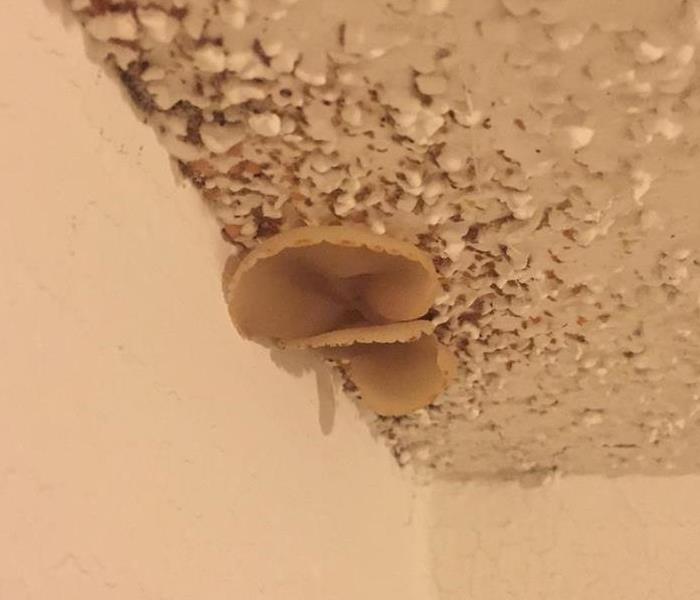 The Key to Mold Control is Moisture Control!
The Key to Mold Control is Moisture Control!
“I think I have toxic black mold at my property!”
If we had a nickel for every time we heard someone say this…
Mold is a situation that’s never pleasant to come across at a property. We’ve learned in over the past 3 decades of being in business, the conversation that surrounds mold can sometimes be confusing, full of headaches and unnecessary concerns. Although it’s still a topic of heated debate in some circles, we have boiled down some basic guidelines to understanding what mold is should SERVPRO of Chatsworth / Stevenson Ranch help you with a future mold issue, below is what you can expect:
- Mold can be found almost anywhere; it can grow on virtually any organic material, as long as moisture and oxygen are present.
- There are molds that can grow on wood, paper, carpet, foods, and insulation. Molds reproduce by making spores that cannot be seen without magnification. Mold spores waft through the indoor and outdoor air continually.
- When mold spores land on a damp spot indoors, they may begin growing and digesting whatever they are growing on in order to survive. Molds gradually destroy the things they grow on. Bacteria can start to grow within hours and mold can start to grow within days. Mold spores can lay dormant for years until an ideal growing condition develops, in which they start to flourish. Especially during the summer, the warm humid conditions are a perfect micro-environment for mold growth.
- When excessive moisture accumulates in buildings or on building materials, mold growth will often occur—particularly if the moisture problem remains undiscovered or unaddressed.
- Before the growth of mold becomes visible, there may be a faint musty or earthy smell. In time, mold will appear on the outside of the wall as a stain or discoloration. In a standard situation, SERVPRO of Chatsworth / Stevenson Ranch examines the structure for any visible signs of mold and removes the mold growth and excess spores, returning the area back to normal levels.
- All molds have the potential to cause health effects.
- Potential health concerns is an important reason to prevent mold growth to form an address any existing mold growth indoors.
- It is impossible to eliminate all molds and mold spores in an indoor environment, with the exception being in a proper containment after a mold remediation job is complete by a SERVPRO of Chatsworth / Stevenson Ranch professional. To confirm mold is no longer present, an Industrial Hygienist (CIH) will take a spore count to confirm mold is no longer present.
- The purpose of mold remediation is to remove the mold to prevent human exposure and damage to building materials and furnishings. It is necessary to clean up mold contamination, not just kill it.
- Mold growth can be controlled indoors by controlling the moisture.
- Some situations require the assistance of an Indoor Air Quality/Environmental Professional (IEP) with specialized equipment and services needed to assess and/or repair the structure. IEPs can test and clear a structure for mold by collecting air and surface samples. Then they can determine whether the mold has been successfully decontaminated.
- Mold growth can be controlled indoors by controlling the moisture.
If you suspect mold at your property, feel free to call SERVPRO of Chatsworth / Stevenson Ranch at (818) 709-6090 and get connected to one of our highly trained mold remediation technicians.
5 Steps to Cooking a Safe Super Bowl Feast
2/3/2017 (Permalink)
Next to Thanksgiving and Christmas, this upcoming [unofficial] holiday is one of the most anticipated events of the year! We at SERVPRO of Chatsworth / Stevenson Ranch are huge Super Bowl fans and although any of our technicians would throw down a dozen or so Buffalo wings like it’s nobody’s business, we have crews standing by in case your Super Bowl party gets a little too carried away. According to the U.S. Department of Agriculture, Super Bowl Sunday is the second largest day for food consumption in the U.S. after Thanksgiving. Enjoy the big game and stay fire safe with these tips from the U.S. Fire Administration (USFA):
- Keep an eye on what you fry.
- Stand by your pan.
- Turn pot handles toward the back of the stove.
- Wear short sleeves or rolled up sleeves.
- Keep a pan lid or cookie sheet nearby to cover the pan if it catches fire.
We at SERVPRO have put together a helpful demonstration to raise awareness to kitchen fire, the leading cause of home fires annually. Click the YouTube link below to enjoy!
https://www.youtube.com/watch?v=TTid1Dky2C8
Chatsworth / Stevenson Ranch Residents: We Specialize in Flooded Basement Cleanup and Restoration!
2/1/2017 (Permalink)
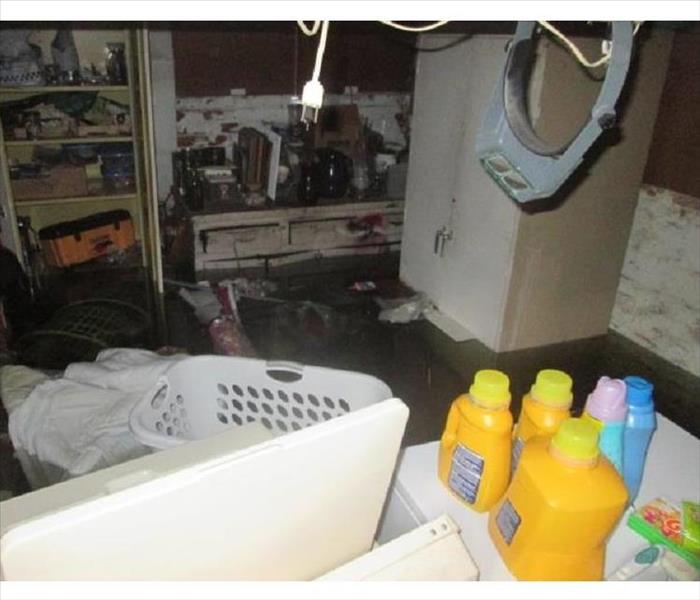 This Long Beach home’s basement flooded due to heavy rains.
This Long Beach home’s basement flooded due to heavy rains.
A basement can flood at any time, although flooding most often occurs during heavy rainfall. Basements are inherently prone to flooding because they are the lowest level of a building and are normally built partly or entirely below ground level. There are a number of reasons why your Chatsworth / Stevenson Ranch basement could flood, including:
- A blocked or failed sewer lateral pipe
- Heavy rain causes surface water to pool around your home
- Storm sewer backup
- Sanitary sewer backup
- Foundation drainage failure
- Water supply-line break or hot-water tank failure
- And many more
Have Questions about Basement Flooding?
Call Today – (818) 709-6090
If flood water is not handled quickly and properly, it can jeopardize your health and safety, and cause severe damage to your home’s structure. Remember, the longer you wait, the worse the problem will get.
The bottom line: a flooded basement can jeopardize your health, safety, and your home’s integrity. It’s worth making a call to SERVPRO of Chatsworth / Stevenson Ranch and let our trained, professional crews handle the situation safely and correctly. We have earned the trust of hundreds of homeowners, business owners, and property professionals.
We are Flooded Basement Specialists:
- We are Available 24 hours/7 days per week
- We’re a Preferred Vendor to many National Insurance Companies
- We Bill The Insurance Directly – One Less Thing For You To Worry About
- Our Technicians are Highly-Trained in Water Restoration Techniques
- We use s500 IICRC Restoration Standards
- Advanced Inspection and Extraction Equipment
Basement Flooded? Call Us Today – We’re Ready To Help (818) 709-6090
Water Damage Do’s and Don’ts
1/17/2017 (Permalink)
The recent rains have helped us Los Angelenos work towards getting out of what has been one of the worst droughts in California history. Although we love seeing it rain around here and with more rain in the forecast for later this week, we are also very aware that with this uptick in precipitation, so does the chance for water damage occurring. If you find yourself in a situation where suddenly rain water that was falling from the sky is now rising from the ground and entering your home or business, keep these helpful Do’s and Don’ts in mind to avoid unnecessary additional water damage.
THE DO’S OF WATER DAMAGE
- Remove as much excess water as possible by mopping and blotting
- Wipe excess water damage from wood furniture after removal of lamps and table top items.
- Remove and prop wet upholstery and pillow cushions for even drying
- Place aluminum foil or wood blocks between furniture legs and wet carpeting
- Turn air conditioning on for maximum drying (in summer)
- Remove Oriental rugs or other colored rugs from wet wall-to-wall carpeting
- Remove valuable paintings and art objects to a safe, dry place
- Open and place luggage, in sunlight to dry, if possible
- Gather loose items, toys, etc. from floors
THE DON’TS OF WATER DAMAGE
- Leave wet fabrics in place; dry as soon as possible. Hang furs and leather goods to dry separately at room temperature
- Leave books, magazines or other colored items on wet carpets or floors
- Use a standard vacuum to remove water
- Use TVs or other major appliances while standing on wet carpets or floors, especially not on wet concrete floors
- Turn on ceiling fixtures if ceiling is wet, and keep out of rooms where ceilings are sagging from retained water
For additional ways to better safeguard your home or business during a disaster, check out our SERVPRO of Chatsworth / Stevenson Ranch Tips page on our website and learn about other cool tidbits of professional advice!
We sincerely hope these experiences never happen to you but if they do we are standing by to help, 24 hours a day/7 days a week, and can be reached at (818) 709-6090.
The Rainy Season Has Arrived!
1/11/2017 (Permalink)
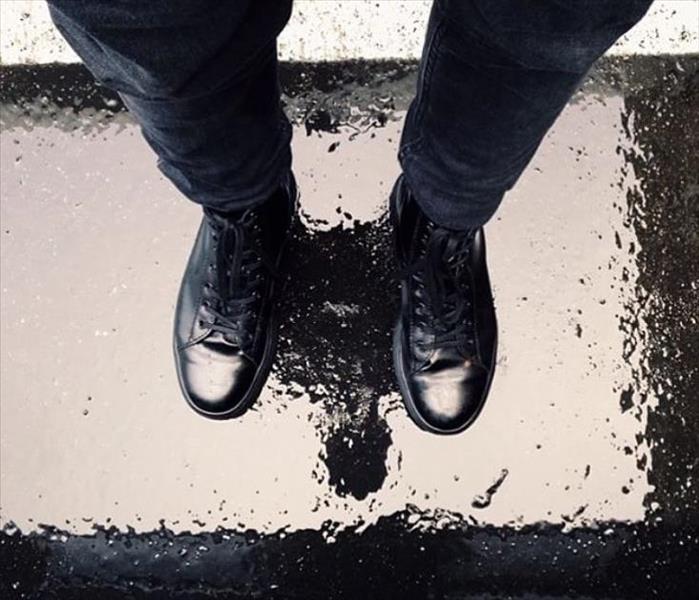 Keep those boots on standby!
Keep those boots on standby!
Well SERVPRO readers, in case you hadn’t already noticed, what reporters have dubbed as ‘The Pineapple Express’ has arrived in Southern California! Meteorologists say that we will be hit with a series of storms as the week continues, and storms are forecasted to dump 2-4 inches along the California coast through Friday.
While this may be great news in light of the drought California has been having, there can also be unforeseen complications that come as a result of this major upswing in our average rainfall. Flash floods could affect Los Angeles County communities that experienced wildfires last summer and fall, with persistent wet conditions putting areas at risk for mudslides. Our readers may also experience unexpected leaks and drips, causing water damage in their homes. For all of these potential emergencies, SERVPRO OF CHATSWORTH / STEVENSON RANCH is prepared and ready to respond.
And while we’re out tending to the chaos storms can bring, we wanted to offer you a few tips to help safeguard your home from water loss and disaster this El Nino season – especially with a break in the rains headed our way on Friday!
Tip #1: Check those gutters! This can be a simple but very effective way to prevent unwanted water from entering your home or business. Gutters that are clogged with debris from overhanging trees, trash, or roofing materials can easily clog the drain and shuffle unwanted water your way.
Tip #2: Tarp up any unfinished roofing projects. Going along with our first tip, small openings in the roof of your home and business can quickly become large openings with heavy rain, causing water damage inside your building. Make sure to give your local roofing company a call and get those potential problem areas patched up ASAP.
Tip #3: Examine your window glaze and compound. Often times, glazing compound can shrink during the warmer months, making windows more susceptible to unwanted rain water penetration. Your local contractor can help patch this up for you, ensuring that you are set and ready for even the heaviest of The Pineapple Express rains! Another helpful tip… make sure you close your windows before going to bed or leaving the home!
And finally, Tip #4 (the most important!): Should you find yourself in a situation where you do have a water damage emergency, call SERVPRO CHATSWORTH / STEVENSON RANCH. Our staff is prepped and ready to respond and help make your disaster, "Like it never even happened."
Keeping the workplace clean and safe
12/12/2016 (Permalink)
1
Prevent slips, trips and falls
Slips, trips and falls were the second leading cause of nonfatal occupational injuries or illnesses involving days away from work in 2013, according to data from the Bureau of Labor Statistics.
OSHA’s Walking-Working Surfaces Standard (1910.22(a)) states that all workplaces should be “kept clean and orderly and in a sanitary condition.” The rule includes passageways, storerooms and service rooms. Floors should be clean and dry. Drainage should be present where “wet processes are used.”
Employers should select adequate flooring (e.g., cement, ceramic tile or another material), as different types of flooring hold up better under certain conditions, said Fred Norton, technical director of ergonomics and manufacturing technology for Risk Control Services, Liberty Mutual Insurance in Walnut Creek, CA. Then, develop and implement housekeeping procedures using appropriate cleaners.
“Things like oils and grease – if you don’t use the right kind of cleaning protocols, you’ll just spread slipperiness around rather than getting it up and off the floor,” Norton said.
To help prevent slip, trip and fall incidents, the Canadian Center for Occupational Health and Safety recommends the following:
- Report and clean up spills and leaks.
- Keep aisles and exits clear of items.
- Consider installing mirrors and warning signs to help with blind spots.
- Replace worn, ripped or damage flooring.
- Consider installing anti-slip flooring in areas that can’t always be cleaned.
- Use drip pans and guards.
In addition, provide mats, platforms, false floors or “other dry standing places” where useful, according to OSHA. Every workplace should be free of projecting nails, splinters, holes and loose boards.
Gray added that employers should audit for trip hazards, and encourage workers to focus on the task at hand.
2
Eliminate fire hazards
Employees are responsible for keeping unnecessary combustible materials from accumulating in the work area. Combustible waste should be “stored in covered metal receptacles and disposed of daily,” according to OSHA’s Hazardous Materials Standard (1910.106).
The National Safety Council “Supervisors’ Safety Manual” includes these precautionary measures for fire safety:
- Keep combustible materials in the work area only in amounts needed for the job. When they are unneeded, move them to an assigned safe storage area.
- Store quick-burning, flammable materials in designated locations away from ignition sources.
- Avoid contaminating clothes with flammable liquids. Change clothes if contamination occurs.
- Keep passageways and fire doors free of obstructions. Stairwell doors should be kept closed. Do not store items in stairwells.
- Keep materials at least 18 inches away from automatic sprinklers, fire extinguishers and sprinkler controls. The 18-inch distance is required, but 24 to 36 inches is recommended. Clearance of 3 feet is required between piled material and the ceiling. If stock is piled more than 15 feet high, clearance should be doubled. Check applicable codes, including Life Safety Code, ANSI/NFPA 101-2009.
- Hazards in electrical areas should be reported, and work orders should be issued to fix them.
3
Control dust
Dust accumulation of more than 1/32 of an inch – or 0.8 millimeters – covering at least 5 percent of a room’s surface poses a significant explosion hazard, according to the Quincy, MA-based National Fire Protection Association. This dust accumulation is about as thick as a dime or paper clip.
An industrial hygienist should test the workplace for exposures if air quality and dust are concerns, Gray said.
NFPA 654 – a standard on preventing fire and dust explosions – addresses identifying hazard areas, controlling dust and housekeeping. The standard states that vacuuming is the “preferred” method of cleaning. Sweeping and water wash-down are other options. “Blow-downs” using compressed air or steam is allowed for inaccessible or unsafe surfaces.
Industrial vacuums can clean walls, ceilings, machinery and other places, CCOHS notes.
“You want to use wet methods or have high-efficiency vacuum systems,” said Steve Ahrenholz, senior industrial hygienist at NIOSH’s Division of Surveillance, Hazard Evaluations and Field Studies. “You don’t want to use just a shop vac or dry-sweep it – definitely not using compressed air to blow it. [Then] you’re just re-suspending the dust and distributing it all over.”
Dust also can affect equipment’s length of life and quality of products, Ahrenholz added.
4
Avoid tracking materials
Work-area mats – which can be cloth or sticky-topped – should be kept clean and maintained. This helps prevent the spread of hazardous materials to other work areas or home, Gray said. Check all mats to ensure they are not tripping hazards.
Additionally, separate cleaning protocols may be needed for different areas to prevent cross-contamination, Norton notes. Avoid using the same mop to clean both an oily spill and in another area, for example.
If the materials are toxic, industrial hygiene testing, uniforms and showering facilities might be needed, Gray said. Employees who work with toxic materials should not wear their work clothes home, Ahrenholz added.
5
Prevent falling objects
Gray noted that protections such as a toe board, toe rail or net can help prevent objects from falling and hitting workers or equipment.
Other tips include stacking boxes and materials straight up and down to keep them from falling, said Paul Errico, a Fairfield, CT-based safety consultant. Place heavy objects on lower shelves, and keep equipment away from the edges of desks and tables. Also, refrain from stacking objects in areas where workers walk, including aisles.
Keep layout in mind so workers are not exposed to hazards as they walk through areas, Norton added.
6
Clear clutter
A cluttered workplace can lead to ergonomics issues and possible injuries because workers have less space to move, Gray said.
“When an area is cluttered, you’re going to likely have a cut or laceration injury,” she said. “You’re not going to have as much room to set up your workstation like you should and move around. You’re going to be twisting your body rather than moving your whole body.”
The Ohio Bureau of Workers’ Compensation recommends that workers return tools and other materials to storage after using them, and dispose of materials that are no longer needed.
Keep aisles, stairways, emergency exits, electrical panels and doors clear of clutter, and purge untidy areas. Empty trash receptacles before they overflow.
7
Store materials properly
According to OSHA’s Materials Handling, Storage, Use and Disposal Standard (1926.250), storage areas should not have an accumulation of materials that present hazards for tripping, fire, explosion or pests.
Some workers make the mistake of storing ladders or other items inside electrical closets where they can block an electrical panel, creating a fire hazard and violating OSHA regulations, Errico said.
“I found that in a couple places. That would surprise employers if they’re not looking for it,” Errico said. “It’s important that they stay on top of it; realize it’s not just the manufacturing floor, maintenance area, warehouse or main storage areas, but these little areas in buildings that create a problem with storage.”
Unused materials and equipment should be stored out of the way of workers. Avoid using workspaces for storage, according to CCOHS. And remember to put everything back in its proper place, Ohio BWC adds.
Ahrenholz recommends keeping a storage space nearby so workers are encouraged to use it.
“There’s a responsibility to keep your work area in order and return tools to where they belong,” he said. “The storage space, if readily useable, is designed in such a way where it can be used without stretching too far or lifting heavy loads. They’re more likely to use it than if they have to go quite a ways to place something. Or they’re going to keep something rather than go back because they have to take the extra time to get it.”
8
Use and inspect personal protective equipment and tools
Errico has seen workers’ compensation cases stemming from employees who did not wear PPE when cleaning up spills or other material, such as broken glass or plywood, and then suffered cuts or splinters.
Wear basic PPE – such as closed-toe shoes and safety glasses – while performing housekeeping, Gray said. Determine what type of PPE to don based on the potential risks.
Regularly inspect, clean and fix tools, according to CCOHS. Remove any damaged tools from the work area.
9
Determine frequency
All workers should participate in housekeeping, especially in terms of keeping their own work areas tidy, reporting safety hazards and cleaning up spills, if possible.
“Every worker does have a role in housekeeping,” Ahrenholz said. “If they see something is becoming a problem, they need to report it.”
Before the end of a shift, workers should inspect and clean their workspaces and remove unused materials. This dedication can reduce time spent cleaning later, experts say.
How much debris or contaminants the workplace releases can help determine the frequency of housekeeping. A company should have a mixture of deep cleaning and more frequent, lighter cleaning that involves sweeping and responding to spills, Norton said.
10
Create written rules
Experts agree that housekeeping policies should be put in writing. That way, Norton said, they are formal and defined. Written protocols could specify which cleaners, tools and methods should be used.
“We found there are many gaps in the effectiveness of floor cleaning in the operations we’ve done research on,” Norton said. “It is an area that sometimes gets overlooked. That’s why we think it’s important for the written part of the protocols and defined training so people are aware of and follow the proper procedures.”
11
Think long-term
Housekeeping should be more than a one-time initiative – it should continue through monitoring and auditing. Keep records, maintain a regular walkthrough inspection schedule, report hazards and train employees to help sustain housekeeping. Set goals and expectations, and base auditing on those goals, Gray said.
“Housekeeping issues are very common. They can be easy to fix,” she said. “It’s going to take persistence and dedication.
info: http://www.safetyandhealthmagazine.com/articles/12470-tips-for-effective-workplace-housekeeping?page=1
Earthquake planning for commercial facilities
12/7/2016 (Permalink)
Happy Holidays SERVPRO of Chatsworth / Stevenson Ranch readers! We hope you all are enjoying this time of the year. We wanted to share with you all some helpful information on earthquake preparedness for commercial buildings, especially if you are a business owner or facility manager responsible for not just the safety of your family, but your co-workers as well.
In light of all the recent talks surrounding the topic of being overdue for the next “Big One,” we reflect back on our last encounter with a serious earthquake, the 1994 Northridge quake. Our office stayed busy for weeks helping people restore their businesses to pre-quake conditions and the observation we made was the business owners or facility managers who had a plan in place were the ones most likely to re-open their doors. We know it’s never fun to think about the worst-case scenario happening at your business, but in our line of work, it’s never a matter of ‘if’…but ‘when.’ You simply cannot afford to find yourself without a disaster plan!
BEFORE AN EARTHQUAKE – Develop an Action Plan
Identify potential hazards: Living and working in Los Angeles, we live our lives along the San Andreas Fault line (aka ‘earthquake country’), so that’s easy to identify; but are there other risks to your business? Identify what may interrupt your business operations temporarily or worse. The priorities you set here will help you in the other Steps. The Risk Level to your Critical Business Assets (CBAs) such as People, Data, Operations, Inventory, Equipment and Building all need to be identified and assessed to which ones pose the most significant threat to the sustainability of your business. If you secure it, it can be saved from earthquake damage or from hurting employees.
Create a disaster plan: After you have identified the potential hazards and impacts to your business, it’s time to create your plan and train employees! Because disasters are highly unpredictable, it is impossible to anticipate every situation and impact. However, a Business Continuity Plan can greatly reduce the risks and losses your business might face by guiding your decisions yet allowing flexibility to adapt to the unexpected.
Prepare disaster supplies kits: After a disaster, businesses will need to be self-sufficient as first responders will be addressing high priorities such as hospitals and schools. Determine what you need in the first days following an earthquake including the basics like food, water and sanitation.
Identify your building’s potential weaknesses and begin to fix them: Most businesses lease their space, so it’s essential to work with your owner and property manager on addressing structural issues. If you own it, strengthen those weaknesses. Either way, measures taken now can help you keep your doors open. No access, no business.
DURING AN EARTHQUAKE – Execute the Plan
Protect yourself and employees during earthquake shaking: DROP, COVER, AND HOLD ON. The ground is shaking, what do you do? The critical life safety step is Drop, Cover, and Hold On. Stay clear of any objects that may fall and stay put until the shaking stops.
AFTER AN EARTHQUAKE – Assess the Damage
Check for injuries and damage: Life safety is the top priority after an earthquake or any disaster. Use trained personnel to find anyone injured. Next, survey your building for damage or other hazards. Decide if safe to stay.
Continue to follow your disaster plan (when safe): Once life safety has been addressed, it’s time to begin recovery activities to resume business operations. Conduct an assessment for operational issues. Use your plan to guide your actions and restore priority operations first (here’s where you may need to call us at SERVPRO of Chatsworth / Stevenson Ranch =D to help restore your facility to pre-loss conditions). Communicate often with employees and key contacts. Document your lessons learned to determine priorities before the next event.
We will never know when the next ‘Big One’ will happen, so we all need to be ready for whatever happens.
We couldn’t have done this post without our friends at Earthquakecountry.org. Check out their website for more helpful tidbits of preparedness knowledge:
http://www.earthquakecountry.org/roots/7StepsBusiness2008.pdf
Preventing Holiday Fires
11/4/2016 (Permalink)
Residential fires during the holiday season are more frequent, more costly, and more deadly than at any other time of the year. The U.S. Fire Administration (USFA) reports more than double the number of open-flame fires on Christmas Day than on an average day, and about twice as many on New Year’s Day. And when those fires occur, they do more damage: Property loss during a holiday fire is 34% greater than in an average fire, and the number of fatalities per thousand fires is nearly 70% higher. When the source of the fire is a highly flammable Christmas tree, the toll in property and lives is even greater.
To keep your household from becoming a holiday fire statistic, here are some safety tips to follow.
Cooking
Cooking is the top cause of holiday fires, according to the USFA. The most common culprit is food that’s left unattended. It’s easy to get distracted; take a pot holder with you when you leave the kitchen as a reminder that you have something on the stove. Make sure to keep a kitchen fire extinguisher that’s rated for all types of fires, and check that smoke detectors are working.
If you’re planning to deep-fry your holiday turkey, do it outside, on a flat, level surface at least 10 feet from the house.
Candles
The incidence of candle fires is four times higher during December than during other months. According to the National Fire Protection Association, four of the five most dangerous days of the year for residential candle fires are Christmas/Christmas Eve and New Year’s/New Year’s Eve. (The fifth is Halloween.)
To reduce the danger, maintain about a foot of space between the candle and anything that can burn. Set candles on sturdy bases or cover with hurricane globes. Never leave flames unattended. Before bed, walk through each room to make sure candles are blown out. For atmosphere without worry, consider flameless LED candles.
Christmas Trees
It takes less than 30 seconds for a dry tree to engulf a room in flames, according to the Building and Fire Research Laboratory of the National Institute for Standards and Technology. “They make turpentine out of pine trees,” notes Tom Olshanski, spokesman for the USFA. “A Christmas tree is almost explosive when it goes.”
To minimize risk, buy a fresh tree with intact needles, get a fresh cut on the trunk, and water it every day. A well-watered tree is almost impossible to ignite. Keep the tree away from heat sources, such as a fireplace or radiator, and out of traffic patterns. If you’re using live garlands and other greenery, keep them at least three feet away from heating sources.
No matter how well the tree is watered, it will start to dry out after about four weeks, Olshanski says, so take it down after the holidays. Artificial trees don’t pose much of a fire hazard; just make sure yours is flame-retardant.
Decorative Lights
Inspect light strings, and throw out any with frayed or cracked wires or broken sockets. When decorating, don’t run more than three strings of lights end to end. “Stacking the plugs is much safer when you’re using a large quantity of lights,” explains Brian L. Vogt, director of education for holiday lighting firm Christmas Décor. Extension cords should be in good condition and UL-rated for indoor or outdoor use. Check outdoor receptacles to make sure the ground fault interrupters don’t trip. If they trip repeatedly, Vogt says, that’s a sign that they need to be replaced.
When hanging lights outside, avoid using nails or staples, which can damage the wiring and increase the risk of a fire. Instead, use UL-rated clips or hangers. And take lights down within 90 days, says John Drengenberg, director of consumer safety for Underwriters Laboratories. “If you leave them up all year round, squirrels chew on them and they get damaged by weather.”
Kids Playing with Matches
The number of blazes — and, tragically, the number of deaths — caused by children playing with fire goes up significantly during the holidays. From January through March, 13% of fire deaths are the result of children playing with fire, the USFA reports; in December, that percentage doubles. So keep matches and lighters out of kids’ reach. “We tend to underestimate the power of these tools,” says Meri-K Appy, president of the nonprofit Home Safety Council. “A match or lighter could be more deadly than a loaded gun in the hands of a small child.”
Fireplaces
Soot can harden on chimney walls as flammable creosote, so before the fireplace season begins, have your chimney inspected to see if it needs cleaning. Screen the fireplace to prevent embers from popping out onto the floor or carpet, and never use flammable liquids to start a fire in the fireplace. Only burn seasoned wood — no wrapping paper.
When cleaning out the fireplace, put embers in a metal container and set them outside to cool for 24 hours before disposal.
info provided by: https://www.houselogic.com/home-thoughts/holiday-fire-safety-tips/
Preserving your Jack O' Lantern from growing mold
10/20/2016 (Permalink)
Halloween is right around the corner and for most of us that means we’re already starting to see decorations on every residential street, pumpkin-everything at Trader Joes and of course one of America’s favorite pastimes, the Jack O’ Lantern! It seems though that every time the perfectly-designed Jack O’ Lantern is set out on display for all to see, it too quickly loses its rich and robust appearance and in just a couple short days, mold creeps in making all that’s left into a dilapidated pile of mush.
As a professional mold remediation company, we’ve put a lot of thought into this topic and have come to the conclusion that as long as spores travel through the air and moisture settles in the pumpkin, the Jack O’ Lantern will always be an ideal source for mold to grow. Although there’s a short shelf live for your Jack O’ Lantern, we at SERVPRO of Chatsworth / Stevenson Ranch have thought of a couple ideas you can do to extend its lifespan.
Steps:
- After your pumpkin has been carved, rinse it out with water to get rid of excess strings and gunk.
- Using a large bucket or tub, fill it with 3 gallons of water or enough that will completely submerge the pumpkin.
- Stir three teaspoons of bleach into the water.
- Dunk the pumpkin underwater for a few minutes.
- Remove from bucket and place upside down for a couple hours until any pooled moisture evaporates. Using a hairdryer may speed up this step.
The bleach solution will slow down the mold growth and acts as an inhibitor however it will only be a matter of time before Thanksgiving arrives and let’s be honest….who wants to keep a Jack O’ Lantern for more than a couple weeks anyways?
We’ve also heard using the small silica packs (found in beef jerky bags, shoe boxes and electronic shipments) can help absorb excess moisture found in the environment and can help prolong the life of your sculpted pumpkin. We’d love to hear if you have any ideas that may help save the life of your Jack O’ Lantern. You can either send us a message at SERVPRO2720@SERVPROburbank.com or through any our social media channels –
https://www.facebook.com/SERVPROchatsworth/?hc_ref=SEARCH&fref=nf
https://twitter.com/SERVPROBurbank
Happy Halloween everyone!!
How to survive a Flood
10/19/2016 (Permalink)
Floods are the number one natural disaster in the United States, and when looking at the 30-year average, they are the number one cause of weather-related fatality with an average of 81 deaths per year.
To put it simply, it’s easy to underestimate the power of water. In a flash flood, six inches of moving water is enough to knock a person over; 12 inches of moving water can sweep away a small car. Both moving and rising water demand respect!
Few places are immune to floods, wherever it rains, flooding can occur. And many of us TreeHugger types are known to live nearby or spend time in areas that are especially prone to flooding. So with that in mind, here are some pointers to help keep you safe when a great deluge decided to do its thing.
Turn around don’t drown!
The National Oceanic and Atmospheric Administration (NOAA) came up with the phrase "Turn around don’t drown" (and then registered it as a trademark) to further the National Weather Service’s (NWS) mission to help save lives. As it turns out, the CDC reports that half of all flood drownings happen when a vehicle is driven into hazardous floodwater. As mentioned above, 12 inches of moving water can take a small car; two feet will sweep away a larger vehicle. People think they can pass a puddle in the road, only to have their car stall and then ... whoosh. Turn around, don't drown!
Flash floods 101
This may sound obvious, but apparently it’s not the first thing that comes to mind for many. If there is a chance of flash flooding, move to higher ground as quickly as possible. If you’re in your car and water rises around it, leave the car and seek higher ground. (If the water is moving, however, do not leave the car.)
The NWS notes that a creek only six inches deep in mountainous areas can swell to a 10-foot deep raging river in less than an hour if a thunderstorm produces intense rainfall. During heavy rainfall or in times of flood watches or warnings, do not camp or park near streams, creeks or rivers.
Stay tuned in
During thunderstorms, heavy rainfall or other inclement weather, stay tuned to local television or radio for weather updates and emergency instructions. Here are what the alerts mean:
Flood Watch: Flooding is possible.
Flash Flood Watch: Flash flooding is possible; be prepared to move to higher ground.
Flood Warning: Flooding is occurring or will occur soon; if advised to evacuate, do so immediately.
Flash Flood Warning: A flash flood is occurring; seek higher ground on foot immediately.
Know your elevations
In the same way flight attendants point our emergency exit doors, you should familiarize yourself with high points in your area (whether ground or buildings) and especially know those that are accessible by foot.
Prepare your home
Outdoor furniture can be moved inside and important items can be moved to the highest point in your home. Electrical appliances should be unplugged (but only when you are dry and not standing in water). You may be instructed to turn off your gas and electricity at the main switch or valve, which can help to prevent fires and explosions.
Protect your pets
Never leave your pet home alone when there is a flood warning, even if your home is not directly threatened. Roads may be closed or your home may become otherwise inaccessible, leaving your pet stranded. Also, never leave a pet leashed or caged during a flood warning; the reason there is obvious, right?
Also be extra careful with pets if your area is directly flooding. If it takes just six inches of water to whisk an adult away, it takes much less to take a pet.
After a flood:
- Return home only when authorities say it is ok.
- Watch out for debris where water has receded.
- Before entering your home, look outside for loose power lines, damaged gas lines, foundation cracks or other damage.
- If you smell natural or propane gas or hear a hissing noise, leave quickly and call the fire department.
- Check for creatures that may have taken refuge or been washed inside your home; snakes, in particular, are prone to displacement. Especially check before you let pets re-enter.
- If your property has been flooded, allow your pets to reorient when you return. Flooding can wash away scents and may have destroyed landmarks your pet uses to keep track of locations. Without those, getting lost is more likely. Walk your dog with a leash for a few days until she/he is readjusted.
- Be cautious with paths and roadways, as they are often eroded and compromised by floodwater.
- Avoid standing water as there may be risk of electrocution from underground or downed power lines.
- Contact your local or state public health department for specific advice for boiling or treating water where you are after a disaster as water may be tainted.
- Let your family know you’re safe.
- And while it may be the last thing on your mind, remember to photograph damage to your property for insurance purposes.
info provided by http://www.treehugger.com/green-home/how-survive-flood.html
Equipment Spotlight: Air Movers
10/13/2016 (Permalink)
Hey SERVPRO of Chatsworth / Stevenson Ranch readers! We hope you have been enjoying some of the recent blog posts we’ve shared lately. We will be starting a new series of blog posts that highlight some parts to our office that contribute to us being part of the nation’s leading restoration company. In our first issue of Equipment Spotlight, we will be sharing some helpful resources on one of our staple pieces of restoration hardware, the Air Mover. So let’s jump right in…
The Institute of Inspection Cleaning and Restoration Certification (IICRC) is the industry guide on subjects such as proper equipment usage and since we’re the best at what we do, we do things by the book. Much of what we’ll be sharing with you is cited through the IICRC website, but specifically can be found in the listed article below -
http://www.iicrc.org/wp-content/uploads/2014/08/S500-CB-Airmover-Whitepaper_2014.pdf
What’s an Air Mover?
Air movers (aka “industrial air blowers”, “commercial blower fans” or “floor drying fans”) are used in construction and water restoration projects, having a wide variety of industrial applications. Their primarily used to increase air circulation, which speeds up water evaporation and reduces drying time. Compressed air is also used to maximize airflow in a blower fan or air mover.
Air movers are an essential tool when mitigation services are needed due to water damage or restoring flood or disaster damage. Some advantages of drying a building with the use of air movers are as follows:
- Low power draw
- High velocity, making them ideal for cooling and ventilation purposes
- Reduces water damage dry out time to carpets and floors, as well as wall cavities behind drywall
- Dries concrete and paint
- Removing fumes or gases from a workspace
TYPES OF AIR MOVER UNITS
The type of air blower affects the speed and direction of airflow and the amount of space that can be covered by the air mover. There are three major types of air blower units used in most commercial dry out scenarios:
- Axial: Axial blowers are designed to move large amounts of air across a wide space. These tend to be larger air movers that produce high airflow. Unlike centrifugal air movers, which can direct air in several directions, axial air movers only move air horizontally. They’re ideal for drying walls or top-down drying treatments on carpets. They’re sometimes used for ventilation and equipment cooling.
- Centrifugal: This type offers a more compact air mover designed for spot treatments. Centrifugal air movers draw air from several sources and direct it to a particular spot. They are often used in restoration work to dry hard to reach areas like under cabinets and in crawl spaces and closets. Most centrifugal air movers can be adjusted to provide airflow at a few different angles. Centrifugal blowers are heavy-duty air movers that produce lower CFM than axial air movers.
- Compact: Compact air movers are versatile enough to be used for both large floor areas and small spot drying. With 1/4 horsepower motors, they still have the power to quickly and effectively dry areas, while also being quieter than centrifugal air movers and taking up less space. Small and lightweight, compact air movers are the perfect solution for drying small, hard-to-reach spaces such as closets, corners or under counters.
We at SERVPRO of Chatsworth / Stevenson Ranch will always assess each water damage situation independently and if our highly trained IICRC certified technicians determine that air movers are a necessary step to speed up the drying process, we have all the resources needed to help make it “Like it never even happened®.”
We sincerely hope these unfortunate situations never happen but if they do we are standing by 24/7 and can be reached at (818) 709-6090.
Cleaning up Bloodborne Pathogens
9/20/2016 (Permalink)
Proper Blood Clean Up
Exposure to potentially hazardous blood is a very real concern for anyone working in a youth-focused or community-based organization. When a child gets a bloody nose or someone stubs their toe on the diving board you might be asked to clean it up. After all, we don’t want the general public to be exposed to bloodborne pathogens.
It is important to remember two things whenever you’re asked to clean up blood:
- Always assume the blood is infected with a dangerous disease like HIV, Hepatitis B or C.
- Have the right cleanup equipment and use it properly.
SERVPRO of Chatsworth -Stevenson Ranch recommends either calling us for all blood cleanups.
info provided by http://www.cultureofsafety.com/safety-tips/proper-blood-clean-up/
Bloodborne Pathogen Cleanup Supplies Checklist
Bodily fluid spills may require some specialized equipment depending on their location within the facility, the size of the spill and the type of spill, but most can be cleaned safely using the equipment recommended in OSHA’s Bloodborne Pathogen Cleanup Kit.
- Disposable gloves
- Absorbent materials (e.g., kitty litter, sand, etc.)
- Disinfecting towelettes
- Biohazard bag with zip tie
- Scoop
- Protective cap
- Eye protection
- Protective gown
- Mask
How to Clean Up Blood in Different Types of Conditions
Blood isn’t always going to cooperate. Sometimes it won’t be easy to simply block off an area and follow general blood cleanup guidelines. Read through the following descriptions to ensure you’re prepared for any blood cleanup experience.
Blood Spills on Non-Carpeted Floors
A hard, non-carpeted surface is the most common setting for blood spills. These surfaces include tile, ceramic, vinyl, linoleum, metal, wood, cement, and any other non-absorbent flooring such as a pool deck. Cleaning up blood and other bodily fluids off these surface types is easier than absorbent surfaces, but there are still important steps for you to consider.
Spills on hard surfaces often spread over larger areas so it will be necessary to contain the spill quickly. The procedures for cleaning up spills on these surfaces are:
- Block off the area until cleanup and disinfection is complete. No visitors or unprotected staff members should be able to access the area.
- Put on disposable gloves.
- Wipe up the spill as much as possible with paper towel or other absorbent material.
- Gently pour bleach solution – 1 part bleach to 9 parts water – onto all contaminated areas.
- Let bleach solution remain on contaminated area for 20 minutes and then wipe up remaining bleach solution.
- All non-disposable cleaning materials such as mops, brushes and rags need to be disinfected by saturating with a bleach solution and then allowed to air dry.
- Remove gloves and place in a garbage bag with all other soiled cleaning materials.
- Double bag and securely tie up garbage bags and discard.
- Thoroughly wash hands with soap and water.
Blood Spills on Carpeted Floors
Blood spills on carpeted floors are some of the most difficult to clean up due its absorbent nature. The majority of buildings contain at least some amount of carpeting, which is why it is important to know how to respond to spills in these areas. Many of the procedures for cleaning up blood on carpet will be the same as any other area, but there are a few additional concerns. In addition, there is no way to disinfect carpet completely so the best option is to sanitize as thoroughly as possible.
- Work Quickly: Blood or other bodily fluids can harden or set up quickly on carpeting, making it much more difficult to clean. Respond quickly, but make sure to follow all safety precautions like wearing appropriate PPE, securing the area, and ensuring the injured individual is safe.
- Use Appropriate Products: Bleach and other decontamination products can damage or destroy carpet. The best way to clean these areas is to use manufacturer approved carpet shampoos and cleaners. Make sure you select a product with some anti-microbial properties to help sanitize the area as thoroughly as possible. Another recommendation is that after the area is cleaned and dried repeat the process once or twice more since the absorbent nature of carpet can still conceal some pathogens.
- Steam Clean: Depending on the nature and size of the spill, it is advisable to perform a steam clean of the carpet. Steam cleaners will clean, remove debris, and sanitize carpeting more completely than conventional washing. Although there is some additional cost to steam cleaning, it is the best way to protect against bloodborne pathogens.
- Change Carpet Tiles: Removable carpet tiles are a great way to protect against exposure to bloodborne pathogens. Carpet tiles are often less expensive than traditional carpet, and if a certain area becomes heavily soiled with blood they can easily be removed and replaced. If your organization is equipped with carpet tiles be sure to dispose of them properly after being saturated with blood or any other potentially infectious bodily fluid.
The basic protocol for cleaning carpets and removing the threat of bloodborne pathogens is listed below. Please note that even when these steps are followed there is no guarantee that the threat of bloodborne pathogen exposure is 100% eliminated.
- Put on Disposable Gloves: No matter what type of surface you’re cleaning, always put gloves on first.
- Contain the Spill: After a spill, it is important to keep it as contained as possible to avoid allowing the affected area to spread. Create a barrier around the spill with an absorbent material.
- Initial Disinfect: Once the area is contained, spray the affected area with an appropriate carpet detergent to help kill some of the surviving pathogens. After spraying the area, allow it to sit for 10 minutes so the disinfectant has time to work.
- Blot up Excess Fluids: Use disposable towels or rags to blot as much excess fluid as you can and then carefully dispose of the soiled rags in a sealable bag.
- Extract Absorbed Fluids: The carpet will absorb some of the fluid so removing them will be the next step. Use a wet-vacuum to thoroughly wet and remove any fluids. Repeat the process of wetting and suctioning several times. While wetting the affected area be sure to prevent any water from spreading beyond the initial boundary.
- Re-disinfect: After vacuuming, thoroughly re-saturate the area with an appropriate disinfectant. Follow your carpet manufacturer’s recommendations since certain products can damage carpet fibers and dyes.
- Let Sit: After completely disinfecting the area, allow the disinfectant to set and work for up to 20 minutes to make sure it has the full effect.
- Third Disinfect: Repeat the previous two steps of disinfecting and then allowing to sit for 10-20 minutes.
- Rinse: Once the final round of disinfecting is complete, rinse the area one last time to remove any remaining detergent or disinfecting solution. After rinsing, wet-vacuum the area.
- Dry: Next, dry the area thoroughly with rags to draw out any remaining moisture and then place fans near the area to completely dry it,
- Wrap up: After the area is clean, properly dispose of all rags and PPE contaminated by the spill. In addition, thoroughly clean all other equipment used during the spill cleanup.
Blood Spills on Furniture
Like bodily fluid spills on carpet, spills on furniture are difficult to clean as well. There are, however, certain steps you can take to make sure it is as clean and safe as possible. As is the case with blood spills on carpet, it is important to contain the spill as quickly as possible.
Cleaning blood off of furniture depends on what type of furniture is contaminated. Cloth furniture needs more treatment than wood or metal furniture. Depending on the type of cloth furniture and the degree of the spill, the best cleaning method is to remove the cloth covering, if possible, and launder it by itself on a warm wash cycle. If the cloth furniture does not have a removable cover, then it is best to treat the spot as you would ablood spill on carpet and disinfect, let sit, and repeat several times.
There are also professional services that can clean furniture much more effectively and thoroughly if the spill is severe enough. Blood spills on metal and wood furniture are not as laborious as those on cloth furniture, but it is important to point out that bloodborne pathogens are still a threat. Metal, wood and any other non-porous furniture should be cleaned just like a blood spill on a non-carpeted surface.
Blood Spills in Pools
For blood in the pool, there is no action required other than attending to the injured individual and making sure the blood does not contaminate anywhere else. A properly maintained pool contains enough chlorine to kill any bloodborne pathogens.
From the CDC: Germs found in blood (for example, Hepatitis B virus or HIV) are spread when infected blood or certain body fluids get into the body and bloodstream (for example, by sharing needles or by sexual contact). Chlorine kills germs found in blood and CDC is not aware of any instances in which a person has become infected with these germs after being exposed to a blood spill in a pool.
- Does chlorine kill the germs in blood? Yes. These germs do not survive long when diluted into properly chlorinated pool water.
- Swimmers want something to be done after a blood spill. Should the pool be closed for a short period of time? There is no public health reason to recommend closing the pool after a blood spill. However, some pools choose to do so temporarily to satisfy patrons.
Blood Spills Outdoors
Blood spills outdoors present a unique set of challenges. Cleaning bodily fluid spills from dirt or grass is difficult, but since there is still a potential for exposure there a few measures to take. The easiest step is to re-locate whatever outdoor activity caused the exposure and to block off the affected area.
The area should still be disinfected as completely as possible with some form of disinfectant (like bleach) and then thoroughly rinsed with water. Take care to keep the exposed area contained. As with all blood cleanup procedures make sure to wear appropriate PPE and to dispose of it properly after cleanup.
Preparing For the Big One
9/13/2016 (Permalink)
They say we are long overdue for "The Big One." Chatsworth, and Los Angeles in general needs to be prepared for a large scale earthquake. In case of an emergency, you should have basic items, such as food and water, kitchen items, first aid supplies, sanitation and hygiene items, tools, clothing and bedding, and household documents and contact numbers. They should be compact and accessible. It is often best to put together your own emergency supply kit rather than buying one at a store so you can personalize it. In addition to items below, kits should include comfort items such as coffee or candy, a deck of cards or board games. If you have children, include toys.
SERVPRO OF CHATSWORTH - STEVENSON RANCH RECOMMENDS PUTTING THESE ITEMS IN YOUR KIT:
* Health items
* Prescription medications and eyeglasses
* Infant formula and diapers (if applicable)
* Breathing Masks (NIOSH-N95)
* Personal First Aid Kit
Household documents:
* Important family documents such as copies of insurance policies, bank account records, I.D. cards
* Photos of family members and pets (in case you are separated)
* Cash and traveler’s checks
* Tools
* Battery-powered flashlight (batteries included)
* Cell phone charger (batteries included)
* Work Gloves
* Light Sticks (3 each; one lasts 12 hours)
* Roll of duct tape
* Wrench or pliers to turn off utilities
FOOD/KITCHEN ITEMS
* Nutrition/protein bars
* Canned foods and juices
* Eating Utensils
* Can opener for food (if kit contains canned food)
* Water (at least 1 gallon per person, per day)
* Pet food and extra water for your pet (if applicable)
* Moist towelettes
MISCELLANEOUS
* Plastic Sheeting (10’x10’)
* Rain Ponchos
* Backpack
* Whistle
* Battery-operated radio or TV
* Local maps
HOME ITEMS
* Sleeping bag or warm blanket for each person
* Complete change of clothing, including a long-sleeved shirt, long pants and sturdy shoes.
* Personal Hygiene Kit (includes shampoo/body wash, wash cloth, toothbrush and toothpaste, comb, deodorant)
* Books, games and/or puzzles for children
HOW TO GET WATER IN AN EMERGENCY
If you lack clean water, you can use the water in your hot-water tank, pipes and ice trays. If necessary, you can even use water in the reservoir tank of your toilet (not the bowl).
If you hear reports of broken water or sewage lines, you’ll need to shut of your incoming water valve to stop contaminated water from entering your home. To use water already in your pipes, let air into the plumbing by turning on the faucet at the highest level of your house. A small amount of water will trickle out. Then obtain water from the lowest faucet in the house.
To use the water in your hot water tank, be sure the electricity or gas is off. Then open the drain at the bottom of the tank. Start the water flowing by turning on the water intake valve and turning on a hot water faucet. Do not turn on the gas or electricity when the tank is empty.
You should treat all water of uncertain purity before using it for drinking, food preparation or hygiene. There are many ways to treat water, though since none is perfect, the best solution is a combination of methods. Each of these methods will kill most microbes but will not remove other contaminants such as heavy metals, salts and most other chemicals. Before treating, let any suspended particles settle to the bottom, or strain them through layers of paper towel or clean cloth.
Boiling: Boiling is the safest method. Bring water to a rolling boil for 3-5 minutes. Let the water cool before drinking. Boiled water will taste better if you put oxygen back into it by pouring the water back and forth between two clean containers.
Disinfection: You can use household liquid bleach to kill microorganisms. Use only regular household liquid bleach that contains 5.25 percent sodium hypochlorite. Do not use scented bleaches, color-safe bleaches or bleaches with added cleaners. Add 16 drops of bleach per gallon of water. Stir and let stand for 30 minutes. Do not use anything except household liquid bleach. Other chemicals, such as iodine or water treatment products sold in camping or surplus stores should not be used as they generally do not contain 5.3 percent sodium hypochlorite as the only active ingredient.
Distillation: While boiling and disinfection will kill most microbes, distillation will go one step further, removing heavy metals, salts and most other chemicals. Distillation involves boiling water and then collecting the vapor that condenses back to water. To distill, fill a pot halfway with water. Tie a cup to the handle on the pot’s lid so that the cup will hang right side up when the lid is upside down (make sure the cup is not dangling into the water) and boil the water for 20 minutes. The water that drips from the lid into the cup is distilled.
ADVANCED DISASTER TRAINING
The Los Angeles County Fire Department offers Community Emergency Response Team (CERT) training to those interested in being first responders. CERT training is free and consists of seven classes covering topics such as fire suppression and emergency medical care. Each class is 2½ hours long. Courses are available at multiple locations.
To learn more about upcoming CERT training, visit www.cert-la.com and click on “Current CERT Trainings” or call 818-756-9674.
DISASTER COMMUNICATION
It is best to have both a land line and cell phone available in an emergency, according to Ready L.A., the city’s emergency preparedness department.
Here is what the city recommends:
* Keep a list of emergency numbers in your cell phone and/or near your home phone.
* Make sure you have batteries and car chargers available for your mobile phone
* If you have a landline, make sure you have at least one non-cordless phone in your home. It will work even if you lose power.
* Subscribe to text alert services from local or state governments like Alert.LA County.gov.
* Send texts instead of making calls during a disaster. Messages take up far less bandwidth.
* Use Facebook, Twitter and Skype. According to Ready L.A., sometimes the Internet continues to work when phone service is disrupted.
* If you are unsuccessful in completing a cell phone call, wait 10 seconds before redialing to help reduce network congestion. Keep conversation brief.
* Conserve your cell phone battery by reducing screen brightness, placing the phone in airplane mode, and closing apps.
* Historically, for land lines, if service shuts down, long-distance service usually recovers first. Thus, have a single out-of-state contact you can call with updates.
* KFI 640AM, KFWB 980AM and KNX 1070AM will broadcast emergency alerts. Emergency alerts also likely will be broadcast via television.
WHAT TO DO WITH YOUR PETS
* Have a two-week supply of pet food and water in case of an emergency. Rotate several times per year to keep it relatively fresh.
* Have extra prescriptions and medicines available.
* If you have a dog, keep a muzzle in your emergency kit. Some rescue agencies prefer them before they will assist in your
evacuation.
* Learn pet CPR, resuscitation and general first aid.
* Stay calm; most animals pick up on emotions and may react by displaying aggressive behavior.
* Check pet structures and favorite hiding places for hazardous debris.
* Microchip your pet and supply current ID tags at all times.
* Keep up-to-date vaccination records.
* After a disaster, immediately alert local shelters if your pet is missing.
* Obtain a “Pet Alert” sign for doors and windows from your local SPCALA Pet Adoption Center. You can also find similar signs on Amazon.com. This sign will alert emergency first responders to evacuate your pet.
HOW TO SHUT OFF YOUR UTILITIES IN CASE OF AN EMERGENCY
If a major disaster occurs, it may be necessary to turn off home utilities. By doing so, you can prevent gas leaks, flooding, fire or electrocution.
How to shut off your gas
* Do not shut off your gas unless you smell gas, hear gas escaping, see a broken gas line or suspect a gas leak. Once the gas is shut off, never attempt to turn it back on yourself; wait for the gas company to reconnect you.
The gas can be turned off at the main service shutoff valve. According to Ready L.A., the valve can be found on the gas line leading to your gas meter, which is normally in a side or backyard. The valve can be found 6 to 8 inches above the ground. Using a sturdy wrench turn to the valve until it is crosswise to the pipe.
HOW TO SHUT OFF YOUR ELECTRICITY
According to Ready L.A., you’ll want to turn off your electricity in any of these circumstances:
* You smell burning insulation.
* There is a fire or major water leak.
* You suspect a gas leak.
* Arcing or burning occur in electrical items.
* Switches or plugs become blackened or hot.
* Power loss, accompanied by burning smell.
To do so, first locate your main electric box, which you can usually find in the garage or on the exterior on your home. If you have circuit breakers, open the door to the breaker box and make sure the electrical switch is off. If your house has fuses, find the pullout fuse that says “main.” Remove all of the small fuses, and then remove the “main” fuse.
HOW TO SHUT OFF YOUR WATER
Water leaks can cause extensive damage, so it is sometimes best to shut off water after a disaster.
To do so, you should locate your shutoff valve, which is often in a garage or in the side or back of your house where water enters the building. You’re usually looking for a wheel located on a riser pipe. Turn it clockwise to shut off the water. If you live an apartment and don’t have access to the shutoff point, you might want to cut off the water supply to major appliances like dishwashers and refrigerators.
Source: City of Los Angeles, Ready L.A. program
Understanding Hoarding
9/9/2016 (Permalink)
Understanding Hoarding
Hoarding is the persistent difficulty discarding or parting with possessions, regardless of their actual value. The behavior usually has deleterious effects—emotional, physical, social, financial, and even legal—for a hoarder and family members.
For those who hoard, the quantity of their collected items sets them apart from other people. Commonly hoarded items may be newspapers, magazines, paper and plastic bags, cardboard boxes, photographs, household supplies, food, and clothing.
Hoarding can be related to compulsive buying (such as never passing up a bargain), the compulsive acquisition of free items (such as collecting flyers), or the compulsive search for perfect or unique items (which may not appear to others as unique, such as an old container).
Symptoms and Behavior
Someone who hoards may exhibit the following:
- Inability to throw away possessions
- Severe anxiety when attempting to discard items
- Great difficulty categorizing or organizing possessions
- Indecision about what to keep or where to put things
- Distress, such as feeling overwhelmed or embarrassed by possessions
- Suspicion of other people touching items
- Obsessive thoughts and actions: fear of running out of an item or of needing it in the future; checking the trash for accidentally discarded objects
- Functional impairments, including loss of living space, social isolation, family or marital discord, financial difficulties, health hazards
Reasons for Hoarding
People hoard because they believe that an item will be useful or valuable in the future. Or they feel it has sentimental value, is unique and irreplaceable, or too big a bargain to throw away. They may also consider an item a reminder that will jog their memory, thinking that without it they won’t remember an important person or event. Or because they can’t decide where something belongs, it’s better just to keep it.
Hoarding is a disorder that may be present on its own or as a symptom of another disorder. Those most often associated with hoarding are obsessive-compulsive personality disorder (OCPD), obsessive-compulsive disorder (OCD), attention-deficit/hyperactivity disorder (ADHD), and depression.
Although less often, hoarding may be associated with an eating disorder, pica (eating non-food materials), Prader-Willi syndrome (a genetic disorder), psychosis, or dementia.
Diminished Quality of Life
A lack of functional living space is common among hoarders, who may also live in unhealthy or dangerous conditions. Hoarders often live with broken appliances and without heat or other necessary comforts. They cope with malfunctioning systems rather than allow a qualified person into their home to fix a problem.
Hoarding also causes anger, resentment, and depression among family members, and it can affect the social development of children. Unlivable conditions may lead to separation or divorce, eviction, and even loss of child custody. Hoarding may lead to serious financial problems, as well.
Hoarding vs. Collecting
Hoarding is not the same as collecting. In general, collectors have a sense of pride about their possessions and they experience joy in displaying and talking about them. They usually keep their collection organized, feel satisfaction when adding to it, and budget their time and money.
Those who hoard usually experience embarrassment about their possessions and feel uncomfortable when others see them. They have clutter, often at the expense of livable space, feel sad or ashamed after acquiring additional items, and they are often in debt.
Fugen Neziroglu, PhD, ABBP, ABPP, is Director of the Bio-Behavioral Institute, in Great Neck, New York
Labor Day Safety Tips
9/2/2016 (Permalink)
Many people view Labor Day as the end of summer and their last chance to travel, hit the beach and fire up the grill. SERVPRO of Burbank, Crescenta Valley/East Glendale, Chatsworth/Stevenson Ranch, offers safety tips to help everyone have a safe and enjoyable holiday.
People should follow these safety tips:
Tips for Safe Travel
- Carry an emergency supply kit in your trunk.
- Let someone know your destination, your route, and when you expect to arrive.
- Buckle up and observe speed limits.
- Don’t drink and drive.
Tips for Safe Swimming
- Check weather and water conditions beforehand and throughout the day.
- Always swim with a buddy in a designated swimming area supervised by a lifeguard.
- Provide constant supervision to children in or near the water and always stay within arm’s reach of young children and inexperienced swimmers while they are in the water.
- Young children and inexperienced swimmers should wear U.S. Coast Guard-approved life jackets.
Tips for Safe Grilling
- Keep the grill away from the house, tree branches, or anything that could catch fire.
- Always follow the manufacturer’s instructions.
- Keep children and pets away from the grill.
- Never add charcoal starter fluid when coals have already been ignited.
For more information on emergency preparedness, go to redcross.org. Additional water safety tips are located at redcross.org/watersafety.
What is SERVPRO Storm Team?
8/29/2016 (Permalink)
As wildfires and major storms roll out, watch SERVPRO's Storm Teams roll in.
SERVPRO of Chatsworth / Stevenson Ranch is part of a network of over 1,800 restoration specialists, stretching throughout the United States as well as Canada – strategically stationed to be available for whatever happens at a moment’s notice. When things that matter most are on the line, make sure SERVPRO® is too. SERVPRO of Chatsworth / Stevenson Ranch is faster to any size disaster.
Should a storm or natural disaster situation strike the greater Los Angeles area, our office will notify local and surrounding SERVPRO locations. And as we begin to provide relief to homes and businesses alike, hundreds if not thousands of highly-trained SERVPRO professionals will start to pour into the disaster zone and provide back up and support to our already existing restoration efforts. Whether it’s damage caused by a leaky water pipe or an earthquake of catastrophic magnitudes, there’s no such thing as a job too big that SERVPRO can’t handle!
The days immediately following a major storm event, such as area-wide flooding, are critical to prevent secondary damages, like mold. SERVPRO of Chatsworth / Stevenson Ranch suggest the following steps to help minimize additional damage to your property.
- If the water has entered the structure through the flooding of a creek, stream or river, or if it has filtered through insulation during its intrusion, it is considered to be black water and could be hazardous to your health. Avoid contact with contaminated items as much as possible.
- Take the greatest caution while entering your home, and wear sturdy shoes and protective clothing when dealing with flooded areas.
- Do not attempt to operate any electrical equipment while standing in wet or damp locations.
- Throw away all foods - even canned goods - that have come into contact with flood waters.
- Remove and prop wet upholstery and pillow cushions for drying. Wipe excess water from wood furniture after removal of lamps and tabletop items.
- Place fans at 45-degree angles to walls and move large furniture away from walls to create the best air circulation.
- If your home has a crawlspace, be aware excess moisture in this area can often foster mold growth.
"The first 24 hours after a water damage or flood are so crucial to keeping final costs of the damage down," said Don Turner, Director of SERVPRO’s Disaster Recovery Team. "A lot of flood situations require professional equipment and knowledge of the science of drying to mitigate. By taking these steps, property owners can help minimize damage until the professionals arrive."
Keeping mold from growing on your food
8/24/2016 (Permalink)
Buying small amounts and using food quickly is probably the best way to prevent mold growth in food. However, there are other practices that you can implement to prevent mold growth in food.
- Examine food well before you buy it. Check food in glass jars, look at the stem areas on fresh produce, and avoid bruised produce. Fresh meat and poultry are usually mold free, but cured and cooked eats might not be. Examine them carefully. The exception is that some salamis -- San Francisco, Italian, and Eastern European types -- have a characteristic thin, white mold coating that is safe to consume; however, they should not show any other mold. Dry-cured country hams normally have surface mold that must be scrubbed off before cooking.
- When serving food, keep it covered to prevent exposure to mold spores in the air. Use plastic wrap to cover foods you want to stay moist -- fresh or cut fruits and vegetables and green and mixed salads.
- Empty opened cans of perishable foods into clean storage containers and refrigerate them promptly. Make sure that the storage container is tightly covered.
- Use leftovers within 3 to 4 days so mold does not have a chance to grow.
Cleanliness is the key to controlling mold. Mold spores from contaminated food can build up in your refrigerator, dishcloths, and other cleaning utensils. To eliminate mold:
- Clean the inside of the refrigerator every few months with one tablespoon of baking soda dissolved in a quart of water. Rinse with clear water and dry. Scrub visible mold (usually black) on rubber casings using three teaspoons of bleach in a quart of water.
- Keep dishclothes towels, sponges, and mops clean and fresh. A musty smell means they are spreading mold around. Discard items you cannot clean or launder.
- Keep the humidity level in the house below 40%.
SOURCE:
U.S. Department of Agriculture. 2002. Molds on Food: Are They Dangerous. The complete publication is available on-line at:http://www.fsis.usda.gov/Fact_Sheets/Molds_On_Food/index.asp
Tips to keep Mold at bay in the bathroom
8/23/2016 (Permalink)
 The Key for Mold Control is Moisture Control!
The Key for Mold Control is Moisture Control!
Let’s face it, when it comes to parts of our homes we wish we didn’t have to think much about, the bathroom would probably top that list. For most of us, the bathroom is the one part of the house that we want to get away from, just as quickly as we entered. And as a cleaning and restoration company who often finds ourselves entering into some pretty serious bathroom maintenance concerns, we’ve found that mold damage is one of the worst issues to face. That’s why we wanted to share some worthwhile information with you (the reader!) so that the next time you’re cleaning your home or doing various housekeeping chores, you can have some helpful pointers in mind for keeping mold growth at bay in your bathroom.
“Bathrooms are common places to find mold because heat and moisture accumulate on a regular basis, and this happens to be the perfect environment that mold needs to grow.” Some common reasons why mold growth is found especially in the bathroom are due to:
- Lack of air circulation and ventilation that traps moisture after bathing
- Leaky toilets, sinks or pipes
- Improper installation of bathtub pan or shower building materials
- Other damp organic materials such as rugs, paper products, wood, wallpaper, drywall, etc…
There are several different methods you can follow to prevent mold growth.
- Make sure you have a bathroom fan that works and is the right size in relation to the size of your bathroom
- If you don’t have a bathroom fan or window, take some time to dry the wet surfaces (walls, mirror, and ceiling) with a towel after your shower. Squeegee your shower walls to get rid of extra moisture.
- Seal the grout in your tile annually to ensure its water proof. Repair or replace damaged grout and caulk.
- Leave bathroom windows and doors open after your shower to let all the steam out. We recommend doing this for at least a half hour after bathing.
- Clean the bathroom with eco-friendly mold-preventing cleaners like Concrobium or Sporicidin. Also, general household cleaning solutions with bleach can be a great way to lessen the likelihood for mold to growth on dust, dirt and buildup on surfaces.
- If you’re going out of town, don’t just turn your thermostat off. Keep it at 74 or below to prevent a mold fest.
- Check your sinks for leaks.
- Spread the shower curtain back out after your shower to prevent mold from growing in the folds.
- Clean the bathroom regularly, at least once a week. Don’t forget easy-to-miss places like the shower walls. Wash your cloth shower curtain and rug too!
- Call SERVPRO of Chatsworth / Stevenson Ranch for additional tips and tricks for what to do (and NOT DO) if you have found mold growing in your bathroom.
(Shout out to http://howtobuildit.org/2013/08/13/how-to-avoid-bathroom-mold/ for helping contribute to some of these great ideas.)
Is Your Child Ready for Back to School?
8/12/2016 (Permalink)
Hey SERVPRO Chatsworth readers!
School’s right around the corner and for some of us, that means life is [once again] starting to ramp up. Next month happens to be Emergency Preparedness Month and we will be coming out with some great content to help our readers stay ahead of the game to be prepared for the unexpected. In the meantime though, our friends over at FEMA just came out with a great article on helping both kids and parents stay prepared as well. We thought you’d enjoy it, so feel free to keep reading –
“Fun Preparedness Resources for Kids
Your child may be away from you when disaster strikes, so it’s important teach to him or her how to stay safe during emergencies. To make disaster preparedness fun for youth, Save the Children and Scholastic created the following resources for parents and teachers to share with kids.
Keep the Herd Safe is a fun-filled activities page for children in grades 1-3 to encourage disaster planning and to teach them how to stay connected in the event of an emergency! Parents and teachers can also help children complete In Case of Emergency (ICE) Cards featuring characters from the new animated film “Ice Age: Collision Course.”
Get Ready, Get Safe! Do your children know how to do the Prep Step? Save the Children’s Prep Step video combines valuable safety tips with fun dance moves to get kids excited about preparedness. You can also download the Prep Step song for children to listen to while on the go. Download today and get moving!
Making preparedness fun and easy for kids is one of the best ways to get them involved in their own safety.
Firewise Virtual Workshop Series
The National Fire Protection Association’s Firewise Communities program is hosting a wildfire workshop series to connect wildfire stakeholders with subject matter experts. The series provides free learning opportunities for wildfire stakeholders by connecting them with leading researchers and practitioners in a live, interactive format. Visit the Firewise Communities website to learn more about the series and to register for their upcoming workshops.
Avoiding Disaster Fraud
After a disaster, community-based organizations and agencies often band together to try to meet the needs of affected individuals and communities. Unfortunately, this often brings criminals who prey on the needs of disaster survivors by offering fraudulent services.
Learn how to protect yourself and your finances from additional loss. FEMA offers reminders to help you avoid disaster fraud, including:
There is never a fee to apply for FEMA disaster assistance or to receive it;Get three written estimates for repair work. Then check credentials and contact your local Better Business Bureau or Chamber of Commerce to learn about any complaints against the contractor or business;Before work begins, make sure you get a written contract detailing all the work to be performed, the costs, a projected completion date, and how to negotiate changes and settle disputes; andPay only by check or a credit card. A reasonable down payment may be required to buy materials for some projects, but don't pay anything without a signed contract. Be sure to check out the full list of disaster fraud tips and stay vigilant when disaster strikes! To register for FEMA disaster assistance, call 800-621-3362(TTY: 800-462-7585) or visit www.DisasterAssistance.gov.”
Preparing your Chatsworth Home or Business for Fire Season
8/9/2016 (Permalink)
Here are some things you can do to ‘harden’ your home and commercial building and make it more fire resistant.
Well, we’re at it again folks! Fire season has come blazin’ back this year and with the few that have crept up a little too close for comfort, we wanted to jump in and do our part to help ready our online community with some helpful pointers. That way, you can be rest assured in knowing that you’re ‘as prepared as possible’ to weather the next wildfire that breaks out.
As a Fire & Water Restoration Company who works in people’s homes and office’s following wildfire damage, we hear all the time, “If I had only been prepared…” or “I never would have thought this would happen to me.” We wanted to pass along some practical preventive tips we picked up from The National Interagency Fire Center, a frontrunner in wildfire preparation.
Use Fire Resistant Building Material - "The Best Thing
That You Can Do"
The roof and exterior structure of your dwelling should be constructed of non-combustible or fire resistant materials such as fire resistant roofing materials, tile, slate, sheet iron, aluminum, brick, or stone. Wood siding, cedar shakes, exterior wood paneling, and other highly combustible materials should be treated with fire retardant chemicals.
Maintain a Survivable Space - "Things You Can Do Today"
Clean roof surfaces and gutters of pine needles, leaves, branches, etc., regularly to avoid accumulation of flammable materials.
Remove portions of any tree extending within 10 feet of the flue opening of any stove or chimney.
Maintain a screen constructed of non-flammable material over the flue opening of every chimney or stovepipe. Mesh openings of the screen should not exceed 1/2 inch.
Landscape vegetation should be spaced so that fire cannot be carried to the structure or surrounding vegetation.
Remove branches from trees to height of 15 feet.
A fuel break should be maintained around all structures.
Dispose of stove or fireplace ashes and charcoal briquettes only after soaking them in a metal pail of water.
Store gasoline in an approved safety can away from occupied buildings.
Propane tanks should be far enough away from buildings for valves to be shut off in case of fire. Keep area clear of flammable vegetation.
All combustibles such as firewood, picnic tables, boats, etc. should be kept away from structures.
Garden hose should be connected to outlet.
Addressing should be indicated at all intersections and on structures.
All roads and driveways should be at least 16 feet in width.
Have fire tools handy such as: ladder long enough to reach the roof, shovel, rake and bucket for water.
Each home should have at least two different entrance and exit routes.
To learn more on the topic of Fire Preparedness and Prevention in California, visit the Cal Fire’s website for further resources –
http://www.readyforwildfire.org/Hardening-Your-Home/
The Categories of a Water Loss
8/9/2016 (Permalink)
Water damage restoration training is one of the important skill sets that a team of professional cleaners need in order to offer comprehensive services. This is a service that involves going into a home or business after a wet disaster, such as flood, burst pipes, or snow destruction, and not just cleaning up the mess, but actually drying and repairing the substructures that high volumes of moisture will affect, such as plaster and drywall, wood, concrete, and metal. Mold is a concern, of course, but there can be many other problems related to moisture damage; crumbling drywall and plaster, weakening beams and supports, rusting metal surfaces, and more. If the moisture is left to sit long enough, it will eventually bring the house to ruin. By having professional water damage restoration training, a cleaning crew will be able to properly assess the situation and devise the best plan for repair.
According the IICRC (Institute of Inspection Cleaning and Restoration Certification), which sets the standards for the cleaning industry and water damage restoration training, there are several different levels and classes involved in liquid destruction. From the IICRC’s S-500 standards, there are three categories describing the type of liquid involved.
• Category 1. This is liquid from a clean and sanitary source, such as faucets, toilet tanks, drinking fountains, etc. But, category one can quickly degrade into category two.
• Category 2. This category of liquid used to be called grey water, and is described as having a level of contaminates that may cause illness or discomfort if ingested. Sources include dishwasher or washing machine overflows, flush from sink drains, and toilet overflow with some urine but not feces.
• Category 3. This is the worst classification and is grossly unsanitary. It could cause severe illness or death if ingested. It used to be called black water, and sources include sewer backup, flooding from rivers or streams, toilet overflow with feces, and stagnant liquid that has begun to support bacterial growth.
Info provided by: http://www.iicrc.org/the-basics-water-damage-restoration-training-a-23.html
SERVPRO Disaster Recovery Teams are Standing By to assist after The Sand Fire
7/29/2016 (Permalink)
A few simple steps could help minimize secondary soot and smoke damages
Los Angeles firefighters have nearly contained 85% the Sand Fire in the Santa Clarita Valley, but not before flames consumed over 38,000 acres, damaging dozens of homes, commercial buildings and natural landscape. SERVPRO of Chatsworth is connected to a network of SERVPRO professionals called the Disaster Recovery Team to aid victims of smoke and soot damage within the affected areas. Though personal safety is always the primary concern in these situations, the first several days after the fire is controlled are critical to preventing secondary damages from smoke and soot. Once the local authorities say it is safe to return to your home and/or business, SERVPRO of Chatsworth would like to offer the following steps to help minimize additional harmful effects.
DO:
Limit movement in the home to prevent soot particles from being embedded into upholstery and carpets.Keep hands clean. Soot on hands can further soil upholstery, walls and woodwork.Brush vacuum loose soot particles from upholstery, drapes and carpet.Place clean towels or old linens on rugs, upholstery and carpet traffic areas.If electricity is off, empty freezer and refrigerator completely and prop doors open.Clean and protect chrome on kitchen and bathroom faucets, trim and appliances with light coating of Vaseline or oil.Wash house plants on both sides of leaves.Change HVAC filter.Tape double layers of cheesecloth over air registers. DON’T:
Don't attempt to wash any walls or painted surfaces or shampoo carpet or upholstery without contacting your local SERVPRO Franchise Professional.Don't attempt to clean any electrical appliances, TV sets, radios, etc. that may have been close to fire, heat or water without first consulting an authorized repair service.Don't use any canned or packaged food or beverages that may have been stored near the fire, heat or water. They may have been contaminated.Don't turn on ceiling fixtures if ceiling is wet. The wiring may be damaged.Don't send garments to an ordinary dry cleaner. Improper cleaning may set smoke odor.Even if your property didn’t suffer fire damage, there may be soot particles and residues left to clean up. If cleaned improperly, the odor and effects can linger long after the fire has been extinguished. From the structure itself to the contents inside, SERVPRO of Chatsworth uses the latest technology and training to leave your property smelling fresh and clean.
To find more up-to-date notices of how the fire’s being handled, you can visit http://www.fire.lacounty.gov/home/home-alt/
Chatsworth Residents: Follow These Mold Safety Tips If You Suspect Mold
7/14/2016 (Permalink)
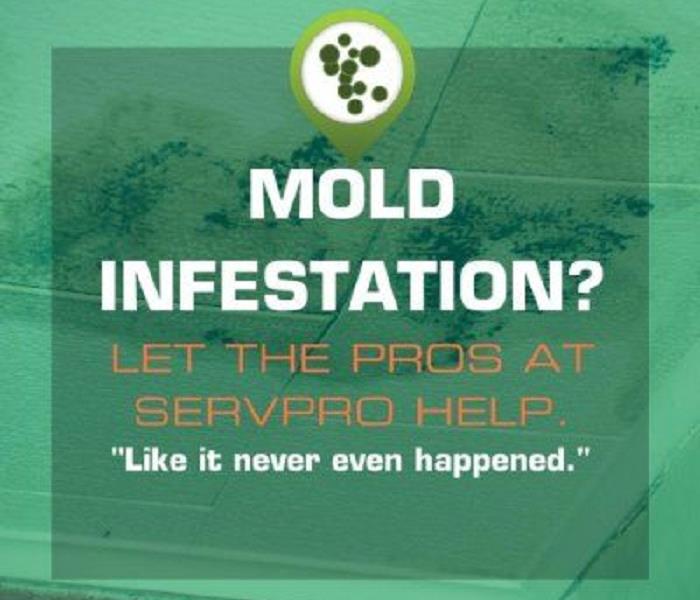 Be careful! Without proper training, you could be spreading mold throughout your home.
Be careful! Without proper training, you could be spreading mold throughout your home.
If you see visible mold, do not disturb it. You can inadvertently spread the mold infestation throughout your home. When mold is disturbed, the mold can release microscopic mold spores which become airborne and can circulate inside your home.
What to Do:
· Stay out of affected areas.
· Turn off the HVAC system and fans.
· Contact SERVPRO of Chatsworth for mold remediation services.
What Not to Do:
· Don’t touch or disturb the mold.
· Don’t blow air across any surfaces with visible or suspected mold growth.
· Don’t attempt to dry the area yourself.
· Don’t spray bleach or other disinfectants on the mold.
About Our Mold Remediation Services
SERVPRO of Chatsworth specializes in mold cleanup and restoration; in fact, it’s a cornerstone of our business. Our crews are highly trained restoration professionals that use specialized equipment and techniques to properly remediate your mold problem quickly and safely.
If You See Signs of Mold, Call Us Today – (818) 709-6090
For Immediate Service in Chatsworth, Call SERVPRO
7/13/2016 (Permalink)
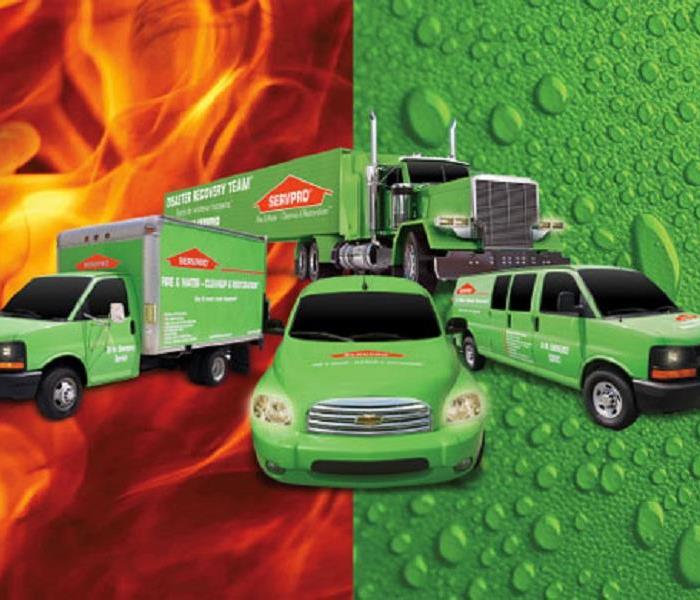 Chatsworth Residents: We provide immediate service day or night!
Chatsworth Residents: We provide immediate service day or night!
SERVPRO of Chatsworth provides 24-hour emergency service and is dedicated to being faster to any-sized disaster in Chatsworth. We can respond immediately to your emergency and have the expertise to handle your restoration or cleaning needs.
· 24-Hour Emergency Service
· Faster to Any-Sized Disaster
· Highly Trained Restoration Technicians
· A Trusted Leader in the Restoration Industry
· Locally Owned and Operated
· Advanced Restoration and Cleaning Equipment
Have Questions? Call Us 24/7 – (818) 709-6090
Residential Services
Whether your Chatsworth home needs emergency flood damage or your upholstery cleaned, you can depend on us. Our technicians have extensive cleaning and restoration training and can make your property look its best. Learn more about our residential services:
· Water Damage Restoration
· Fire Damage Restoration
· Mold Remediation
· Storm Damage Restoration
· Cleaning Services
· Building/Reconstruction Services
Commercial Services
There's never a convenient time for fire or water damage to strike your Chatsworth commercial property. Every hour spent cleaning up is an hour of lost revenue and productivity. So when the need arises for professional cleaning or emergency restoration services we have the training and expertise to respond promptly with highly trained technicians to get your property back to business. Learn more about our commercial services:
· Commercial Water Damage Restoration
· Commercial Fire Damage Restoration
Restoring Your Chatsworth Commercial Property After A Water Damage Event
7/7/2016 (Permalink)
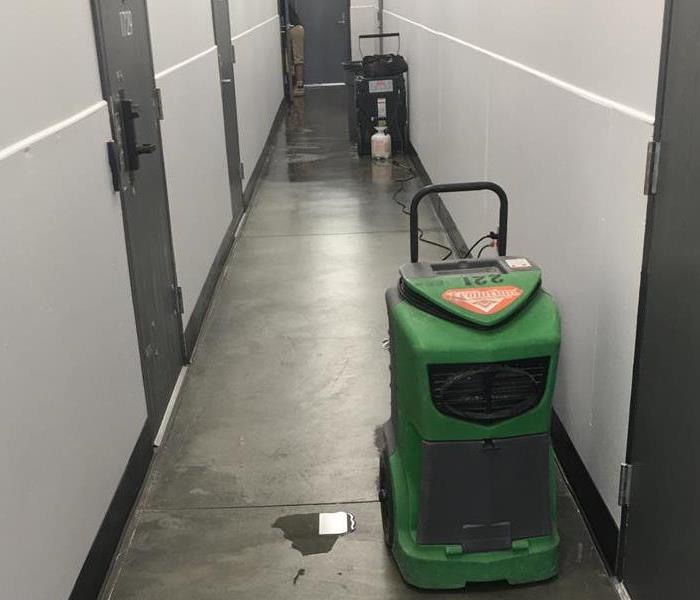 Commercial Water Damage Events Present Unique Challenges
Commercial Water Damage Events Present Unique Challenges
Flooding and water damage events at Chatsworth commercial properties are often complex with numerous issues that require a knowledgeable and flexible response. Whether we’re dealing with a relatively small water cleanup scenario or a large scale event, we work quickly to assess each unique situation and isolate the damaged area. In many instances, normal operations can continue in a temporary space while we restore your facility.
Restoring Commercial Properties Presents Unique Challenges
Our professionals are trained to be mindful of legal and environmental concerns and strive to fully restore the damaged area while working within your budgetary constraints. We understand that every hour spent cleaning up is an hour of lost revenue and productivity. So when an emergency situation arises in your business, give us a call and we’ll be there fast with the help you need.
About SERVPRO of Chatsworth
SERVPRO of Chatsworth specializes in the cleanup and restoration of commercial and residential property after a water damage event. Our staff is highly trained in property damage restoration. From initial and ongoing training at SERVPRO’s corporate training facility to regular IICRC-industry certification, rest assured our staff is equipped with the knowledge to restore your property.
Meet our Team: http://www.SERVPROchatsworth.com/crew-photos
Does Your Chatsworth Home Have A Mold Problem?
6/23/2016 (Permalink)
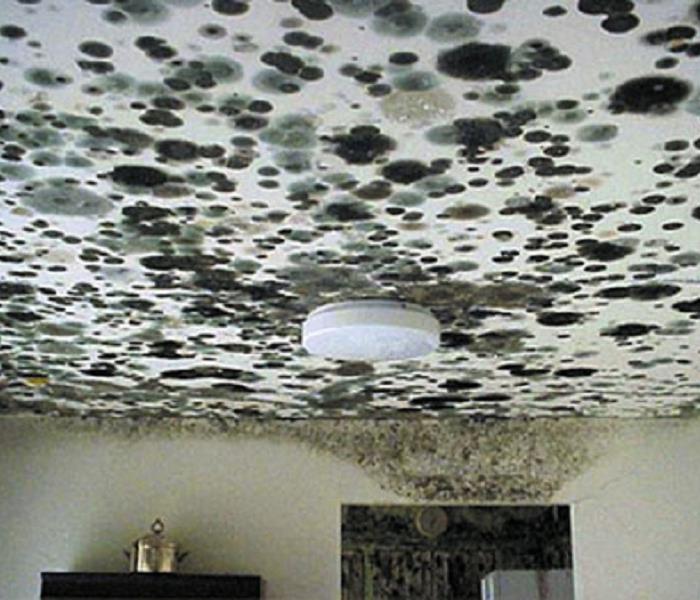 In Chatsworth, mold can spread through a home in as little as 48 hours.
In Chatsworth, mold can spread through a home in as little as 48 hours.
Microscopic mold spores naturally occur almost everywhere, both outdoors and indoors. This makes it impossible to remove all mold from a home or business. Therefore, mold remediation reduces the mold spore count back to its natural or baseline level. Some restoration businesses advertise “mold removal” and even guarantee to remove all mold, which is a fallacy. Consider the following mold facts:
· Mold is present almost everywhere, indoors and outdoors.
· Mold spores are microscopic and float along in the air and may enter your home through windows, doors, or AC/heating systems or even hitch a ride indoors on your clothing or a pet.
· Mold spores thrive on moisture. Mold spores can quickly grow into colonies when exposed to water. These colonies may produce allergens and irritants.
· Before mold remediation can begin, any sources of water or moisture must be addressed. Otherwise, the mold may return.
· Mold often produces a strong, musty odor and can lead you to possible mold problem areas.
· Even higher-than-normal indoor humidity can support mold growth. Keep indoor humidity below 45 percent.
If your home or business has a mold problem, we can inspect and assess your property and use our specialized training, equipment, and expertise to remediate your mold infestation.
If You See Signs of Mold, Call Us Today – (818) 709-6090
So what exactly is Soot/Smoke Damage?
6/14/2016 (Permalink)
Smoke and soot is very invasive and can penetrate various cavities within your home, causing hidden damage and odor. Our smoke damage expertise and experience allows us to inspect and accurately assess the extent of the damage to develop a comprehensive plan of action.
Smoke and soot facts:
· Hot smoke migrates to cooler areas and upper levels of a structure.
· Smoke flows around plumbing systems, seeping through the holes used by pipes to go from floor to floor.
· The type of smoke may greatly affect the restoration process.
Different Types of Smoke
There are two different types of smoke–wet and dry. As a result, there are different types of soot residue after a fire. Before restoration begins, SERVPRO of Chatsworth will test the soot to determine which type of smoke damage occurred. The cleaning procedures will then be based on the information identified during pretesting. Here is some additional information:
Wet Smoke – Plastic and Rubber
· Low heat, smoldering, pungent odor, sticky, smeary. Smoke webs are more difficult to clean.
Dry Smoke – Paper and Wood
· Fast burning, high temperatures, heat rises therefore smoke rises.
Protein Fire Residue – Produced by evaporation of material rather than from a fire
· Virtually invisible, discolors paints and varnishes, extreme pungent odor.
Our Fire Damage Restoration Services
Since each smoke and fire damage situation is a little different, each one requires a unique solution tailored for the specific conditions. We have the equipment, expertise, and experience to restore your fire and smoke damage. We will also treat your family with empathy and respect and your property with care.
Have Questions about Fire, Smoke, or Soot Damage?
Call Us Today – (818) 842-1400
Cleaning Up After a Flood
2/19/2016 (Permalink)
Happy Friday SERVPRO Chatsworth Readers!
Ever found yourself in a situation where your home or business has been affected by a flood? What can you do in those precious moments before help arrives to respond to the situation?
We have another article to share from our friends over at FEMA with some tips on what YOU can do to clean up after a flood. And don't forget the most important tip of them all - for a team that is faster to any disaster, including your water damage at your home or business, call SERVPRO Chatsworth for help!
Read on:
"Flooding is the most common natural disaster in the United States and can happen anywhere.
Flooding can occur slowly over many days leaving enough time to evacuate in advance or prepare to be home for several days without power, water, or access to roads or services. Or, as in the case of flash flooding, it can happen very quickly with little or no warning and you may need to move quickly to make it to higher ground.
In the event of a flood, America’s PrepareAthon! How to Prepare for a Flood offers the following tips to reduce the risk of damage to your home or business:
Elevate critical utilities, such as electrical panels, switches, sockets, wiring, appliances, and heating systems;
In areas with repetitive flooding, consider elevating the building;
Waterproof basement areas and make sure your sump pump is working; and
Move furniture, valuables, and important documents to a safe place.
After a flood, timing is of the essence. Water left in your home for a significant period of time can cause mold, and even in some cases, structural damage. It is important to clean your home as soon as possible following a flood.
Keep in mind that extreme care is necessary when cleaning out your home following a flood. America’s PrepareAthon!’s how-to flood guide also provides recommendations on how to best protect yourself and your property after a flood:
Avoid wading in floodwaters as they often contain dangerous debris like broken glass, metal, dead animals, or contaminants, such as sewage, gasoline, and oil;
Do not enter a damaged building unless it has been cleared by authorities. There may be structural damage to the foundation, electrical hazards, or hidden damage;
Take precautions and wear appropriate protective equipment, such as gloves, safety glasses, rubber boots, and masks that protect you from dust and other dangerous particles;
Do not touch electrical equipment if it is wet or you’re standing in water;
Shut off all utilities to a flooded home or building;
Clean and disinfect anything that got wet; and
Remove and replace any drywall or other paneling that was underwater."
Preparing Your Business for an Earthquake
2/15/2016 (Permalink)
Hey SERVPRO Chatsworth readers!
Happy Monday! We had a great article pop up in our inbox from our friends over at FEMA that we'd share with you! An earthquake can happen at any time, so read on for a few quick tips on how to make sure your business is prepared. And remember, when disaster strikes, you can always call your local SERVPRO for timely assistance:
"An earthquake can happen at anytime and anywhere. Unlike many other natural disasters, earthquakes can strike during any season. It can also occur with little to no warning at all.
Earthquakes can knock out heat, power, and communications services, sometimes for days at a time, leaving people stuck without utilities or other services. Your goal for protection is to learn to Drop, Cover, and Hold On during an earthquake.
Most casualties and injuries during an earthquake occur when: people fall while trying to walk or run during the shaking; when they are hit by falling, flying, or sliding items or non-structural debris; and/or when they are struck or trapped by collapsing walls or other parts of the building.
The America’s PrepareAthon! How to Prepare for an Earthquake explains what the public should do before, during and after an earthquake:
To prevent potential injuries, take the time to secure your space. Secure items that might fall, fly, or slide in an earthquake. Imagine if the room was picked up and shaken up and down and side to side and then determine what items would be thrown around.
Make sure your business is safer during earthquakes and more resistant to earthquake damage. Get professional help to assess the building’s structure and then take steps to install nonstructural solutions, including foundation bolting and cripple wall bracing.
The America’s PrepareAthon! Prepare Your Organization for an Earthquake Playbook explains how business owners can take the necessary steps now to prepare themselves and their staff for an earthquake.
The playbook helps to enhance organizational coordination and communication on preparedness and operational continuity by recommending the following:
Hold a preparedness discussion to explain company plans and policies to motivate employees to be better prepared at home and work;
Explain and practice Drop, Cover, and Hold On;
Conduct a tabletop exercise with your staff to ensure that the organization is familiar with and knows how to implement readiness plans;
Develop an employee communications plan with all staff contact information, including emergency points of contact;
Sign up for local alerts and warnings in your community; and
Organize and keep handy important documents such as insurance information and rental or mortgage agreements.
It is important that business owners discuss their plans with their employees to ensure they are aware of what to do and where to go during an earthquake threat."
The Hazards of Water Damage
1/20/2016 (Permalink)
Hey SERVPRO Chatsworth readers! We’ve been getting a lot of calls about water damages lately. We here at SERVPRO know that there can a lot of questions that come along with discovering a water damage in your home, especially when it comes to your health and potential health hazards when a loss is discovered. Our friends over at SERVPRO Saginaw put together some great thoughts on the topic. Read on to gain insight on what hazards can occur as a result of a water damage and why it’s best to let the professionals handle the clean up.
The obvious result of water damage is structural---whether severe or cosmetic. And unfortunately, structural damage can wind up costing you thousands of dollars in repairs. The result of water damage can also cause the growth of toxic mold and mildew. If left untreated, this mold proliferation can be a serious hazard to your health. So let’s get to it.
Hazard #1: Mold Growth -
According to the Environmental Protection Agency (EPA), you should have your property dried and cleaned within 24-48 hours after the initial water onslaught. This practice will help decrease the likelihood of mold growth. Although you may be capable of starting the drying and cleaning processes, it is important to know that mold can grow in areas of the home that you can't see. Thus, simply cleaning and drying your carpet will not always be effective in preventing mold growth, especially if there is a large quantity of unwanted water. The mold can still grow in different areas of your home, including the carpet padding, underneath wallpaper, behind the drywall, along ceilings and baseboards, in voids and furniture.
As noted by the EPA, there are several health hazards that can result from exposure to mold. It is also important to note that the mold clean up process, performed by you, can lead to exposure to fungi. For this reason, professional water damage restoration technicians from SERVPRO will wear special protective gear and utilize state-of-the-art equipment for mold cleanup and the prevention of mold dispersion throughout your Saginaw home.
Hazard #2: Exposure to Sewage -
Exposure to raw sewage is dangerous because it contains parasites, viruses, and bacteria such as E. coli. The sewage can also contain pharmaceuticals, chemicals, and pesticides. The EPA has stated that contaminated water can lead to the contraction of illnesses such as tuberculosis, dysentery, hepatitis, tetanus, and cholera. Safely stay away from the hazard of sewage water--blackwater--and let the experts execute the cleanup and dry out.
So… Let The Professionals at SERVPRO Chatsworth Assist You!
We are passionate about helping our customers make their water damage loss “like it never even happened”. So no matter if it’s a leaky pipe underneath your bathroom sink or a busted water main that’s flooded your entire property, our team will get you taken care of so you can get back to a safe and HEALTHY state.
El Nino is Here!
1/6/2016 (Permalink)
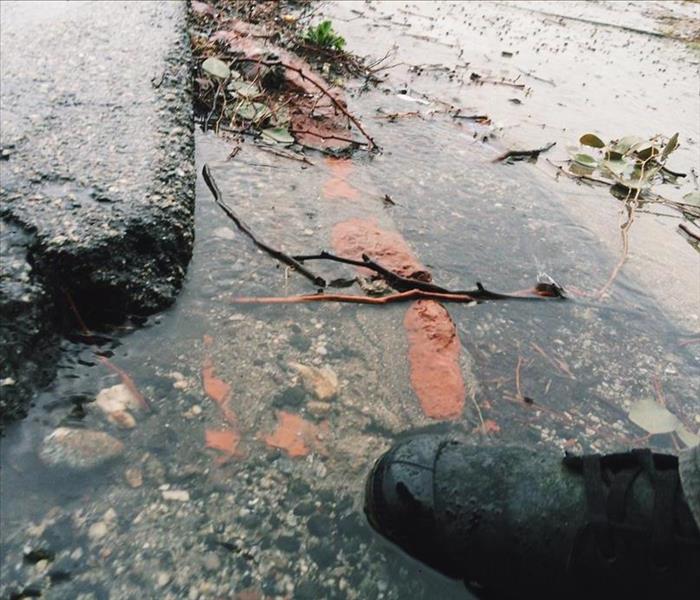 The first of El Nino's Socal rains.
The first of El Nino's Socal rains.
Well SERVPRO readers, in case you hadn’t already noticed, El Nino has arrived in Southern California! Meteorologists say that we will be hit with a series of storms as the week continues, and storms are forecasted to dump 2-4 inches along the California coast through Friday.
While this may be great news in light of the drought California has been having, there can also be unforeseen complications that come as a result of this major upswing in our average rainfall. Flash floods could affect Los Angeles County communities that experienced wildfires last summer and fall, with persistent wet conditions putting areas at risk for mudslides. Our readers may also experience unexpected leaks and drips, causing water damage in their homes. For all of these potential emergencies, SERVPRO Chatsworth is prepared and ready to respond.
And while we’re out tending to the chaos El Nino can bring, we wanted to offer you a few tips to help safeguard your home from water loss and disaster this El Nino season – especially with a break in the rains headed our way on Friday!
Tip #1: Check those gutters! This can be a simple but very effective way to prevent unwanted water from entering your home or business. Gutters that are clogged with debris from overhanging trees, trash, or roofing materials can easily clog the drain and shuffle unwanted water your way.
Tip #2: Tarp up any unfinished roofing projects. Going along with our first tip, small openings in the roof of your home and business can quickly become large openings with heavy rain, causing water damage inside your building. Make sure to give your local roofing company a call and get those potential problem areas patched up ASAP.
Tip #3: Examine your window glaze and compound. Often times, glazing compound can shrink during the warmer months, making windows more susceptible to unwanted rain water penetration. Your local contractor can help patch this up for you, ensuring that you are set and ready for even the heaviest of El Nino’s rains! Another helpful tip… make sure you close your windows before going to bed or leaving the home!
And finally, Tip #4 (the most important!): Should you find yourself in a situation where you do have a water damage emergency, call SERVPRO Chatsworth. Our team is prepped and ready to respond and help make your El Nino disaster, "lLike it never even happened."




 24/7 Emergency Service
24/7 Emergency Service


















































